Australian
and international
exploratory
performance and
media arts
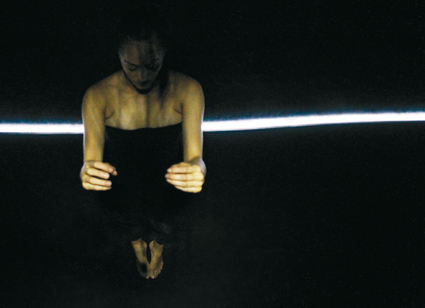
Lemi Ponifasio, Stones In Her Mouth
photo MAU
Lemi Ponifasio, Stones In Her Mouth
A beaming Lisa Havilah, director of Carriageworks, the contemporary multi-arts centre located in Sydney’s Redfern, proudly guides me through the proof sheets of her 2014 program prior to its launch. It’s abundantly evident that Havilah has, over several labour intensive years, incrementally established a clear sense of purpose, identity and, not least, continuity, confirming that her programing is underpinned by a firm vision. The venue has doubled in size and attracted 400,000 visitors in 2013.
It’s especially pleasing that Havilah has resolutely committed to the notion of Carriageworks as a contemporary arts space, not an entertainment centre, like the Sydney Opera House, now awash with stand-up comedians and indie bands. Havilah’s program cogently reflects and nurtures the diversity of contemporary art practices—through long-term projects and commissions, off-site residencies and an ever-expanding network of partnerships with like-minded organisations.
What stage is this in the evolution of Carriageworks under your direction?
2014 will be the third year of our re-imagining of what Carriageworks is going to be and the third year of implementing what we think is quite a distinctive artistic vision for the organisations resident here and for the overall institution. I think this makes it distinctive from other major cultural institutions across Sydney, but also across the country in that Carriageworks has a real multi-arts contemporary focus, and a focus on cultural diversity and contemporary urban practice as well. The program reflects the cultural demographic of Sydney and supports the development of work that really does move across art forms in interesting ways. 2014 also continues our commitment to commissioning and presenting work of scale that meets the architecture of Carriageworks.
These are works that occupy the foyer and the large performance spaces?
This wholly new direction started with Travelling Colony, the large-scale Brook Andrew commission [painted caravans containing video interviews with Redfern Indigenous inhabitants in the Carriageworks foyer], then Song Dong [Waste Not, a massive foyer installation], Ryoji Ikeda’s Test Pattern (No5), MAU’s Birds with Skymirrors and Anne Teresa de Keersmaeker’s dance works [Cesna and En Atendant]. These are epic works that speak to and reflect back on contemporary life but at the same time are of a scale that pays respect to the scale of the building and the history and the context within which the work is presented. This is always a key factor in how we think about programming. We are located in Redfern, a place that has a strong political and social history and is undergoing very significant change. And that’s also a hallmark of Carriageworks—the scale of change that we have driven in part but, in return, are also experiencing because the artistic program is driving it. All of our success emerges from the content, commitment and quality of our artistic program with its artists.
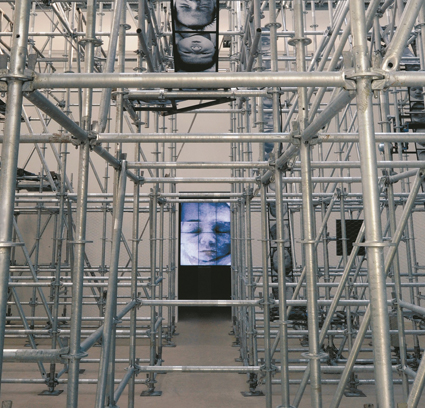
Christian Boltanski
courtesy Carriageworks
Christian Boltanski
Your 2014 program opens with a huge installation by French sculptor, photographer, painter and filmmaker Christian Boltanski that mimics a printing press.
It’s 40 metres long and 10 metres high and will occupy all of the foyer space. You’ll be able to walk around and through it and also play a game of chance.
As part of your annual social history program, you’ll have an exhibition featuring the Aboriginal Progressive Association and its activities and achievements prior to World War II.
Yes, and one of our most important projects with the Indigenous community is a partnership with Alexandria Park Community School where we’re establishing a full-time artist’s studio within the school. We’ll invite an Aboriginal artist to be in residence there each of three years. The first will be the incredible contemporary dancer/physical performer Ghenoa Gela followed by Tony Albert, then Microwave Jenny [pop/folk/jazz duet Tessa and Brendan Boney].
You’re clearly committed to long-term programming.
That’s another key driver in terms of how we develop the program. We were so excited to be able to bring Lemi Ponifasio’s Birds with Skymirrors here in 2013. We now have a long-term partnership with Lemi and MAU in which we’ll co-commission a new work from him over the next three years and hopefully that relationship will develop into the future. Most often, you’d experience a work from this company but then not see anything else from them for 10 years. This way we can really work with Lemi to build audiences in Sydney for his work who can see how the practice builds over a number of years.
You’ve also programmed Sydney Chamber Opera, Perth composer Cat Hope (working with visual artist Kate McMillan) and the UK-based Australian ensemble Elision. That’s good news for new music.
That’s been one of the things I’ve loved most about our program in 2013, with Sydney Chamber Opera, Michael Kieran Harvey and the amazing Jack Quartet from New York. This will be the first time we’ve included Sydney Chamber Opera’s work as part of our own artistic program. That’s quite a significant increase in our support to that company. My practice doesn’t emerge from music but I’ve loved engaging with those artists. We’re looking to continue to build that program.
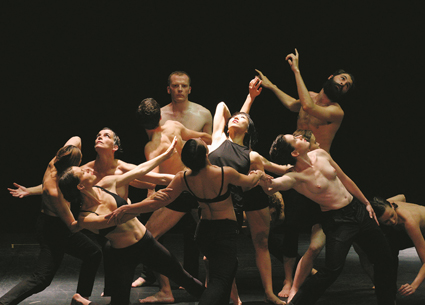
Shanghai Bolero
courtesy Carriageworks
Shanghai Bolero
Dance is a form you’ve committed to strongly. Next year you have Compagnie Didier Theron, which is quite a coup.
This year we partnered with Brisbane Festival to present the amazing Doku Rai and Fight the Landlord. We proposed Didier’s company and we were lucky they concurred. It’s the first time he’s ever presented a work in Australia: three radically different responses to Ravel’s Bolero in the one show.
You come from a visual arts background. What appeals to you in dance?
My passion for it started at Campbelltown Arts Centre where dance programmer Emma Saunders and I curated What I Think About When I Think About Dancing (2009), looking at the intersections between visual arts and contemporary dance. I really loved the way artists in the independent dance sector worked. It’s the visual and the repetitive nature of dance that appeals, and the exactness and discipline. A company like Rosas [creates] a visual artwork that moves in an incredible way over an extraordinary duration. I think that’s one of the most incredible experiences that I’ve had in a theatre ever.
You also have Force Majeure, resident dance company at Carriageworks, doing several shows.
At the end of the year we’re co-commissioning and presenting Obscura with the company; it’s a major work by Byron Perry. In other dance, from MAU we’ll have the very beautiful Stones in her Mouth, which just opened at Red Cat in Los Angeles to really amazing reviews. We’ve established a relationship with the Keir Foundation and Dancehouse to establish the Keir Choreographic Awards which will invest in new commissions and a cash prize. We also have a multi-year partnership with NAISDA as well, presenting their end of year work and doing residencies in their Central Coast [facility]. And we have a Ken Thaiday Snr exhibition, featuring headdresses and performance from the Tiwi Islands, the Sydney Dance Company’s New Breed, works by four choreographers, two from outside the company; the NAISDA end of year show; and a new show, Choreography, by Garry Stewart with NIDA students.
As part of our policy we co-commission or co-present a number of works with resident companies every year. With Performance Space we’re doing the Ken Thaiday Snr show, as a co-commission, a work by electronic media artist Pia Van Gelder and a multi-sensory environment by Cat Hope and Kate McMillan. We’re working much more in partnership with Performance Space in 2014.
What is Carriageworks’ role in the Biennale of Sydney?
We’re a major venue partner. This is a first which ranks us with AGNSW and the MCA and brings the Biennale to this part of town. We’re presenting around 25 works over Bays 22-24 and we’re commissioning a major new work by the Berlin-based English artist Tacita Dean. It’s Biennale director Juliana Engberg’s idea but we’re producing the work for them and working directly with Tacita Dean.
You also have events focused on food, with a co-production, The Serpent’s Table, with Griffin Theatre Company featuring chef Adam Liaw and others, a two-day sustainable food event and Carriageworks is now managing the Eveleigh Market.
And Kylie Kwong is our 2014 Carriageworks ambassador. It’s important the market is integrated into the precinct. Broadly, we have a commitment to excellence in contemporary arts and culture; whether that’s fashion or food or music or dance. We always try to make interesting intersections.
You’ll find more about the substantial 2014 Carriageworks’ program, including Back to Back’s Ganesh vs The Third Reich and New York-based durational performance artist Teching Hsieh (in partnership with UNSW College of Fine Arts)
Carriageworks 2014 program: www.carriageworks.com.au
RealTime issue #118 Dec-Jan 2013 pg. 18
© Keith Gallasch; for permission to reproduce apply to realtime@realtimearts.net
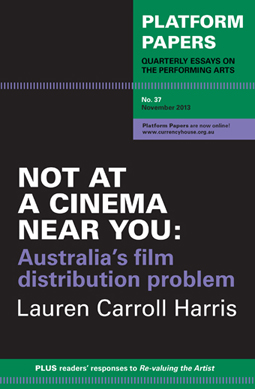 There’s been quite an upsurge in discussion recently on the distribution and exhibition of Australian films, both in the traditional and online media and in sessions at various conferences. It’s a debate that’s been driven in part by continuing concern about the failure of many local films to reach their audiences, and in part by the potential for new and innovative methods to reach those audiences through digital distribution.
There’s been quite an upsurge in discussion recently on the distribution and exhibition of Australian films, both in the traditional and online media and in sessions at various conferences. It’s a debate that’s been driven in part by continuing concern about the failure of many local films to reach their audiences, and in part by the potential for new and innovative methods to reach those audiences through digital distribution.
Now there’s a new entry into the debate, the essay Not at a Cinema Near You: Australia’s film distribution problem, which argues that “digital and innovative distribution can haul Australian films from the cultural margins into the mainstream,” and makes a cogent case for substantial change to the traditional methods, proposing instead “a new distribution model that can allow local films to expand their audiences and their revenues.”
In her essay, Lauren Carroll Harris argues that instead of requiring local films to have an Australian theatrical distributor as a pre-requisite for production funding, this stipulation should be expanded to include DVD, Video-on-Demand or non-theatrical, alternative distribution. This way, Harris says, “the distribution of small-budget releases would be diversified in circuits to which viewers are gravitating.”
As she says, “our film culture does not live in the motion-picture theatre, but in the audiences utilising it. . .other circuits are largely invisible because the mainstream media continues to measure Australian cinema solely according to box office sales and ratings.”
The essay contains a brief but sharp and focused history of film distribution in Australia, painting a rather depressing portrait of the current state of affairs in which, as Harris says, “not a single filmmaker or company has figured out how to distribute a film both widely and inexpensively, even with the near-revolutions in digital distribution.” She goes on to detail “the obstruction that Australian films face at the cinema, not to whinge, but to show the necessity for energetic online and non-theatrical distribution. Ancillary markets,” she writes, “are no longer ancillary, they are the markets. It is the cinema that is supplementary. However, we are yet to catch up with this reality: Australian films are released stillborn into a theatrical system that is not designed for them and that therefore reduces their ability to compete.”
As Harris explains, the federal government’s funding body, Screen Australia, has a policy which consists “almost entirely of efforts to boost production and development through direct investment and tax rebates for private investors,” requiring the involvement of “a theatrical distribution company to provide both a massive injection of production funds and to release films into the market on completion.” This, she argues, “hands a disproportionate level of control to distributors who, despite their expertise, are innately conservative and risk-averse in predicting audiences’ desires.”
While Screen Australia has a “sorely needed” Innovative Distribution Program (set to expire this year with so far no plan to replace it), films that signed with non-traditional distributors who are part of this program are precluded from support—“an obvious policy contradiction that is yet to be resolved,” and one that an increasing number of lower-budget, innovative filmmakers are complaining about.
“Rather than leaving distribution to commercial distributors,” Harris asks, “might not an independent committee of distributors (theatrical and non-theatrical), publicists and expert policy makers advise on film projects, from pre-production onwards, on how to build market attachment packages aimed at reaching increasingly dispersed audiences? This distribution advisory board would provide information and experience that right now is mostly in the private sector, create estimates of potential box office and ancillary market performance, suggest the best release platforms for titles in development, offer advice on marketing schemes, and generally be a source of concrete knowledge on industry innovation in forward-thinking distribution.”
The essay provides a detailed assessment of the current distribution structure and provides case studies of films that have been successfully released theatrically and films that have failed and why, and compares and analyses these examples. It looks at self-distribution and at the bewildering possibilities offered by digital distribution, with detailed examples of success stories involving a number of different methods. There is, Harris believes, “a powerful case” to be made for “looking beyond the theatrical horizon towards a ‘handmade’ approach to distribution and marketing that takes equal account of non-theatrical circuits. The goal of a handmade distribution approach is to grow audiences for local content, increase filmmakers’ revenue share and refocus release strategies on the question of accessibility.”
At the recent Australian Directors’ Guild Conference, the session on “The Director as Distributor” looked at the opportunities and problems presented by the variety of means of self-distribution currently available. Moderated by Lauren Carroll Harris, the session highlighted self-distribution by two filmmakers: Bob Connolly, whose successful theatrical release of Mrs Carey’s Concert has become almost a legend (see Dan Edwards, p21), and Genevieve Bailey, a successful maker of many short films, who self-produced and self-released her feature documentary I Am Eleven, which screened for 26 weeks in Melbourne and in 46 cinemas nationally. “The most important element is the audience,” she said. “I really believed we could reach that really diverse audience that was out there, but you have to be willing to work like a crazy person. The reality is that a lot of excellent films are made and never get into a cinema, never get seen.”
Bailey explained how she’d timed the DVD release for Mother’s Day this year, and waited until she was happy with the website. The film had sold 2,000 copies in two weeks (it’s since sold a lot more). Bob Connolly released Mrs Carey’s Concert through Madman, “but we controlled the packaging and the production. And we got a very big advance! But we also put a lot of money into our website, and we’ve sold a lot of DVDs ourselves. We also put our other films on the website, and they’re ticking away very nicely.”
Also on the panel was Thomas Mai, formerly a producer and sales agent, who has been touring the world for five years, talking about the new tools available for filmmakers: crowd funding, social media networking and alternative means of distribution. Now settled in Australia, he received an Innovative Distribution Grant from Screen Australia, with Josh Pomeranz, to help filmmakers with these new tools. “We believe the answer lies with the audience, that you acquire this database of fans. (US doco maker) Robert Greenwald has 2.2 million people in his database. It’s fan dependent—you keep building that database from film to film. Find these people and keep them!”
In this essay, Lauren Carroll Harris has made a timely and important contribution to the ongoing and increasingly necessary debate about old and new film distribution. As she says, there is a “pressing need to re-think distribution as the vital way in which we conceive and reach out to our audience—and an urgent problem requiring a solution for Australian filmmakers.” Let’s hope her essay assists in achieving that solution.
Lauren Carroll Harris, Platform Papers, No 37, Not At a Cinema Near You, Currency House, Sydney, 2013. Platform Papers are available online at www.currencyhouse.org.au.
Courtesy of Currency House, RT has 5 copies of Not At a Cinema Near You to giveaway.
RealTime issue #118 Dec-Jan 2013 pg. 20
© Tina Kaufman; for permission to reproduce apply to realtime@realtimearts.net
It was living in a dictatorship that cemented my love of documentaries. Thankfully, we don’t suffer under such a system, so documentaries in Australia will perhaps never carry quite the same charge they possess in some countries. But ruminations on the stark differences between the documentary world I encountered in China and Australia’s more staid factual realm have been bubbling away at the back of my mind since I returned home in 2011.
Independent Chinese documentaries are cheaply made and technically rough, but the best of this work is infused with a passion that held me transfixed. When I watched these films in cafes, galleries and studios in Beijing, I knew others in the audience felt the same way. So why don’t I get the same feelings here? Digital technologies were supposed to liberate filmmaking, but local documentaries feel like they’re getting less challenging and certainly more formulaic. These thoughts returned to the front of my mind recently with a debate initiated by Australian filmmaking legend Bob Connolly and the publication of Lauren Carroll Harris’ Platform Paper, Not at a Cinema Near You (Currency House). Both offered some provocative views on the structural problems besetting Australia’s documentary scene.
Back in August, Connolly used the occasion of a private screening of Sophia Turkiewicz’s new film, On My Mother, to make a speech problematising the state of Australian documentary funding. Connolly pointed out that almost all forms of Screen Australia funding are now contingent on broadcaster presales—with the result that a pair of commissioning editors at the ABC and SBS exercise enormous power over what documentaries are made. This situation is hardly conducive to diversity, and has been dire for the production of stand-alone feature-length documentaries.
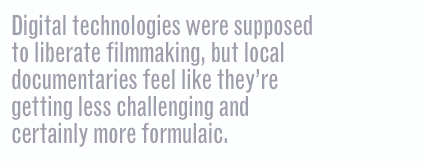 Connolly’s comments are so self evident that the response of the ABC’s Head of Factual Programming, Phil Craig, was somewhat surprising. In an email, later published by Screen Hub, he told Connolly his speech was “utter bollocks” and challenged the veteran director to a head-to-head session at the next AIDC from which “only one of us walks out alive.” For Craig’s sake, I wouldn’t like to lay odds on who would emerge from such an encounter. He later backed down from this rather childish and belligerent stance, but his initial reaction is indicative of the profound resistance of some broadcast personnel to having their assumptions challenged.
Connolly’s comments are so self evident that the response of the ABC’s Head of Factual Programming, Phil Craig, was somewhat surprising. In an email, later published by Screen Hub, he told Connolly his speech was “utter bollocks” and challenged the veteran director to a head-to-head session at the next AIDC from which “only one of us walks out alive.” For Craig’s sake, I wouldn’t like to lay odds on who would emerge from such an encounter. He later backed down from this rather childish and belligerent stance, but his initial reaction is indicative of the profound resistance of some broadcast personnel to having their assumptions challenged.
The point of Connolly’s speech, as he himself later pointed out, was not to criticise the programming decisions of particular commissioning editors. It was to highlight the fact that broadcaster presales now represent virtually the only funding pathway for Australian documentary makers. Since the ABC and SBS are usually the only broadcasters in this country awarding such presales, this places enormous power in the hands of very few individuals and forces almost every project into the television template.
Breaking distribution barriers
Which brings me to Lauren Carroll Harris’ Platform Paper, Not at a Cinema Near You. Harris’ essay focuses on the similarly constricted realm of Australian theatrical distribution, although in this instance the restrictions are more related to commercial oligopolies. Like Connolly, she identifies the necessity of having a theatrical distributor attached to a film to garner Screen Australia funds as a problem for most Australian features. The nature of distribution in Australia means very few local features get any chance to compete fairly against the Hollywood fare dominating cinemas. Harris suggests some innovative ideas for diversifying distribution strategies, mainly revolving around the game-changing nature of digital technologies. Like Connolly, she suggests decoupling film funding from the severely limited distribution options prescribed under Screen Australia guidelines, and cites one of Connolly’s films, co-directed with Sophie Raymond, as an instructive example of how distribution can be done differently.
After their feature-length documentary Mrs Carey’s Concert successfully debuted at the Adelaide Film Festival in 2011, Palace offered Connolly and Raymond a distribution deal. As Harris details, even when these rare deals are forthcoming for Australian work, the terms mean that filmmakers are virtually guaranteed to see no returns, no matter how successful their theatrical run. So Connolly and Raymond rejected Palace’s offer, and organised their own release, initially through nine cinemas, which gradually grew to 70 nationwide.
Self-distribution
Self-distribution is a realistic option in an age when the prohibitive cost of making film prints is no longer necessary. Connolly and Raymond personally worked their screenings, conducting Q&As and selling DVDs. They spread the word among the education and classical music communities in which the film is set, and utilised the Australian Teachers of Media mailing list. They put together a soundtrack CD. They carefully and painstakingly cultivated their audience. The result was one of the most financially successful Australian documentaries in history. That still doesn’t add up to a whole lot of money, but maximising even minimal earnings is important if you’re a documentarian trying to make a living.
In this example, Harris also sees something potentially more empowering in the long run for both filmmakers and audiences. She writes:
“The filmmakers saw distribution as a way of creating the film culture they regard as possible and necessary…active audiences were encouraged to contribute to the kind of film culture they desired.”
To me this is the most exciting—and least realised—possibility afforded by the digital revolution. These technologies allow the possibility of bypassing some of the traditional gatekeepers of public culture to forge an audience more actively invested in what they are seeing. Admittedly, Mrs Carey’s Concert relied on an ABC presale to actually get made, but the filmmakers chose to bypass the oligopoly dominating Australian theatrical distribution to get their work into cinemas. And they took control of building their audience, rather than simply handing their work over to a major distributor with little financial incentive to promote Australian cinema of any kind, let alone documentaries.
Diversifying screen culture
If we’re truly passionate about documentaries as public stories, and not just television “content,” we should not only be making these films by whatever means necessary, but also building events and spaces—both physical and virtual —in which we can share them. Connolly’s arguments about diversifying funding channels for production are important, but any changes to funding criteria should work hand in hand with a more diversified and grassroots screening culture, vital to nurturing a more vibrant and engaged documentary culture. It’s no coincidence that one of the key publicists who helped Connolly and Raymond distribute Mrs Carey’s Concert was Kim Lewis, a veteran of the Filmmaker Co-ops that distributed documentaries and experimental films in most Australian capitals in the 1970s and 80s. The co-ops represent an example of grassroots, filmmaker-led distribution that is sadly lacking in contemporary times.
In fact, in our commercially driven and individualistic era, initiatives like the film co-ops seem like a distant dream. Yet within this history—our history—there lies a whole other way of making, distributing and thinking about films that has largely been forgotten. When I lived in China, Western filmmakers would sometimes smugly tell me that Chinese independents had a lot to learn about tailoring their films to the international environment. It seems to me we could learn—or perhaps relearn—more from them: about why we make documentaries, about building a culture from the ground up, and most importantly, about how our film culture can be so much more than a market. Connolly and Harris have ignited the debate—may it continue to smoulder in 2014.
RealTime issue #118 Dec-Jan 2013 pg. 21
© Dan Edwards; for permission to reproduce apply to realtime@realtimearts.net
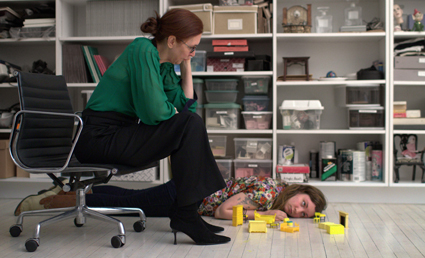
Tiny Furniture
The difficulty of reviewing 2010’s Tiny Furniture in 2013 (just released in Australia on DVD) is that subsequent achievements and work of its writer-director-star Lena Dunham (namely the HBO show Girls and a much publicised multi-million dollar book advance) inevitably loom large over it.
Frequently cited as the work that convinced Judd Apatow to produce Girls, Tiny Furniture claimed the SXSW Film Festival Best Narrative Feature prize in 2010. Considered as a stand-alone work, the film is somewhat frustrating—all promise and no punch. As the precursor to a cult TV show and the early work of an influential filmmaker, it’s fascinating.
Like Dunham’s later work Girls, Tiny Furniture appears to be lightly fictionalised and semi-autobiographical in scope. Dunham plays Aura, a recent film theory graduate returning to her mother and sister’s New York apartment to the borderline ambivalence of both. Dunham’s artist mother, sister and house play their on-screen counterparts, which further blurs the lines between fiction and autobiography. Nursing a lightly bruised heart, Aura embraces her post-graduation ennui by haphazardly drifting into work as a host at a local restaurant, rekindling a semi-destructive childhood friendship, dabbling romantically in a semi-truncated fashion with both ‘internet famous’ Nietzschean Cowboy (Alex Karpovsky) and cute sous-chef Keith (David Call), while alienating family and friends.
Stylistically, the film is languid and thankfully eschews the strangely angled shots and experimental cutting techniques one might expect from a 23-year-old director. The gently wafting score of Teddy Blanks and assured cinematography of Jody Lee Lipes complement Dunham’s keen ear for dialogue and eye for the absurd in daily life. In the vein of Seinfeld and Woody Allen (both self-consciously referenced), and with a nod to the lo-fi naturalistic dialogue of ‘mumblecore,’ Tiny Furniture is not so much a plotted linear narrative as a collection of observations gathered from the viewpoint of a particular cultural time and place. Aura’s crippling lack of direction and ambition are given space to breathe rather than being arbitrarily used to drive a plot forward. The result is assembled into a collage onto which audiences can project their own meaning.
The film’s best passages are those that include family interactions, which enable Dunham’s strength with dialogue and fearlessness as an actor to show. Sadly, even as individual scenes shine (for example a scene in which Aura’s younger sister arrives in the middle of a fight between Aura and her mother only to snicker is one that siblings everywhere will recognise), the whole ensemble is less than the sum of its parts. Promising ideas thread through the film—Aura’s compulsive reading of her mother’s journals from the same life stage—but they jostle with more clichéd elements such as using asexual nudity as a proxy for vulnerability, or the funny-tragic death of a pet. As a result, the film feels uneven. Most frustratingly, intriguing characters emerge in Aura’s life but have no room to grow and so drop out of sight and relevance. The result is that even well realised characters feel like caricatures. Of these, Jemima Kirke shines as childhood friend and inspirational hot mess Charlotte (an earlier incarnation of Jessa played by the same actor on Girls).
Overall, Aura and Tiny Furniture are much less ambitious than Hannah and Girls. Made on a low budget (reported variously as between $25,000 and $50,000) the narrow framing and smaller scale are the film’s strengths. While the film, like Girls, has an overwhelmingly white cast drawn from Dunham’s personal network, the tighter focus of the film on the home life of a single character excuses this to a large degree.
Tiny Furniture is clear on what it is not. The film doesn’t frame Aura’s sexual dalliances as a proxy for a larger commentary on gender relations; there is no grand soliloquy on economic opportunities, or a catalysing moment through which Aura achieves anything like self-awareness or personal growth (although the mere existence of the film indicates very clearly that its creator has). Refreshingly, the film is free of moralising: it neither condemns nor celebrates the effects of wealth and drugs, instead it merely presents a world in which people have differing levels of access to both.
Overall, it’s worth a look, but it won’t sustain repeat viewing. If you like Girls, you’ll enjoy seeing the subtle differences and tracing how the bones of the ideas explored here evolved in a different format. If you don’t, you’ll see the same frustrating self-involvement on display. Creative professionals are often forced to mature professionally in the public eye, with their early work just a quick Google search away. Here, Lena Dunham need not worry—the film is exactly what it should be: the first steps of an intriguing filmmaker.
Tiny Furniture, writer-director Lena Dunham, cinematography Jody Lee Lipes, music Teddy Blanks, Transmission DVD, www.transmissionfilms.com.au
RealTime issue #118 Dec-Jan 2013 pg. 22
© Neph Wake; for permission to reproduce apply to realtime@realtimearts.net
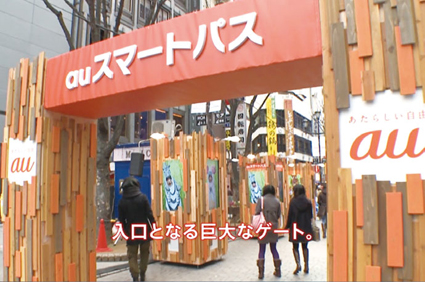
AU Smart Phone installation
The Future. Every proto-modern millennium has kick-started its identity with a wild rash of dreams. Yet many people seem unattuned to the cruel trick being played: when you get to the Future, it becomes the Present. And the Present is that awful place from which so many people wish to escape.
When Steven Spielberg was in pre-production on Minority Report (2002), he convened a small group of unnamed ‘futurologists’ for three days in a Californian chain hotel. This “imagine tank” workshopped how technologies, interfaces and man-machine production/consumption would appear in the Year 2054. The most prescient moment in the film occurs when Tom Cruise is being chased through a hi-tech shopping mall. The large vertical screens in the Gap store show video footage of store personnel who greet Tom by name as he stalks through. They even make suggestions as to what he might like from their new range. Like all futurologist visions, that scene already existed in the minds of companies like Gap. And like all futuristic visions, it is terraformed in the Present.
When the large ShinQ Mall opened in Shibuya in 2012, it featured a large proportion of Digital Signage: custom designed/installed video screens projecting networked data, often synchronised with multiple displays. The Natural Market chain store in the lower basement food hall has interactive digital signage featuring a live feed of the person standing in front of it (filmed by a tiny camera to the left). Cartoon thought bubbles track the movement of the subject’s head, expressing phrases like “I’m going to cook Chilli Shrimp tonight!” The image of the subject is then replaced by a recipe and ingredients (purchasable from Natural Market).
Gimmicky as it is, the perverse futurism of this digital signage lies in its facetious projection of ‘what’s inside the consumer’s mind.’ Futurologists since the 1960s have predicted that marketing/advertising communicating signage (à la Minority Report) will read minds and tabulate desires. The Present à la Natural Market jacks that notion and simply fabricates the image of your mind being read, and predicts what your flaneur mind probably would have said regardless. The Natural Market phrase not only takes place in the anacoustic realm where thoughts seem to appear ‘spoken’ in one’s head, it also results from you reading a response which triggers an anechoic echo of a voiced thought in your head which you never actually thought. This confusion of Self, thought and voice causes a mild-meltdown which is assuaged by ‘identifying’ with those triggers as if it is a pleasurable narcissistic moment.
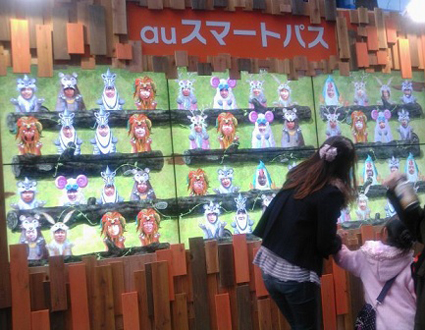
AU Smart Phone installation
Adults and children alike in today’s Hyper-Narcissistic era will accept anything if a photo of their own face is attached to it. The winner of the 2013 Digital Signage Awards in Japan this past April was a walk-through installation at the Shinjuku JR outdoor plaza, produced to market AU network smart phones (AU Sumauro Pasu, 2013). A series of booths employed self-projection of recorded visitors’ faces, but here digitally attached to animated figures of folksy woodland creatures prancing and dancing around a kids’ book wonderland. (Think Gondry-artifice meets Shibuya-kawaii scored by a shambling band from Portland playing xylophones.)
The visitor’s face is first scanned, then rendered into a fake 3D mask, and finally positioned onto the ‘face holder’ of the main animation. Integrated into the rolling animation, the visitor’s face moves and tilts in congruence with the animated figure’s shifting axis. The result of this data processing is to feed ‘your face’ into the multiple synchronised screens of woodland creatures frolicking in unison. Moreover, animated black holes are affixed to your mouth to portray you singing the AU Smart Pass jingle. In a truly futuristic twist on existentialism, your face has become voiceless in proportion to how your voice has become faceless. For it is not ‘your face’ onscreen: it’s the data of your face projecting a mirror effect of what your face would do if it were not you but the ‘you’ desired by the company instigating this audiovisual illusion.
Yet the Japanese context here gives rise to another possibility. Masks in Japan do not simply signify the withholding or concealing of expression. Rather, the mask is an epidermal barrier between thought and word, sense and language. It is a vessel for containing whatever is transferred into it purely by donning the mask. European linguistics do not operate this way due to a variety of complex constructionist and deconstructionist frameworks which articulate determining relations between the Self and language. Looking, reading and listening to your own face in something like the AU Smart Phone installation—cannily replicating a trickster hall of mirrors—facilitates not identification with the Self, but acknowledgement of the you that isn’t there, wherein you experience the image of your own voice.
This year in Akihabara, the Animate store shifted this effect into the 3rd person. An anime-style young woman dressed in casual attire stands in a life-size vertical screen display. Motion sensors program her to call out to you as you pass by. If you stop, she engages in direct questions. A microphone is prominently displayed, inviting you to talk back and ask questions. Essentially, this animated program is a sutoa-nabi (store navigation) display: an info port where you find out what shops are on which levels, and what goods each store has in which sections, plus the animated girl is based on actual young women posted in info booths in large department stores.
Despite her welcoming appearance, this digital display is built upon a database of polite refusals. For example, asking her age will get the definitive Japanese response: “Yes, that’s a hard question to answer,” delivered with a nod. Even though a visitor uses their voice, it is never heard. Instead, it is analysed through speech recognition software and channelled into a pre-ordained communicative stream for eliciting a pre-programmed response. Within the Japanese cultural context, this type of programming is not an awfully inhuman future (feared by Western futurologists), but an idealisation of how rigidly the human can conform to the strictures of social protocol. Again, it’s a virtual imagining of how your voice is rendered as pure image, despite whatever linguistic tools are presumed to be used.
But if Japan is a realm where the Self is razed into a selfless mirage of identity, forever interweaving between masks, it is also maybe the only place where such destructive personification can be celebrated. For Halloween this year, Bacardi Rum in Japan brainstormed some ideas and dryly summated: “We focused on the tendency for drinkers to get louder as they consume alcohol.” Now if this were the Spielbergian futurologists of Minority Report, the outcomes would have been as banal a ‘vision’ as that film’s Gap store digital signage.
But Bacardi Japan came up with Bacardi Scream Halloween (2013): a sexy woman dressed as a witch has her tarty costume modified so that strips of her thighs, waist and breasts are covered with a special fabric which ‘becomes transparent’ to reveal her flesh, as if one is looking through retro-50s X-Ray Spex. But to get her attire to ‘become transparent,’ one must scream into a microphone at the end of her broom handle, which tabulates the decibel level of the scream and accordingly rates the value from low (her thighs) to mid (her waist) to high (her breasts).
Here, the voice is rendered image—but the cynical operations are strikingly apparent: your voice technologically activates the manifestation of a desired image. In a perverse rebuttal of the AU ‘community’ campaign, the Bacardi campaign culminated in a live event at Club Nicofarre in Tokyo (famous for its huge video walls on three sides of the club). All the screams gathered by the roving sexy witch were encoded, then pitch-assigned into a sampling bank which was then played by a wild hard rock guitarist brandishing a MIDI-guitar (yes!) who did Steve Vai style solos which unleashed the sound-bite screams of the hordes who fed their voices into this data-tabulating apparatus. Plus, a camera had also recorded each scream, and when the guitar solo was performed, each scream’s audio-sample also triggered flashes of the participant’s face screeching into the camera, now played across screens in the club.
Collectively, these examples of recent Digital Signage advertising in Japan reveal how readily people will surrender their Self (face and/or voice) into a data-pool which will mirror and/or echo an image entirely devoid of that Self which served as input. US-dominant web.02-style communalisation (crowd-funding, wiki-teaming, user-voting, choice-tracking etc) continues to paint its outcomes as fantastical apparitions of the Future inhabiting the Present—just as futurologists dream things will be. For those not impressed by such Spielbergian dreams, all those crowds amount to hordes simply in love with the image of their own voice.
–
RealTime issue #118 Dec-Jan 2013 pg. 23
© Philip Brophy; for permission to reproduce apply to realtime@realtimearts.net
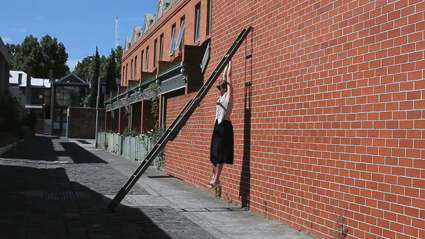
Jacqui Shelton, Silt/Suspended Load (2013), courtesy the artist
Wandering into the darkened main gallery of Gertrude Contemporary on the first afternoon of the Experimental Congress, the visitor was greeted by two prominently placed video loops selected by the curators of Melbourne’s Screen Space. In Jacqui Shelton’s Silt/Suspended Load (2013), Shelton is filmed from a fixed camera angle as she dangles from a ladder, swinging gently back and forth. In Walk III (2010) the camera tracks alongside maker Anna Fuata as she strolls past weatherboard bungalows in what appear to be Melbourne’s northern suburbs: the uncanny quality of the piece stems from the fact that it consists of reverse-motion footage of Fuata walking backwards, though it takes a while for the penny to drop.
Each work functioned as a geometric cityscape as well as a document of a performance: viewed full-length from an unchanging distance, the artist-stars resembled video-game protagonists, focused on nothing beyond an immediate, seemingly pointless task. At the outset of a three-day event examining the past, present and potential future of Australian experimental film and video, it seemed worth pondering the allegorical implications. Were we permanently suspended, trapped in an endless cycle? What could it mean to move backwards and forward at once?
Convened by Danni Zuvela and Joel Stern of the (originally) Brisbane-based OtherFilm group, the Congress was itself conceived along an avowedly circular premise, as an exploration of “the concept of collectivity:” in other words, bringing people together to discuss what the point of bringing them together could be. Evening screenings and presentations were preceded each afternoon by informal roundtable discussions, open to the public but attended mainly by curators and artists at the rate of about a dozen per day. Historical background was supplied by group elders Dirk de Bruyn and Richard Tuohy, spinning tales from those far-off days of the mid-to-late-1990s, when the Melbourne Super-8 Film Group flourished at the Erwin Rado theatre in Fitzroy and Sunday night screenings of avant-garde classics were held at Cafe Bohemio just around the corner.
Truth be told, I can remember some of this stuff myself, strange as it seems to have lived through an era when experimental moviemakers could function without significant commercial ambition in an analog world, rather than as entrepreneurial digitally-savvy ‘creatives.’ The Super-8 Group recurred as a reference point throughout the Congress, with De Bruyn devoting half a presentation to the best lines salvaged from their newsletter (“Be suspicious of men with cameras and record collections instead of girlfriends,” from the late Vikki Riley, remains the money quote).
It would be unwise to go too far in romanticising the group, given the hit-and-miss offerings at any given open screening, not to mention a management style which (by all accounts) was exactly what you’d expect from an organisation run on a shoestring by cranky artists. Yet it did provide a space where hobbyists, purists, go-getters and try-hards of all stripes could rub shoulders and exchange ideas. This was a milieu where even narrative filmmakers such as Bill Mousoulis and Mark La Rosa were able to stay in touch with an experimental culture; likewise, it’s uncertain if Tony Woods’ sophisticated mingling of documentary and abstract modes would have found an equally receptive audience elsewhere.
Nowadays such pluralism feels all but unimaginable, except perhaps online. The somewhat passive-aggressive opening statement of the Congress took up this theme, citing Freud’s notion of the “narcissism of minor differences” in relation to organisations competing for slices of the funding pie. Now that most so-called film is entirely digital, the question of medium specificity is moot—though a few diehards such as Tuohy and his associates at the Artist Film Workshop cling to the old avant-garde traditions, like monks still toiling at illuminated manuscripts in the age of printing. In the meantime, many video artists remain averse as ever to anything that smacks of cinematic craft, though most would presumably acknowledge in principle that no action can be recorded in a ‘neutral’ way.
Too bad the discussions never got down to the nitty-gritty of exploring what artists fixated on the material qualities of celluloid could learn from those concerned primarily with performance and duration, and vice versa. But then, for every testament to the value of co-operation the Congress offered a reminder of the innately (and valuably) antisocial side of the avant-garde—in De Bruyn’s preoccupation with paralysis and trauma, in Tuohy’s abrasive flicker film Dot Matrix (2013) and perhaps most viscerally in the work of Andrew Harper, whose Piss (light) (2007) was the upshot of submerging a reel of Super-8 film for a year in the titular bodily fluid. This was shown in a video copy, the original being too fragile and precious to risk; Harper’s initial, unrealised plan was to project it onto a ‘screen’ consisting of his body, where the material basis of the work originated. This was another kind of closed loop, again echoing the solipsism of the Congress more generally; explicitly political issues were hardly broached, apart from some forlorn talk about Occupy-style takeovers of public space.
Still, discussion did give rise to some modest, practical suggestions about how a sense of community might be maintained: through an email list, for example, or a successor to the film co-ops of the past. Another technique of circuit-breaking was suggested by reports of curatorial projects aimed at bringing experimental film and video to a wider audience, such as De Bruyn’s Outside the Outside screening series in Dandenong, or the annual shows which Jim Knox has mounted in recent years at the Meredith Music Festival. Knox’s presentation to the Congress included extracts from numerous oddities in his collection, ranging from a 1950s Disney cartoon about life on Mars to an extraordinary found-footage montage by Soviet director Elem Klimov, satirising the decadence of the West. As ever, his admirable approach is less about irony than about getting us to recognise the cockeyed artistry in work far outside any official canon—demonstrating, in passing, that history can always be written anew.
Experimental Congress, convenors Danni Zuvela, Joel Stern, Gertrude Contemporary, Melbourne, 30 Oct–2 Nov
RealTime issue #118 Dec-Jan 2013 pg. 25
© Jake Wilson; for permission to reproduce apply to realtime@realtimearts.net
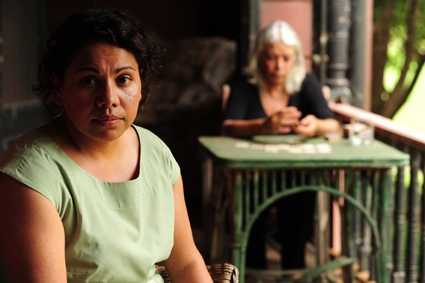
Deborah Mailman, Marcia Langton, The Darkside
photo Tony Mott
Deborah Mailman, Marcia Langton, The Darkside
Drawing upon primal fears of darkness and the mysteries of death, the ghost story is perhaps the most relatable of tales. With this feature-length addition to a venerable ghost anthology tradition which encompasses collections of stories from different cultures, eras and individual writers, Samson and Delilah (2009) writer-director Warwick Thornton seeks to explore an Indigenous experience of the ‘other side.’
After calling via traditional and social media channels for first-hand accounts of ghostly encounters, Thornton and producer Kath Shelper narrowed an initial 150-odd submissions down to a dozen. Using Thornton’s interviews with these 12 storytellers as core material for the screenplay, the resulting film is part-genre, part-oral history project. It is full of a promise that doesn’t quite materialise.
Except in a couple of cases where the storyteller doesn’t appear onscreen, each story is presented essentially in monologue by an Australian actor, with Bryan Brown, Deborah Mailman, Claudia Karvan, Aaron Pedersen, Jack Charles and Sacha Horler among the prominent names featured. Thornton’s preferred approach is to maintain a largely static shot of the teller in his/her environment—an environment that sometimes reflects the narrative (river and coastal stories are told by Brown and Horler near water; Shari Sebbens’ account of a family vigil for a dying infant is told in a hospital). In some instances, however, more lateral or abstract images are superimposed over the teller’s voice, most notably during Sharon Cole’s eerie roadside tale, accompanied by artist Ben Quilty working close-up on one of his characteristic impasto landscapes. Ultimately, the painting resolves at a distance into an image which resonates with the story’s conclusion. It’s a texturally interesting approach, though the footage tends to compete with the words.
It’s no coincidence that the more concise stories, as well as those whose visuals accentuate rather than nullify the verbal content, are among the more engaging in the collection. Filmmaker Romaine Moreton speaks of a troubled residency at the National Film and Sound Archive, formerly the Australian Institute of Anatomy, over a pastiche of foreboding interiors, historical ethnographic footage and the piercing light of a film projector—images which lend a clinically cruel edge to her account of the unsettled dead. Some narrators command more attention than others, with skilled raconteur Jack Charles at the fore here.
The Darkside’s main problem is verbosity. Thornton’s commitment to exactly replicating these interviews, intrinsically interesting as they are, is at odds with the overwhelmingly visual nature of cinema. As tales meander and fall into repetition, the viewer’s attention wanders. The director’s recent forays into video installation with Stranded, 2011 (commissioned by the Adelaide Film Festival; RT102) and Mother Courage, 2012 (commissioned for Documenta13; RT113) seem to have influenced The Darkside’s deliberate pace and use of imperceptibly changing imagery. It’s an approach that’s more suited to the fluid dynamic of a gallery than the captive situation of the movie theatre, where attention needs to be seized and maintained. Thornton might have been trying to avoid horror movie clichés, but attention to the way the best genre cinema manages to grip its audience viscerally would have given these stories a far greater chance to shine.
The Darkside, director, cinematographer Warwick Thornton, editor Roland Gallois, sound designer Liam Egan, producer Kath Shelper; Australian distributor Transmission Films
RealTime issue #118 Dec-Jan 2013 pg. 26
© Katerina Sakkas; for permission to reproduce apply to realtime@realtimearts.net
Despite burgeoning interdisciplinarity and crossovers, the line between art and the creative industries over recent decades remains firmly etched in the cultural psyche. In our Art, Wellness & Death feature in RealTime 117, we profiled artists Efterpi Soropos and George Poonkhin Khut who are developing commercial applications of their creations to aid the dying and those in pain, without surrendering their sense of being artists. I have friends who would be labelled ‘creatives’ in the commercial world whose inventiveness surpasses that of many an artist but who bemoan their lack of artistic freedom given the narrow ambit of commercial design and other practices in Australia.
George Hedon, an art director for a Melbourne advertising agency, co-founded Pause Fest with Filip Nakic four years ago with a passion to “create a collective digital community,” bringing together creatives who might normally not mingle, let alone collaborate, from a wide range of industries engaged with digital technologies: “advertising, digital design, animation, production and post-production, as well as incubators and start-up communities.” I recently spoke with Hedon about the festival and its ambitions.
Hedon, who had no experience of running a festival, has grown the event by encouraging the generosity of speakers, pro bono support, in-kind donors and volunteers (some 30-60 per festival), such is the enthusiasm for the event. The response from the field has been strong, the scale of the festival grows and the City of Melbourne has proved financial support for the 2014 Pause Fest.
Pause Fest takes creatives outside their usual parameters, offering pause: time-out to meet, think and potentially collaborate. This year’s festival theme is “connections,” between individuals and industries. Hedon believes that the event has generated “a collective digital community” via “a non-profit event in which any income is put into the festival’s future.”
In our discussion there’s occasional telling slippage in terminology. When I ask Hedon how important it is for creatives to escape the boundaries of their professions, he answers, “It’s the most important thing: to be able to express yourself, in your artform, to explore your ideas and then apply yourself to a commercial world.” Do all the outcomes have to be commercial? “Everything ends up being commercial,” he replies. But it’s individual creativity and identity that counts: “You have to have your own signature before you go into the commercial.” Which is where Pause Fest offers succour. However, Hedon admits, “we’re sitting on a fence of what is commercial and what is art. We’re really pushing [the] art and technology [connection].”
It’s not surprising then that Hedon is particularly pleased with the festival’s interactive installations program. Ten works were short-listed and two chosen for realisation.
Three of the works are Australian, one is Polish. The brief was to create installations that would “engage a wide audience: adults, kids, families, the elderly.”
A key part of the Pause Fest program from inception is animation: the first encouraged collaborations between animators and sound designers around the world. Overseas makers, who mostly work in post-production and other areas of commercial production, are grateful for access to Pause Fest’s animation program, although Australians, says Hedon, are less eager, but are catching up. A very broad theme is set for the animators to apply to an otherwise “blank canvas.” Last year the theme was “the future,” which resulted in “some very dark work. It’s a happy theme this year.” The works will be screened at ACMI, on Federation Square’s big screen and online.
Pause Fest has an extensive program of talks and forums to which has been added for the first time an intriguingly titled event, PanicRoom. Hedon explains it’s the creation of PostPanic, a post-production company in Amsterdam founded by its Creative Director Mischa Rozema, a keynote speaker at this year’s festival. PanicRoom gatherings, explains Hedon, “are not about making speeches or talking about the work. They are interested in everything else: what creative people like, what their influences are, their experiences, their favourite music—who they are and what makes them tick.” PanicRoom will feature Australian creatives, revealing dimensions that feed their creativity in a four-day Pause Fest that will buy them some liberating time-out.
2014 Pause Fest, ACMI and Federation Square, Melbourne, 13-16 Feb, www.pausefest.com.au
RealTime issue #118 Dec-Jan 2013 pg. 26
© Keith Gallasch; for permission to reproduce apply to realtime@realtimearts.net

Joanne Mott, Grounded, 2013, native grasses, sedges and rushes, Palimpsest
photo John Power
Joanne Mott, Grounded, 2013, native grasses, sedges and rushes, Palimpsest
“Palimpsest means a parchment that has been partly erased and re-inscribed. It evokes the marks made by human settlement on the land, the passage of time, presence and absence and the web of inter-dependence uniting the natural and the cultural, the material and the immaterial.”
www.artsmildura.com.au/Palimpsest
The “Biennale of the Bush,” as Palimpsest is sometimes known, is huge, both in terms of the number of artists participating and the sheer geographic scale of the event. Since its inception in 1998, the environment has been a recurring theme in Palimpsest. Outdoor works featured prominently this year, some hearkening back to the Mildura Sculpture Triennials of the 1970s—among the first events in Australia to move out of the gallery and situate artworks in the natural environment. This link was particularly notable in Joanne Mott’s living installation, Grounded, located in the very same park (a reclaimed rubbish dump) that housed the outdoor artworks of the Sculpture Triennials.
Mott’s creation has sustainability at its core. It uses living, Australian native, anti-erosion grasses planted to spell out GROUNDED, reflecting various interpretations of the word, including the very soil in which the grasses are planted and the concept of being psychologically earthed. This work is a continuation of Mott’s practice of planting and her conceptual interest in what she describes as the “heterogeneity of ‘nature’ and ‘culture’,” which are united in her artworks (www.joannemott.com). In Grounded, the health of river systems is reflected in the proximity of the artwork to the river and her use of soil erosion grasses that prevent riverbanks from being washed away. Clearly hand-planted, Grounded emphasises human presence, encouraging consideration of the efforts people make to repairing the environment.
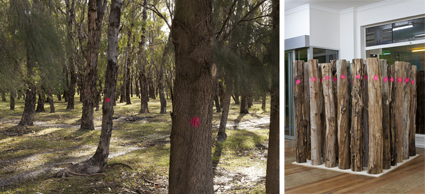
Danielle Hobbs, 7000 eucalypts, 2013, mixed media installation, Palimpsest
photos Kristian Häggblom
Danielle Hobbs, 7000 eucalypts, 2013, mixed media installation, Palimpsest
Danielle Hobbs’ 7,000 Eucalypts comprised a gallery-based sculpture and a large site-specific artwork, drawing on the symbolism of a famous work by German artist Joseph Beuys: 7,000 Oaks. Completed by Beuys and the townsfolk of Kassel for Documenta 8 in 1987, it bore a message that related to both environmental remediation and urban renewal. This resonated with Hobbs, who reworked Beuys’ idea into an artwork that also had personal resonances for her. On a property managed by her father, the artist reframes a forest of hundreds of Australian gums from plantation trees into both an artwork and an environmental statement. Each tree was spray-painted with a pink dot, like those that councils use to indicate a tree destined for removal. The trees in 7,000 Eucalypts reflect new thinking about sustainable logging, but are also, says Hobbs, a reminder of the thousands of old-growth forests being cut down every day (Artist Talk, 5 October).
Hobbs has maintained a sense of environmental responsibility since her youth and admits to being a vocal critic on the subject, even within her own family. Thus, her father’s movement into sustainable logging makes the work personal. From the perspective of an observer kept behind safety fences, I found the number of trees marked for felling moving—representing a metaphorical and very real barrier between humans and the environment given the ongoing demand for wood-based products. The number of forests that are logged is alarming though there was some relief in knowing that these trees were not old growth.
Hobbs’ gallery-based work was featured in the ADFA building, recently refurbished as an art gallery, having formally housed the Australian Dried Fruits Association and fallen into disrepair. Hobbs describes her work as “art as an ecological intervention,” drawing on environmentalist themes and presenting them as art. The sculpture in ADFA draws on the same imagery as in the plantation, but we are instead presented with sawn logs. Stretching between plantation and gallery, 7000 Eucalypts offered passive yet powerful imagery, linking iconic Australian trees, and therefore the greater Australian environment, with the global one by referencing Beuys’ 7,000 Oaks. A sense of the presence and absence in trees growing and logged, was consistent with the Palimpsest theme.
Also using the outdoors and gallery space to engage with the environment, David Burrows drew on the landscape of Mildura’s Lake Ranfurly, an artificial stormwater basin covering almost 200 hectares. My first impression of the ‘lake’ was of a large open span of sand, devoid of water, invoking concerns about water security in Australia. In this ‘lake,’ Burrows presented Mirage Project ….[salt], a reinterpretation of his Mirage Project ….[iceberg] presented in 2012 in Melbourne’s Federation Square. This project utilises stereoscopic 3D photographs of icebergs taken by Burrows in Antarctica and seen, on the lake, through mounted binocular slide viewers. These works were carefully positioned so that the viewer could see the icebergs from the same positions that the original photographs were taken. These images of beautiful, naturally formed ice sculptures contrasted sharply with the arid lake. As you see the three-dimensional detail of the icebergs, your body feels the dry heat and baked sand, generating a sense of the very real potential of global warming to transform one landscape into the other. Burrows’ companion work, Crepuscule was featured at Mildura’s Wallflower Photomedia Gallery presenting beautiful photographs of the slowly changing effects of light on Lake Ranfurly.
Juan Ford’s Lord of the Canopy at the Mildura Arts Centre, embodied the nocturnal ambience of nature in a darkened gallery lit with spotlights casting ominous shadows on the walls. A large tree on the gallery floor comprised several segments, visibly bolted together into what Ford describes as a ‘frankentree’ (Artist Talk, 6 October). A highly polished possum ring (sheet-metal designed to prevent animals from climbing trees) was positioned on the trunk to reflect a large, circular painting of the warped image of a possum on the gallery wall, establishing a dialogue between the natural denizens of the Australian night and the human hand on the environment. Walking through Lord of the Canopy, I felt the need for quiet and slow movement as one might when encountering a possum at night in your backyard. Yet that feeling of wonder was overshadowed by the ‘wrongness’ of this bolted-together, artificial tree and the denial of the possums’ natural home represented by the ring.
These works, just a few of the many created by the 49 artists in this year’s Palimpsest, demonstrated not only a developing subgenre of Australian art concerned with the environment, but also a wider consciousness of the natural environment and a gradual inscription and re-inscription of the environment. While I’ve focused on works with direct environmental concerns, other artists created works with subtler tones of environmentalism and a diverse array of other themes including surveillance, mental health, blended cultures and the changing face of Mildura. Palimpsest is a powerful event reflecting many current concerns through the lens of contemporary art.
Arts Mildura, Mildura Palimpsest Biennale #9, curator Helen Vivian, assistants Geoffrey Brown, Rachel Kendrigan, Rohan Morris, various venues in and around Mildura, 4-7 Oct, www.artsmildura.com.au/palimpsest/
RealTime issue #118 Dec-Jan 2013 pg. 28
© Jane Wildy; for permission to reproduce apply to realtime@realtimearts.net
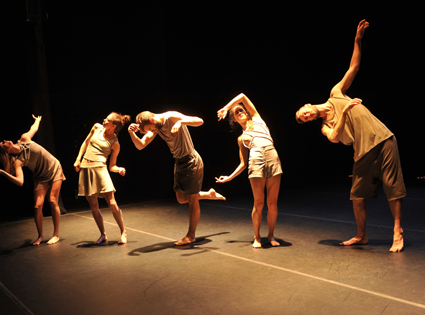
Alana Everett, Lauren Langlois, Rennie McDougall, Lily Paskas, Lee Serle, A Small Prometheus
photo Jodie Hutchinson
Alana Everett, Lauren Langlois, Rennie McDougall, Lily Paskas, Lee Serle, A Small Prometheus
The beginnings of a dance work, or any project for that matter, may be happenstance. A match is struck: the spark of an idea flashes, catches, gently glimmers and grows. Eighteen months later, five dark figures cluster around three metal sculptures, methodically lighting a circle of candles. The heat created by their combined candlepower causes a circular propeller to spin, gently pinging and sounding as it revolves. This is an altar to the power and beauty of fire, a ritualistic beginning, which transforms heat into movement.
Kinaesthetically, much the same happens. Bodies roll, push, pull, crawl, arch and twist into sitting and standing. Five dancers line up along a diagonal; runners at the starting line. There is a kind of pause, an in-breath before the dancing begins. The work is poised before its own future. We know that A Small Prometheus is about fire but, given this is not a narrative, how does the idea of fire meld into movement? Stephanie Lake’s treatment of her topic merges with the musical input of her collaborative partner, Robin Fox. Billed as a joint creative venture, we find the music playing an equal, sometimes dominant, role in the work. Mostly this enhances the quality of the dancing but sometimes eclipses it. While all dance to music needs to determine its relation to the music, the nature of this collaboration raised the status of the sound. If the music takes the lead, the challenge is to take up its stimulus without surrendering to it, to make the sum greater than its parts.
A Small Prometheus consists of a series of responses to its theme. It offers a kinaesthetic poetics of fire played out in the body. For example, impulses work their way through the dancers’ bodies which jerk at speed. Each body has its own way of enacting these qualities. Lily Paskas rips through space without pause for thought. Sometimes the dancers are dancers, forming duets, circles, lines, hoisting bodies, lifting legs. Other times, their bodies are a staging ground for actions that reflect ideas of fire, heat, light or convection.
As this dance is performed, bushfires rage in the Blue Mountains, destroying hearth and home with a fearsome intensity. The dancers stage a form of collapse in their bodies. There is less sense of danger here however, for the group hovers, ready to catch them. Rennie McDougal performs an interesting solo with elements of collapse and support within his own body rather than in partnership with the group.
Returning to ritual, four dancers sit in front of large ashtrays, striking matches in time to the sound. These simple relations between light and sound are mesmerising to watch, an aesthetic form of child’s play.
At some point well into the piece, the choreography really took off, in terms of flow, intensity and energy. It would have been wonderful to see the entire piece operate at this level. This is probably a question of time and resources, to be able to dwell with the choreography, edit, rework and polish. Another iteration of this piece-—a phoenix perhaps—might consider the coherence of its parts, the relation between its sections, and to the theme as a whole, moving beyond an episodic feel to some other sense of structure or interrelationship between the various thematic moments.
A Small Prometheus, creators Stephanie Lake and Robin Fox, choreographer Stephanie Lake, composer, sculpture designer Robin Fox, performers Alana Everett, Lauren Langlois, Rennie McDougall, Lily Paskas, Lee Serle; Arts House, Melbourne, 15-20 October
RealTime issue #118 Dec-Jan 2013 pg. 31
© Philipa Rothfield; for permission to reproduce apply to realtime@realtimearts.net
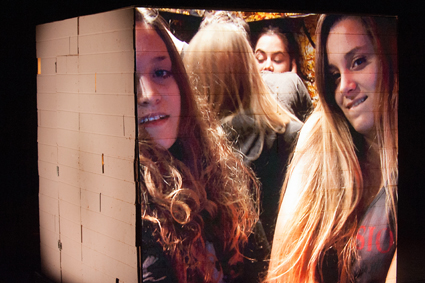
Teenage Riot, Ontroerend Goed
photo Sarah Walker
Teenage Riot, Ontroerend Goed
Cinema theory has a wonderful term that doesn’t quite have an equivalent in the discourse around theatre: exploitation. In both industry and critical parlance, the exploitation film has long been that which panders to a particular (often prurient) interest, ‘exploiting’ an exotic or vaguely taboo subject and equally ‘exploiting’ a niche audience attracted to such fare. These are the B-movies of suburban drive-ins, grindhouses and midnight marathons. Perhaps it says something of the overwhelming gentrification of theatre in the 20th century that equivalent alternative avenues have mostly failed to find popular appeal.
Ontroerend Goed, Teenage Riot
While viewing Ontroerend Goed’s Teenage Riot my mind kept returning to the subgenre of teensploitation. It’s a rich vein in film, canvasing everything from the saccharine beach party movies of the 60s to the sensational slashers of the 80s and the more respectable output of director John Hughes during the same period. Originally intended with no more noble goal than to rake in the pocket money of high schoolers, the teen film over time became a way for its typical consumer to develop a sophisticated and critical engagement, assessing the truth and artifice of the depictions on screen and defining an identity both through and against them.
Teenage Riot could be understood as a live comment on all of this. It’s the second part of Ontroerend Goed’s trilogy of works performed entirely by teens, and it explicitly concerns itself with the spectatorship: for much of its running time the large staff of players are hidden inside a wooden box, manipulating handheld video cameras to reveal projected fragments of what’s going on inside. That the audience is therefore cast in the position of voyeur (another nod to film theory) isn’t just implicit. Performers offer teasing glimpses of bared flesh before laughing defiantly down the camera lens, make out with one another and offer instructional sermons on fingering, bully and brutalise and shrug it all off with irony or indifference.
The work could be a challenging, even confronting gesture of inter-generational defiance, and a knowing rebuke to elders who assume teens are incapable of reflecting upon their lot with any critical distance. But here’s why I really began pondering teensploitation: the work is billed as written and directed not by its performers but by Ontroerend Goed artistic director Alexander Devriendt and dramaturg Joeri Smet, neither of whom is close to his teens. I have no idea of the process of development the work underwent, but when a pair of adults append their names as the primary creators of a work concerned with teenage excess and libidinal overflow, which furthermore positions its audience as leering creeps—well, where are Devriendt and Smet in that equation? Teenage Riot leaves everyone looking a little bit dirty, except its notably absent makers.
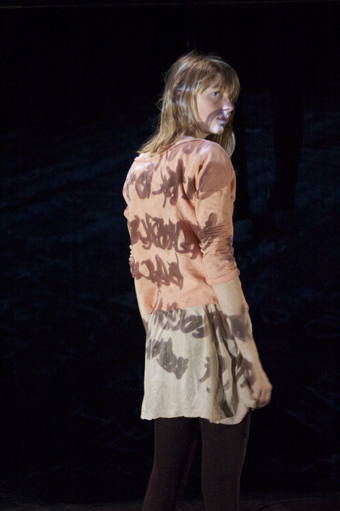
Anna Jakoba Ryckewaert, All That is Wrong, Ontroerend Goed
photo Elies Van Renterghem
Anna Jakoba Ryckewaert, All That is Wrong, Ontroerend Goed
Ontroerend Goed, All That is Wrong
The third in Ontroerend Goed’s teen trilogy, All That Is Wrong, is a refreshing curative. Performer Anna Jakoba Ryckewaert is also the work’s writer, in more than one sense: the piece consists of Ryckewaert scrawling countless words in chalk on an expanse of blackboard filling the floor of the playing space. The 18-year-old is joined by another youth, Zach Hatch, who films the text as it is written (and which is then projected against a backdrop) as well as operating sound cues. Occasionally the two will speak, but are silent for most of the work’s duration.
Ryckewaert writes the word ‘I’ and begins to add modifiers – ‘18’, ‘Belgian’, ‘introvert’ – which quickly spiral out to encompass a less certain and more connected cross-hatching of identity: corners of the space become crowded with personal fears or global horrors, while earlier sections are revisited and revised. The overall effect is cumulative: we are left with the unmistakeable sense of someone who both thinks and cares a great deal about the world into which she is graduating, and of a work that trusts its maker enough to let her do the talking. Or, at least, writing.
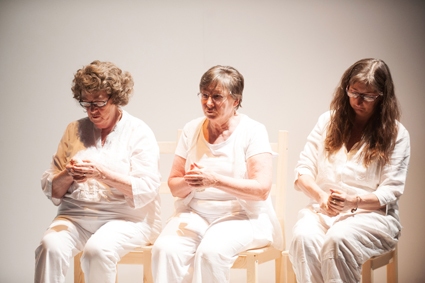
In Spite of Myself, Nicola Gunn
photo Sarah Walker
In Spite of Myself, Nicola Gunn
Nicola Gunn, In Spite of Myself
Melbourne performance maker Nicola Gunn has for some years exploited the most interesting of subjects: herself. Or, at least, an amorphous figure known as ‘Nicola Gunn,’ though one could keep adding more and more quote marks around the name as the meta-theatrical frames around her investigation have continued to multiply. In Spite of Myself is her most accomplished (not to mention hilarious) experiment yet. It’s ostensibly a retrospective exhibition of works by Nicola Gunn entitled Exercises in Hopelessness—Nicola Gunn (1979-present), with a bonus lecture by Susan Becker, international curator at Arts Centre Melbourne. Becker is, of course, Gunn, but Gunn is not entirely Becker, just as ‘Gunn’ is not Gunn, and the way the performer flips between different masks rapidly begins to resemble the cups and ball trickery of a fleet-fingered street magician.
Where Gunn’s ongoing project is most interesting is in the way it amplifies the utter artificiality of theatre, and an extreme form of self-reflexivity that is consistently ahead of its audience, while remaining deeply autobiographical and resoundingly true. Gunn makes art about making art, but rather than descending into navel-gazing she dredges up the very intimate pains and absurdities of that experience. She exploits a trio of older women by giving them the task of fashioning hundreds of tiny clay figurines, which she promptly stomps all over. She rails against the recycling practices of the Arts Centre that is presenting her work, even though that work itself will end up as a very real pile of garbage by the show’s end.
And underlying the futile artistic acts in which Gunn indulges is the worry that all art is quite useless, that she is yelling into a void. Where many peers stall at precisely that point, Gunn (or ‘Gunn’) somehow forces her audience to join hands and yell with her, creating a shared experience she describes as a heterotopia, though naming it seems just one more futile gesture. In Spite of Myself is, indeed, an argument against its own premise, an effacement of Nicola Gunn that produces a sort of ur-identity among her viewers. It’s bloody funny, too.
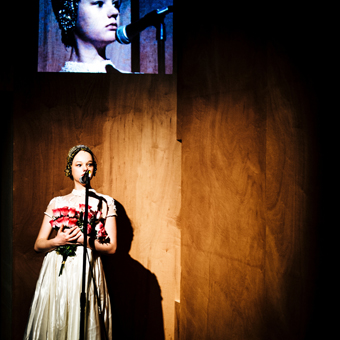
Emily Milledge, Room of Regret, The Rabble
photo David Paterson
Emily Milledge, Room of Regret, The Rabble
The Rabble, Room of Regret
That “all art is quite useless” is the contradictory provocation that prefaces Wilde’s The Portrait of Dorian Gray, the latest text to be mercilessly ravaged by Melbourne outfit The Rabble. As with all of the company’s work, a familiarity with its source(s) offers no magic key to unlocking its secrets, and Room of Regret is in some respects its most inward, mysterious production so far.
The performance occurs within a maze-like installation in which audiences are split up and seated in separate rooms. Performers are often invisible to a good portion of that audience, then, or mediated via screen and projection. The text is similarly splintered, with short portions of Wilde’s words carved from their context and repeated over long durations, usually in a heightened and histrionic manner.
The visual realisation of the work is decadent, lush, almost overpoweringly so, drawing in influences from the Baroque and Victorian to 70s glam and contemporary performance art. The design, too, is both disorienting and appropriate—in separating audiences and their gazes, we are no longer the crowd but become keenly aware of our disconnectedness in a shared experience. Excess and anomie thus shift from themes in a novel to very palpable sensations in this work, and once again where The Rabble exceed most others is in producing this visceral, rather than literal, conjuring of a written text’s essence. It’s uneasy, incomplete, even hard to like, but almost impossible not to admire.
Melbourne International Arts Festival: Ontroerend Goed, Teenage Riot, director Alexander Devriendt, writers Joeri Smet, Alexander Devriendt, Fairfax Studio, 15-18 Oct; Ontroerend Goed, All That Is Wrong, writer Anna Jakoba Ryckewaert, director Alexander Devriendt, Fairfax Studio, 19-20 Oct; Sans Hotel, In Spite of Myself, creators Nicola Gunn, Gwen Holmberg-Gilchrist, Pier Carthew, Michael Fikaris, performers Nicola Gunn, Maureen Hartley, Brenda Palmer, Annabel Warmington, Fairfax Studio, 9-13 Oct; The Rabble, Room of Regret, creators Emma Valente, Kate Davis, director Emma Valente, design Kate Davis, performers Pier Carthew, David Harrison, Alex McQueen, Emily Milledge, Mary Helen Sassman. Theatre Works, St Kilda, Melbourne, 21 Oct-3 Nov
RealTime issue #118 Dec-Jan 2013 pg. 33
© John Bailey; for permission to reproduce apply to realtime@realtimearts.net
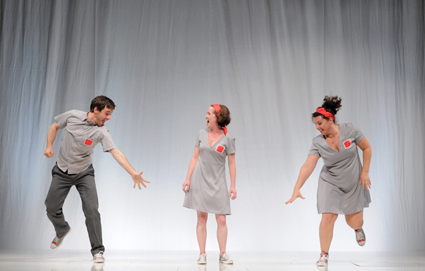
Life and Times: Episode 1, Nature Theater of Oklahoma, courtesy MIAF
The 10-hour marathon performance of Nature Theater of Oklahoma’s Life and Times: Episodes 1-4 begins with a casual introduction from co-directors Kelly Copper and Pavol Liska. “We are in the business of manipulating time and space,” Liska states, “We want you all to take responsibility for this going well.” Life and Times sets out to transform the entire life story of one person, company member Kristin Worrall, into theatre.
Over 16 hours of recorded phone conversations, Worrall meanders, in painstaking detail, from her earliest memory to age 34. The performance text is a verbatim transcript of these phone calls, preserving every verbal tic, hesitation and redundancy from the original source, every ‘like,’ ‘um’ and ‘ha ha.’ It’s an absurdly quixotic endeavour that could easily have become a stunningly banal vanity project. However, thanks to tight direction, playfully inventive staging and virtuosic performances from the ensemble (Ilan Bachrach, Asli Bulbul, Elisabeth Conner, Gabel Eiben, Daniel Gower, Anne Gridley, Robert M. Johanson, Matthew Korahais, Julie LaMendola, Kristin Worrall), Life and Times is an exhilarating and joyous experience.
In the absence of conventional dramatic content, co-directors Copper and Liska masterfully manipulate the subtle relationship between space, time and stage action. Every glance, gesture and choreographic sequence supports, underscores or cuts across the minor life incident being narrated. Performers move in odd formations while describing everyday experiences, and the punctuation of the original phone call (loops, pauses, self-interruptions) is ingeniously re-purposed to trigger formation changes, exits and re-entries, drink breaks and interval restarts. The performance text is also endearingly self-reflexive about its absurd immensity. Near the two-hour mark, the narrator exclaims: “God, this must be so boring for you. Sorry.”
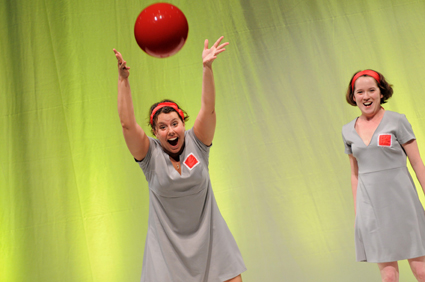
Life and Times: Episode 1, Nature Theater of Oklahoma, courtesy MIAF
Episode 1 takes the form of a musical, beginning appropriately with a bright, folksy overture. The performers sing of memories of being bathed in a sink, of attending kindergarten, of making friends and of growing up in a yellow bedroom. When placed in the wrong reading group in early school, Worrall’s mother has to intervene so she can avoid becoming “a really dumb kid.” Social standing is clearly important from even a very young age, with the text charting petty jealousies about the size of other people’s houses, the kinds of clothes her friends wear and the cars various parents drive. Perhaps mirroring this concern with personal status within the social order, the physical grammar of Episode 1 might be best described as an ironic hipster appropriation of Communist-era mass choreography. The performers adopt and hold strange poses, sometimes aided by bright yellow gymnastic rings, but their facial expression seems consistently anxious, as if worried that despite making the correct gestures they still will not fit into the group.
The stage for Episode 2 is dark and shadowy, moodily lit with swirling stage smoke. Dressed in brightly coloured tracksuits, the performers re-enter with rock-star swagger. Our narrator has dark existential thoughts in the third grade, experiments innocently with sexual behaviours, inspired by daytime TV soap operas, and discovers sex through the medium of her father’s Playboy magazine collection. The emotions described in this stream-of-consciousness childhood remembrance are confused, awkward and ungainly. The treatment of the sung text is overblown, with the high-stakes rock chorus playfully at odds with the sheer ordinariness of the events narrated.
Episode 3 takes place on a manor house set, strikingly reminiscent of Agatha Christie’s The Mousetrap. The performers return costumed as characters in this unnamed detective drama, and the voice of the interviewer appears for the first time, embodied as the ‘detective.’ The acting turns melodramatic, the performers exchange arch looks and make dramatic pauses at unexpected moments, creating an hilarious mismatch between stage action and spoken text. This reaches its apotheosis in a ‘murder’ as the narrator describes her first period and being shocked by the blood. The episode ends with performer Anne Gridley crawling offstage after a frenzied self-questioning as to why this excessive storytelling exercise should continue.
Episode 4 is a tableau, with the cast all standing still onstage as if posing for a group photograph. After the high-energy musical theatrics of the past nine hours, time seems to move slowly during Episode 4. The text turns contemplative, discussing religion, doubt and belief, and the stillness lends the episode a soporific quality. Shortly before the end, the lighting turns green and shiny silver aliens inexplicably appear, silently joining the tableau. After this strange visual non sequitur, the lights suddenly fade to black and it’s all over. My 10-hour investment leaves me still hungry for more.
Melbourne International Arts Festival, Nature Theater of Oklahoma, Life and Times: Episodes 1-4, Playhouse, Arts Centre, Melbourne, 22-26 Oct
RealTime issue #118 Dec-Jan 2013 pg. 34
© David Williams; for permission to reproduce apply to realtime@realtimearts.net
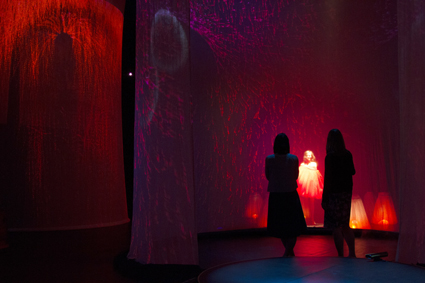
Rebecca Youdell with audience, Bonemap, Nerve Engine
photo Tai Inoue
Rebecca Youdell with audience, Bonemap, Nerve Engine
Queensland is a river of contradiction. In the lead-up to a federal election that brought Brisbane three tiers of simultaneous conservative government for the first time, the Brisbane Festival launched a new hub for independent theatre, the QUT Theatre Republic, programed by La Boite Artistic Director David Berthold. While there was some muttering about the gender diversity of the mainstage program, the Republic was diverse and full-blooded. Elsewhere in the festival, The Danger Ensemble tackled The Wizard of Oz, Genevieve Trace presented a new work, Aurelian, and Canadians Evan Webber & Frank Cox-O’Connell performed Ajax and The Little Iliad.
Bonemap
My festival journey started early with Cairns-based new media dance collective Bonemap. Nerve Engine and Terrestrial Nerve were sister-shows performed in the same rectangular studio space dominated by a long wall with arresting projections of pulsating and osmotic images. To the left were a deconstructed tree house, a DNA-shaped canopy and a nest of tutus; to the right a circle of fans set on the floor before a wall of mirrors.
For Nerve Engine, an iPhone was strapped to my wrist to trigger sound and visuals through the movement of my hand. The experience was more a demonstration of technology than an immersive performance, which was a surprise, as a Bonemap show is usually a sumptuous visual feast. Terrestrial Nerve was more familiar: an eco-poetic chamber piece riffing off evolution, moving from the cellular to full-blooded creatures, teasing the audience with the performers’ marsupial-staccato movements and decomposing costumes. My favourite image: a length of fragile white silk, a materialisation of the nerve imagery in the projections, was blown up by the floor fans into a choreography that echoed the two female performers’ mimetic animal bodies. However, the brevity of the 30-minute piece in contrast to the scale of the space was a tip that the work had not been finished, or fully resolved. Two of the installations in the space were barely used and the transitions felt arbitrary rather than fully interrogated.
Fleur Kilpatrick
Another piece with gorgeous screen work but with under-utilised performance was Adelaide Fringe favourite, Insomnia Cat Came to Stay by Fleur Kilpatrick, a one-woman show where the performer, Joanne Sutton, is trapped by her bedsheets and spends her hour with us in a stream-of-consciousness recounting of her sleeplessness. The effect was dreamlike and a little dissatisfying, akin to watching video-clips all night when you know you should go to sleep.
Genevieve Trace
A similar trance-like quality was evoked by local performance-maker Genevieve Trace’s new work, Aurelian (presented by Metro Arts and Brisbane Festival), a bass-thrumming solo show built around the mesmerisingly repetitive performer Erica Field, who is trying to come to terms with her grief. “I must work these things in order,” she says. We watch a screen that skates across a regional small town landscape, over burning cane-fields. We listen to her recount stories of grief that come from that place. We learn, eventually, that our female narrator is hiding from us and from her diminishing memories of her dead sister. Like Insomnia Cat, there is much to enjoy in the surrender to the compelling screen-led world, shaped by soundscape and a metaphoric and uncompromising design of entrapment. But there is also something fundamentally not yet discovered, additional layers and potentialities sitting beneath the surface.
Danger Ensemble
Ditto for The Danger Ensemble’s collaboration with playwright Maxine Mellor for La Boite and the Festival, The Wizard of Oz. This was the most anticipated local work and one that ought to have brought the house down with the talent of the cast, creatives and crew, but instead felt like a dry run for the real show, a sketch of something extraordinary. The compelling design seemed to lock the performers into their corners and wouldn’t let them go as they gallantly battled the cultural juggernaught of Oz and Judy Garland and Wicked with their own inimitable brand of pop culture impresario spectacle.
MKA
But the joy of the festival is always in getting a look at key interstate shows and this year we got both the Melbourne and Sydney indie darlings of new writing: MKA Theatre of New Writing and Arthur. MKA’s The Unspoken Word is ‘Joe’ by Zoey Dawson is a meta-theatrical satire of the ‘staged reading,’ a sort of inner-city hipster Pirandello tale, as our hapless but malevolent heroine, the playwright, tries to bully, blackmail, seduce and cajole her way through a disastrous reading of her new work, climaxing with her destruction of her own no-budget set and being cradled by the vacuous mid-career director she had dragooned into hosting her ill-fated masterwork. Sort of Lally Katz with a plot, the piece self-consciously linked itself to Tony Kushner’s Angels in America in a way I still don’t quite understand, but have very much enjoyed trying to work out.
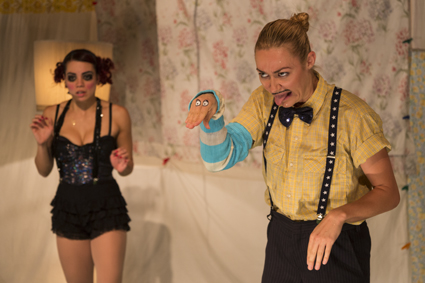
Catherine Davies, Julia Billington, Cut Snake, Arthur
photo John Feely
Catherine Davies, Julia Billington, Cut Snake, Arthur
Arthur
However, it was the show by Arthur (Amelia Evans, Dan Giovannoni, Paige Rattray), Cut Snake, that seduced me utterly. Cut Snake is a magic realist story of three childhood friends, one of whom dies, setting the other two on unexpected life trajectories. I have so often experienced the pull in Australian performance between body and word and between plot and experience. What I thought was splendid about Cut Snake was the way they had clearly engaged in a writing process but committed to a form that was driven by physicality. This was made possible by the calibre of the performers, who could move effortlessly between the dense and lively dialogue, narration and the physical tricks and spectacle. It was also a tribute to the direction by Paige Rattray. She used pace and a classic youth theatre compressed staging to keep the show’s relentlessly charming steam engine chugging to the sentimental but highly pleasurable climax. The audience completely bought into the Back to the Future time travel plot twist and happy ending that changed the fate of the two remaining friends.
New writing: directions
Much of the new writing I’ve seen, like that of MKA and Arthur, celebrates language and is making language-driven performance but eschewing naturalism for a plethora of dynamic forms and physicalties, gobbling up genre fiction and speculative writing tropes and blending them with classic theatrical mise en scène. Most importantly, there is a sense with the best of these shows that they aren’t half finished or half-baked, the theatrical worlds have been thoroughly investigated and the writing is taut, surprising and full of bite and adventure.
As I waded through Theatre Republic’s river of contradictions to the final show, the beautifully downbeat, personal, balanced and ever-so-Canadian interpolation of the classic Sophocles text Ajax and the proto-Homeric fragment known as the Little Iliad (7th century BCE), I was struck once again by the portents of the future and how much political theatre might get made in the coming years. “Arts for all Queenslanders,” said the State Government advertisement in the Brisbane Festival brochure—except maybe for our bikies who probably won’t even mind not being able to congregate in the public spaces of next year’s Theatre Republic.
Brisbane Festival: QUT Theatre Republic, QUT Creative Industries Precinct, 7-28 Sept; Aurelian, Metro Arts, 7-15 Sept, Ajax and Little Iliad, Metro Arts, Sept 24-28
RealTime issue #118 Dec-Jan 2013 pg. 35
© Kathryn Kelly; for permission to reproduce apply to realtime@realtimearts.net
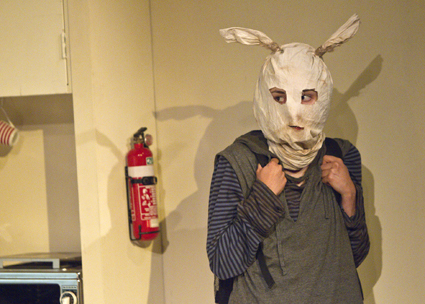
Jordan Cowan, The Dark Room
photo Shane Reid
Jordan Cowan, The Dark Room
In The Dark Room, a horror story within a horror story, Angela Betzien reaches deeply into the heart of regional Australia to produce a savage, gothic thesis on socioeconomic disadvantage engendered by decades of institutional neglect and misapprehension. The overt racism of Edmund Barton’s White Australia Policy having given way to the quietly virulent injustices of Aboriginal deaths in custody and the Intervention, Betzien positions both white and black Australians as victims of a broken but mostly unregarded system, children as its most grievous casualties.
The child at the centre of Betzien’s story, which is set entirely in a squalid Northern Territory motel room, is Grace (Jordan Cowan), a damaged and dangerous teenager. In a chilling symbol of her invisibility, she enters the room for the first time, accompanied by her guardian Anni (Tamara Lee), wearing a dark cloth bag on her head. Only her eyes are visible, peering shrunkenly and often glisteningly through badly cut holes. They are eyes that have seen something of which Grace cannot yet speak, and the details of which Betzien only gradually leaks through short, fraught scenes of increasing claustrophobia and nightmarish fragmentation.
The room, designed with striking attention to detail by Kathryn Sproul, becomes a physical and temporal crossover point between Grace’s story and those of previous and future occupants, all of whom are connected to a second individual tragedy, that of Indigenous boy Joseph (Taro Miller-Koncz). Joseph’s presence in the play is mostly incorporeal, appearing fleetingly and frighteningly in technically superb reveals within the motel room’s mirrors (lighting Mark Pennington). Initially difficult to read on account of the play’s shifts in time—a memory, a foreshadowing, a product of Grace’s discontinuous psychic space?—these unsettling apparitions build to a broader significance, a darkly playful rendering of the idea of a haunting, of the immediacy of the past and its still uncorrected wrongs. (From Betzien’s program notes: “Justice will only come when we as a society acknowledge what the dead have suffered…”)
Director David Mealor arguably makes too much of the script’s oblique horror movie appropriations (the sound design, too, by Quentin Grant, goes a bit too far down the same road with its clichéd forays into reversed playback) but the strength of Betzien’s message remains undiluted by this production’s occasional stylistic excesses. Cowan gives a memorable performance as Grace, genuinely disturbing in its intensity and impressive in its proximity to the truthfulness of the lives of our young who have been given too little, and who have seen too much.
By the end of The Dark Room, we too may feel we have borne witness to too much. There is, both within the play’s uncertain dénouement and the disorienting blackouts which periodically descend throughout the 90 minutes, a gut-wrenching sense of the unendingness of cycles of destitution and disempowerment that are the silent shame of this country. The great strength of Mealor’s direction is that Betzien’s motel room feels as inescapable to us as it surely must do to Grace. In reality, those of us fortunate enough to be able to can—and do—escape it every day, willingly protecting ourselves from the horrors within even as successive parliaments fail to protect those for whom the door remains firmly shut.
Flying Penguin Productions with State Theatre Company of South Australia & Holden Street Theatres, The Dark Room, writer Angela Betzien, director David Mealor, Holden Street Theatres, Adelaide, September 14-28
RealTime issue #118 Dec-Jan 2013 pg. 36
© Ben Brooker; for permission to reproduce apply to realtime@realtimearts.net
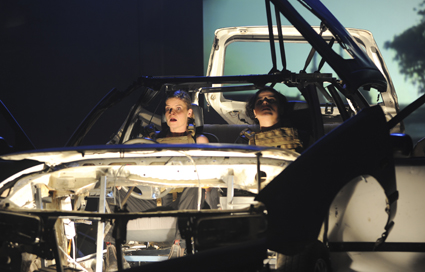
Jane Phegan, Olivia Stambouliah, The Vehicle Failed to Stop, Version 1.0
photo Heidrun Löhr
Jane Phegan, Olivia Stambouliah, The Vehicle Failed to Stop, Version 1.0
The legacy of the Iraq War lives on in endless killing generated by an invasion predicated on lies and characterised by mismanagement—including dissolving the police force and army—and the realisation of an opportunistic Western fantasy of the country as a free market totally open to its invaders. Version 1.0’s Deeply Offensive and Utterly Untrue (2007) devastatingly revealed the bribery and cover-ups rooted in the still unfolding Australian Wheat Board “Oil for Wheat Scandal.”
The company ‘revisits’ Iraq in The Vehicle Failed to Stop, focusing on an incident—the killing of a woman and her friend by outsourced security forces—that embodies what many people in the region must see as further Western terror. The corruption of Halliburton and the violence perpetrated by Blackwater’s mercenaries are well documented, but the Australian connection is less well known, and while not the focus of this production it’s certainly discomfiting to reflect on. Long-range rocket attacks and now drones (their operators literally working at home in the US thousands of miles away) distance Western governments and their populations not simply from the horrors of war but from feelings of responsibility for it, especially if it means fewer of our own troops are involved and harmed. This phenomenon is fast becoming war by other means.
Even more worrying is the revelation that employees in Blackwater and other contractors’ private armies are exempt from prosecution by Iraq’s legal system (much to that government’s consternation), as happened when taxi-driver Marou Awanis and Jeneva Jalal were shot by private security contractors working for the Australian-owned company Unity Resources Group for driving too close to a company vehicle in a secure section in Baghdad. An attempted prosecution in the US failed—outsourcing, it seems, makes the US Government not responsible for the actions of the companies it contracts.
Version 1.0 reveals not only the cruelty and mistruths inherent in contractors operating outside the law but also the suffering of some of their employees—fuel tank drivers forced to venture across unnecessarily dangerous terrain and dying with little or no compensation for their families. The production reveals the contractors’ militias as comprising “thrill-seeking cowboys” or men in a state of “kill or be killed” hyper-anxiety in which they are less than likely to adhere to the rules about how long they must wait before shooting—to the count of 10, with the word ‘thousand’ spoken between each number. This counting rule is chillingly delivered as part of aggressive corporate self-justification.
The Vehicle Failed to Stop opens with a single figure walking towards us from an adjoining workspace, light flaring behind him into the darkened theatre. A suited authority figure (Irving Gregory) of some kind, his repeated muttering is unintelligible until he draws quite near; we hear, “Kill or be killed,” a mantra for survival, or more likely, self-justification for killing in Iraq. The strangeness of his utterance is underlined by electric guitar harmonics and the sharp bell-tones of a struck tin; the musicians, in low, light, are lined along the wall. A car sits facing us on the dark open stage. A large video screen behind shows us the road from the driver’s point of view, in motion. In this very open space the vehicle appears vulnerable, whether occupied by contractors or the female victims—each pair played vigorously by Jane Phegan and Olivia Stambouliah, enacting the tensions felt and alertness needed on the road by both sides in tautly choreographed moves, sometimes seen enlarged on the screen above. When the ugly event we’ve been fearfully anticipating finally takes place, the car shockingly springs apart, doors dangling, boot and bonnet shaken loose. Later it will be re-assembled in seconds to capture a ghostly impression of death by gunfire with blood finger-painted on the bonnet.
These chilling images, counterpointed by low-key delivery of alarming facts and rationalisations (Gregory as various commanders and corporate heads) and vigorous physical enactments provided The Vehicle Failed to Stop with moments of power. But something was missing.
Some critical of the production declared it impersonal. We certainly learn little about the victims even though their family history has a legacy of tragedy not uncommon to the region. But I’ve never felt the ‘personal’ to be the hallmark of version 1.0 productions (even the atypical The Disappearances Project [2011]sees its theme through a kaleidoscope of unidentified personalities). Certainly the female figure at the centre of The Table of Knowledge (2011) warrants some compassion, and there are terribly sad tales told in Beautiful One Day (2012) by members of version 1.0’s collaborator, Ilbijerri Theatre. But the power of CMI, A Certain Maritime Incident (2004), The Wages of Spin (2005), Deeply Offensive and Utterly Untrue (2007) and much of The Table of Knowledge does not spring from the personal. Invariably their strength is drawn from selections from the public record and their ironic reframing: physically, vocally, spatially and technologically, without resorting to satire or mimicry. Version 1.0 has made us listen afresh to what we’ve already heard or seen in the media and re-contextualised it with revealing new information and, above all, a rich variety of inventive performative devices. These are drawn from and build on contemporary performance, performance art, video art and choral and other approaches to voicing, enacting and framing texts.
The Vehicle Failed to Stop displayed limited examples of this inventiveness. The production was neatly, at times tautly, constructed and busy, but an air of detachment emanated from a sameness of delivery, recurrent hyper-physicality (an extended passage with a soldier running repeatedly up and downstage failed to register) and some design superfluity (a row of human-shaped targets seemed merely functional rather than powerfully symbolic). The result was a fragmentary experience: the information made me want to care, but version 1.0’s peculiar capacity to alarm its audiences and at the same time implicate them was not felt. The Unity Resources Group is an Australian company. Version 1.0’s greatest strength has been to home in on Australian institutions and issues of the moment; CMI and Deeply Offensive and Utterly Untrue pointed the finger and targeted blame, as did Table of Knowledge.
The Vehicle Failed to Stop, for all the specificity of the 2003 incident which prompted it, did not feel as focused or as current as its predecessors. Certainly it informed us of the continued expansion of security outsourcing, its neo-liberal economic foundations (Milton Friedman is quoted in the opening), lack of legal redress for victims and ‘occupied’ states either within their borders or in the US and the consistently growing numbers of the dead. But it was as if these were all happening somewhere else, not really connected with Australia, resulting in an ensuing sense of sadness and helplessness, not the anger or bewilderment or outraged laughter triggered by others of the company’s works. That it was ably performed—supported by a strong live musical composition—is not in doubt, but The Vehicle Failed to Stop lacked version 1.0’s usual incisiveness and wit, and not least the ironic framing it has so deftly and effectively employed over many years. The diffuse, if much-praised, Beautiful One Day was similarly problematic.
With its courageous vision, version 1.0 has radically expanded Australian theatre, making us think with productions that directly and unashamedly tackle large, often national, issues with great concision and, amazingly, mostly without us feeling we’ve been hectored or short-changed with generalisations. I hope the company can sustain its vision and further advance its realisation; the light that version1.0 casts on contemporary politics is much needed in these darkening times.
version 1.0, The Vehicle Failed to Stop, devisors Sean Bacon, Irving Gregory, Jane Phegan, Paul Prestipino, Kym Vercoe and Olivia Stambouliah, video Sean Bacon, composer Paul Prestipino, dramaturg Deborah Pollard, lighting Frank Mainoo, Carriageworks, Sydney, 15-26 Oct
RealTime issue #118 Dec-Jan 2013 pg. 39
© Keith Gallasch; for permission to reproduce apply to realtime@realtimearts.net
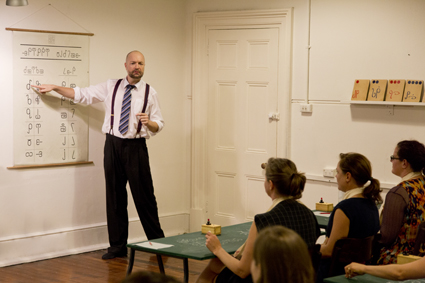
James Berlyn, Crash Course
photo Fionn Mulholland, Daxen Photography
James Berlyn, Crash Course
James Berlyn’s Crash Course is a participatory theatre show that takes the form of an immersive language class. Before entering the classroom, the participants are informed by a terse teacher’s assistant they have endured an unspecified trauma and have subsequently lost the faculty of language, and that a teacher, Jakebo, will help to piece it together again.
Simulating the experience of language loss in a performative context, Berlyn has developed Winfein, a fully functioning language which he speaks throughout. In essence, the show explores how people respond when faced with a seemingly impossible challenge.
Berlyn’s imposing and authoritative portrayal of Jakebo, along with the Victorian architecture of the performance space, transports the participants to another time, stirring up familiar sensations of powerlessness in the classroom, exaggerated by the archetypal schoolmaster character, who could be straight out of a Dickens or Bronte novel.
Before long Jakebo shows that he too is anxious and afraid of failure; afraid that he will not help his students adapt, to be able to communicate with him and each other. Changing tack, he softens and begins to converse through song, acting out scenarios to create context for Winfein words and physicalising the Winfein alphabet to form neurological bindings between brain and body. In this way, the class is exposed to a numerical system, an alphabet and six pieces of vocabulary: the Winfein words for ‘adapt,’ ‘help,’ ‘crash,’ ‘yes,’ ‘no’ and ‘good.’ ‘Tsoopun’—Winfein for ‘Help!’—rang through my mind for most of the work. That much I learnt.
I’m not sure if the initial premise of relearning language following a traumatic incident was necessary to the success of this work. The anxiety in the room, the fear of returning to a classroom and not understanding what is being taught, was palpable, bringing out participants’ innate reactions to either adopt the language and conquer their fears, or crash quickly when challenged with something they could not immediately grasp. I even found myself checking my friend’s worksheets to assure myself I had got at least one thing right and, let’s be honest, to cheat when I didn’t know the answer. On the other hand, my friend diligently applied herself to the worksheets long after the class had moved on to another task, determined to assimilate some meaning from a disorienting experience.
Director Nikki Heywood crafts a taut structure so that Jakebo pulls back just at the right time when the participants need some breathing space. Her acute sense of space and movement allows Berlyn’s physical work to shine; fluid, sweeping yet contained, he creates a surprising contrast with the initially uptight, no-nonsense presence of Jakebo at the beginning.
James Berlyn has an excellent capacity for creating work which can be packed into a suitcase and pulled out anywhere. His creation of the Winfein language and our subsequent immersion in it takes this idea to a new level. The potential to perform this piece anywhere, no matter what the first language of the participants, suggests enormous potential for the work across the international festival market.
James Berlyn, PICA, Performing Lines WA: Crash Course, creator, performer James Berlyn, director Nikki Heywood, lighting Jenny Vila, sound design Geoff Baker, graphic design Shaun Salmon, costume Anne Marie Terese, teacher’s assistant Sarah Nelson, PICA, Perth, 14-30 Nov 2013
RealTime issue #118 Dec-Jan 2013 pg. 40
© Astrid Francis; for permission to reproduce apply to realtime@realtimearts.net
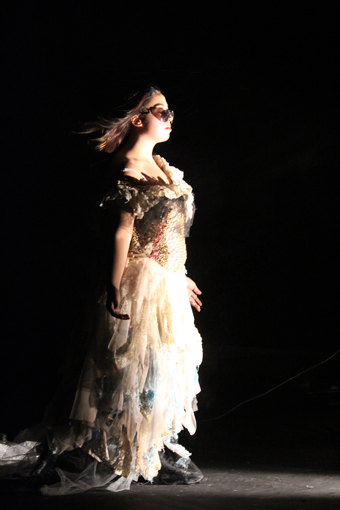
Felicity Tchorlian, Ragnarök /or how it ended/, Shopfront
photo Howard Matthew
Felicity Tchorlian, Ragnarök /or how it ended/, Shopfront
It’s a busy time for performance and live art, but the curatorial prospect of Civic Life is straightforward: give over the sprawling, boxy property that contains Shopfront Theatre to artists who’ve been hanging out, making work and maybe just thinking in the space for the last six months. It’s a residency program that seems to balance open-ended time and space to work with a specific exhibition outcome, and the results are as uneven and energetic as you’d expect from a bunch of mentored artists and writers under 25, riddling their way through the early stages of their creative careers.
This instalment of Civic Life, A Walk in the Dark, encompassed works-in-progress that were not complete packages but first steps towards something else. The most interesting part of Sarah Aghazarmian’s The Dark Net was not its subject matter—the internet’s illicit shadow economy—nor its form (one assumes it will be a traditionally-staged theatrical work), but the fact that audiences got the opportunity to see a read-through of an unfinished script. Perhaps the best way to discuss process is not to make works about it but to take an open and un-precious approach and let audiences look in on different stages of a work’s development.
From this traditional theatrical beginning, the rest of Shopfront’s residency program crossed from visual arts to performance fluidly and without regard for barriers. Into Orbit, by duo N&V (Nicola Frew & Verity Mackey), read more like an art gallery show, comprising six (not 13) rooms containing live bodily sculptures, video and installation invoking and obsessing over sensorial experience—like the massive sub-woofers that produced sound at low vibrations to be felt rather than heard. Chris Dunstan’s Erase related to what could be the other art world theme of the day, the subjective and malleable nature of memory, with the emphasis on performance, repetition and duration. Three performers, including the artist, practised the act of memorising, which is also the act of forgetting—as evidenced by a pianist’s inevitably failed effort to learn by heart a new piece of music in just 25 minutes. As with Into Orbit, these were rigorous, exploratory exercises that are pleasing to engage with cerebrally but perhaps less so experientially.
It was the pieces with a more orthodox audience-performer relationship that offered the most to delve into. Diverging from theory-informed interventions, Carly Young’s reworking of the classic French tale The Little Prince presented an honest story that maximised the different spaces inside Shopfront. Starting in the theatre, the catwalk and lighting rig were simply transformed into our narrator the Pilot’s aircraft, slowly whooshing just above us and just below the ceiling. The Pilot then told us, “Follow the Little Prince,” and we did—through the theatre, onto the street and all around. The production was in turns sweet, funny, childlike and everything you want from a well-loved text with such a fierce, humane intelligence. Yes, it was a spare and small-scale production, and traipsing around a rabbit warren might seem strange to some, but I felt we were being taken care of—we were with the Little Prince on his journey. Young showed that traditional stage plays can use space innovatively—taking us outside the black box.
Emma McManus usually makes work with the self-described “small but likeable” theatre group Applespiel. Her Ragnarök /or how it ended/, is an exciting stab at highly visual performance that places less emphasis on story and dialogue and more on a meaningful collection of striking images and moods. This kind of non-narrative communication is tough, and the piece is not fully complete, but mostly, Ragnarök hung together. The title refers to a godly doomsday story in Norse mythology; in McManus’s piece it inspires contemporary reflection on unspecified collective panic about life, the universe and everything. We seemed to be witnessing a real-time video clip about our age’s apocalyptic leanings. A lone, wailing electric guitar, looming shadows, lashings of gold glitter, tealight candles and white flour poured and projected through the air via a fan all contributed to a luxe yet sparse aesthetic that really did summon an end-of-days feeling. Without overdosing on dark-night-of-the-soul melodrama, Ragnarök could be something you feel before a heart attack, and I eagerly await the finished piece. It had the spirit of lo-fi celebration that exemplifies the best of Civic Life, of rough-and-ready artist-led experimentation.
Shopfront Theatre, Civic Life—A Walk in the Dark, Carlton, Sydney, 6-10 Nov
RealTime issue #118 Dec-Jan 2013 pg. 40
© Lauren Carroll Harris; for permission to reproduce apply to realtime@realtimearts.net
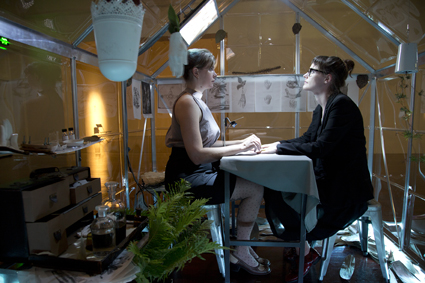
Cat Jones, The Plantarum: Empathic Limb Clinic, Proximity Festival
photo Fionn Mulholland
Cat Jones, The Plantarum: Empathic Limb Clinic, Proximity Festival
Partaking in Perth’s Proximity Festival makes one feel a little like Alice in Wonderland, inducing an expansive tumbling sensation of descending into a deeper, hidden consciousness. Held throughout the late Victorian home of the Perth Institute of Contemporary Arts (PICA), the festival sees one artist and one audience member come together in spaces for intimate, personalised 15-minute performances.
Each audience member encounters a series of these micro-works throughout the evening. They can select a program of four works lasting 80 minutes, or a marathon of all 12 performances lasting four hours. I attended two programs over two nights. Here is a selection of what I found when I slipped down the rabbit hole.
The Plantarum: Empathic Limb Clinic
A mobile field laboratory set up in PICA’s main gallery space, The Plantarum explores the synaptic relationship between humans and flora through a blend of neuroscience, mirror therapy and the horticultural technique of grafting.
Drawing upon the niceties of Victorian etiquette, artist Cat Jones invites you, the subject, inside her laboratory, a stimulating environment where Victorian botanics, modern science and technology are enmeshed. Jones then undertakes to generate an empathic connection between human and vegetation, lodging a neural graft via mirror therapy to ‘attach’ a botanical growth to the subject’s hand. No Frankensteinian horrors occur, just a gentle brushing of a soft leaf upon the hands. At the same time the subject watches a screen which shows the hands as they receive this treatment, interspersed with images of the leaf seemingly grafted to and growing from the subject’s fingers.
It is recommended that the subject contemplate the scion daily, absorbing it into the consciousness to lead to a greater connection with botanical species. While I am yet to tune into any messages conveyed by my garden’s subsystem, this piece was a complex, immersive and inventive experience in which to contemplate the possibility of forming a deeper bond with the greater vegetative kingdom.
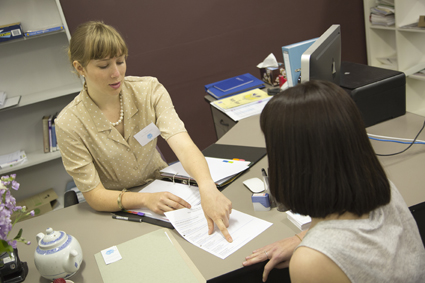
Loren Kronemeyer , Remains Management Services, Proximity Festival
photo Fionn Mulholland
Loren Kronemeyer , Remains Management Services, Proximity Festival
Remains Management Services
Loren Kronemeyer wants to ensure you make an educated decision when it comes to choosing how you want your physical remains handled after death. She provides you, her client, with multiple options for managing your remains, ranging from traditional means such as burial or cremation, to environmentally friendly choices including biodegradable casks and crematorium carbon offsets, as well as more elaborate plans such as being sent into outer space.
Kronemeyer offers to document your “remains plan” to serve as a true testament of your wishes that may hold some legal weight if any contention arises. This element adds tension and a twist to the work, where the participant is faced with the potential of generating a binding document within a performance environment. While the idea of my remains being turned into a diamond or having a burial cairn built in my backyard sounded enticing during the performance, pledging to such a commitment or even a more traditional option was something I couldn’t commit to in the moment, which certainly raises the stakes in terms of the participant’s investment in the performance.
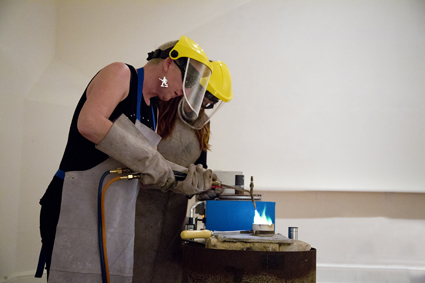
Sarah Elson, Incendia Lascivio, Proximity Festival
photo Fionn Mulholland
Sarah Elson, Incendia Lascivio, Proximity Festival
Incendia Lascivio
Sarah Elson invites you to deconstruct her large art piece comprising manifold miniature metal castings: invites you to melt it, in fact, and then re-cast the metal to create a new work. Elson nimbly guides you through the concerted effort of managing fire and crucible to produce a small sculpture of West Australian flora. I was captivated by this process. A flower is set in plaster and fired by a kiln, which completely disintegrates the bloom but leaves an intricate fossilised imprint of the flower in the plaster. By melting the sculpture taken from the artist’s initial work and then re-casting it in this plaster mold, a new and distinctive bloom of coppered elemental splendour springs forth, which Elson humbly presents to you as the custodian of this particular piece of her reworked art project.
Gallery of Impermanent Things
Stillness is often difficult to achieve, particularly during a festival where you may have just come from a performance where you were a sniper who had to hunt or be hunted or blindfolded in a room with a Minotaur. Stillness and calm is, however, achieved in Daniel Nevin’s portraiture exhibition which leaves only a temporary trace of his subject and work.
Combining elements of traditional photography and digital imaging, Nevin requires his subject to reach a point of perfect stillness while a long exposure in a darkened room captures his/her image. Simultaneously, the exposure is projected onto a surface covered with phosphorescent paint, whereby the projected light activates the paint to capture a portrait reminiscent of 19th century Daguerreotypes: ghostly, self-consciously reposed and lacking in the benign and beaming poses that we enact for the camera today. The phosphorescent image eventually fades, returning the gallery to darkness once more. The work is fleeting like performance, like memory. Nevin explores our obsession with trying to capture and preserve ourselves, asking us to delight in the unique exchange of a small moment and reminding us that nothing—particularly the image of the self—is permanent.
Proximity Festival, curators James Berlyn, Sarah Rowbottam, producer Sarah Rowbottam, program A artists Elise Reitze, Cat Jones, Humphrey Bower, Loren Kronemeyer; program C artists: Sarah Elson, Moya Thomas, Janet Carter, PICA, Perth, 23 Oct-2 Nov
RealTime issue #118 Dec-Jan 2013 pg. 41
© Astrid Francis; for permission to reproduce apply to realtime@realtimearts.net
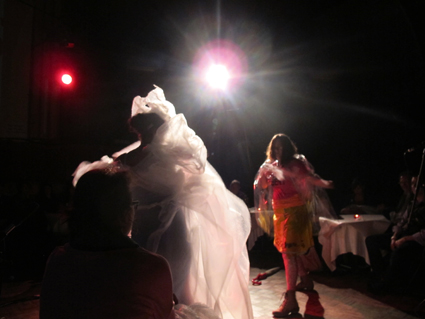
Klare Lanson & Kathrin Ward, #wanderingcloud – Campbells Creek
photo Kathryn Baulch
Klare Lanson & Kathrin Ward, #wanderingcloud – Campbells Creek
You walk into the Theatre Royal, Castlemaine’s versatile theatre-gig-cinema-performance-space, into a partitioned-off candle-lit bar where projections of pastures, eucalypts and dissolving clouds loop onto large hanging canvas, mingling with the sound of feedback and frogs. You sense the performers on the other side of the curtain, silhouetted as the music begins.
It’s a performance in layered sections, of trickle-down effects: Klare Lanson, remembering the flooding of her house at the bottom of a huge hill, stands on tables as the water swirls around. She speaks to locals about the rush, swimming from one storey to another, as they share their “recipe for the natural disaster”—the dangerous clouds, the tale of a pig who doesn’t get along with sheep (but is forced to shelter with them), the raining down of “millions of trembling spiders”—and their voices stream from the laptop Lanson guards and commands like a digital composer, wearing a clear raincoat and a t-shirt saying “heaven sent,” or “the flood line here” marked near the bottom of her skirt. She scatters her churning text and sound to the winds while she geo-tags the collective memories of communities in trauma.
Musician and writer Neil Boyack takes off, guitar-strapped and thumping in a Western shirt, while the Octaphonic Frogs are decked out in military gear and hats. Soprano Andree Cozens barks and croons, drawing calm in a muddy landscape visually mixed by Jacques Soddell. Kathrin Ward, heavily pregnant with twins, is draped in a bubble-wrap wedding gown and as she walks she clicks the seductive plastic, unravelling herself, inviting you to join in, until the wall of crackle sounds like a bonfire, warming your wet skin.
On the floor, like detritus left on the riverbank, instruments are scattered about, tripped over. The Clocked Out duo take the audience on a percussive ride, improvising with objects they’ve found strewn around local properties: a falling-apart piano (played with elbows by Erik Griswold); a long chain that rattles like thunder; cables mashed and whispering along the wooden floor like river gum roots. Along the way Lanson laughs, dances with you in the summer rain, soundscaping and reverbing— “my fingers are triggered by the hidden voice in your stories”—her voice wavering from lullaby to panic, and others join hers as tributaries then channels then canals, as the real storm hits.
Newstead. Campbell’s Creek. Guildford. Carisbrook. A swinging bag is pushed like a pendulum. In the soft spotlight, Vanessa Tomlinson turns it, emptying grain in a rush onto the floor, the various timbres and tones playing out like rain on a tin roof, stopping and starting, subtle and delicate, the transfixing sound of childhood, all too rare in a Castlemaine drought.
But that’s what the weather’s like here. It swings from one extreme to another. Flood to drought. And back. Drought to flood. And back. Then every summer your phone beeps with fires nearby. The threat of flames. The one track out. The smell of smoke that sends your senses racing. But the phone beeps so often. That soon you no longer hear it.
#wanderingcloud, Klare Lanson, a collaborative performance featuring Klare Lanson, Clocked Out Duo, Andree Cozens, Jacques Soddell, Theatre Royal, Castlemaine, 5 Sept
RealTime issue #118 Dec-Jan 2013 pg. 41
© Kirsten Krauth; for permission to reproduce apply to realtime@realtimearts.net
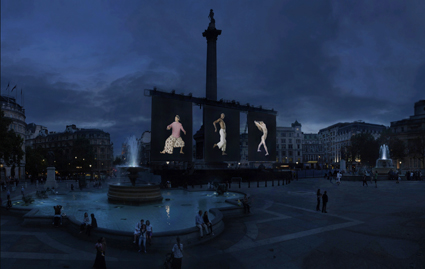
Slow Dancing, David Michalek, Trafalgar Square, London, 2010, courtesy the artist
WOMADelaide has long celebrated dance in its programs with, for example, performances by the Australian Dance Theatre and Leigh Warren & Dancers. For the 2014 festival, there’s something different: a trio of three-storey-high screens on which dancers, many internationally famous, appear against the night sky dancing in extreme slow motion. This is the work, seen in the US, UK and Europe (including the Venice Biennale), of American artist David Michalek.
Slow motion filming has long revealed the complexities of human, animal and plant movement (conversely, ‘speeded up’ film can tell us much about cloud and crowd motion and the patternings created by choreography). Michalek’s special high-definition camera runs at 1,000 frames a second, turning each dancer’s “five-second gesture [into] 10 minutes of screen time” (press release). Michalek thus takes slow motion to the extreme, such that audiences, at first thinking they’re seeing still images, are gradually entranced by the supple dynamics and forces at work in dancers’ bodies.
Michalek’s 43 subjects range from young to mature, embracing a variety of dance and movement forms: “from Japanese court dance to Afro-Brazilian capoeira, from flamenco to hip-hop, from classical ballet to hoop dancing.” Accomplished lesser known artists dance alongside the likes of dancer-choreographers William Forsythe, Marie Chouinard, Bill T Jones, Karole Armitage and Angelin Prelocaj. Bill T Jones wrote of the experience: “I was trying to do something with undulations and directional changes that would give some insight into the way I move—the upper body doing one thing, the legs doing another. But four seconds is not very much time to do anything. That was a revelation. We are so naked when we move. It was kind of a gruesome thing to subject a performer’s ego to, but ultimately I think that’s what’s very beautiful about it. It was one of the hardest things I’ve ever done. If one element fell through, everything was erased. It was a bit of a Zen test”
(www.slowdancingfilms.com).
Michalek professes not only a love of dance and the impulse to make portraits, producing a fascinating hybrid that embraces both stillness and movement at once, but also a spiritual inclination. He writes:
“Susan Sontag once pointed out that ‘no art lends itself so aptly as dance does to metaphors borrowed from the spiritual life (grace, elevation)…’ But I also believe that certain harder and rougher metaphors borrowed from the life here below (gravity, striving, failing, falling) are equally important to what dance is and who dancers are. To paraphrase Simone Weil, grace is also the law of the descending movement—some people fall to the heights” (www.slowdancingfilms.com).
Amid WOMADedaide’s wealth of vibrant music performances, Slow Dancing will offer time and space for contemplation of, and even meditation on, the magical intricacies and fluency of movement of which the human animal is capable. RT
WOMADelaide 2014, Slow Dancing, artist David Michalek, Botanic Park, Adelaide, 7-10 March
RealTime issue #118 Dec-Jan 2013 pg. 42
© RealTime ; for permission to reproduce apply to realtime@realtimearts.net
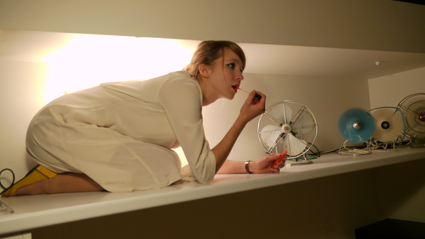
Anneli Bjorasen, Turbulence
photo David Young
Anneli Bjorasen, Turbulence
Despite being the closest any of us will come to experiencing a miracle, air travel is marked by boredom and sustained physical discomfort. With its staging of the explosive relationship between a mother and daughter in an apartment only wide enough for five seats and an airline trolley, Chamber Made Opera’s latest Living Room Opera, Turbulence, explores this banal sort of magic that frames and controls our lives.
Composed by Juliana Hodkinson and featuring the versatile voices of Deborah Kayser and Anneli Bjorasen (in her first Chamber Made Opera role), Turbulence is a ‘first’; several times over for the company in its 25th year.
A row of fans along one wall generates a drafty hum that is amplified into an ambient drone by Jethro Woodward’s ever-understated sound design. The audience take their seats, the front row facing a white wall. I wondered where the performance would take place until Bjorasen began to hum, “pshh” and “khh” like the pneumatics of an aircraft beside me. This opening is the first durational piece I have experienced in a Living Room Opera, providing a welcome contrast to the enchanting kaleidoscopism of previous works. It is also the best environment in which to hear Woodward’s minute control of transparent textures, even in a sound world as saturated as a series of amplified fans. Kayser and Bjorasen’s stereophonic sound effects are a delight, making the central seats the best in the house.
Other sounds endemic to airplanes begin to fill the cabin—a baby crying (live and recorded), 1950s cabin announcements and Bjorasen struggling with a packet of nuts. Bjorasen leans as the plane banks to the right, leaving me in an awkward position for several minutes.
Against this background of whirrs, cries and muffled announcements, the opera continues as a duet between mother (Kayser) and daughter (Bjorasen). The couple share text drawn from academic literature on turbulence, the mother singing graciously against a Pocket Piano synthesiser and the daughter growling impetuously into a vintage microphone. The texts provide an underlying theme of chaos and order, along with the observation that “normal times are when disorder wins.” But the opera is set in the 1950s, shortly after the dawn of commercial passenger aviation. Air travel is now more accessible than ever before and the world is on average half a degree warmer. We are now faced with the task of explaining the workings of the reading lights and seat levers inside the cabin rather than the turbulent air outside: Why in fact do things work the way they do and why is it so difficult to change our orderly progression towards ecological disaster? Faced with the desertion of our future, are we condemned to sing a solo aria, as Kayser does when her daughter walks out on her, reminiscing about a “sea as blue as a baby’s eye?” With the sensitivity and warmth of her voice, which it is worth the ticket price just to hear up close, you could imagine Kayser was lamenting the loss of oceans.
As well as introducing a new performer and a new style of opera to Chamber Made fans, the work is the first Living Room Opera under the new Creative Director Tim Stitz, who made everybody feel welcome before and after the show with a pre-flight talk and post-flight refreshment. Most importantly, Turbulence is the first Living Room Opera to fulfill the company’s claim that the series need not only take place in opulent living rooms of the Eastern suburbs. The space is perfectly suited to the opera, and the opera to the space, revealing the incredible power of chamber opera to unite disparate environments through artistic aims.
Melbourne Fringe, Chamber Made Opera with New Music Network, Turbulence, composer Juliana Hodkinson, libretto Cynthia Troup, sound design Jethro Woodward, performers Deborah Kayser, Anneli Biorasen, a living room, Northcote, Melbourne, 2-3 Nov
RealTime issue #118 Dec-Jan 2013 pg. 42
© Matthew Lorenzon; for permission to reproduce apply to realtime@realtimearts.net
The three members of Melbourne’s Speak Percussion enter purposefully and seat themselves centre-front stage at a small card table. The table and its immediate surrounds are aquiver with a bowerbird blend of items and the promise of a sonic spectacle about to occur. It’s ex-pat composer Thomas Meadowcroft’s 20-minute work, The Great Knot.
Within minutes I am tied up in the performers’ gestural rendering of each musical detail, aliveness brimming in their assured poise and the playful intelligence of the piece. There’s a lot going on here: a business meeting (formal attire and a musical agenda-setting laptop and soft synth); a High Tea (wine glasses, tea cups and pots, sugar cubes and salt shakers); an experimental primary school music lesson (shakers, one-handed descant and treble recorder playing, ping pong bats and balls); and Saturday night Lotto (marbles rolling in bowls and a plastic CD tower). The spatial sonic symmetry of a card game plays out too (‘I’ll hear your sound and raise you one’). Brilliant.
Rowan Drape’s See, Hearer, Clearer is next, scored for electromagnetic piano and bowed vibes. A high quality AV recording of the electromagnetic piano part, taken from the piece’s Melbourne premiere, is shown on a huge screen. The piece breathes. It functions harmonically and aesthetically as an homage to Morton Feldman.
Final piece before interval is ex-pat composer Matthew Shlomowitz’s Popular Contexts Volume 6. This is the Australian premiere of the 22-minute work, its international premiere having been in Berlin. Leah Scholes on samples is centre stage. Speak Percussion’s Artistic Director Eugene Ughetti on drum kit, stage right. Matthias Schack-Arnott, vibes, stage left.
Each movement (I Saxophone Sequence/ II Bass Lines/ III Air Drums/ IV Chromatic Chords) is constructed of a genre-crossing collection of samples, which are more or less indicated by the movement’s titles (movement 2 can be seen on YouTube). The samples are played live and startlingly thrown one against the other, ingeniously developed and supported, punctuated or framed by kit, vibes and spatial use of the PA system. Postmodernism is provoked out of academia into fully fleshed, mature wit. I love this piece and burst into laughter often.
After interval are two pieces selected from Topology’s Top Up program Composition Call Out to Brisbane high schools. The evocative Call of the Kimberley by Year 12 St Peter’s Lutheran College student Andrew Haselgrove features the composer on piccolo. ASME award-winning Underground Alert is a fast paced electronic dub step by Year 10 Cavendish Road State High School student Anthony Chitez.
Topology composer and double bassist Robert Davidson’s 10-minute Brightest Threads (from Oscar Wilde’s Apologia) ensues. It’s an extremely well crafted and performed quartet for sax and strings (violin, viola, double bass), originally written for sax and delay. I soak in the satisfying rhythmic finesse and textures of a baroque style canon, coupled with Topology’s signature major/minor modal play.
With (the completely ironical working title of) Passacaglia and Fugue for Bassoon and Icecream, violist and composer Bernard Hoey establishes himself as the George Harrison of Topology, bringing mystery and novelty to the group’s capacity. Hoey has woven 51 quotes from 1970s popular music into this piece. Two or three are obvious from my first hearing. Topology musicians of incisive prowess, Christa Powell (violin) and Therese Milanovic (piano) say they are still discovering new ones. It’s the work of a playful and lively orchestral-scaled musical intelligence. Hoey’s Five Minutes from Machine is his other contribution to the night. It’s a roller coaster ride, with choppy, chunky unisons and tutti tremolo crescendos which drop suddenly away to pianissimo strings.
Topology saxophonist and composer John Babbage’s Tourbillon is the first piece scored for both Topology and Speak Percussion. Within its jazz-celtic-minimalist soundworld, Babbage utilises the eight piece lineup well while continuing his fascination with mechanical inventions. A tourbillon is Breuget’s 1795 gyroscopic addition to the mechanics of a watch’s escapement [which controls the movement of a clock wheel. Eds]. Davidson’s Landscape, originally written for guitar and string quartet, is likewise well served by the combined musical forces. It’s a grand structural narrative evidencing Davidson’s mastery of craft and style, and a crowd pleaser.
The finale is Davidson’s Cuban Missile Crisis, originally scored for Topology and Brisbane-based percussion ensemble Isorhythmos. It’s catchy and Latin in feel, the musical material derived from cutting up the ‘secret’ telephone conversation between John F. Kennedy and former President Eisenhower, at the height of the Cuban Missile Crisis in October 1962. (The conversation was released in 1996; YouTube, JFK secret phone call.) It’s an ironically powerful and celebratory audio-visual masterpiece, deft and incredibly musical, in the lineage of Harry Partch and Steve Reich.
Common Ground is to be broadcast on ABCFM.
Topology with Speak Percussion, Brisbane Powerhouse, 9 Nov
RealTime issue #118 Dec-Jan 2013 pg. 43
© Lynette Lancini; for permission to reproduce apply to realtime@realtimearts.net
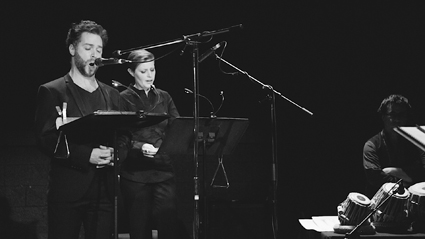
Bodhasāra, Chronology Arts & New Music Network
The absorption of Hindu thought into Western music making is not necessarily about adopting Indian musical forms. Holst’s one-act chamber opera Savitri (1916) is not imitative, nor is it textured with the kind of ‘oriental’ flourishes heard in Delibe’s Lakme (1883); both draw on Hindu mythology. In Chronology Arts’ Bodhasāra, a concert featuring five new works engaging dynamically with Hindu thought, each Australian composer displays a distinctive voice.
The composers respond to a late 18th century poetic text, Bodhasāra, which was inspired by ancient Hindu classics. Written by Narahari, about whom very little is known, the text “leads its readers through their souls,” seeking “jāvanmukti, not liberation from the world, but liberation while living.” While not narratives, the poems, translated from Sanskrit by Jennifer and Graham Cover, are inherently dramatic, adopting a variety of voices and moods. Moreover, the translators write, “…Bodhasāra is rather like music where multiple parts interact in harmony, syncopation, counterpoint and discord to produce an existential statement. The outcome is a higher order meaning which eludes simplistic statement” (website).
If Indian music was not an obvious point of reference for the composers, the program was engagingly framed with readings from Bodhasāra and the virtuosic tabla playing of Dheeraj Shrestha who opened and closed the concert, performing seamlessly between compositions and reminding us of the musical and concomitant philosophical roots of Indian music.
Five Adorations (on the end of time) by Chris Williams focuses on praising Siva and transcending time—hence the notion of time’s ‘ending,’ in the sense of having done with and no longer being afraid of it. The work is quite theatrical, alternating between meditative passages and operatically anxious or ecstatic moments for soprano and baritone. It opens with multiple triangles and is later textured with clapping and whistling; soprano and cello merge; the vibraphone is lyrical; the singing angular. The “Om” ending floats over the tinkling of triangles and a slightly unsettling soft cello discordance that suggests complexity rather than simple resolution.
Alex Pozniak’s Investigation of Silence for baritone, cello and percussion is “about moving toward silence,” more specifically, “the possibility of silence stemming out of music” (artist statement), removing us from distracting passions. The cello speaks forcefully, glides up and down against a rumbling drum, a prelude to the baritone’s focus on extending the sibilance in ‘silence’ and ‘speech,’ gliding up on ‘superior’ and descending sublimely on the last syllable as if emptying it of sound. Subsequently the cello is again heavily vibrant, the glides more emphatic and now bent in a chugging pulse which then dips into silence. Soft, extra-musical sounds emanate from the cello until a heavy beat from percussion and cello pushes the singer into falsetto until, finally, the cello now liquid and giving, he enters a staggered descent into silence through the word itself.
Annie Hui-Hsin Hsieh’s Deception of Desire addresses the ambiguity of desire: “Can a certain contentment be obtained when…yearning is eventually satisfied.” The Bodhasāra text is pretty grim (desiring, “cunning” humans become demons and “eat the flesh of corpses”). Aptly, the piece opens with the cello high pitched, the soprano near hyperventilating and only partly vocalising and then attacking on “cunning.” Cello and voice fall in and out of synch, the soprano gliding up again and again, perhaps suggestive of desire pitted against the constraints of the text (humans seen as street dogs). A period of reprieve with long, slow vocal glides and open breathing morphs into a boyish mezzo before rising to orgasmic conclusion and an expiring breath.
Using field recordings made in India, Leah Barclay’s electroacoustic Seventy-nine Waves of Ganga Knowledge is focused on the River Ganges—the goddess who embodies spiritual knowledge. The music of running water, one transcendent voice and then many more and deep, rippling tabla playing (Dheeraj Shrestha live and Subhash Kumar recorded) soon conjure an immersive, swirling cosmos in which the one and the many co-exist before returning to water and, again, silence.
Deception of the Body, by Hayden Woolf, addresses the ways our consciousness misinterprets reality, seeing “old age, pain and heartbreak as negative…they just are.” This work shares with Williams’ Five Adorations the dramatic intensity of a music theatre work. It opens with percussionist, singers and cellist slapping parts of their bodies, forceful singing of the text and variety in pace and mood—“The womb is a prison-house/Infancy is totally confusing” is delivered with a sung glide (again—a night of glissandi; sitar thoughts?) and the verse that ends with “youth is a forest of adversity” is speedily acquitted. There’s an engaging cello passage joined by drumming, an enticing weave of voices and a martial conclusion as if to suggest that, yes, life just is.
The concert concluded with two pieces played by Dheeraj Shrestha in which we simply revelled in the moment, unhindered by the thoughts or words of the musical dramas of desire we had experienced. While rarely meditative, those works might well nourish subsequent reflection, not least on this marriage of sorts between Hinduism and contemporary Western classical music.
Chronology Arts has once again, this time in partnership with New Music Network, presented a musically adventurous program of newly commissioned Australian compositions, effectively realised by conductor Andrew Batt-Rawden and an ensemble of committed performers. The simple weave of spoken text, tabla interpolations and thoughtful new works in a wisely interval-less program yielded a richly contemplative experience.
Chronology Arts & New Music Network, Bodhasāra, conductor Andrew Batt-Rawden, soprano Ellen Winhall, baritone Simon Lobelson, tabla Dheeraj Shrestha, percussion Sophia Ang, cello Ezmi Pepper; Seymour Centre, Sydney, 1, 2 Nov
RealTime issue #118 Dec-Jan 2013 pg. 44
© Keith Gallasch; for permission to reproduce apply to realtime@realtimearts.net
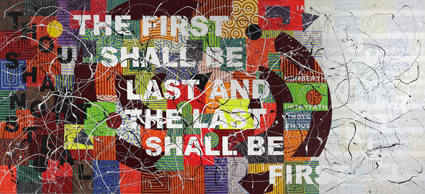
Richard Bell (Australia, 1953), One Day You’ll All Be Gone (Bell’s Theorem), 2011
courtesy of the artist and Milani Gallery, Brisbane
Richard Bell (Australia, 1953), One Day You’ll All Be Gone (Bell’s Theorem), 2011
Bulgarian artist Samuil Stoyanov’s video 10 min Geozavod (2012) shows the artist whirling a light-bulb on the end of a cable around his head in the unlit rooms of an art museum. This work epitomises the 5th Moscow Biennale of Contemporary Art, which is entitled More Light (Bolshe Sveta). The swinging light-bulb becomes a metaphor for consciousness—we’re aware momentarily of visible aspects of the world from which we construct a world view.
The Moscow Biennale’s main exhibition, of the works of 72 Russian and international artists, was strategically located in the Manege, the Central Exhibition Hall opposite the Kremlin. In the catalogue, Biennale curator Catherine de Zegher discusses her approach to the Biennale and analyses the artists’ work, saying, “If I explain the concept of the exhibition through the description of the artists’ works, it is because they have wholly informed the conceptualisation process…The curator goes with the flow of energy that drives the whole project—the flow of impressions, ideas and interconnections. To do otherwise is to impose a determining framework predicated not on conversation, but on prejudice and an ordering model.”
De Zegher’s choice of artists is pivotal. Clear themes emerge, particularly political and social commentary, the environment, domesticity, the apprehension of space and time, and drawing as form and process. There’s the telling photography of Umida Akhmedova (Uzbekistan), who was convicted in 2010 of slandering the Uzbek nation in her documentaries on Uzbek life. Rena Effendi’s photography documents life in Azerbaijan and Chechen artist Aslan Gaisumov’s battered, bullet-riddled metal gates evidence conflict. Australia’s Richard Bell pitched a tent, labelled it Aboriginal Embassy and called it Imagining Victory, referencing Canberra’s Aboriginal Tent Embassy and foregrounding the universal issue of post-colonial politics. Irish artist Tom Molloy’s installation Protest (2012) comprises hundreds of tiny paper cut-outs of historical photos of protesters, sourced from the internet, showing that protest is eternal and demonstrating the internet’s capacity for information dissemination. Gao Rong, whose embroidered replica of the interior of her grandparents’ house was so impressive at last year’s Sydney Biennale, showed Guangzhou Station (2012; RT12, p10), embroidery-covered household goods packed into fake designer-label handbags, commenting on the fashion market and the superficiality of style and wealth.
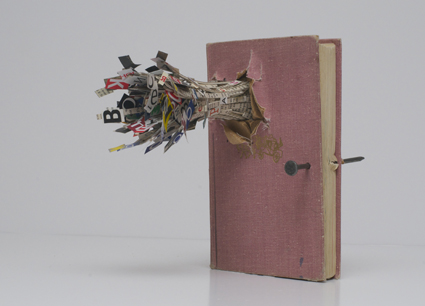
Aslan Gaisumov (Russia, 1991) (exploding book), In Memory of A. P., 2010, From the series ‘Untitled (War)’
courtesy of the artist
Aslan Gaisumov (Russia, 1991) (exploding book), In Memory of A. P., 2010, From the series ‘Untitled (War)’
Soviet suppression encouraged indirect or metaphorical artistic expression, a tradition that continues, and art in Russia is often politically flavoured. Russian group The Collective of Artists showed En Plain Air (2012), paintings of the Kremlin in white on a white ground, ironically acknowledging the father of Russian contemporary art Kasimir Malevich’s White on White (1918) and decrying censorship. Controversial Russian architect Alexander Brodsky’s sinister-looking installation, Unnamed (2013), suggests an entrance to a bunker—made of re-used timber, it’s like an old hut; there’s a neon M (for metro?) above the barred door, an eerie blue light emanates from within and it’s surrounded by an ocean of crumpled foil wrapping. Elena Kovylina’s video Égalité (2008) demonstrates Russian art’s satirical character—it shows a mixed group of people of all ages clambering onto a row of stools of different sizes that render everyone equal in height. In the snow, they stand facing the Kremlin as if ritually posing for a group photo, then climb down and wander off with their stools, the video touchingly revealing their individuality in order to challenge the dehumanisation of forced equality and conformity. The smallest participant, an elderly woman, lugs the biggest stool.
Much art addressed the universal issues of migration, colonisation and displacement. Alfredo & Isabel Aquilizan (Philippines/Australia) showed a convoy of skis and laden sleds as if a community is migrating through snowfields. Yin Xiuzhen’s Portable City: Jiuyuguan (2008) is a series of suitcases opened to reveal tiny model cityscapes, reflecting on both her constant travelling and the homogenisation of cities through globalisation. She also showed what looked like a collapsed brick wall with shreds of fabric between the bricks, suggesting the destruction of home. Russian artist collective Gorod Ustinov is named after the city of Ustinov which existed from1984 to 1987 before it was renamed Izhevsk. Group members born there in that period associate their artwork with a place which, to them, no longer exists, speaking of the transience of identity based on home. Chinese artist Song Dong simply displayed the innumerable household objects his mother accumulated in her home in his Waste Not (2005; RT13, p44-45). Waradgerie artist Lorraine Connelly-Northey’s Three Rivers Country (2012), made from found corrugated iron, chicken wire and fencing, was mounted next to, and resonated with, Richard Bell’s painting One Day It’ll All Be Gone (2012). Bell’s tent became a venue for artists’ talks, including one by other Australian artists Gabriella and Silvana Mangano on their video Sculpture Sequence (2012).
De Zegher’s strong interest in drawing is evident throughout. Australia-based, Poland-born Gosia Wlodarczak’s exquisite Frost Drawing for the Moscow Manege covered the gallery’s internal glass walls and balustrades. But it is light itself that is essential to this biennale. The Manege’s lower level is in semi-darkness, where Gaisumov’s gates are back-lit so that light beams emanate from the bullet holes. In the light-flooded upstairs level, Wlodarczak’s drawings are made visible by the light behind the glass. The Manganos’ video, in which they ‘draw’ in darkened space by manipulating objects under stark lighting, is like drawing with light, counterpointing Stoyanov’s video and recalling Malevich’s ultimate reductiveness. This is an exhibition of great visual power and beauty as well as deeply felt personal expression.
The Biennale also included 60 satellite exhibitions, assembled by local and international curators, involving hundreds more artists, mainly in prominent Moscow locations including the Moscow Museum of Modern Art, the Garage Centre for Contemporary Culture, the State Tretyakov Gallery and the State Central Museum of Contemporary History of Russia and in the cities of Yekaterinburg and Murmansk. And there were guest artist exhibitions, showcasing the work of significant figures, such as that of legendary Russian conceptualists Ilya and Emilia Kabakov at the Multimedia Art Museum.
The State Tretyakov Gallery of Twentieth Century Russian Art hosted the Biennale exhibition Modern Art Museum: the Department of Labour and Employment, involving 56 Russian artists and collectives. Curated by Kirill Svetlyakov and Sofia Terekhova, the exhibition addressed the role of the artist in post-Soviet Russia, the catalogue declaring, “The aim of the project is to trace the history of labour in Soviet and post-Soviet art, from its industrial to its nonmaterial forms, from the 1960s to the 2000s, and show how representations of labour, and the ways in which it is depicted, have changed as new artistic practices have evolved.” In the Soviet era there were no independent galleries, and the idea of the artist as worker, as producer and as commentator is re-considered in the context of post-Soviet Russian capitalism. The exhibition proposes that artists work outside the new commercial gallery system to retain artistic integrity.
In Moscow’s theatre district, the New Manege gallery hosted the exhibition 0 Performance—The Fragile Beauty of Crisis, involving 26 Russian and international artists. Inspired by the zero performance of the world economy following the GFC, the exhibition addressed the double meaning of the word ‘performance’— artistic performance and economic performance. Finnish artist Pilvi Takala’s contribution documents her masquerade as an unproductive office trainee whose eccentric behaviour draws criticism from fellow workers unaware of the trick being played on them. Interestingly, the month-long performance was made with the cooperation of the host firm, Deloitte, which presumably welcomed its staff’s reaction to non-productivity.
While at the Museum of the Revolution’s Biennale exhibit, I discovered in adjacent rooms a fascinating collection of Soviet propaganda posters issued in Uzbekistan in the 1920s and 30s when Uzbekistan was being absorbed into Soviet culture. Through the satellite exhibitions, the Biennale’s swinging light-bulb illuminated Russian history and culture generally, and opened its unique museology to consideration.
5th Moscow Biennale of Contemporary Art, Curator Catherine de Zegher, Manege Central Exhibition Hall, Moscow and other locations, 19 Sept–20 Oct
RealTime issue #118 Dec-Jan 2013 pg. 45
© Chris Reid; for permission to reproduce apply to realtime@realtimearts.net
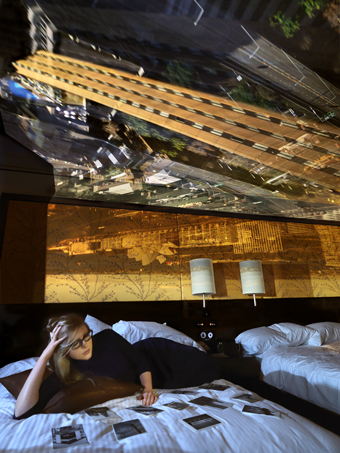
Room 2516, Shangri-la, Isobel (2013), Robyn Stacey, Guest Relations
courtesy the artist and Stills Gallery Sydney
Room 2516, Shangri-la, Isobel (2013), Robyn Stacey, Guest Relations
In Christopher Nolan’s 2010 feature film Inception, the city vertiginously bends, buckles and warps, inverting our sense of up, down and other dimensions. Although Nolan’s trickery quickly runs out of puff—opportunities to play more radically with architecture and urban space are not taken up—the initial shock stays with you. A similar sensation is felt on first seeing Robyn Stacey’s contemplative photographic exhibition, Guest Relations.
Although there is no movement or suggestion of it in these very still images, we see that the outside world has entered a number of rooms, turning walls into screens. Inverted cityscapes hover spectacularly over human figures at rest. Perhaps we are witnessing thoughts or dreams—or someone else’s projections.
Stacey invites us to enter that familiar otherworld of the hotel room, that private/public domain that can be at once comforting and alienating. Most of the lone subjects (there’s one couple) gaze outwards, though not at us. Some appear stunned or at least stilled. One is asleep with her back turned, one wears a sleep-mask, others appear self-absorbed, one of them meditating, momentarily unaware that they’re being watched. Neither do they appear to register that, on the walls and ceiling that contain them, the world outside is encroaching and not in the form of any conventional view.
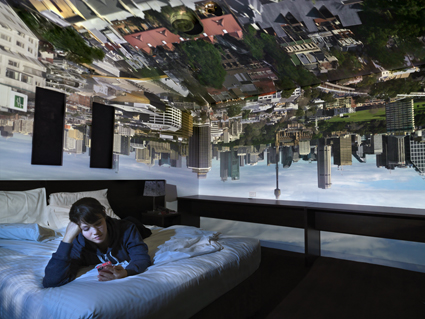
Room 1306, Mercure Potts Point, Jodi (2013); Robyn Stacey, Guest Relations
courtesy the artist and Stills Gallery Sydney
Room 1306, Mercure Potts Point, Jodi (2013); Robyn Stacey, Guest Relations
The effect is distinctly eerie, suggestive of subconscious states and fragmented narratives. At the same time, as with any illusion, you want to know ‘how’ this unnerving blend of the not-quite everyday of hotel rooms and the fantastic has been achieved. Stacey has employed the camera obscura (or pin-hole camera), an ancient technique (from at least the 5th century) that uses a pinhole of light in a darkened room to project the world upside down and reversed. She occupied hotel rooms, which often have very good city views, and invited friends and others to sit for her perfectly in silence for long periods, lit by a torch in order not to destroy the illusion with intrusive light.
Initially the result of a residency at Sofitel on Collins in Melbourne, the project was also played out in Sydney, Brisbane, Gold Coast and Sunshine Coast. In Sydney images, the Opera House spills over a bed and the ugly Toaster is rendered golden. The War Memorial hovers over the meditating man. Skyscrapers hang stalactite-like from the dark. Notably, there are no human intruders, just buildings and parks as if, perhaps, with their own agency.
Once you’ve grown used to the uncanniness of the images, their beauty and sense of inner calm take over, their suggestive complexity at odds with the simplicity of Robyn Stacey’s truly dexterous deployment of simple means in a hi-tech age.
Robyn Stacey, Guest Relations, Stills Gallery, Sydney, 9 Oct-9 Nov
RealTime issue #118 Dec-Jan 2013 pg. 46-47
© Keith Gallasch & Virginia Baxter; for permission to reproduce apply to realtime@realtimearts.net

Platform Papers, No 37: Not at a Cinema Near You
Tina Kaufman believes that in this provocative Platform Paper, “Lauren Carroll Harris has made a timely and important contribution to the ongoing and increasingly necessary debate about old and new film distribution. As she says, there is a ‘pressing need to re-think distribution as the vital way in which we conceive and reach out to our audience—and an urgent problem requiring a solution for Australian filmmakers’” (see article). Harris’ essay also includes a concise account of the troubled history of film distribution in Australia.
5 copies courtesy of Currency House
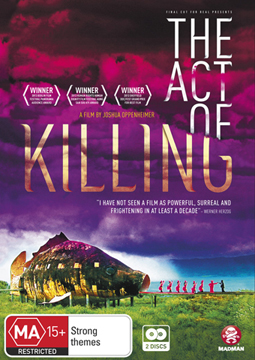
The Act of Killing, DVD
Of this chilling documentary Dan Edwards writes: “A line of dancing girls sashays from the mouth of a giant fish, the scene shot in such lurid tropical colours it appears poised on the edge of a nightmare. Welcome to the make-believe world of Indonesia’s death squads, built on the corpses of a million of their compatriots. Joshua Oppenheimer’s extraordinary new film The Act of Killing—‘a documentary of the imagination’—renders this imaginary world on screen, as the killers who ushered in Indonesia’s ‘New Order’ in 1965 enact their perspective on one of the largest massacres in history.” Read Dan Edwards’ interview with the filmmaker in RT117.
5 copies courtesy of Madman Entertainment
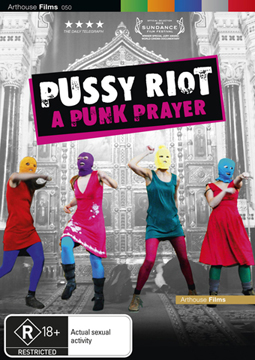
Pussy Riot: A Punk Prayer
We’ve been waiting impatiently to see this British-Russian documentary by Mike Lerner and Maxim Pozdorovkin to learn more about the case of Nadia (Nadezhda Tolokonnikova), Katia (Ekaterina Samutsevich) and Masha (Maria Alyokhina), members of the Russian punk band Pussy Riot who were sentenced to two years in a labour camp after performing a satirical rock song in Moscow’s main cathedral. One of them was freed. Although Pussy Riot were not interviewed for the film, family members were and the court proceedings are followed in illuminating if depressing detail. Russia’s ‘state capitalism’ has little room for criticism, let alone art as protest.
5 copies courtesy of Madman Entertainment
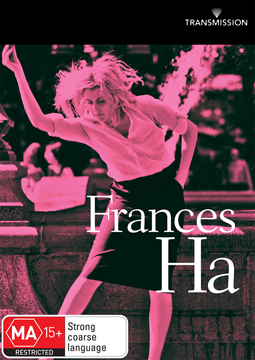
Frances Ha, DVD
If you’re a fan of GIRLS you’ll especially appreciate this film about someone a little bit older—a woman with an evaporating dance career and a faltering social life. It’s a frank and funny account of the superficially engaging but often garrulous Frances Ha (Greta Gerwig, who appeared in Greenberg and To Rome with Love) and her attempts to pursue the creative life in New York while trying to stay afloat economically and emotionally. Shot in luminous black and white and directed by Noah Baumbach (The Squid and the Whale), this is an enjoyable comic fable, almost in the manner of Eric Rhomer—Frances even flies to Paris on a badly misjudged whim.
5 copies courtesy of Transmission Films
RealTime issue #118 Dec-Jan 2013 pg. 48
© RealTime ; for permission to reproduce apply to realtime@realtimearts.net
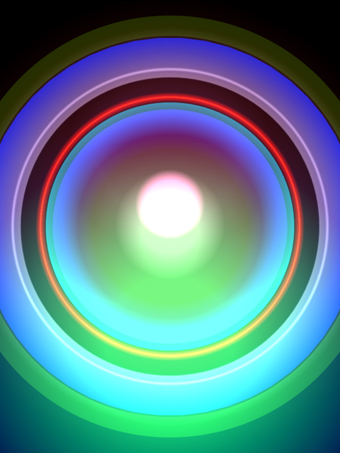
George Khut, Distillery: Waveforming 2012 (detail), developed with assistance from a 2011 Synapse residency
courtesy the artist
George Khut, Distillery: Waveforming 2012 (detail), developed with assistance from a 2011 Synapse residency
2014 Synapse Residencies, ANAT
Applications are now open for the Synapse Residency program for projects in any discipline that involve collaboration between artists and scientists. Residencies are over 16 weeks full-time (or part-time equivalent).
Deadline 7 February 2014; http://www.anat.org.au/2013/11/call-for-applications-2014-synapse-residencies/
ART-Town: call for artists
Melbourne’s Chapel Street precinct is calling for applications for artists to be in-residence, making site-responsive works over the weekends of 29-30 March and 5-6 April 2014. There’s also a prize pool of $4000 for winning artworks.
Applications close March 3; http://www.arttown.com.au/
Hatched, Ensemble Offspring
Ensemble Offspring have just announced their inaugural Hatched program which sees an emerging composer and performer undertake intensive mentorship for 12 months. At the conclusion of the year they will present a program of works developed in association with this celebrated new music group. Applications are invited from artists 30 and under from around Australia.
Deadline 11 Dec, 2013; http://ensembleoffspring.com/ensemble-offspring-academy/
Skip Ahead, YouTube & Screen Australia
You Tube & Screen Australia have come together to offer a unique funding initiative for Australian content producers to create online video content. Up to $100,000 is available for web series projects proposed by artists or groups who already have a YouTube channel with 100,000 subscribers or more. Up to five projects will be funded and successful applicants will also receive a training trip to one of YouTube’s “Spaces” in Tokyo, London or Los Angeles in March/ April 2014.
Deadline 20 Dec, 2013; http://www.screenaustralia.gov.au/getmedia/0aa1c24a-6854-4687-8ece-085cc850aa4a/Guidelines_SkipAhead.pdf
Amplify Your Art, Accessible Arts
A funding initiative of Arts NSW devolved to Accessible Arts, Amplify Your Art offers grants of $5,000-$10,000 to artists with disabilities to undertake mentorship, training and other professional development activities. Also check out RealTime 118 Ennabling Art feature.
Deadline 18 Dec, 2013; http://www.aarts.net.au/amplify/
Still in the loop
Public Art, Heffron Hall, City of Sydney
Tenders due 6 Dec; http://www.cityartsydney.com.au/cityart/news/?p=1871
Exposure Summer Intensive, Tasdance
Applications currently open; http://tasdance.com.au/exposure/; for more info email richard@tasdance.com.au
CJZ/Rock Surfers New Writing Commission
Deadline 2 Dec; http://rocksurfers.org/newwords/
Courthouse Arts Visual Arts Program
EOIs due 15 Nov; http://courthouse.org.au/on-now/searching-for-a-young-curator-for-2014/
Editor, Un Magazine
Applications due 25 November 2013; http://unprojects.org.au/magazine/contribute/
Waterwheel Symposium Call for Participation
Proposals for Symposium due 22 Nov; proposals for Voice of the Future Youth Day, 31 Dec; http://water-wheel.net/
Selected Australia Council Grant Deadlines
(for full list go to http://www.australiacouncil.gov.au/grants
Visual Arts Travel Fund – 25 November 2013
http://www.australiacouncil.gov.au/grants/2013/Visual-Arts-Travel-Fund
Contemporary Music Touring Program – 25 November 2013
http://www.australiacouncil.gov.au/grants/2013/contemporary-music-touring-program-25-november
RealTime issue #117 Oct-Nov 2013 pg. web
© RealTime ; for permission to reproduce apply to realtime@realtimearts.net
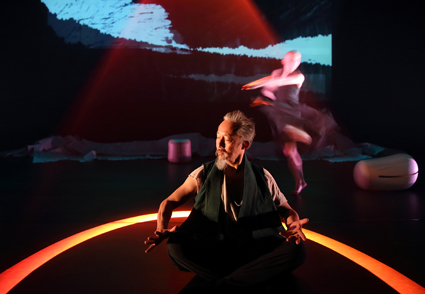
Xiao Xiong Zhang, Not According to Plan, Leigh Warren & Dancers, OzAsia Festival
photo Tony Lewis
Xiao Xiong Zhang, Not According to Plan, Leigh Warren & Dancers, OzAsia Festival
This latest work from Leigh Warren & Dancers featured in the OzAsia Festival is visually stunning. And yet that expression does not describe my sensual response to what unfolded on stage. It is not ‘spectacular’ in the sense of establishing distance between spectator and event. The images, colours, shapes, textures, movement, music and light captivated me like the perfume of jasmine or the movement of silk or the sound of rain or the intense colour of tropical vegetation. It is a deeply satisfying sensual work.
The work emerged from collaborations between Adelaide-based choreographer Leigh Warren and lighting designer Geoff Cobham with Cambodian born dance artist Xiao-Xiong Zhang (the “subject of the work”), Malaysian-Australian furniture maker Khai Liew, Australian-Vietnamese fashion designer Alistair Trung and Malaysian writer and musician Jerome Kugan. The production unfolds as a set of evocative images that move and transform. We experience this unfolding as waves of sound, colour, light and movement washing across the stage. These images and waves are responses to the life of Xiao-Xiong who is both observer and participant in the unfolding dance. Other elements include: projections of ink wash drawings and calligraphy by Helen Fuller on a rice paper screen; rich, swelling music drawn from a broad palette of sound; Xiao-Xiong’s recorded voice; billowing and fitted intensely coloured costumes (burgundy, black, green) that reference clothing from various Asian countries; an exquisite landscape of finely turned, wooden furniture initially buried beneath a floor ‘cloth’ textured like handmade paper; and boldly coloured light (electric blue and salmon pink among others) that defines the space, the furniture and the dancers.
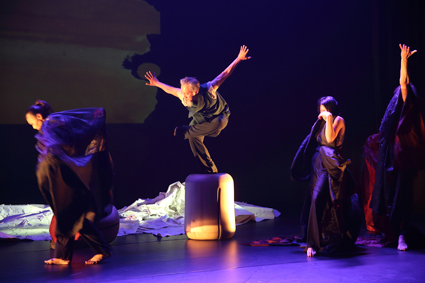
Xiao Xiong Zhang, Not According to Plan, Leigh Warren & Dancers, OzAsia Festival
photo Tony Lewis
Xiao Xiong Zhang, Not According to Plan, Leigh Warren & Dancers, OzAsia Festival
For so many years now Leigh Warren has trained dancer after dancer. His training and choreography ask the dancer to move seamlessly like water spilling in all spatial dimensions and in relation to each other’s bodies, with legs and spine as articulate as arms. Here the dancing is organised into duets, solos, a trio and final quartet in relation to the figure of Xiao-Xiong, but it converses with costume, music, light, set, projection and image rather than speaking solely according to a physical logic discrete from all other elements. For me, Warren’s choreography is always located between meaning and pure physical eloquence. The four dancers’ gestures, their interactions with Xiao-Xiong and the recorded spoken stories hint at a life lived across a number of countries and the challenges, resolve and pleasures of that life. Meaning lurks but does not dominate and must be felt through the sensuous appreciation of the work in its entirety.
OzAsia Festival, Leigh Warren & Dancers, Not According To Plan, choreographer Leigh Warren, performers Rebecca Jones, Aidan Munn, Yuan-Li Wang, Chien-Wei Wu, Xiao-Xiong Zhang; Space Theatre, Adelaide Festival Centre, 20-21 Sept
For background on Anne Thompson, see our contributor profile feature.
This article first appeared as part of RT’s online e-dition 20 November, 2013
RealTime issue #118 Dec-Jan 2013 pg. 31
© Anne Thompson; for permission to reproduce apply to realtime@realtimearts.net
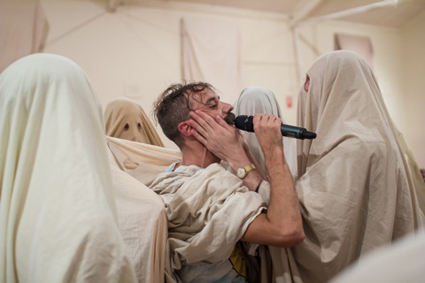
Luke George and collaborators, Not About Face
photo Nick Roux
Luke George and collaborators, Not About Face
I have moved in a flock—a flock of ghosts—led round an empty room by a mystical maverick. This is one memory, at least, that I can take away from Not About Face, a work to be felt and experienced rather than merely seen.
Luke George has us enter the seatless studio space draped in sheets with cut-out eyeholes, the first in a string of whimsical experiments to tweak his audience’s consciousness. Anonymity strikes as we roam, awaiting the show. “What’s under your sheet?” we wonder, our interior worlds reified, yet not revealed. (It’s a bit like a masquerade party, but we are homogenous as Halloween ghosts.) So the stuff of the spirit is raised in a literally material way—a droll device, and one that arouses doubts. What distinguishes us as we roam in these veils? How do we now ‘see’ the other? The self? And how does this change the way we inhabit the moment, our movement, and space?
You could say we’ve been given new and identical ‘bodies,’ and an involuntary flock or herd feeling is born. We shuffle about with tunnel vision and fuss with our eye holes, our sheets flow around our limbs as we move and our motions are further swayed when Luke George takes the floor.
He appears in our midst as a fellow ghost, with a hiss and a stifled shriek, then unveils himself, revealing his blindfolded face (and so, our performer is vulnerable too). “Follow me, follow me,” he urges, and we glide along, drawing back when he whirls like a dervish or strikes out a path to the wall. But what stirs the flock further still is his fitful soliloquy on the spirit and what it might mean. When the blindfold is lifted he delivers synaesthesiac speculations on the colour of our souls, and then the sounds of those colours, until he unites us all in a brief, fleeting chorus on the theme.
Such New Age allusions are rampant throughout the work, and there’s much to be said for George’s wry presentation of “aura-reading and energy-conversion” among other phenomena. He seems to have seen that there’s no escaping the kitsch, the whiff of occultism, the cultural trappings that so taint our grasp of the mystical, so he takes the whole swag and exploits and transforms it into a genre in itself. But while his treatment is exuberant and camp, he does not surrender to satire. True, he writhes and shrieks and speaks in otherworldly tongues at times, but with an air of amused demonstration and daring more than anything else.
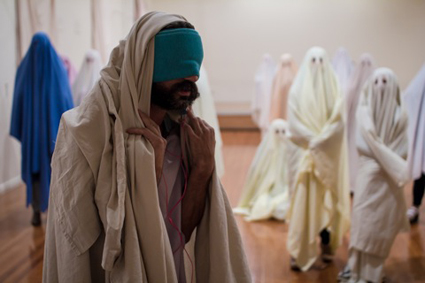
Luke George and collaborators, Not About Face
photo Nick Roux
Luke George and collaborators, Not About Face
Overall, the work is woven by George’s sincere and lucid intent—he speaks as himself between ‘acts’—to draw our embodied presence into the moment. Is this the business of live art? Of mysticism? Of both, no doubt. But it also looks quite naturally to be the business of dance. George almost precludes remote viewing (the long-distance firing of mirror neurons at best), instead drawing us into collective engagement and (by way of experimental enactment) an inkling, yes, of the mystical.
At the highpoint of the work he invites us with feverish urgency to press his body with our hands and release into an afterglow of sensations. Then we all sink to the floor and get cosy. This is the confessional heart of the show, and the moment when we consider what reservations to suspend. “How close can we get?” George offers to swap clothes with someone in the room and “dance their dance”—an offer that I, glancing down at my lovely green dress and black boots beneath my sheet, can hardly decline.
Does he dance my dance? I would say that he does, surprisingly. And he also looks fetching in the dress, allowing the power of costume to come into play. Here again, the ‘material’ acts as an opening for the intangible—call it the spirit if you will, although style figures in this instance as well. But regardless of how we define this stuff, what Luke George aims to show is his (and therefore our) capacity to tune into one another and to connect.
So it’s only fitting that, after all this bonding, he unveils the group—with a camp rendition of a magical spell—and ends with a coda of sorts, by dancing a dance that looks authentically all his own. Taut but skittish, erratic but graceful, strutting and posing to electronic music in a wrestling singlet, it is a flamboyant display to end an absorbing work.
Not About Face, Luke George with collaborators Hillary Clark, Nick Roux, Benjamin Cisterne, Martyn Coutts, performer Luke George, Dancehouse, Melbourne, 9-13 Oct
This article first appeared as part of RT’s online e-dition 20 November, 2013
RealTime issue #118 Dec-Jan 2013 pg. 30
© Jessica Sabatini; for permission to reproduce apply to realtime@realtimearts.net

The Canberra Pursuit, Jon Rose and collaborators, Canberra100
photos Martin Ollman
The Canberra Pursuit, Jon Rose and collaborators, Canberra100
As part of Canberra’s Centenary celebrations, Jon Rose has presented the largest version to date of his Pursuit project, modifying over 130 bikes to become musical instruments. Below he offers a personal account of this unique art venture that combines experimental music, sculpture, community creativity, ecological responsibility and, of course, fitness. [Eds]
According to The Australian Bicycle Council, Canberra comes out way on top compared to the national average on most statistics to do with bicycle ownership, work and pleasure use, participation by gender and number of bikes per household. So, from an organisational perspective, Pursuit was a perfect match for a town that has always considered the bike in its planning priorities. As Pursuit was being built at TAMS (basically the transport services depot for Canberra), a new bike lane was under construction right outside the front gate—in an industrial zone (unthinkable in Sydney). The site itself was huge and included a large ‘hangar’ space and car park in our operational zone.
I thought we would be stretched to present 80 musical bikes for Pursuit; we ended up with an astonishing 130 in the event, from the very simple (foot pumps attached to pedal powered whistles), to quite complex machines (a piano tuned to an F major chord and played by two independent ‘hands’ adjusted in range, pitch inversion and rhythm by the position of the handlebars). By chance, the last instrument made for the previous Pursuit (at Mona Foma 2010).) became the model mechanism for a number of instruments in the Canberra Pursuit—light, robust, comparatively easy to assemble, minimal welding and spoke driven—we named it The Tickler. And tickle it did, via a host of different resonating objects from oil drums to metal plates and wooden boxes.
The main instrument makers were Wayne Kotzur, Paul Bryant and me. To this central production team came significant members of The Rat Patrol, the Melba Copeland Chopper program, Jim Sharrock, the outstanding Bell Chamberlain—about 25 makers in total. An attempt to integrate the local Make Hack Void into building a wide-ranging re-cycled electronic junk component for Pursuit went off the boil; the exception was Adam Thomas, who re-cycled an old Atari. Included in The Canberra edition of Pursuit were a few instruments from earlier manifestations of the project, including the original Viocycle with gearing designed by Paul Bryant (first experienced at The Sydney Velodrome in 2004) and Rod Cooper’s excellent ping-pong bass drum (2009).

The Canberra Pursuit bikes made by Wayne Kotzur, Paul Bryant and Jon Rose, with extra contributions from Richard Johnson, Bel Chamberlain, Sam King, Harry Vatiliotis
photos Jon Rose
The Canberra Pursuit bikes made by Wayne Kotzur, Paul Bryant and Jon Rose, with extra contributions from Richard Johnson, Bel Chamberlain, Sam King, Harry Vatiliotis
New music species
The musical bikes of Pursuit can be divided up into six classes of homemade instrument making:
1. regular musical instruments played by the cyclic mechanism of a moving bike, eg viola or guitar;
2. artefacts not normally associated with music performance which were sonified by bike action, eg a baking tray, a polystyrene vegetable box, dragged and ‘flapperphoned’ drainage pipes, reversing truck bleepers, forty-gallon drums, a water bottle amplified clicker, a fire extinguisher, typewriters (it was Canberra’s birthday!) or a siren (despite Edgar Varèse, this perfect glissando of an instrument remains exotic in orchestral music);
3. constructed extensions to bike mechanisms that manipulate or interfere with the basic repeating cycle of motion, eg a bike fitted with a tennis racket hitting syncopated and timbrally varied strokes with a golf ball into a plywood net;
4. musical instruments uniquely designed and made to function with a moving bike, eg The Grand Fiddle or the Ping Pong bass drum;
5. sonic phenomena induced by stationary exercise bikes, eg the Plectraphone or the Double Violin (2VC);
6. psychoacoustic disturbances intensified by visual and physical bike action, eg the double hammer bike built by Wayne Kotzur—an existentialist statement if ever there was one.
Unlike digital loops, the repetition of bicycle-powered instruments, although cyclic, are not exact copies of previous sonic events. Every cycle of sound reveals sonic transformation, shifts, sometimes subtle, sometimes radical—the most radical being when the mechanism screws up. The use of re-cycled and unreliable materials creates a natural tension; no one can predict if the instrument will last years, days, or minutes.
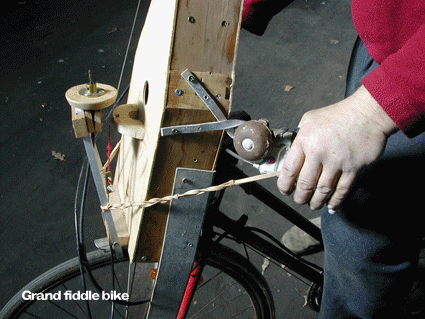
The Canberra Pursuit bikes made by Wayne Kotzur, Paul Bryant and Jon Rose, with extra contributions from Richard Johnson, Bel Chamberlain, Sam King, Harry Vatiliotis
photos Jon Rose
The Canberra Pursuit bikes made by Wayne Kotzur, Paul Bryant and Jon Rose, with extra contributions from Richard Johnson, Bel Chamberlain, Sam King, Harry Vatiliotis
Participatory pedal power
I had originally been encouraged by Dan Watters (the key figure in The Rat Patrol) to believe that several hundred riders would be easily persuaded to take part in Pursuit. In the end, it was hard work finding 50 riders who were keen and engaged in the possibilities of making music through re-cycled bike technology. The gap between serious bike riders, feral cyclists, bike collectors, sculptors, student musicians, casual cyclists and electronic hobbyists remained problematical, despite my efforts to bring the various groups together. Both Dan and I spent much time trying to encourage commitment to Pursuit on a local Canberra level with mixed success. However, I don’t think we could have coped with any more riders on the actual performance night as the last 10 minutes of the spectacle pretty well filled up the track; any more would have constituted a safety hazard.
Talking of which—there were, as predicted, no safety issues despite many bikes having only one brake (the other brake often engaged in musical manipulation such as pitch and rhythm variants) and operating way beyond ‘manufacturer’s specification.’ All bikes and riders returned from the track without incident in both the rehearsal night and the public performance itself. Public Liability insurance was forced on me, but wouldn’t have been worth the paper it was printed on in the event of a claim. It would have been difficult to find a bike in our collection of re-cycled junk without rust, a ding or two or evidence of serious neglect (abundant wildlife was also noted).
The contribution by Jeff Thompson at LEAD was exceptional. He lent us 42 bikes for the event, plus spare tyres, tubes, bells etc. With very few exceptions, all the second-hand bikes were returned in their original condition, the mechanical devices stripped or angle grinded off on the following day after the performance. On the Monday before Pursuit took place, Jeff visited the TAMS site with his team of employees, all of whom were mentally or physically disabled. They were without doubt totally excited by the whole project of which they were a part.
Highlight: one of the guys who struggled to keep up with the rest and who appeared devoid of any expression or speech, pointed at one of the bikes. “You want to ride it?” I asked. No reaction, but I assumed the affirmative and helped him on. Suddenly, he burst out with the broadest possible smile as the sounds started to spin and cascade around the space. This was one of the stationary exercise bikes attached to a previously discarded gas cylinder (the section cut instrument sounded like a sped up gamelan orchestra). That guy’s pure elation was a moment hard to beat.
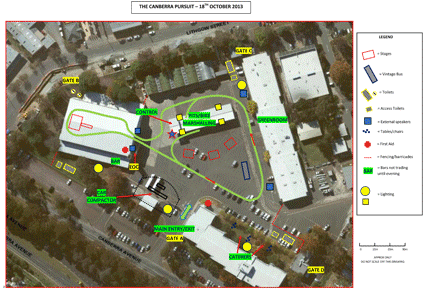
The Canberra Pursuit, route map, Jon Rose and collaborators, Canberra100
photos Martin Ollman
The Canberra Pursuit, route map, Jon Rose and collaborators, Canberra100
Bike & bytes
Combined with the re-cycled and the rusty were two interactive systems. Sam Fergusson wrote and managed the software for the interactive sensor strip that riders cycled over every time they entered ‘The Hangar,’ triggering a selected array of alert sounds, from foghorns to old Apple Macintosh alerts, from car horns and alarm clocks to cockerels. By nature of Pursuit being a community project, I had to consider the possibility that anyone might turn up with a bike on the night and demand to ride; the sensor strip ensured a democratic sonic marker.
Sue Powell (a Paralympic champion cyclist, no less) honoured us by riding her bike (designated the e-bike) fitted with a special box of accelerometers and contact microphones that transmitted bike movements and speed as data to a central computer. This data was then put to use manipulating many aspects of the surround sound audio (which I controlled using my ancient Steim-based software). Video from two live feeds and pre-recorded close up images from over 30 of the musical bikes provided details of how the instruments actually worked. The four riders of The Canberra Bicycle Powered Cinema produced enough DC to power Louise Curham’s appropriate Super 8 film installation, which ran in parallel to the three video screens (two open air, one interior).
They’re racing
The broad structure of The Canberra Pursuit was provided by a time sheet. Every two minutes, on the minute, a new wave of riders hit the track and for three laps proceeded to sound out the space with their specially constructed musical machines (three laps took between 5.20 and 5.50 minutes to complete). Each wave had specific sonic characteristics: for example, a swarm of clicker bikes; a deconstructed drum kit on four bikes (ride cymbal, bass drum, floor tom, tickler snare); Richard Johnson’s trio of reeds and fantastic plumbing bikes; or The Rat’s DJ bike (Master Gravity) where the ruts in the track corresponded to the heavy scratching of a vinyl disc (Queen’s “Bicycle Race”). Some bikes re-constituted themselves for use further into the composition so, the cluster of pedal pumping whistle bikes had their sensitive moving parts removed to render them focused for the bicycle bell episode just prior to the final act.
Since the early 1980s I have been intrigued by the notion that music could be measured as a distance-based expression as much as time based one: not how long is a piece of music, but how far? The wheeling triple necked violin made in 1984 was an attempt at realising this functionality. (http://www.jonroseweb.com/d_picts_wheeling_violin.html)
The track for The Canberra Pursuit came in at 463 meters long, so each performer/bicycle/instrument travelled 1,389 meters in their specific section and since there were 130 machines, we ended up with 180,570 meters of individually defined music plus an unquantifiable distance sonified in the final 10-minute all-in bedlam. The performance lasted one hour. Well, in hindsight there were anomalies, as the piano bike only lasted two laps, the World of Wheels tandem vanished from the pits and at least two of the musical bikes never made the starting grid (these were the feedback handlebar bike and the amplified bowing machine that I had left charging in the storeroom and had completely forgotten about).
On discovery that Bunnings had just taken delivery of their Christmas stock of festive lights and were flogging them at knockdown prices, Dan Watters cleared the store and the visual results as day turned into night around the Pursuit Track were quite stunning for a budget-light show—Catherine Wheels spinning like crazy—and in colour. I hadn’t expected it, but many bikes were turned out in feral finery with feathers, horseshoes, beerbottle tops (the most resplendent and abundant drag Lagerphone ever) and spray cans au-go-go.
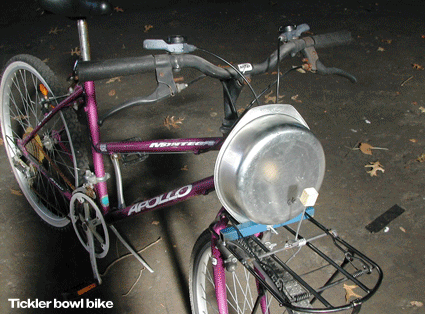
The Canberra Pursuit bikes made by Wayne Kotzur, Paul Bryant and Jon Rose, with extra contributions from Richard Johnson, Bel Chamberlain, Sam King, Harry Vatiliotis
photos Jon Rose
The Canberra Pursuit bikes made by Wayne Kotzur, Paul Bryant and Jon Rose, with extra contributions from Richard Johnson, Bel Chamberlain, Sam King, Harry Vatiliotis
Celebratory new music
It was the legendary Sydney violin maker Harry Vatiliotis who pointed out to me that The Pursuit Project had much in common with the ancient practice of Charivari—the use of noise (rough music or people’s music) for celebration, some sorts of community censure and demonstrations to achieve social, cultural or political change. (A worldwide example of Charivari survives today with the practice of tying tin cans to the back of a car carrying newlyweds surrounded by well wishers energetically hooting their car horns). Pursuit can indeed be considered an example of Charivari, in the sense of both celebration (of Canberra’s birthday) and pointer for ecological revolution, a music practice that demands change in our species behaviour by creating music with trash that celebrates, rather than denies, a sense of place (most music performed in Australia ignores its geographical, cultural and historical context).
By definition, a new musical instrument will tend to produce new music and Pursuit was structured so that, even with fifty acoustic bikes on the track at one time, combined with two systems of amplified interactive sound, each individual bike could be heard as it passed each individual set of ears of an audience member. More often, much smaller constellations could be heard in close focus, in middle distance and amplified through the surround sound up to 100 meters away, all sounds moving at various speeds continuously (except for one stationary ensemble of exercise bikes). Then there were the close up and personal mixes for each cyclist and musical bike, sounds overtaking other sounds along the track, sounds colliding in space.
How much of this became evident to those taking part is a debatable point. Time constraints limited the options of getting to know each musical bike—these instruments were not automatons, they required physical reciprocal operational knowledge. Despite detailed instructions attached to each bike, the musical options of many bikes were likely underutilized, the overall sound world disorientating and fast moving for some, a joyful adrenalin fix for others. Of the 50+ makers and riders involved with Pursuit, only four to my knowledge were bona fide musicians. The experience of Pursuit took place outside the traditional actions and responses of a musician-based performance. I wonder if I’d been able to pay members of a symphony orchestra to take part, whether the musicality would have been better or worse? I’ll leave that question in the air.
Highs & lows & in betweens
High Point: operating two huge surround sound sonic spaces (a ‘Hangar’ and a car park) that were both audible simultaneously. As day turned to night, the other features of mobile sound such as Doppler, phasing, delays and modulations were also audible in the windless Canberra spring evening for those who wanted to hear. Others were there for the social hang (fine by me); when did you last hear members of an audience screaming with delight throughout a new music event?
Low Point: my inability to coax music students from the ANU to get involved with the project. What is it with this generation, the lack of curiosity?
The Point that never ceases to amaze me: how the management of TAMS never stepped up to the mark with a proper professionally painted lined track for the 100th Anniversary and celebration of their town, embarrassing their employees (the guys who do the lines on the roads) and anyone who owes Canberra for a very comfortable living. As a member of the Centennial team remarked, I’ll go to my last days still harbouring that special place of bewilderment in my brain.
Favourite Instrument du Jour: The Ukulele Bike
Pursuit exhibited a large number of professional skills, homemade know how, hands-on knowledge and instrument making techniques and concepts exploring the notion of what constitutes a musical instrument. I don’t know of any other occasion in the musical history of Australia (or anywhere else for that matter) where so many instrumental experiments have been improvised into existence in such a short space of time and returned to their various states of entropy and atrophy immediately post performance—a short lived trajectory like the nature of musical performance itself.
Thanks
Wayne Kotzur and Paul Bryant were key to the success of this project—extra hours, trailer trips, you name it. Special Thanks to Justin Watson, Julian Hobba, Dan Watters (the key link between the world of cycling and the Centenary) for their tolerance and commitment; and to Robyn Archer for taking a risk by providing the original invitation.
Canberra 100: Pursuit 3, concept, composer & director Jon Rose, main instrument makers Paul Bryant & Wayne Kotzur, community engagement Dan Watters; TAMS Depot, Fishwyk, Canberra, 18 Oct; http://www.jonroseweb.com/f_projects_pursuit.html
See also our Archive Highlight compiling our coverage of Jon Rose in RealTime over the years.
Canberra 100: Pursuit 3, concept, composer & director Jon Rose, main instrument makers Paul Bryant & Wayne Kotzur, community engagement Dan Watters; TAMS Depot, Fishwyk, Canberra, 18 Oct; http://www.jonroseweb.com/f_projects_pursuit.html
Links
http://www.youtube.com/watch?v=xpJubsaURps
www.youtube.com/watch?v=0KiGCwJ5b3k
http://www.youtube.com/watch?v=jIwQpzEzIqI
RealTime issue #117 Oct-Nov 2013 pg. web
© Jon Rose; for permission to reproduce apply to realtime@realtimearts.net
The last in the loop for the year and it’s actionpacked. As it’s so huge we’ve made artform sections for easy browsing. Dive in…
PERFORMANCE | DANCE | VISUAL/MEDIA ARTS | MUSIC | FILM
PERFORMANCE
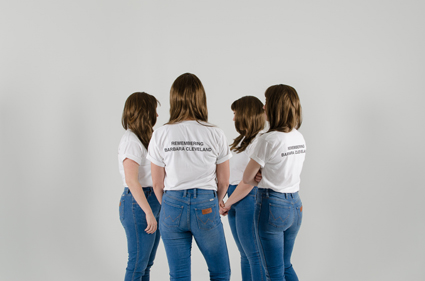
This is Barbara Cleveland, Brown Council
photo Lucy Parakhina
This is Barbara Cleveland, Brown Council
You’re History: Performance Space 30th Birthday
The Performance Space birthday bash promises to be enormous, with multiple events every night for 10 days including new works by Tess de Quincey, Nigel Kellaway, Ros Crisp and Brown Council, compilation re-mixes from most Performance Space directors and the TeleVisions festival.
For all the info read our interviews with directors Bec Dean and Jeff Khan and Brown Council.
You’re History: Performance Space 30th Birthday, Carriageworks, 20 Nov 1 Dec; http://www.performancespace.com.au/
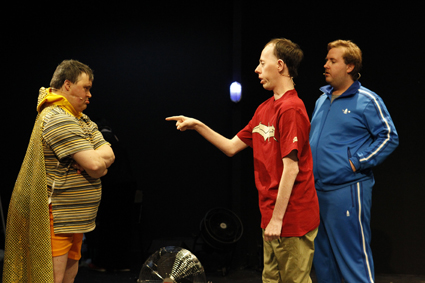
Mark Deans, Simon Laherty and Brian Tilley, Super Discount, Back to Back Theatre
photo Jeff Busby
Mark Deans, Simon Laherty and Brian Tilley, Super Discount, Back to Back Theatre
Super Discount, Back to Back, Malthouse
Following its Sydney Theatre Company premiere, Back to Back’s Super Discount is now in the middle of its Melbourne season at Malthouse. In RT117 Keith Gallasch wrote, “audition routines, debates, role playing…witty scripting and a strong focus on trust…all add up, delivering a satisfyingly complex and richly entertaining experience.”.
Back to Back Theatre, Malthouse Theatre and Sydney Theatre, Super Discount, Merlyn Theatre, The Cooper’s Malthouse, 13 Nov-1 Dec; http://www.malthousetheatre.com.au/show-listing/super-discount/
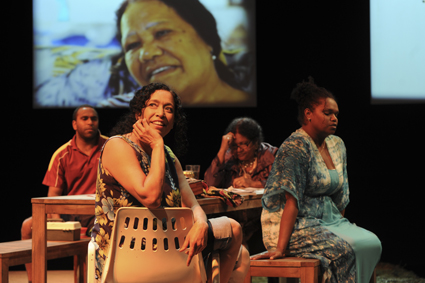
Harry Reuben, Rachael Maza, Magdalena Blackley, Kylie Doomadgee, Beautiful One Day, Ilbijerri, version 1.0 & Belvoir
photo Heidrun Löhr
Harry Reuben, Rachael Maza, Magdalena Blackley, Kylie Doomadgee, Beautiful One Day, Ilbijerri, version 1.0 & Belvoir
Beautiful One Day, Ilbijerri Theatre Company, version 1.0, Arts House
After last year’s successful premiere season at Belvoir, Beautiful One Day has its Melbourne debut at the Arts House, North Melbourne Town Hall. In his review in RT113 Keith Gallasch wrote, “This account…digs into the island’s history and adds a heightened Indigenous perspective side by side with verbatim recreations of pivotal moments in the unfolding tragedy.”
Beautiful One Day, Ilbijerri Theatre Company, version 1.0, Arts House, North Melbourne Town Hall, 26 Nov-1 Dec; https://www.melbourne.vic.gov.au/ArtsHouse/Program/Pages/BeautifulOneDay.aspx
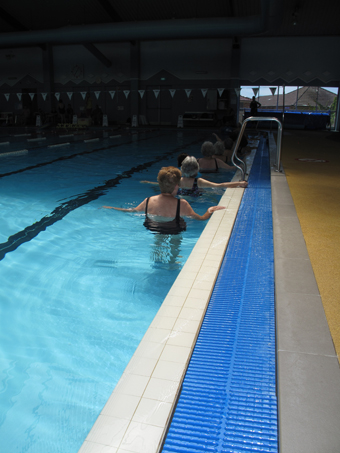
Birthing Things in the Spirit: The Water Birth, David Capra
courtesy the artist
Birthing Things in the Spirit: The Water Birth, David Capra
Birthing Things in the Spirit: The Water Birth, David Capra, Campbelltown Arts Centre
David Capra is interested in “intercessions,” art experiences that initiate healing and spiritual enlightenment. Currently he’s working with the ladies from the over 50s aquatic group at Eagle Vale pool in Sydney’s southwest to create a “water birth of the spirit,” with some stylistic inspiration from Australia’s own inventor of synchronised swimming, Annette Kellerman and Hollywood’s Esther Williams. The results of the month-long exploration are open to the public.
Campbelltown Arts Centre: Birthing Things in the Spirit: The Water Birth, David Capra, Eagle Vale Central, Campbelltown (Aquatic Centre); 30 Nov, 6pm; http://www.campbelltown.nsw.gov.au/Dance
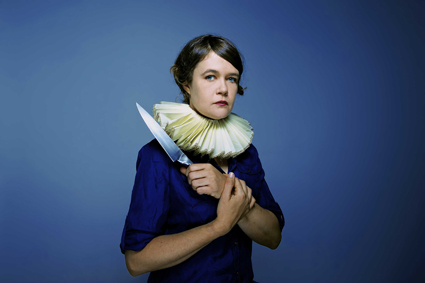
The Hayloft Project, Arden vs Arden
photo Sarah Walker
The Hayloft Project, Arden vs Arden
Arden vs Arden, The Hayloft Project
Melbourne indie theatre collective The Hayloft Project is about to relocate to Sydney but they’re having one last hurrah with their production Arden vs Arden. Directed by Benedict Hardie this adaptation of Arden of Faversham, an Elizabethan tale of bloody murder and betrayal, occurs in both a contemporary Australian and historical context, with some blurring along the way. (See our interview with Anne-Louise Sarks, collaborator with Hardie and Hayloft)
Darebin Arts Speakeasy presents The Hayloft Project’s?Arden v Arden?, 20 Nov-8 Dec, http://darebinarts.com.au/event/arden-v-arden-by-the-hayloft-project/
DANCE
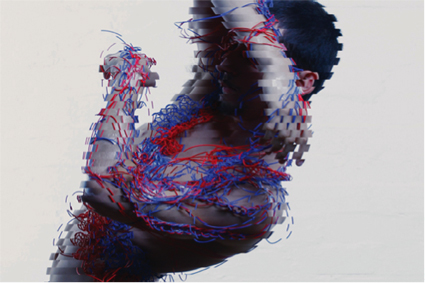
Aorta, Stephanie Lake, Chunky Move
courtesy the company
Aorta, Stephanie Lake, Chunky Move
Aorta, Stephanie Lake, Chunky Move
It’s been a prolific year for Stephanie Lake with premieres of four major works including Dual in Dance Massive (see review and rt tv interview); Axial in Frontier Danceland, Singapore; A Small Prometheus in the Melbourne Festival (to be reviewed in RT118); and now Aorta for Chunky Move. This is Lake’s second commission for the Next Move program and sees her choreographing for three male dancers, exploring the body’s interior secrets, to a score and lighting system by Robin Fox.
Aorta, Stephanie Lake Chunky Move Studios, 22-30 Nov; http://www.chunkymove.com/Our-Works/Next-Move/AORTA.aspx
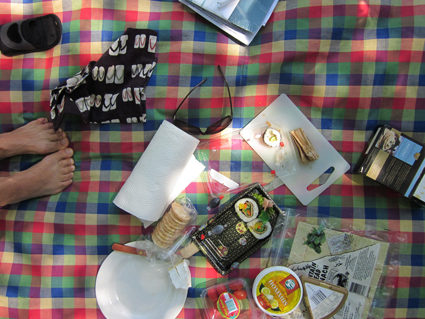
Nat Cursio’s CRITNIC
courtesy the artist
Nat Cursio’s CRITNIC
CRITNIC, Nat Cursio
Nat Cursio’s latest venture combines a picnic with some stimulating critical chat about dance. It’s “similar to a book club, but instead of talking about books we’ve read, we’ll talk about dance performances we’ve seen” (press release). And while actually held inside, there’ll still be picnic rugs and snacks.
CRITNIC, Lucy Guerin Studio, 24 Nov 2pm; http://www.trybooking.com/Booking/BookingEventSummary.aspx?eid=67448
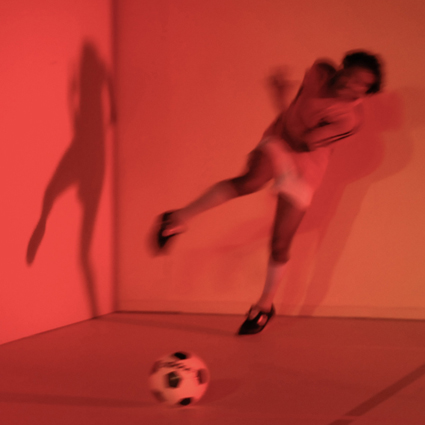
Ahilan Ratnamohan, SDS1
photo Heidrun Löhr
Ahilan Ratnamohan, SDS1
SDS1, Ahilan Ratnamohan, PICA
Following his well-received solo theatre work The Football Diaries, ex-professional soccer player now performer Ahilan Ratnamohan is presenting a solo dance work at PICA. SDS1 is inspired by the physicality of the game and its attendant issues of “efficiency versus artistry, result versus style, and the psyche of vulnerable warriors” (website).
SDS1, Ahilan Ratnamohan, PICA, 27-30 Nov, http://www.pica.org.au/view/SDS1/1753/
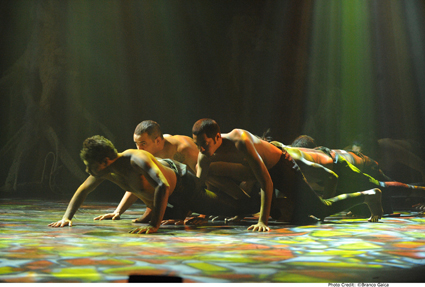
Ngalpun Mudth (Our Home), NAISDA Indigenous Dance Showcase
photo Branco Gaica
Ngalpun Mudth (Our Home), NAISDA Indigenous Dance Showcase
Ngalpun Mudth (Our Home), NAISDA Indigenous Dance Showcase
Forty dancers undertaking training at NAISDA will profile their achievements in an evening of works choreographed by nine professional choreographers including Vicki Van Hout, Sani Townson, Frances Rings and Gary Lang, along with two pieces by emerging student choreographers.
Ngalpun Mudth (Our Home), NAISDA Indigenous Dance Showcase, Carriageworks, 11-14 Dec; http://www.carriageworks.com.au/?page=Event&event=NAISDA-END-OF-YEAR-SHOW
VISUAL/MEDIA ARTS
Melbourne Now, NGV
The absolutely epic Melbourne Now is about to launch, featuring the work of over 400 artists exhibited across both sites of the National Gallery of Victoria. Special commissions include a new sound and light installation from Marco Fusinato; a video commission from Daniel Crooks focusing on Melbourne’s laneways; and an icing-covered share house constructed by the Hottham Street Ladies artist collective. Lucky it’s on for four months—it might just take that long to see everything.
Melbourne Now, NGV; 22 Nov – 23 March; http://www.ngv.vic.gov.au/whats-on/exhibitions/exhibitions/melbourne-now
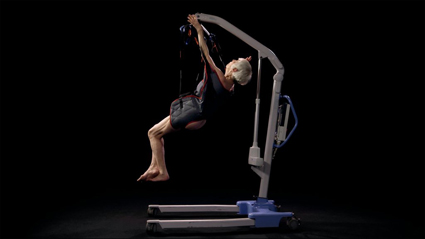
Kate Murphy, Lift, 2013, single-channel HD video with sound
courtesy the artist
Kate Murphy, Lift, 2013, single-channel HD video with sound
Lift, Kate Murphy, Breenspace
Video artist Kate Murphy has a new work, Lift, soon to be exhibited at Breenspace. Inspired by her experiences visiting her father in an aged care facility, Lift places a dancer’s body in a mechanical patient lifting mechanism in a poignant exploration of the “relationship between the cognitive and the subconscious self, and the ‘dances’ we perform everyday” (press release).
Lift, Kate Murphy Breenspace, 29 Nov-21 Dec; http://www.breenspace.com/exhibitions/kate-murphy/katemurphy_lift_2013_still2.jpg.php
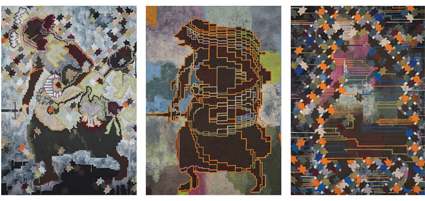
Ruth Walller, Dulle Griet (2013) acrylic on linen, Insight Radicals
courtesy the artist
Ruth Walller, Dulle Griet (2013) acrylic on linen, Insight Radicals
Insight Radicals: MCLEMOI Gallery
Tony Lloyd, Steve Lopes, Anna Madeleine, Natalie O’Connor, Peter Sharp and Ruth Waller have undertaken a year-long residency at the ARC Centre of Excellence for Free Radical Chemistry and Biotechnology at the University of Melbourne. The results of their fascination with free radicals, in our bodies and materials, will be exhibited at MCLEMOI gallery, touring to Adelaide in 2014. Expect “luminous light media, sci-fi landscapes, sound activated paintings and water colour portraits” (press release).
Insight Radicals, 27 Nov-9 Dec; http://mclemoi.com/portfolio-view/insight-radicals/
Archana Hande artist talk, spaced
Spaced (formerly IASKA) offers opportunities for international and Australian artists to undertake in-depth residencies in regional areas of Western Australia culminating in a biennial exhibition (see RT108, http://www.realtimearts.net/article/issue108/10599). Visiting Indian artist Archana Hande will be presenting an artist talk at the spacedHub in Perth about her recent experiences in Laverton looking at “local histories and stories that trace existing contested terrains concerning tradition, trade and migration” (website).
Archana Hande artist talk, spacedHUB, Perth, 21 Nov; http://www.spaced.org.au/posts/news/
SOUND/MUSIC
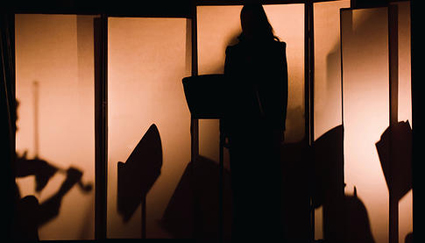
Corridor, CACHE in POINT
courtesy the artists
Corridor, CACHE in POINT
Corridor, CACHE in POINT
The curators of Cache in Point, soprano Sonya Holowell and flautist Elia Bosshard, are keen to create new experiences for music audiences employing interdisciplinary collaborations to “break down the seeming barriers between audience and performer, music and non-music, and pre-composed and spontaneous music.” The second in their series takes place in a corridor and features compositions by Andrew Ford, Iannis Xenakis, Gyorgy Kurtag and Austin Buckett.
Corridor, CACHE in POINT; Level 3 Corridor, Robert Webster Building, UNSW, 29-30th Nov; http://www.cacheinpoint.com/#!upcoming/galleryPage
West Head Project & Peggy Glanville Hicks Address, New Music Network
The West Head Project revels in music making in alternative environments (initially bushland at West Head on Sydney’s north shore). This year the project profiles woodwind players Jim Denley and Rosalind Hall in a meeting of minds and reeds. The duo will perform in Melbourne at the unique Norla Dome inside the historical Mission To Seafarers building and in Sydney at architectural marvel, The Paddington Reservoir, designed by Tonkin, Zulaikha and Greer and landscape architects JMD Design. And don’t miss the annual Peggy Glanville Hicks Address delivered this year by Genevieve Lacy, also in both cities.
West Head Project, Norla Dome, Mission to Seaman, Melbourne, 27 Nov; Paddington Reservoir, Sydney, 1 Dec; Peggy Glanville Hicks Address, Sydney Conservatorium, 25 Nov; Federation Square, Melbourne, 27 Nov, http://www.newmusicnetwork.com.au/
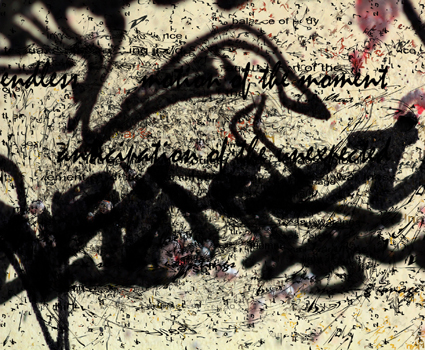
Brigid Burke, seensound
courtesy the artists
Brigid Burke, seensound
seensound: visual/music, Loop Bar
Seensound, curated by Brigid Burke, is an ongoing series exploring visual music, the aesthetic translation of music into colour and light and vice versa. The next event features performances and screenings by Ros Bandt, Warren Burt, David Kim-Bolye, Elaine Thomazi Fritas/Johnathan F.Lee, Roger Alsop, Mark Pedersen and Burke herself.
seensound: visual/music , LOOP back room, Melbourne, 24 Nov; http://seensound.com
the NOW now 2014 Launch
In preparation for the always epic and enjoyable Now Now Festival in January (8-12), there’ll be the annual free program launch party featuring Robbie Avenaim & Martin Ng, Horse MacGyver, M.O.B., Lucas Abela and Pollen Trio. As always, much to enjoy and a little bit of everything for everyone.
Now Now 2014 Launch, The Red Rattler Theatre, 4 Dec; http://thenownow.net/
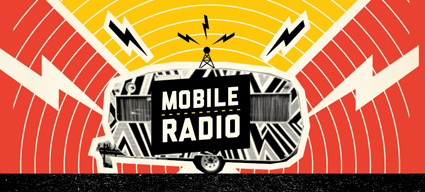
Mobile Radio, Big West Festival
Big West Festival, Footscray
Celebrating community and creativity in Melbourne’s western suburbs, the biennial Big West Festival is about to kick off. There are 65 events, many of them free, promising to be “radical & spectacular.” One of the feature programs is Mobile Radio, headed up by sound art duo Madeleine Flynn and Tim Humphrey, in which the Mobile Radio will land in different locations in the area. People are invited to book a slot on air, which will be webcast and transmitted on 99.9MHz. The team has been conducting workshops with the community for the last month on how to present their ideas, and they’re ready to broadcast!
Big West Festival, Footscray, 22 Nov-1 Dec; http://www.bigwest.com.au/; http://www.mobileradiobigwest.com/
FILM
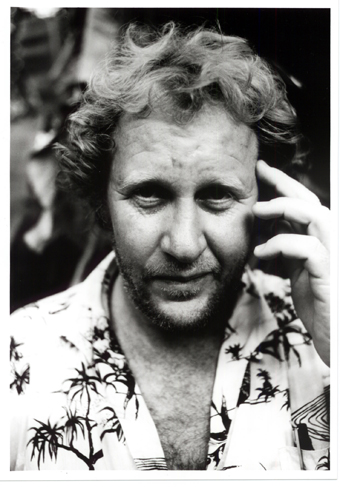
Dennis O’Rourke (1988), during the making of Cannibal Tours, released as free content with permission of Dennis O’Rourke, photo Chris Owen & Camerawork Pty Ltd
Dennis O’Rourke Memorial
In his obituary for documentary filmmaker Dennis O’Rourke in RT116, Dan Edwards wrote “Provocative, emotional and fiercely intelligent, O’Rourke was always worth listening to—and always worth watching. With his death on June 15, Australia lost one of its most incisive and imaginative documentarians.” (http://www.realtimearts.net/article/116/11250) To honour and celebrate O’Rourke’s life and work, Ozdox, the Australian Documentary Forum will be hosting an industry memorial at the Chauvel Cinema, Sydney.
Dennis O’Rourke Memorial, Chauvel Cinema, Paddington, 7 Dec (RSVPs by 6 Dec); http://www.ozdox.org/events/dennis-orourke-memorial/
Fallout, Lawrence Johnston
Sydney audiences will be treated to a special cinema season of Fallout, a new documentary by Lawrence Johnston. The doco goes behind the scenes of the making of the Hollywood film On the Beach, which brought Gregory Peck and Ava Gardner to Australia for the filming. On the Beach, based on the book by Neville Shute, had a sobering anti-nuclear message but writer and film director Stanley Kramer soon began to see issues differently. Check out the trailer here.
Fallout, director Lawrence Johnston, producer Peter Kaufmann, Dendy Newton, from 5 Dec.
Still in the loop
Dance Clan 3, Bangarra Dance Theatre
20 Nov-1 Dec
http://www.bangarra.com.au/
Corroboree, various venues Sydney, 14-24 Nov
http://www.corroboreesydney.com.au/
born in darkness before dawn, Nicole Foreshew
City of Sydney, Place Projections, Australian Museum
19 Nov-20 Jan
http://www.cityartsydney.com.au/cityart/projects/PlaceProjections.asp
string theory: focus on contemporary Australian art, PICA
16 Nov 2013 – 5 Jan 2014
http://www.pica.org.au/view/string+theory/1744/
Karen Casey, Dream Zone, FAC
23 Nov 2013-19 Jan 2014
http://fac.org.au/
The Adventures of Namakili & I Am Man, Brown’s Mart & New Blak Territory
Brown’s Mart; 19-30 Nov
http://brownsmart.com.au/events/new-blak-territory-adventures-namakili-i-am-man
The Changing Standards of Dialogue, Other Projects, Metro Arts
3-30 Nov, Artist talks 20 Nov
http://www.metroarts.com.au/
ANTI–MUSIC: 1979–1983, Pestorius Sweeney House
30 Oct—13 Dec 2013
http://www.davidpestorius.com
Tiny Stadiums, PACT
2-23 Nov
http://www.pact.net.au/2013/10/tiny-stadiums-2013
This is a Door, Pop-Up Playground
Theatreworks and various venues, St Kilda and Melbourne City
Oct 31-1 Dec
http://popupplayground.com.au/this-is-a-door-2013/
Wagnerlicht, Arts Centre Melbourne
15 Nov-14 Dec
http://wagnerlicht.com
La Boite Indie: R & J
La Boite Roundhouse Theatre, Brisbane
13- 30 Nov
http://www.laboite.com.au/cms/page.asp?ID=21
Standing Bird Two, Verge, The Blue Room
13-30 Nov
http://blueroom.org.au/
Trace Recordings UTS Gallery
until 29 November
http://www.art.uts.edu.au/gallery/current/index.html; http://www.tracerecordings.net/
Performa, NY
various venues New York City
1-24 Nov
http://13.performa-arts.org/
My Avant-Garde Is Bigger Than Yours, Kings ARI
1-23 Nov 2013
http://www.kingsartistrun.com.au/
Crash Course, James Berlyn
PICA, 14-30 Nov
http://www.pica.org.au/view/Crash+Course/1745/
[CTRL][P] Objects on Demand, Object Gallery
15 Oct 2013 – 25 Jan 2014
http://www.object.com.au/exhibitions-events/entry/ctrl_p_objects_on_demand/; http://ctrlp.com.au/
Lorraine Heller-Nicholas, Love Story, Videobrasil
Southern Panoramas, 6 Nov-2 Feb
http://site.videobrasil.org.br/festival/arquivo/festival/programa/1589140
Daniele Puppi 432 Hertz, Cinema Rianimato e Dintorni, AEAF
1 Nov-7 Dec
http://www.aeaf.org.au/exhibitions/danielepuppi.html
Simple Forces, Joyce Hinterding
BreenSpace
25 Oct-23 Nov
http://www.breenspace.com/
Reinventing the Wheel: the Readymade Century
MUMA
3 Oct-14 Dec
http://www.monash.edu.au/muma/exhibitions/upcoming/readymade.html
Bogong ELECTRIC
Bogong Village, North East Victoria
1 Nov-1 Dec
http://bogongsound.com.au/
RealTime issue #117 Oct-Nov 2013 pg. web
© RealTime ; for permission to reproduce apply to realtime@realtimearts.net
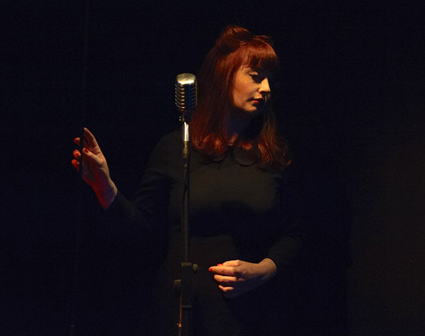
Rachael Dease, City of Shadows, Malthouse’ Helium program
photo Sarah Walker
Rachael Dease, City of Shadows, Malthouse’ Helium program
The 2008 rock documentary Something in the Water by Aidan O’Bryan suggested something elemental makes such a small city so musically productive. What’s particularly interesting about the Perth music scene is not just the number of high calibre bands and musicians that emerge from it but the fluidity with which these artists move between genres and musical scenes. Composer-musician-director Rachael Dease is a perfect example of this.
Since graduating with a Bachelor of Performing Arts (Music) from WAAPA (perhaps some of that secret watery ingredient comes from the quality of music education in Perth) Dease has been active on the Perth pop scene as a solo artist and in the band Schvendes, her versatility becoming evident when she won both the the WAM Pop Song of the Year and Experimental Song of the Year in 2010. She’s also been involved in contemporary classical music and theatre worlds creating soundtracks and performing live in a number of successful stage productions. Most recently she has created her own music theatre work, City of Shadows, taking the 2012 Perth Fringe World by storm (winning the Western Power Martin Sims Award for Best Overall Performance for Best Musical Work). The work has since enjoyed an encore season at Fringe World 2013, toured to the New York Fringe and was part of Malthouse’s Helium season.
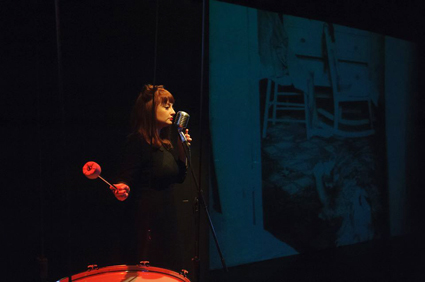
Rachael Dease, City of Shadows, Malthouse’ Helium program
photo Sarah Walker
Rachael Dease, City of Shadows, Malthouse’ Helium program
Accidental performer
I asked Dease why she thinks Perth musicians are so adaptable. “A lot of us with different backgrounds or different disciplines associate socially, so we sometimes come up with concepts that we wouldn’t if we were living anywhere else…I think that a lot of us want to branch out a little bit and there isn’t as much dedicated work for specific disciplines here, so composers here do tend to actually write quite well for dance and theatre and film, whereas those might be more niche areas in larger cities.”
Perhaps the most surprising thing about Dease’s current career is that she never really considered herself a singer or performer. “At first I would have liked to have done more film work. That was the dream of the young artist me. I think that’s why I’m drawn to theatre—the magic that happens there. But I never set out to be a performer by any means. I wanted to compose for other people. I’m pretty much an untrained singer so I didn’t think I had a real right to be on the stage. [But] it happened and I was there and it worked. I found I had something I didn’t realise I had and since then I’ve been using that in my work.”
Dease started her involvement with theatre when she was invited to create the score and perform live in Matthew Lutton’s acclaimed Antigone (see RT90). Subsequently she was invited to collaborate on It’s Dark Outside, the puppetry and illusion-based theatre work presented by Perth Theatre Company which has since toured nationally and internationally, (RT109, RT113.) Dease says that the collaboration with the show’s creators, Arielle Gray, Chris Isaacs and Tim Watts, was something “that came about really organically. They heard some of my songs and came up to me at a Fringe gig and said let’s start working together and that really pushed me in a new direction.”
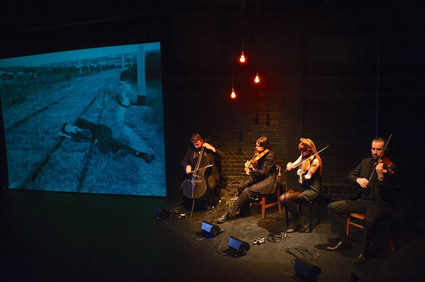
Tristen Parr, Aaron Wyatt, Hayley-Jane Ayres, Brian J Kruger, City of Shadows, Malthouse’ Helium program
photo Sarah Walker
Tristen Parr, Aaron Wyatt, Hayley-Jane Ayres, Brian J Kruger, City of Shadows, Malthouse’ Helium program
Out of the shadows
That new direction resulted in Dease having the confidence to create her own music theatre show, City of Shadows, which premiered at the 2012 Perth Fringe World. The piece is an intimate song cycle performed by Dease and a string quartet, inspired by the collection of forensic photographs held by the Justice and Police Museum (the same archive well deployed by Ross Gibson and Kate Richards in their media art work, Life After Wartime, RT34, RT80). Dease was shocked at how well the work was received. When the offers started coming in she had to decide whether she thought this quite personal work, which she describes as “an exorcism” of sorts, was something she felt comfortable continuing. “I was very concerned when we premiered the piece in Perth that people wouldn’t understand that I was in no way wanting to exploit these images or use them to gain anything in any other way than to project a message. I guess I felt safe doing that in Perth because I had a reputation here and people understand that that’s not the kind of artist I am. But then all of sudden I got offers to take it to New York and then Melbourne—I don’t have that [reputation] there and I was concerned. But to my complete joy, 99% of people have understood what it is about.”
Accompanied by the highly evocative images, the cycle has a loose interlinking narrative but features separate sections that Dease says focus on “particular victims or particular perpetrators. And there’s a whole section largely dedicated to the detectives themselves.” Dease chose to accompany herself with a string quartet (Brian J Kruger, Hayley-Jane Ayres, Aaron Wyatt, Tristen Parr). “I write for strings quite a lot so it was something I could rely on, that this particular sound was going to suit these images. As a lot of it is largely improvised with the strings, I knew the performers that I wanted and I knew they’d interpret these notes and songs and these images the way I wanted them to.”
In City of Shadows Dease realised she’d slipped into another role she’d never really planned, that of director. So to investigate this further she applied for The Besen Associate Artist Program at Malthouse Theatre, Melbourne undertaking a one month residency in July 2013. She split her attention between working “with Jethro Woodward in sound design, Matthew Lutton in directing and David Chisholm in composition. So I got more of a handle on that style of communication between professionals and how music can sit live and pre-recorded in a theatre setting and how a director deals with those kinds of things.”
(Listen to City of Shadows here
Watch City of Shadows trailer here.)
Keeping her ear in
While Dease has been working in theatre she hasn’t neglected her compositional skills in “art music.” Her impressive 40-minute composition 4 part history (listen here), was part of the site-specific sound installations Dialogues with Landscape, commissioned by 2011 Perth International Art Festival and the UWA Cultural Precinct. She’s also just completed a commission for Perth new music ensemble Decibel. Dease comments, “I would like to do a few of those kinds of works a year. I think they push me in a different direction and make me think more about things, especially when I’m given an instrumentation (not choosing one); that really makes me work hard for it and I really enjoy it in the end.”
But it does seem that the lure of the theatre is becoming stronger. Dease is currently thinking about a new show that will take one of the characters from City of Shadows and continue her story. “I think I’m definitely going down the path of using songs in interesting ways in theatre. I’m still trying to explore that and figuring out the best way it can be done.” She feels that collaboration is a real key and that she needs to seek more of this interstate. “As much as I really love working in Perth, I’ll have to continue to duck out, almost on a monthly basis. I enjoy meeting new people and bouncing new ideas [around]. For someone who burrows themselves away in their cave some times, it’s nice to have that feeling of creative unity with another artist.”
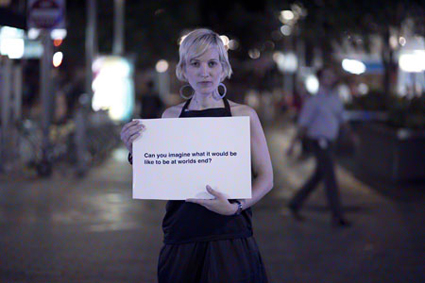
Sarah-Mace Dennis, Do you protest in silence (work in development)
courtesy the artist
Sarah-Mace Dennis, Do you protest in silence (work in development)
Histories, ghosts and memory are consistent themes throughout Sarah-Mace Dennis’ interdisciplinary practice, involving text, photomedia, performance and video. I first came across Dennis’ work in 2004 when she was collaborating with Svenja Kratz on a series of projects inspired by the historic goldmining town Hill End in regional NSW.
A story of infanticide and suicide, To Rose (my Love) (2004-5), was an interactive video installation in which the viewer’s shadow falling on the screen in the gallery revealed ghosts hidden within the image. The culmination of the series was the hypermedia work Di.O.ram.a: Constructing a Virtual Memory (2007), a journey of image and text uncovering real and imagined stories from the town circa 1872. These early works were impressive for their blending of both real and imagined histories and their technically ambitious formats.
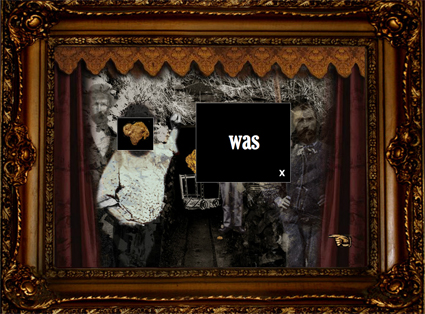
Sarah-Mace Dennis & Svenja Kratz, Di.O.ram.a: Constructing a Virtual Memory (2007)
courtesy the artists
Sarah-Mace Dennis & Svenja Kratz, Di.O.ram.a: Constructing a Virtual Memory (2007)
Shared histories, public memories
Dennis’ most recent work continues these earlier preoccupations but on a much larger scale, thanks to a series of public art commissions. The first of these was Moving over the shoreline, commissioned by art+place (2007-2012), the body responsible for managing the funds raised from compulsory cultural contributions levied on new commercial building development projects in Brisbane. Moving over the shoreline is a two screen, permanent video projection on the façade of the Queensland Multicultural Centre, drawing on historic and contemporary stories about immigration and particularly inspired by Yunguba House, the Brisbane immigration depot in the 19th and 20th centuries.
Dennis interviewed people who had lived at the depot when they first arrived in Australia, as well as more recent immigrants. She also worked with local ethnic dance groups. She says, “I decided I was going to work with ethnic dance groups which might have been a strange decision [for a contemporary art project] but it made complete sense to me because I used to be a Scottish dancer and I know how those traditional dance forms are punctuated by narratives that belong to the traditions. I also wanted to have some Indigenous representation in the work, so I was really lucky to be connected with the dance group Nunukul Yuggera. I only really controlled [the shape of the work] or scripted it from colonisation onwards; so I told the group how my work was evolving across the two screens and then we worked together on how they wanted their story to be told in that.”
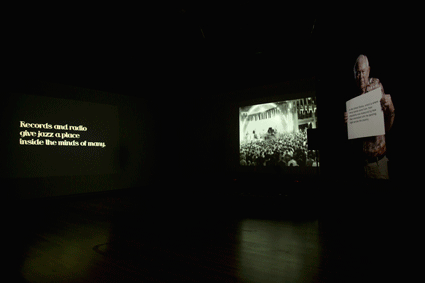
Sarah-Mace Dennis Sounds from the Emergent State, commissioned by the State Library of Queensland for the exhibition Live! Queensland Band Culture.
courtesy the artist
Sarah-Mace Dennis Sounds from the Emergent State, commissioned by the State Library of Queensland for the exhibition Live! Queensland Band Culture.
Dennis’ most recent commission is her most ambitious to date. For the State Library of Queensland’s exhibition Live! Queensland Band Culture, Dennis created the six-channel video installation Sounds from the Emergent State. For this exploration of the relationship between music, politics and social and cultural change in Queensland from WWII to the end of the 90s, Dennis used archival footage and interviews with people from the music industry, also getting them to ‘perform’ their responses in the style of Bob Dylan’s “Subterranean Homesick Blues.” She explains, “Queensland is so amazing in terms of music I did feel overwhelmed at first. I thought I can’t possibly tell this story myself, it’s the story of all these amazing musicians who’ve lived in this state. I wanted them to perform in the work because I wanted to acknowledge the people who’ve been working so hard and making those contributions behind the scenes.”
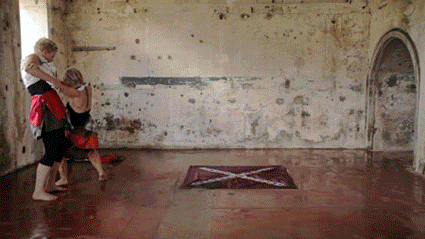
Sarah-Mace Dennis, Mondo Ghilles (2010)
courtesy the artist
Sarah-Mace Dennis, Mondo Ghilles (2010)
Personal histories, embodied rememberings
In terms of the way these stories unfold Dennis believes, “the best way to tell history is by dispersing it across multiple frames, fragmenting it so that viewers are getting traces and they’re putting it back together through their own bodies, by the way they move through things or the way they connect things perceptually.”
Dennis knows first hand what it’s like to piece fragments of history, her own history, back together. In 2008 she was involved in a car accident resulting in a severe brain injury. After time in a coma, she awoke paralysed and with amnesia. Over an intensive period of rehabilitation she regained the use of her faculties and she has made several works that explore this experience of re-embodying and re-discovering her “self.”
For the 2010 Next Wave festival Dennis was commissioned to make a dance film for Nat Curiso’s Private Dances. As part of her rehabilitation, Dennis went back to Scottish dancing (at 15 she’d been competing at championship level). Mondo Ghillies mixes this form with a kind of Vivienne Westwood baroque punk visual aesthetic resulting in a haunting short film. “Mondo Ghillies was about developing my film practice at the time and experimenting with dance film. But in that project I was still very inside the experience. It’s still dealing with the trauma of waking up and being paralysed and not being about to think as you used to.”
Dennis’ Swallow, currently in development, offers a different perspective on the experience. “Since Mondo Ghillies I have done a lot of writing about the event, so Swallow is from a [more reflective] position. The work has multiple characters that I play myself. The idea is that these are really ghosts of myself that I became during my recovery. With a brain injury you go through these really remarkable changes where you think, ‘My brain is functioning again, I’m back to normal.’ But it’s a little bit like the feeling I had when I was a teenager when I thought, ‘Now I’m grown up.’ A year later I looked back and went, ‘Wow, I just didn’t know anything then’…The work really is reflecting on what it means to be a person with no brain, how that challenges your perceptual frameworks and your identity—how you even come to comprehend existence.” Heath Ledger also has a ghostly cameo: Dennis, while in her coma, seemed to absorb the news of the actor’s death, knowing this fact on waking.
Dennis has also written extensively on these experiences as part of her Masters in film theatre and media (UNSW, 2013); she’s currently completing a text for which she’s keen to find a publisher. I asked her about the relationship she sees between her writing and her moving image work, which is often more corporeally based. She explains, “I trained in creative arts, majoring in writing, contemporary visual art and theory—so that’s very much how I approach my work, through these intersecting mediums. I think what I’ve always done is begin with a conceptual or philosophical idea and use my practice as a way of exploring that through a form that isn’t language, because you can’t do everything with writing…[then] I write about that at the end [of the process], in this ficto-critical way where I’m using the story of my experience of making the work to talk about how it’s changed or extended the conceptual idea or theoretical idea that I’ve been thinking about.”
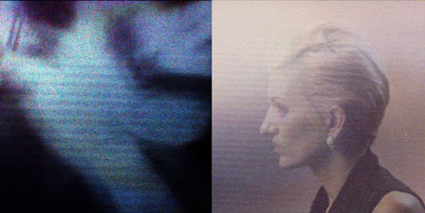
Sarah-Mace Dennis, Swallow (currently in development)
courtesy the artist
Sarah-Mace Dennis, Swallow (currently in development)
Art and social responsibilities
As well as Swallow, Dennis is working on a large-scale video project, Do you protest in silence?, which indicates a shift of focus from historical to contemporary social reflection. Through her experiences making Sounds from the Emergent State, Dennis has become increasingly interested in how music and art inspire social change. She has recently moved to London via New York where she met up with filmmaker Antonino D’Ambrosio whose recent documentary Let Fury have the Hour explores how artists can elicit “creative responses” from people that dramatically effect culture as a whole. Dennis hopes to continue her dialogue with D’Ambrosio as she works on her video project.
In a follow-up email Sarah-Mace Dennis writes, “I think being outside of Australia has been quite important. Being in a new place has given me more courage to find my voice on bigger issues that affect the world on a global level… [Do you protest in silence?] is still about consciousness and the brain, but it is also about how creative ideas really have the potential to affect the way we think about and live in the world.”
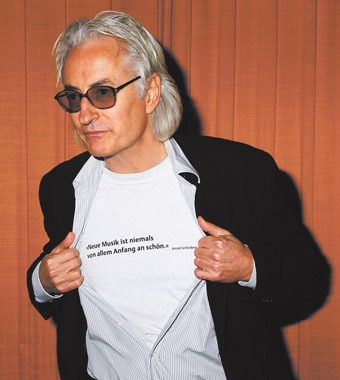
Jon Rose, “Neue Musik ist niemals von allem Angfang an Schön” (New music is never very nice at the beginning)
Jon Rose is perhaps one of the most prolific composer/musicians in Australia and thus appraisals of his deeds (and also his words) have often appeared in RealTime.
When Rose was announced as winner of the 2012 Australia Council Don Banks award, we filmed a conversation between him and improvisor and friend Jim Denley, offering an overview of his career, briefly summarised here:
“As well as being a consummate violinist and versatile improviser, [Jon Rose] has made a multitude of instruments and has also created many radio works. Most recently he has been exploring interactive music making experiences in works such as Pursuit, using musical bicycles (see RT90; RT96), an interactive netball game, Team Music! (RT96); and the multi-user festival hit The Ball project (RT102).
“Rose has also embraced the Australian landscape, evidenced in his Great Fences of Australia project undertaken with his partner, violinist Hollis Taylor, which saw the couple travelling across the outback playing and recording the sounds of Australia’s many fences. This journey is beautifully documented in a book by Taylor called Post Impressions (see RT82). Another epic adventure was the Ad Lib Project, an extensive archive of weird and wonderful music-making activities from around the nation, housed on the ABC’s website. It perhaps best illustrates Rose’s conflicted love for this country and its curious history which he enticingly articulated in his 2008 Peggy Glanville-Hicks address (RT83).” (Full article RT108)
Since that interview, more proof of his indefatigability, Rose has written a Currency Press Platform Paper on the place of live music in Australia (RT116), released a box set of a significant selection of his works, Rosin (RT115), mounted a collaborative tour with young improvising musicians to the Corner Country of NSW (RT112) and shared his wisdom with new music group Atticus (RT111). Most recently he’s been turning bicycles into musical instruments in the largest version of his Pursuit project to date as part of the Canberra100 celebrations, an account of which he shares with us in our 20 Nov edition (link).
Jon Rose will perform as a soloist with the Adelaide Symphony Orchestra in Program 1, March 9, of Tectonics Adelaide, curated and conducted by Ilan Volkov, in the 2014 Adelaide Festival (see the festival preview in RT119).
Overviews
RealTime TV: Composer Profile, Jon Rose
In conversation with Jim Denley
RealTime issue #108 April-May 2012 web
Jon Rose: Australia Made Extraordinary
Jim Denley Talks With Jon Rose, Don Banks Music Award Winner 2012
RealTime issue #108 April-May 2012 p34-35
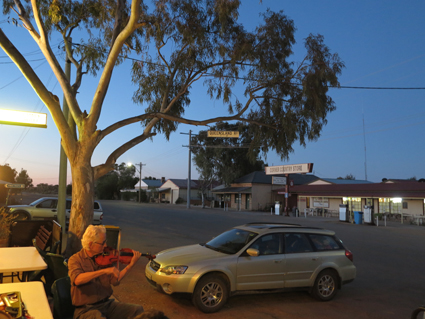
Jon Rose in Tibooburra
photo Lucas Abela
Jon Rose in Tibooburra
Music articles & reviews
Jon Rose, Rosin
Chris Reid, CD review
RealTime issue #115 June-July 2013 p46
On the road with Rose
Rishin Singh: Jon Rose’s Sound Circus
RealTime issue #112 Dec-Jan 2012 p42
No Strings Attached
Simon Charles: Jon Rose, Atticus & Guests: Metapraxis
RealTime issue #111 Oct-Nov 2012 p48
The sound of bicycles singing
Shannon O’neill: Jon Rose & Robin Fox, Pursuit
RealTime issue #90 April-May 2009 p48
Looping & shimmering
Andrew Harper: MONA FOMA Festival of Art & Music, Hobart
RealTime issue #96 April-May 2010 p40
New music: challenge as fun
Matthew Lorenzon, Mona Foma, Hobart
RealTime issue #102 April-May 2011 p5
Vigorous exercise & a well-balanced diet
Gail Priest: The Now Now Festival 2010
RealTime issue #96 April-May 2010 p39
The shame of growing old gracefully
Gail Priest: What Is Music? Sydney
RealTime issue #94 Dec-Jan 2009
Making instruments, ears, audiences
Gail Priest surveys the issues and events of the REV festival
RealTime issue #49 June-July 2002 online exlusive
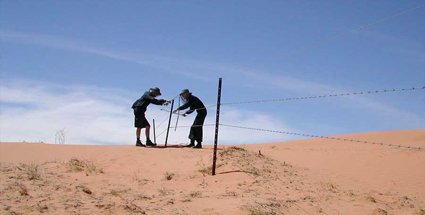
Jon Rose & Hollis Taylor, play a fence in the Strzelecki
Writings
Sound, Speed, Rust and Re-cycling
Jon Rose: an account of The Canberra Pursuit
RealTime issue #116 Aug-Sept 2013 web
Past reclamations, future provocations
Julian Knowles, Jon Rose’s The Music of Place: Reclaiming a Practice
RealTime issue #116 Aug-Sept 2013 p48
Music denied a voice
Jon Rose, City Conversation 2013, City of Sydney, 26 June
RealTime issue #115 June-July 2013 web
Post impressions
Hollis Taylor’s book about an epic fence-playing journey
RealTime issue #82 Dec-Jan 2007 p40
Listening to history
Jon Rose’s 2007 Peggy Glanville-Hicks Address
RealTime issue #83 Feb-March 2008 p46
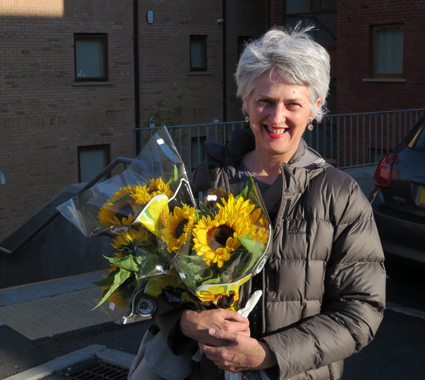
Anne Thompson
Bio
Anne Thompson has been a contemporary dancer, choreographer, tertiary level teacher, journal editor, academic, reviewer of dance with RealTime, dramaturg and director, primarily in visual and physical theatre with independent artists and small companies (Terrapin, Snuff Puppets, My Darling Patricia). She was a founding member of Dance Works and one of the founding editors of Writings On Dance. She has had an ongoing dramaturgical relationship with Garry Stewart and Daniel Jaber of Australian Dance Theatre as a dramaturg. In 2001 she co-founded the Eleventh Hour Theatre project in Melbourne with William Henderson. In 2008 they presented their version of Beckett’s End Game at the Melbourne International Festival and in 2010 their version of Shakespeare’s King John at the Adelaide Festival. Both were award-winners. In 2008 Thompson was appointed Director of the Drama Centre at Flinders University where she teaches directing in the program.
Anne writes: I love teaching. I like workshopping physical experiences and ideas with people. I like seeing how ideas and experiences sit with people and what they make them do. I have always found ideas and physical experiences liberating. Both can lead me to fresh thinking and a sense of rightness with myself and the world. I don’t dance much anymore but it still makes me happy when I do. I like being this age. I’ve done a lot of things in the performing arts and I am so much more relaxed doing any of them now. I’ve always pursued the experimental—the experiment of performance. I like examining performance and throwing caution to the wind. When I realised at 19 it was possible to interrogate performance I was excited. It made me realise it was possible to interrogate the performance in, and of, one’s life, though that realisation wasn’t so conscious at the time. I’ve never lost that. I have had so much fun interrogating performance with other people.
Exposé
I like writing about dance/performance because it makes me keep considering what artists are attempting and doing. I like to be respectful of that enterprise. I know as an artist and teacher it can be incredibly powerful to give people a way of describing experience. It can settle disquiet and liberate possibilities. When I review I like to honour the work artists do, attempt to describe that work and the action of that work on me. I am very committed to presenting the largest possible picture of what art can be and how it is occurring. I have always loved RealTime for presenting that. I started wanting to write about women and performance because I have many close, great relationships with women working in the field, many of whom are a lot younger than me. Graduates from the course in which I teach would ring me up and need to debrief about something that had happened to them. I wanted them to understand that what was happening was part of a bigger conversation so I set up a number of support groups where women working in performance could meet and talk and then I thought ‘why not make the conversation national?’
* * *
Anne is currently writing a series of articles titled Women + Performance for RealTime, with the intention of later compiling a book with other writers and RealTime on the current generation of women in Australian performing arts.
Women + Performance 1: Tessa Leong & Emma Beech
RealTime issue #115 June-July 2013 p38-39
Women + Performance 2: Anne-Louise Sarks
RealTime issue #116 Aug-Sept 2013 p6
Women + Performance 4: Kate Davis & Emma Valente, The Rabble
RealTime issue #117 Oct-Nov 2013 p28
See also her review of Leigh Warren's Not According to Plan in this e-dition
Coming up in RT118: An interview with POST prior to their 2014 Sydney Festival production for Belvoir, Oedipus Schmoedipus.
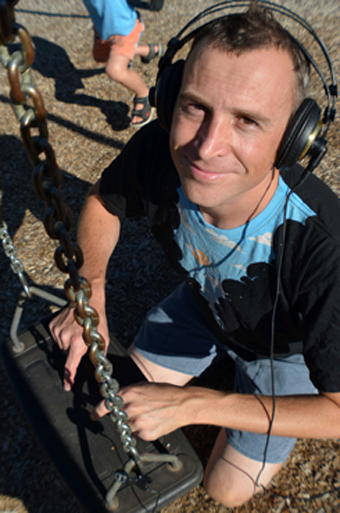
Jason Richardson
photo Jo Roberts
Jason Richardson
To honour the centenary of Leeton, musician and composer Jason Richardson (aka Bassling) decided a sonic celebration was in order. Fitting the swings, roundabouts and slippery dips of all the local playgrounds with microphones he made recordings that he then arranged into an EP of ambient dance music. He also captured video of the “instruments” in action and has created a suite of audiovisual pieces which have since been exhibited by the Albury Regional Art Gallery and screened outdoors around the local area.
Originally from Canberra, Richardson moved to the Wagga region around 13 years ago and is now based in Leeton. He’d played bass in bands that were more on the rock and roll spectrum, but as home studios became more affordable and digital tools began to dominate he made the transition to electronic music. While this shift to a more self-contained music-making was reasonably compatible with the move to a regional area it also meant that his network became smaller, so he turned to the virtual world for inspiration, connection and distribution.
Virtual mixes
Richardson credits the ubiquity of music on the internet as a significant factor in his move towards more experimental realms of music production, providing him with what he describes (via an email interview) as “the history of recorded music at my fingertips…Levi-Strauss’ notion of bricolage has been a key influence. It underpins my interest in remixing, the creative constraint that you use whatever materials are available. I was introduced to remixing through the forum attached to the Ninja Tune website. That community, a decade or so ago, organised remix competitions and I learned a lot from listening to how different producers approached the collection of audio samples taken from a song.” For example Richardson was a significant contributor to the Oceandrift project by the 64 Bars Music Collective, a chain in which one musician posted a track that was remixed by a second artist. The third artist remixed the second contribution and so on, like a musical Chinese Whispers. (Listen to Oceandrift here)
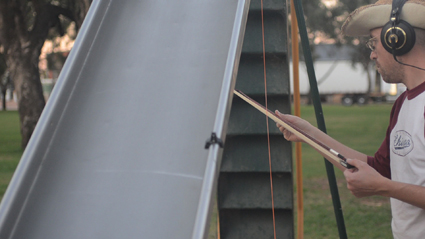
Jason Richardson bowing the slide at Waipukurau Park
courtesy the artist
Jason Richardson bowing the slide at Waipukurau Park
Real vibrations
Back in the real world, a major influence was the Wagga Space Program which ran the Unsound Festivals in the early to mid-2000s and consolidated Richardson’s interest in field recordings (see RT64; RT76). “The Space Program had a cool philosophy that being based in regional Australia was a key part of their sound. That made a lot of sense to me when I started remixing field recordings. I was fortunate to work with Alan Lamb [as part of Unsound 2006]. His large-scale Aeolian Harp [which] he calls ‘the wires’ changed the way I listen to sound.
“Lamb also introduced me to piezo contact microphones, which I used to record playgrounds in Leeton. You capture the vibrations directly with these, rather than the vibrations in air captured [by] a microphone’s diaphragm. It’s quite cool to think you’re hearing how something feels. They also can transform a wide variety of objects into instruments. Like the fence near the playground at the end of my street that makes an evil double bass sound when there’s a strong westerly.”
It was the discovery of sounds like this that saw Richardson embarking on the Playground project. “There were a number of ideas it crystallised, like the founding of Leeton which was around the time of Luigi Russolo’s noise manifesto and, because a centenary is a young age for a town, playgrounds seemed appropriate…When I started recording playgrounds the project snowballed. My internet friends told me they couldn’t see where the sounds had originated. So I started collecting video as well as audio.
“When Albury accepted the three-screen adaptation of Ramponi Park [as part of their] urban art program this year, I decided to organise local screenings of the playgrounds [in Leeton] for the conclusion of the centenary. I ran workshops too, collaborating with kids and a local musician who improvised on a 100-year old pipe organ opposite Mountford Park.”
Ramponi Park, exhibited as a three screen installation as part of Albury Regional Art Gallery’s urban art program
Fruity loops
Art Misadventures #3 is another recent project Richardson participated in, curated by Sarah McEwan for Leeton’s Roxy Theatre Art Space. Six local artists were handed a mystery box and had to come up with an artwork based on its contents in just four days. In Richardson’s box were three Red Delicious apples. Of course his first instinct was to stick a microphone on it and record the secret sounds of the fruit and then remix it. Also inspired by graphic novels, he complemented the sound piece with a comic based on a story from “One Thousand and One Nights” featuring three apples.
The project appealed to Richardson because his remixing practice seems to thrive on working within fixed limits and materials. On his blog he says, “When we were brought together for this exhibition I waited a while before taking a numbered seat, taking one that was left next to my partner. When we were encouraged to select the package holding our inspiration, I waited until others had chosen theirs and I think this strategy served me well. Brian Eno says the first part of any project is scoping the constraints, establishing the parameters as much as the resources available.” (Hear the Apple Remix here)
Think local, go global
While there might be constraints on the size of a local audience in the real world, thanks to free internet tools such as Soundcloud, YouTube and blogging sites, Richardson has been very proactive in seeking national and international ways to be heard. I suggested that he is very good at documenting his work and he responded, “What you call documentation is expression for me. I don’t capture my work to acquit a grant, I do it to interact with an online community because it’s a bigger and more responsive audience.”
Richardson’s next two projects illustrate this balance between local/global, real world/virtual output. For Re-imagining the Murrumbidgee, an exhibition in Leeton produced by Western Riverina Arts and the Murrumbidgee Catchment Management Authority he will create a soundtrack of field recordings of the river composed to “create a sense of the ‘big waters’ and how far they travel through agricultural exports.” Then for his international community he’s instigated another remix chain, as a follow up to the Oceandrift project, keen to garner global responses.
Richardson willingly admits there are advantages to working in the country. “One key benefit of working in a regional context is opportunity. People talk about the lack of things, but it can be a good. My ability to produce work is greatly assisted by not having to negotiate a city each day. It frees [up] a lot of time, reduces stress and my thoughts aren’t interrupted as often by marketing too.”
Most importantly it’s the environment itself that feeds Jason Richardson’s ways of working and listening. “Alan Lamb’s work can only really exist in a regional context. The interplay between the surrounding sounds like birdsong and his wires really captivated me…I was a musician before I moved to regional NSW, but being here has opened my ears to the landscape.”
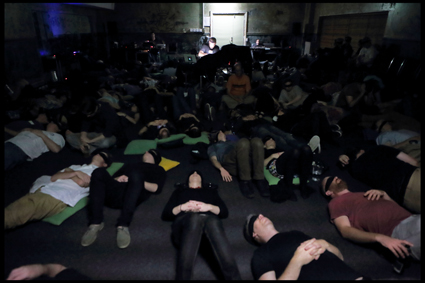
Francisco López, Open Frame
photo Lawrence English
Francisco López, Open Frame
Noise comes in many flavours—mathematical, aesthetic, seductively transgressive, coolly liberating, unwanted and annoying. For this year’s open frame series from room40 we find “The Future is Noise,” a snappy title that mashes together two classics of the noise-in-music literature: Luigi Russolo’s prophetic The Art of Noises (1913) and John Cage’s astute The Future of Music (1937).
Noise has been around in music for a long time (dogs barked out a hit version of Jingle Bell’s in the 1950s), so maybe the future is just more of the same. I struggled to see how some of the artists on the 2013 Open Frame program could be shoehorned into a sensible framework that either referenced past visions of noise or projected into some increasingly noisy future. Nonetheless, across three nights in September great work was to be heard, and that great work was from Spain’s Francisco López.
López is a master of sounds jemmied away from their source to be heard in and of themselves. As he puts it “I believe in the possibility of a profound, pure, ‘blind’ listening of sounds, freed (as much as possible) of procedural, contextual or intentional levels of reference.” This is the tradition of acousmatic sound, where all the meanings attributed to a sound come through the sound alone, with no visual or other perceptual linkage. It’s the oracular voice from behind the curtain and the hurry-up of the horn from the cab in the street outside.
For López, though, it is around the fire at night and an unexpected crack of twig outside the circle of light. Everyone goes quiet, heads turn in the direction the sound came from, then are held still, waiting. Bodies shift, ready for action and vision relaxes. Listening is all. There is another crack, the sound of a heavy foot slowly and carefully pressing down on a large dry twig, then another and another, faster and faster, closer and closer …
The López concert, or as he calls it, “our little ceremony,” begins with everyone blindfolded and lying in a circle, heads to the centre, feet to the rim, speakers all around. López stands unseen in the middle, controlling the mix. A ceremony, with no celebrant to pull the focus away from…pure sound. This concert, a single work of about 45 minutes (more? I completely lost track of time), is structured into lengthy sections punctuated by silence and (recorded) spoken voice. The sounds are sometimes clearly recognisable, sometimes not, the recording quality always exceptional.
But this is not pure sound in the Cagean sense of isolated sound events arbitrarily sequenced for our detached contemplation. Tonight’s sounds are deliberately and skilfully pulled into an abstract and emotional narrative. It is perhaps López’ background in biology (entomology) that leads to work that seems to compel emotions deeply connected to survival rather than pleasure. We hear a pig-like beast grunting, snuffling and eating something or other. Interesting sound and a bit funny in the way piggy things tend to be. More pigs join the meal and the noise of their biting, grinding and swallowing is relentless and huge, all around as we lie blindfolded on the floor. The implication is clear—if you are on the ground, pigs up close and voraciously eating, then you are being eaten. From a charming funny sound to being eaten alive.
Or as López asks, “why have happiness when you can have intensity?” But how is that intensity possible when the sound is stripped from all and any visual referent? Sound carries with it information about the world. Objects vibrate for a reason, those vibrations travel through the air, bringing their reason for being to the exquisitely sensitive mechanisms of the ears, which then vibrate in sympathy, delivering information about movement, time and space. While those vibrations may be from the rustle of fabric as it drops to the floor, the drip of water after the rain has stopped, or the sound of leaves in the upper branches as the cool change moves in, they may also be the sounds of an unexpected car, a quick gust of wind, the door slamming shut and a suddenly silent child.
These are the sounds of López, sounds of intensity and not comfort. For while vision might show that a knife looks sharp, sound brings the scrape of knife on bone.
Room40, Open Frame, The Future is Noise, Francisco Lopez, Brisbane Powerhouse, 12, 13, 19 Sept
RealTime issue #117 Oct-Nov 2013 pg. web
© Greg Hooper; for permission to reproduce apply to realtime@realtimearts.net
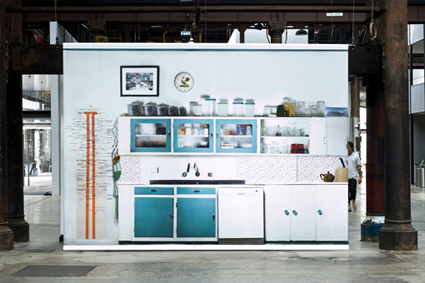
The Ronalds, Habits & Habitats (2010)
courtesy the artists
The Ronalds, Habits & Habitats (2010)
In 2010, Performance Space commissioned the artist duo Ronald & McDonnell to make a work for the cavernous Carriageworks foyer (see RT96). Habits & Habitats comprised a series of large 1:1 scale photographs of interior spaces of an average house in rural NSW, printed on canvas panels hung to intersect the space.However something seemed not quite right, or in fact everything seemed too right, too perfect. There was a clarity and flatness to these banal depictions of rural domestic living that rendered them startlingly vivid, the viewer’s attention drawn to normally unnoticed details. While there was an opportunity for parody here, it wasn’t taken; this work offered rather a sense of serious ethnography.
The curious flatness was achieved by taking hundreds of equidistant close-up photos of elements in the room, identical parameters applied to each shot. The interiors were then pieced back together using Photoshop to form the room-sized panels. This level of painstaking detail and its hyperreal results remain a dominant element in the practice of this duo, now conjugally joined, working simply as The Ronalds.
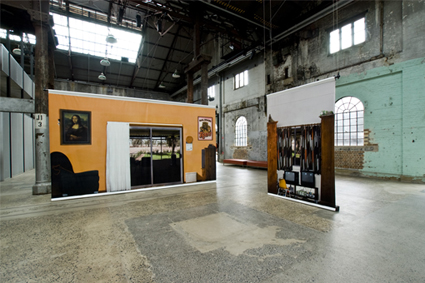
The Ronalds, Habits & Habitats (2010)
courtesy the artists
The Ronalds, Habits & Habitats (2010)
The power of more than one
The Ronalds met when they were both studying Photomedia at Charles Sturt University; it seems their shared aesthetic finds its roots in the lessons learned there. Shannon Ronald says, “We were taught at CSU that one photo was never enough. If you’re going to do anything, especially with a series you’ve got to prove that you can reproduce what you’re doing. So we’ve come up with ideas to make huge series.”
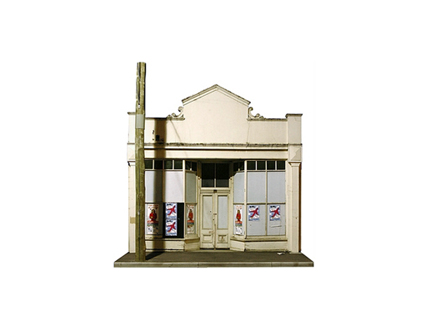
The Ronalds, Microcosm (2005)
courtesy the artists
The Ronalds, Microcosm (2005)
Their first collaborative series was made in Launceston, where the couple moved after they finished university in 2005. In Microcosm they took photos of the facades of buildings that were proposed for heritage listing. The photos were captured at night, on long exposures, to give a unified sense of light and then cut out from the background. Exhibited as small-scale photographs the images have the preciousness of miniatures (something The Ronalds are particularly interested in), emphasising the importance of heritage and preservation.
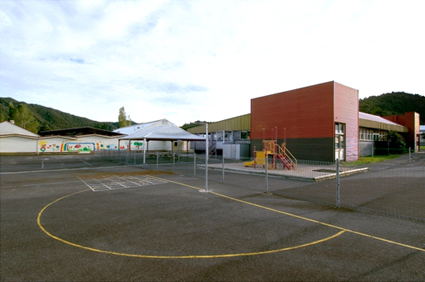
The Ronalds, Queenstown school, Disappearing TASMANIA (2006)
courtesy the artists
The Ronalds, Queenstown school, Disappearing TASMANIA (2006)
The couple then received funding to undertake the Disappearing TASMANIA project where they sought to document towns on the west coast that were in rapid decline. Patrick Ronald explains, “We both started out doing social documentaries and then we moved away from the people. We found that buildings and the things that people created were more interesting to us than going and interviewing someone. We felt that we were imposing. We didn’t really know these people: you’ve only met them for an hour or so and then you’re making judgements about their lives. But in something like Disappearing TASMANIA, we showed these totally empty, pristine classrooms just waiting for kids that probably will never turn up.” The haunting series allows the power of the place and artefact to speak for themselves.
Perhaps not surprisingly, given the exactitude of their processes, statistics often play a large part in their idea generation, and Shannon Ronald suggests this keeps the projects focused. “[We often use] data collection, which is weird but it gives us good reason and when we’re both on track we know what we’ve chosen to take photos of and it all seems to work out. We’ve got the same vision.”
This unified vision is complemented by intersecting skill sets. Patrick describes his skill as being “able to take a million photos exactly the same and Shannon’s being able to Photoshop like a wizard.” Shannon says, “I think the main reason that we work together is that when you’re editing each other, it’s bound to be a better project because you’re not just looking at it yourself and thinking this is a great project. You’ve got to convince someone else first before it goes out to the rest of the world.”
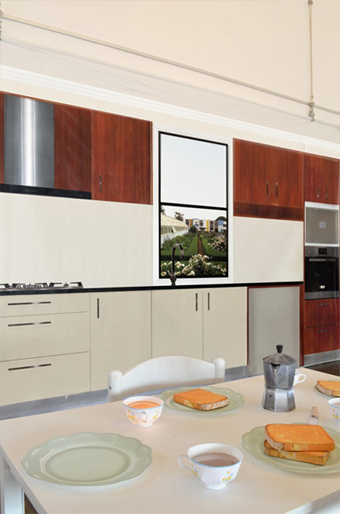
The Ronalds, Roxy Theatre Art Space, Leeton
courtesy the artists
The Ronalds, Roxy Theatre Art Space, Leeton
From flatness to 3D to virtuality
The Ronalds’ latest projects have extended their experiments in recombinatory photographic realism into the third dimension. For their show at the Roxy Art Space in Leeton, they filled the gallery with three-dimensional photographic objects depicting a domestic dining and lounge room. As Shannon Ronald describes it, “The toast isn’t toast, it’s a toast-shaped photograph, and the plate is a plate-shaped photograph.” These are created by taking photos of each facet of an object, laying them out digitally as a flat schematic, then printing, cutting and folding them into object-shaped boxes.
For the Leeton show, they went one step further and “game-ified” the installation. Shannon, a self-confessed Nintendo freak since childhood, created a basic game where the character, Foxy, wanders around the streets of Leeton, the backgrounds borrowed from Streetview. Actions in the game, like pressing a button, activate some of the 3D photographic objects in the space, making them light up thus providing clues to the player as to where to head next in the video game. The whole gallery space was also linked to online viewers, so participants could get involved remotely.
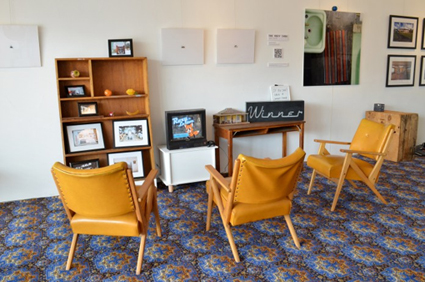
The Ronalds, Roxy Theatre Art Space, Leeton
courtesy the artists
The Ronalds, Roxy Theatre Art Space, Leeton
This online interaction prompted Greg Pritchard (then arts development officer for Western Riverina Arts) to suggest a collaboration between himself and The Ronalds to be presented at Underbelly on Cockatoo Island in Sydney. Titled Virtual Reality, the project connected Underbelly audiences directly with a number of artists in the Riverina district via video streaming and text messages. The audience could interact, ask questions and get the artists to do things for them, with the artists at their beck and call for an eight-hour stint. It was part conversation, part art-reality TV, forging real-time connections between the urban and rural environments.
Keeping it local
The Ronalds’ next project seems like a combination of all their activities to date. Commissioned by the Wagga Wagga Regional Art Gallery to create a work celebrating its 40th birthday, the Ronalds have committed to a three-year project titled In Common. They are planning to make 300-800 miniature photographic sculptures depicting places, objects and structures from the 130 towns in the Riverina/Murrumbidgee region. They will visit all of the towns and have asked residents to nominate and vote on what should be shown. These sculptures will then be installed in the gallery emulating a map of the region, with some game-ification elements. The biggest problem for the artists now is whether they have enough time to make all these objects for the exhibition opening in 2015. The scale of the project is a mark of their commitment to the region and to documenting its true character, before perhaps it disappears.
While The Ronalds did live in Sydney for a while, they realised it suited them best to live in a more rural environment. Patrick Ronald says, “Your upbringing really effects how you become an artist and the issues you talk about. We don’t talk about our own personal lives but I guess we show our lives—this commonality between regional towns. And we’re proud to go and live in these little towns. As photographers we thought what the guys in 1970s in America did was cool, when they got in cars and drove around doing those big road trips. I guess we kind of emulate them in contemporary ways.”
Shannon concurs. “The way that Patrick and I work, I don’t think we’re missing out on anything at all by being out here, except for the fact that my internet’s a bit flat; but other than that I don’t think there’s anything holding us back…Regional people mean a lot to us because they provide us with all of our ideas. And we like it here.”
http://www.theronalds.com.au
RealTime issue #118 Dec-Jan 2013 pg. web
© Gail Priest; for permission to reproduce apply to realtime@realtimearts.net
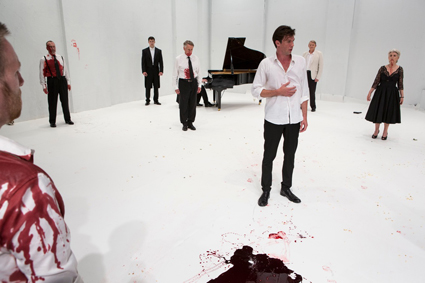
Toby Schmitz and cast of Hamlet, Belvoir
photo Brett Boardman
Toby Schmitz and cast of Hamlet, Belvoir
Harrowed, again. Having recuperated from The Maids, Persona and Angels in America (RT116), ), I found myself sucked into the vortices of madness that are Shakespeare’s Hamlet and Les Harding in John Romeril’s The Floating World in chillingly intimate productions from Belvoir and Griffin.
‘Hamlet mad or not’ has long been a subject of debate, but if ‘seeing things’ is a criterion for treatment then the Simon Stone-Toby Schmitz rendering places the prince firmly in the madhouse. His father’s ghost (Anthony Phelan) is a very palpable presence from the word go, dapperly attired in white dinner jacket, open necked white shirt and black trousers, confronting and later hugging his son and assuming the words of a gone-missing Gravedigger. As ever the stage at the end of Hamlet is littered with bodies poisoned and stabbed, but [spoiler alert] in Stone’s economised version—no sword fight, no suspense, just a kind of reportage, oscillating between then and now—the dead (including Polonius, a dripping Ophelia and the late king) stand about bleeding from their wounds, evoking no less than the Living Dead so beloved of contemporary popular culture. It’s a striking image, if grimly funny, and not altogether legible for those unfamiliar with Shakespeare’s emotionally exhausting, protracted ending.
Nor is it bumping into his father’s ghost that triggers Hamlet’s drive for vengeance. We arrive in the theatre to find him already darkly attired, perched on the edge of a chair in a state of palpable high anxiety—frowning, cheeks flushed, agitated. Blackout. Lights up—Ophelia is already in his lap. Blackout. And off we go. As with the ending, the cutting and pre-determining at the beginning feel reductive and impatient; as does the thinning out of Hamlet’s world. Horatio and others are gone, their functions briefly embodied in an anonymous figure; Laertes is rendered less significant (if finely performed by Thomas Campbell); and no Fortinbras comes to assume power after the self-destructive carnage enacted by this state. Stone’s version of Hamlet transforms it into a brisk chamber play focused overtly on the prince and, as the director did with The Wild Duck, erases the wider world Hamlet inhabits and, with it, complexities of power, role and class. Shakespeare saw the world in larger terms.
Although irritated by Stone’s ‘digest’ of Hamlet, I found enough power in the production and strengths in the performances to make for an often immersive experience. The dark curtained walls, the surrounding rows of functional chairs, a grand piano, the neat rows of designer lighting above with their almost sepia glow over an otherwise empty space, suggested a funeral parlour and, with Hamlet and his father (seated the other side of the room) casually suited, not unlike, say, the seductively smooth black and white ambience of Le Feu Follet, Louis Malle’s 1963 film about a suicidal alcoholic. The stage design evoked a time not quite our own: a not far off past, confirmed with the playing from Erik Satie’s Gnossiennes at the beginning and a countertenor in tails crossing the stage from time to time singing laments from various periods, as if at a soiree. After interval, Hamlet rolls about on an Eames chair, the stage now starkly white—no more darkness, no more secrets.
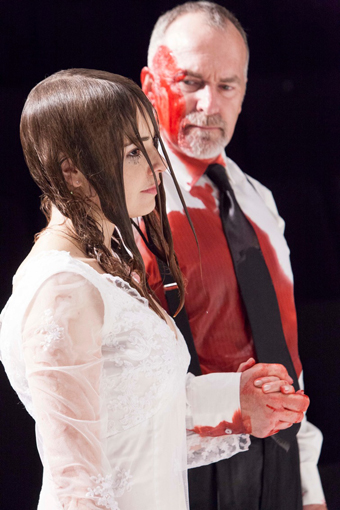
Emily Barclay, Greg Stone, Hamlet, Belvoir
photo Brett Boardman
Emily Barclay, Greg Stone, Hamlet, Belvoir
Schmitz’s Hamlet is equally introvert and extrovert, jokily engaging with the audience, hugging his father’s ghost and openly weeping, leaning over the seating balustrade to deliver “To be or not to be…” directly to us, none too anxiously, while elsewhere flattening the beat in “O that this too, too solid flesh would melt” or breaking the rhythms of lines to suggest an interiority barely in touch with the words he utters. There’s just enough legato to keep the poetry intact and emotionally engaging. Hamlet’s complexity is brought home in Schmitz’s seamless blending of deep-seated despair and indecision—realised not only verbally but with a racking, intense physicality—and wicked calculation played to the audience.
Claudius (John Gaden) in double-breasted suit and Gertrude (Robyn Nevin) in black bejewelled gown come across as an older, more formal generation, their neat, classical diction aptly tested by the anger and anguish that erupts from them in the crises they find themselves as if not believing them to be of their own making. Greg Stone, a not at all elderly, business-like Polonius, deftly, amusingly and movingly delivers his lines as if of a generation between Hamlet and his parents. Emily Barclay’s Ophelia is painfully sweet and therefore all the more victim of Hamlet’s escalating “get thee to a nunnery” rant. Unfortunately the pathos of the mad Ophelia’s (none too tuneful) singing is undercut by atonal piano tinkling.
I was surprised to hear Schmitz’s Hamlet groan as he cradled the dead Ophelia and howl at the play’s bloody climax, as did some of the living dead standing about him who then united in song as Hamlet shook and cried aloud. I know Olivier famously yowled at the end of a production of Oedipus Rex, but I’ve always felt there is enough power in the poetry of Shakespeare to not warrant such additions. Here a bit more silence before (and after) “The rest is silence” would have been welcome. Just prior to the singing, the Ghost had uttered Horatio’s “Goodnight sweet prince” confirming what we sensed from the beginning, that this production of Hamlet was to be a father-son psychodrama in which, above all, Hamlet’s guilt is writ large at the end, on a stage populated by the dead, including Hamlet himself—a veritable purgatory of existential angst. This made for a rather heavy-handed and less than cathartic Hamlet, leaving us bereft of that peculiarly disturbing and comforting Shakespearean dialectic of existential horror on the one hand and a sense on the other of completion, a return to some kind of order, even if flawed. This is a Hamlet well worth seeing, to enjoy and quarrel with.
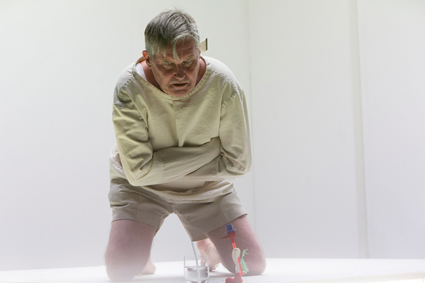
Peter Kowitz, The Floating World, Griffin Theatre Company
photo Brett Boardman
Peter Kowitz, The Floating World, Griffin Theatre Company
The Floating World
In John Romeril’s delirious cabaret of derangement, The Floating World (1974), a World War II Australian soldier who has witnessed first hand the atrocities perpetrated by the Japanese army, is on a Women’s Weekly Cherry Blossom cruise to Japan many years later. Les Harding (Peter Kowitz) is unhappy to be dragged away from the comforts of home but it simply hasn’t occurred to him that this trip might become a voyage into the past, let alone madness. His wife, a fellow passenger and the ship’s staff witness Les’s angry decline and are implicated in it, becoming projections for figures from his past. In effect Les becomes our shipboard entertainment, supplanting the crudely offensive MC with his own stream of racist and sexist wisecracks and increasingly offensive limericks which casually at first and then frantically keep nasty memories and unwelcome intimacy at bay.
Les, as with many generations of soldiers, has kept his war memories to himself, above all never speaking about feeling guilty for having survived when friends died in appalling circumstances. His defence mechanisms gradually break down, paranoia and hallucinations ensue—an Asian waiter is fantasised to be a Japanese soldier whom Les beats. Director Sam Strong and actor Peter Kowitz finely shape Les’s collapse as an increasingly intense, angry and bewildered descent into madness with fewer and fewer moments of respite. We see it coming before his companions do. Initially it’s just the sort of bad behaviour that his tolerant wife expects from Les, especially when he drinks. But by Act 2 his cruel treatment of her, triggered by unwarranted sexual jealousy, and his conversations with the dead signal a man deeply traumatised, punishing others as well as himself for the guilt he feels. The truth comes out in an enormous, painful rush, a raw soliloquy that relives horrendous experiences. Although resisting—protecting himself with a fresh barrage of limericks—he gets through his story in an internal reparation, which we hope he can translate into his relationship with his wife, friends and the Japanese.
Kowitz, in doubtless the best performance of his career, embodies all the complexities of Les, an apparently ordinary man whose repressed memories have leapt forth in the shape of the living dead who can now, at last, be spoken of and put to rest, if never to be forgotten. There is little stillness in Kowitz’s astonishingly relentless physical realisation of Les, one matched by his verbal fireworks, doing full justice to John Romeril’s rich vernacular poetry. At the play’s end, Les, emerging as “a new man,” recalls an apparently small victory of survival after being kicked into a fire by a Japanese officer:
“They scraped me out—potatoes out of the embers. I stood there swaying as he rained blows on me. I didn’t feel a thing. In the corner a bottle of vitamin B tablets poked from the top of his pack—dance like palm trees in a mirage—flowers on a cloud […] I walked in a dream—the ghost of a shoplifter in Myers returning to the scene of the crime—time stopped for everyone but me. When they left that night, two-star Corporal Yomito lacked his vitamin B supply. I lived in a floating world.”
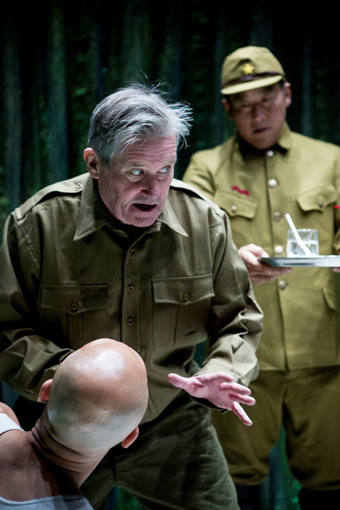
foreground Justin Stewart Cotta, Peter Kowitz, Shingo Usami, The Floating World, Griffin Theatre Company
photo Brett Boardman
foreground Justin Stewart Cotta, Peter Kowitz, Shingo Usami, The Floating World, Griffin Theatre Company
In Stephen Curtis’ aptly spare design a glittering showbizzy curtain curves behind a simple platform stage, opposite which is a keyboard for the ship’s entertainment officer. As in the second half of Simon Stone’s Hamlet, the curtain is whisked away to reveal stark white walls as madness becomes palpable and, finally, Les raves his way to salvation in a straitjacket. Sam Strong’s account is in every respect a powerful ensemble production: Valerie Bader is perfect as Irene Harding, used to casually deflecting her husband’s barbs, oblivious to her misuse of words (making her comic but no less sensitive) and now painfully confronted with a husband out of control. Tony Llewellyn-Jones is the amicable, gentlemanly former British officer whose tolerance of the abuse meted out by Les is stretched to near breaking point. Justin Smith’s comic is an aptly gross reflection of Les’s prejudices, but one without justification. Justin Stewart Cotta as ship’s musician and the long dead soldier mate McLeod is a strong, flexible performer, as is Shingo Usami as the put-upon waiter-cum-officer whose other job is to manipulate the Dippy (or Drinking) Bird (originally Chinese, then Japanese before being mass-marketed by the US)—that haunting symbol of balance and the absence of real autonomy—that Romeril employs between scenes. Kelly Ryall’s sound score is aptly eerie, resonant with the play’s many unsettling, floating signifiers, not least the reverberant title which ironically analogises the crude shipboard entertainment with Japan’s sophisticated cultural underworld and then Les Harding’s lost soul.
Save for a slightly stiff staging of the play’s final lines (delivered by three of the cast instead of two) this production of The Floating World is superbly unnerving, confirming once again that the play is indeed an Australian classic, a phrase tossed about too easily these days.
Ewen Leslie replaced Toby Schmitz as Hamlet from November 19.
The Floating World will play at Riverside Theatres, Parramatta, 19-23 Nov, http://riversideparramatta.com.au/show/the-floating-world/
Belvoir, Hamlet, writer William Shakespeare, director Simon Stone, designer Ralph Myers, costumes Mel Page, lighting Benjamin Cisterne, music, sound Stefan Gregory, Belvoir Theatre, 16 Oct-1 Dec; Griffin Theatre Company, The Floating World, writer John Romeril, director Sam Strong, The Stables, Sydney, 4 Oct-16 Nov
This article first appeared in RT’s online e-dition 13 November, 2013
RealTime issue #118 Dec-Jan 2013 pg. 38
© Keith Gallasch; for permission to reproduce apply to realtime@realtimearts.net
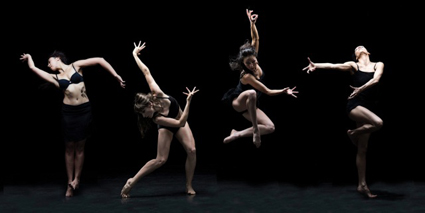
Jasmin Sheppard, Yolande Brown, Tara Gower, Deborah Brown
photo Greg Barrett
Jasmin Sheppard, Yolande Brown, Tara Gower, Deborah Brown
This week we offer just a few of the highlights from a host of Aboriginal and Torres Strait Islander arts activities across the country, ranging from Sydney, to Perth, to Darwin. Plus there are exhibitions from new and old collectives in Brisbane, performance takes to the streets in Erskineville and we get the lowdown on live art in the UK.
Dance Clan 3, Bangarra Dance Theatre
As part of the inaugural Corroboree festival, which sees Aboriginal and Torres Strait Islander arts activities blossoming all around Sydney’s iconic harbour, Bangarra Dance Theatre is presenting Dance Clan 3. Artistic director Stephen Page has invited four of the company’s senior female dancers to choreograph works for the 14-strong troupe. Deborah Brown, Yolanda Brown, Tara Gower and Jasmin Sheppard draw on ancient storylines to create a diverse evening of dance at Bangarra’s home studio at Pier 4. Watch out for the review in RT119.
Dance Clan 3, Bangarra Dance Theatre, 20 Nov-1 Dec; http://www.bangarra.com.au/; Corroboree, various venues Sydney, 14-24 Nov; http://www.corroboreesydney.com.au/
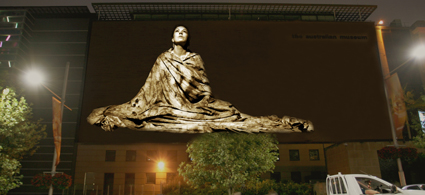
Place Projections, born in darkness before dawn, artist impression by Nicole Foreshew
courtesy the artist
Place Projections, born in darkness before dawn, artist impression by Nicole Foreshew
born in darkness before dawn, Nicole Foreshew
Also as part of the Corroboree festival, the Australian Museum will host a large-scale projection by Nicole Foreshew, presented by the City of Sydney as part of their ongoing Eora Journey project. Born in darkness before dawn is a 20-metre video projection of Aboriginal women draped in a large bolt of cloth, dyed and decorated by Forshew. She writes, “The body is used to perform the absence of place and the cloth is used to explore the language of movement and illumination. Dyed cloth from bark and leaves, found in gutters, water drains and the bottom of trees infuse design elements referencing the growth and structure of plant organisms and remains” (artist statement, website).
City of Sydney, Place Projections: born in darkness before dawn, Nicole Foreshew, Australian Museum, 19 Nov-20 Jan; http://www.cityartsydney.com.au/cityart/projects/PlaceProjections.asp
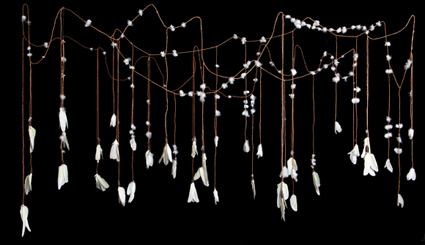
Frances Djulibing, Yukuwa (Feather string yam vine), 2013. Banyan tree bark, cockatoo feathers, beeswax. Museum of Contemporary Art, purchased 2013. Image courtesy and © the artist
photo Alex Davies
Frances Djulibing, Yukuwa (Feather string yam vine), 2013. Banyan tree bark, cockatoo feathers, beeswax. Museum of Contemporary Art, purchased 2013. Image courtesy and © the artist
string theory: focus on contemporary Australian art, PICA
Another activity focused on Indigenous textiles is the MCA touring exhibition titled string theory, currently showing at Perth’s PICA. Curated by Glenn Barkley, the show brings together works from leading Indigenous artists with a focus on “fibre and art in a contemporary context” (website). It includes craft-based practices as well as sculpture, painting, photography and video works. Exhibiting artists and collectives include Tony Albert, Frances Djulibing Boolarng, Lipaki Marlaypa, Nangamai Aboriginal Art & Culture Studio, Noongar Doll Makers, Yarrenyty Arltere Artists, Tasmanian Shell Necklace Makers, Tjanpi Desert Weavers, and Yirrkala Printmakers.
string theory: Focus on contemporary Australian art, PICA, 16 Nov 2013 – 5 Jan 2014; http://www.pica.org.au/view/string+theory/1744/
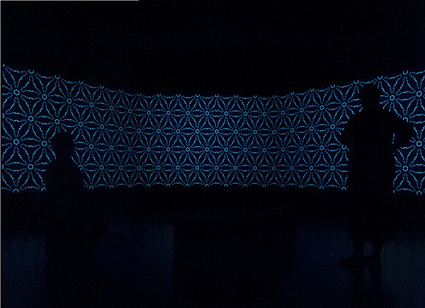
Karen Casey, Dream Zone, 2012, Generative video installation, National New Media Art Award, Queensland Art Gallery/Gallery of Modern Art, Brisbane. 2012
photo Ben Wickes
Karen Casey, Dream Zone, 2012, Generative video installation, National New Media Art Award, Queensland Art Gallery/Gallery of Modern Art, Brisbane. 2012
Karen Casey, Dream Zone, FAC
RT reviewer Laetitia Wilson described Karen Casey’s Mediation Wall, exhibited as part of the 2012 John Curtin Gallery exhibition The World Is Everything That Is The Case, as a “mesmerising piece… a magnificent wash of colour and pattern” (RT110). WA viewers have a chance to see another of Casey’s works, Dream Zone (2012), at Fremantle Arts Centre. Part of her Global Mind Project, Dream Zone uses the artist’s brainwave data to create intricate pulsing patterns that we are told are “reminiscent of various forms of sacred art and intended to invite contemplation and draw the viewer into a deeply meditative state” (website). You’ll be able to read about this work in RT119.
Karen Casey: Dream Zone, Fremantle Arts Centre, 23 Nov 2013-19 Jan 2014; http://fac.org.au/
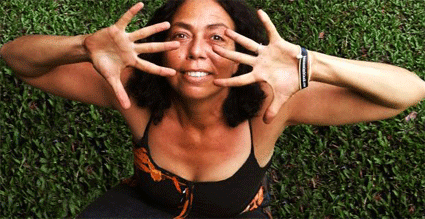
Lynette Hubbard, The Adventures of Namakili; Darren Edwards, I AM MAN
courtesy the artists
Lynette Hubbard, The Adventures of Namakili; Darren Edwards, I AM MAN
The Adventures of Namakili & I Am Man, Brown’s Mart & New Blak Territory
Last week we featured an article from one of our new Darwin-based writers, Nicola Fearn, reviewing the recent Brown’s Mart production, Forced Legacy—The Story of Alyngdabu, by Kathy and Alli Mills with Damien A Pree (read review here). Keeping up the output of new works by Indigenous theatre makers, Brown’s Mart is about to present a double bill. The Adventures of Namakili is created and performed by Lynette Hubbard, “explor[ing] the intricacies of life between two cultures” (website) using a mix of English, Creole and the Wambaya and Warrumungu languages. Accompanying this, I Am Man, created and directed by Ben Graetz, is the inaugural production of the group New Black Territory, presenting an all male cast in a physical theatre work around ideas of “identity, masculinity, sexuality, loneliness, death and love” (website).
Brown’s Mart & New Blak Territory, The Adventures Of Namakili & I Am Man, Brown’s Mart; 19-30 Nov; http://brownsmart.com.au/events/new-blak-territory-adventures-namakili-i-am-man
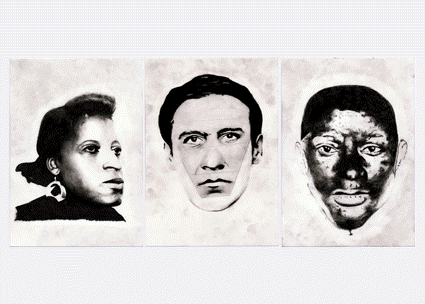
Other Projects, The Changing Standards of Dialogue: Conspicuous Contrasts (detail), 2013; Effigies (2012-2013) detail
The Changing Standards of Dialogue, Other Projects, Metro Arts
Other Projects is Marcel Daniels and Daniel Herberg who have been artists-in-residence at Metro Arts across 2013. The Changing Standards of Dialogue is an exhibition presenting results of their investigations into otherness and “the complexities, paradoxes and grey areas inherent in cross-cultural discourses” (website). The final installation will be an immersive environment incorporating sculptural and image-based works.
The Changing Standards of Dialogue, Other Projects, Metro Arts, Brisbane, 13-30 Nov, Artist talks 20 Nov; http://www.metroarts.com.au/
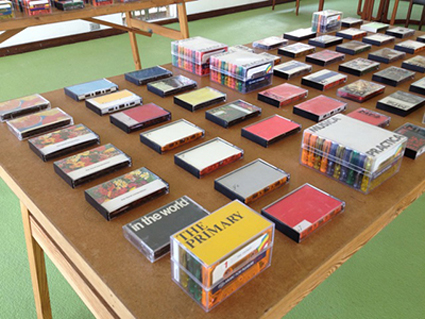
ANTI–MUSIC: 1979–1983, Pestorius Sweeney House
courtesy the artists
ANTI–MUSIC: 1979–1983, Pestorius Sweeney House
ANTI–MUSIC: 1979–1983, Pestorius Sweeney House
ANTI-MUSIC was founded in 1979 by John Nixon (better known as a painter) as a collective enterprise bringing together a range of experimental, post-punk, pop and rock music activities by artists based in Melbourne and Brisbane (where Nixon was director of the Institute of Modern Art 1980-81). ANTI-MUSIC presented the majority of its works on DIY cassettes, while also publishing a journal, Pneumatic Drill. Brisbane curator David Pestorius has been a guardian of much of the archive, producing a number of retrospectives on the group and the era. The archive is currently on display once again in Brisbane until December.
ANTI–MUSIC: 1979–1983, Pestorius Sweeney House, Brisbane; 30 Oct—13 Dec 2013; http://www.davidpestorius.com
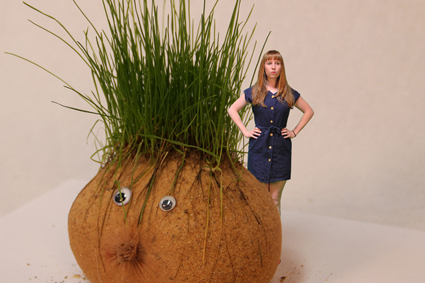
Kenzie Larson, Friend Ship, Tiny Stadiums
courtesy the artist
Kenzie Larson, Friend Ship, Tiny Stadiums
Tiny Stadiums, PACT
Tiny Stadiums is now in its sixth iteration, the second curated by the collective Groundwork. Running in the theatre for the duration of the festival is a double bill comprising Kenzie Larson’s Friend Ship, a multimedia spectacular presenting Larsen’s “groundbreaking research” into how to make friends, and Nick Coyle’s Blue Wizard in which he plays an intergalactic gay wizard trying to find the right magic that will send him home. There’ll also be two live art Saturdays (16 & 23 Nov) in and around the village of Erskineville with performances, installations and interactive experiences by artists including Natalie Abbott, Ella Barclay, Hossein Ghaemi, Bennett Miller and Imogen Semmler. And no festival is complete without art chat in the form of Tiny Talks and Tiny Forums.
Tiny Stadiums, PACT Centre for Emerging Artists; 12-23 Nov; http://www.pact.net.au/2013/10/tiny-stadiums-2013
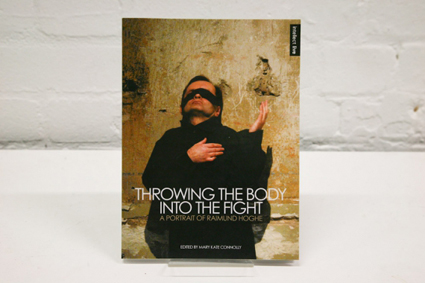
Throwing the Body into the Fight, A Portrait of Raimond Hoghe, a Live Art Development Agency publication
Live Art Development Agency, UK
Looking for Live Art goings on in the UK and Europe? Check out the Live Art Development Agency (LADA) and sign up to their newsletter. Established in 1999 by Lois Keidan and Catherine Ugwu in response to new forms of performance practice developing at the time, the main focus of the organisation has been on developing resources, publications and advocating for the sector via strategic partnerships and presentations. This year alone they’ve been involved in the production of 14 books and DVDs including the Live Art Almanac, a collection of “found” writing about performance; Performance Matters, a 40 DVD box set created in collaboration with the British Library documenting the Performing Idea and Trashing Performance events; Tim Etchells’ latest writing, While You Are With Us Here Tonight, reflecting on his solo work and collaborations with Forced Entertainment; and Throwing the Body into the Fight, a collection of texts on the work of Raimond Hoghe drawn together by Mary Kate Connolly.
http://www.thisisliveart.co.uk/
Still in the loop
This is a Door, Pop-Up Playground
Theatreworks and various venues, St Kilda and Melbourne City
Oct 31-1 Dec
http://popupplayground.com.au/this-is-a-door-2013/
Wagnerlicht, Arts Centre Melbourne
15 Nov-14 Dec
http://wagnerlicht.com
La Boite Indie: R & J
La Boite Roundhouse Theatre, Brisbane
13- 30 Nov
http://www.laboite.com.au/cms/page.asp?ID=21
Standing Bird Two, Verge, The Blue Room
13-30 Nov
http://blueroom.org.au/
Trace Recordings UTS Gallery
until 29 November
http://www.art.uts.edu.au/gallery/current/index.html; http://www.tracerecordings.net/
Performa, NY
various venues New York City
1-24 Nov
http://13.performa-arts.org/
My Avant-Garde Is Bigger Than Yours, Kings ARI
1-23 Nov 2013
http://www.kingsartistrun.com.au/
Crash Course, James Berlyn
PICA, 14-30 Nov
http://www.pica.org.au/view/Crash+Course/1745/
[CTRL][P] Objects on Demand, Object Gallery
15 Oct 2013 – 25 Jan 2014
http://www.object.com.au/exhibitions-events/entry/ctrl_p_objects_on_demand/; http://ctrlp.com.au/
Lorraine Heller-Nicholas, Love Story, Videobrasil
Southern Panoramas, 6 Nov-2 Feb
http://site.videobrasil.org.br/festival/arquivo/festival/programa/1589140
Daniele Puppi 432 Hertz, Cinema Rianimato e Dintorni, AEAF
1 Nov-7 Dec
http://www.aeaf.org.au/exhibitions/danielepuppi.html
Simple Forces, Joyce Hinterding
BreenSpace
25 Oct-23 Nov
http://www.breenspace.com/
Reinventing the Wheel: the Readymade Century
MUMA
3 Oct-14 Dec
http://www.monash.edu.au/muma/exhibitions/upcoming/readymade.html
Bogong ELECTRIC
Bogong Village, North East Victoria
1 Nov-1 Dec
http://bogongsound.com.au/
RealTime issue #117 Oct-Nov 2013 pg. web
© RealTime ; for permission to reproduce apply to realtime@realtimearts.net
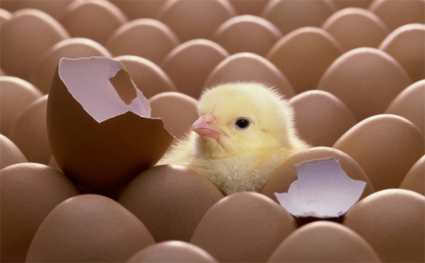
Ensemble Offspring, Hatched
Hatched, Ensemble Offspring
Ensemble Offspring have just announced their inaugural Hatched program which sees an emerging composer and performer undertake intensive mentorship for 12 months. At the conclusion of the year they will present a program of works developed in association with this celebrated new music group. Applications are invited from artists 30 and under from around Australia.
Deadline 11 Dec, 2013; http://ensembleoffspring.com/ensemble-offspring-academy/
Skip Ahead, YouTube & Screen Australia
You Tube & Screen Australia have come together to offer a unique funding initiative for Australian content producers to create online video content. Up to $100,000 is available for web series projects proposed by artists or groups who already have a YouTube channel with 100,000 subscribers or more. Up to five projects will be funded and successful applicants will also receive a training trip to one of YouTube’s “Spaces” in Tokyo, London or Los Angeles in March/ April 2014.
Deadline 20 Dec, 2013; http://www.screenaustralia.gov.au/getmedia/0aa1c24a-6854-4687-8ece-085cc850aa4a/Guidelines_SkipAhead.pdf
Amplify Your Art, Accessible Arts
A funding initiative of Arts NSW devolved to Accessible Arts, Amplify Your Art offers grants of $5,000-$10,000 to artists with disabilities to undertake mentorship, training and other professional development activities.
Deadline 18 Dec, 2013; http://www.aarts.net.au/amplify/
Still in the loop
Public Art, Heffron Hall, City of Sydney
Tenders due 6 Dec; http://www.cityartsydney.com.au/cityart/news/?p=1871
Exposure Summer Intensive, Tasdance
Applications currently open; http://tasdance.com.au/exposure/; for more info email richard@tasdance.com.au
CJZ/Rock Surfers New Writing Commission
Deadline 2 Dec; http://rocksurfers.org/newwords/
Courthouse Arts Visual Arts Program
EOIs due 15 Nov; http://courthouse.org.au/on-now/searching-for-a-young-curator-for-2014/
Editor, Un Magazine
Applications due 25 November 2013; http://unprojects.org.au/magazine/contribute/
Waterwheel Symposium Call for Participation
Proposals for Symposium due 22 Nov; proposals for Voice of the Future Youth Day, 31 Dec; http://water-wheel.net/
Selected Australia Council Grant Deadlines
(for full list go to http://www.australiacouncil.gov.au/grants
Music: Presentation and Promotion – 18 November 2013
http://www.australiacouncil.gov.au/grants/2013/music-presentation-and-promotion-18-november
Music: New Work – Writing and Recording – 18 November 2013
http://www.australiacouncil.gov.au/grants/2013/music-new-work-writing-and-recording-18-november
Aboriginal and Torres Strait Islander: Skills and Arts Development –
19 November 2013
http://www.australiacouncil.gov.au/grants/2013/aboriginal-and-torres-strait-islander-arts-skills-and-arts-development-19-november
Aboriginal and Torres Strait Islander: Presentation and Promotion-
19 November 2013
http://www.australiacouncil.gov.au/grants/2013/aboriginal-and-torres-strait-islander-arts-presentation-and-promotion-1-april
Aboriginal and Torres Strait Islander: The Dreaming Award –
19 November 2013
http://www.australiacouncil.gov.au/grants/2013/dreaming-award
Aboriginal and Torres Strait Islander: Fellowships –
19 November 2013
http://www.australiacouncil.gov.au/grants/2013/aboriginal-and-torres-strait-islander-arts-fellowships
Aboriginal and Torres Strait Islander: The Red Ochre Award –
19 November 2013
http://www.australiacouncil.gov.au/grants/2013/red-ochre-award
Aboriginal and Torres Strait Islander: New Work –
19 November 2013
http://www.australiacouncil.gov.au/grants/2013/aboriginal-and-torres-strait-islander-arts-new-work-19-november
Visual Arts Travel Fund – 25 November 2013
http://www.australiacouncil.gov.au/grants/2013/Visual-Arts-Travel-Fund
Contemporary Music Touring Program – 25 November 2013
http://www.australiacouncil.gov.au/grants/2013/contemporary-music-touring-program-25-november
RealTime issue #117 Oct-Nov 2013 pg. web
© RealTime ; for permission to reproduce apply to realtime@realtimearts.net
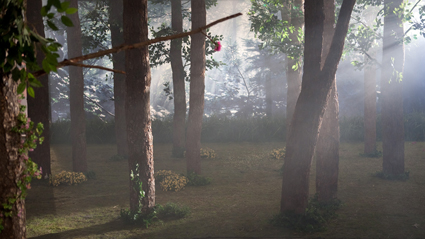
Yeondoo Jung, Documentary Nostalgia, video still, 2007
Two films from Korean artist Yeondoo Jung. Both take us through the construction of a naturalistic scene showing how the illusion is created with photorealistic backdrops and crafty props. Twilight Seoul is 8 minutes with Yeondoo and collaborator Luka Fineisen chatting away in the studio as they mound up blocks of wood, squashed cardboard boxes, bits of fluff, a woolly cap and a stuffed cuddly tiger. They stop the chat, a backdrop is pulled across, the lights go dim and the shadows deepen between the piles of junk. Fog rolls across the floor, a lonely bird cries out in the silence and, like a miracle, a jumble of absolute crap becomes Sacred Mountains in the Twilight.
The slowly fascinating documentary Nostalgia is an 84-minute single take of the construction of various scenes from Yeondoo’s memory. Opens on a bare room, floral wallpaper, classic perspective shot. Man in neat orange coveralls comes in and hangs a painting, goes back out, comes back in with a table, a rug, a vase and flowers. Sticks a couple of power points on the wall, plugs in a lamp, turns it on—even though it is a fake. Someone else comes in, turns off the lights, goes out, things start shaking, the whole scene starts to move and we see a bunch of guys in orange roll the room away on a trolley to reveal….
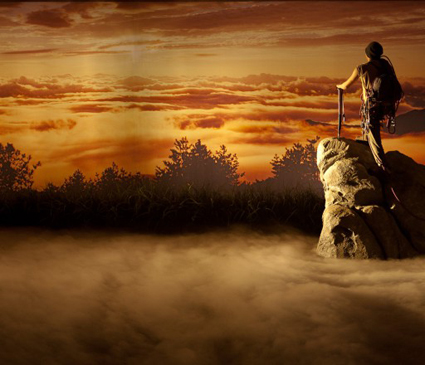
Yeondoo Jung, Documentary Nostalgia, video still, 2007
A studio set up like a classic street scene with shops and a bus stop. The orange guys lug in a carpet and roll out an instant bitumen road with white dashes down the middle. A minivan is pushed in and a man and a woman step out, go wait at the bus stop. Smart casuals. It starts to rain and a man holding a briefcase over his head for protection runs to the bus stop and…everything freezes into a photo—Urban Street in the Rain. This is the format—activity and construction of various set pieces that from time to time freeze into a photo op. The past as the construction of a snapshot.
The more or less continual transformation of scenes continues—now it is a rural scene with real bird on tree branch but fake bouncy eggs in the nest. Fake grass and a wooden fence. Lead in a cow who munches feed from a wooden trough and is not at all keen to shuffle off stage and leave that food behind when her time is up. Trees are carried on and there’s a sun-dappled forest, then even more trees for a thicker forest in moonlight. Finally a panoramic sunset backdrop is wheeled in and thick fog spills over the ground. A rocky peak pushes up through the fog and a mountaineer, rope coiled over his shoulder, clambers to the top and peers into the distance. He poses as the lonely Hero from Caspar David Friedrich’s “Wanderer above the Sea of Fog.” Story and recollection have meshed into memories held still for the perfect photo. Cut! And roll credits.
Yeondoo Jung, MAAP Space, Brisbane, 27 Sept-8 Nov; http://www.maap.org.au/projects/maap-space/
RealTime issue #117 Oct-Nov 2013 pg. web
© Greg Hooper; for permission to reproduce apply to realtime@realtimearts.net
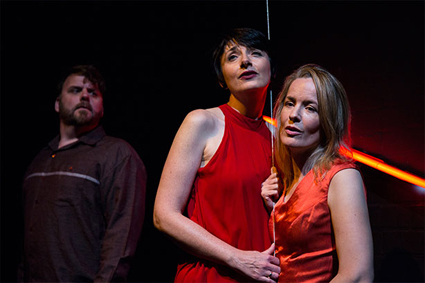
David Rogers-Smith, Judith Dodsworth, Rachael Duncan, From a Black Sky
photo Lorna Sim
David Rogers-Smith, Judith Dodsworth, Rachael Duncan, From a Black Sky
From A Black Sky is a contemporary opera about inflamed passions coming to crisis during the 2003 Canberra bushfires. Lust (too much heat) versus cowardice and inertia (too little of it) play out against the caustic burn of shame, guilt and wounded pride. It’s not revealing too much to say that, as the firestorms approach, a married woman seduces a man’s wife then goads him to suicidal self-sacrifice.
Librettist (Helen Nourse) and composer (Sandra France) have been anxious to make the work melodically and dramatically accessible. It focuses on two couples in a domestic Canberra setting (Saturday markets, retrenchments, unpaid bills, a dithering bureaucracy), yet the score itself raises the stakes and asks significant questions of what contemporary opera is and aims to achieve. Once voices are engaged so powerfully it’s not long before one enters the mythic realm.
The prologue is scored in a lush tonal landscape (with echoes of Ross Edwards) which nonetheless fails to create a specific geography. This matters by the opera’s end, as to my mind (and in the music) the tragedy of, and havoc created by fire, transcends individual lives.
That said, soloist characterizations are strong. In Act 1, Amelia and David’s insistent upper-register As and B flats accentuate his anxiety at being retrenched (to which he can’t openly admit) and her anger at being held back from imminent success. Rippling piano triplet arpeggios underscore their full-throated distress. If Othello is a tragedy about a handkerchief, this is one which turns on a silk dress she wants to market but he won’t finance.
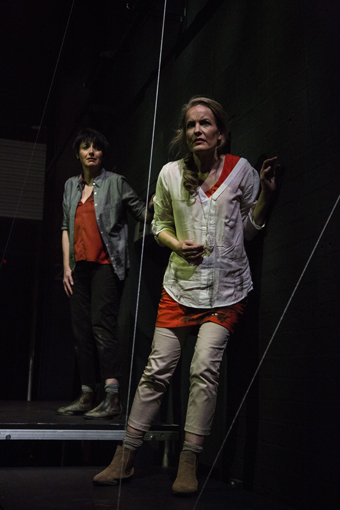
Judith Dodsworth, Rachael Duncan, From a Black Sky
photo Lorna Sim
Judith Dodsworth, Rachael Duncan, From a Black Sky
Sophie’s private seduction of Amelia is, by contrast, scored in mid-range, close-stepped notes above a low, brooding ostenato. She is as intent on her prey as she is later in emasculating Amelia’s husband. The women’s love scene perhaps needed more hunger in its staging; nonetheless, as the firestorm encroaches on the township and David returns, suspicious of the pair, Sophie’s emasculation of him in vocal leaps up and down flattened and sharpened 7ths and 2nds is truly dangerous. She goads him to stay behind—is he a man or not?—whilst the town begins to burn. This is exactly the thing opera does best: weaknesses exposed, greatness by chance—magnified by circumstance. And David Rogers Smith dies beautifully (in lighting designer Gillian Schwab’s impressive fire).
Curiously, this opera by two women becomes a drama about a man’s self-worth, but I am unsure whether this is or should be the central theme. The epilogue exposes how unevenly this is worked through: the other male protagonist is strangely passive just when his own rage, loss or sense of betrayal would surely come to the fore.
Elsewhere, however, I am aware of a tender, feminine register. The chorus’ post-firestorm wailing is extremely delicate, and the comfort meted out by teenagers (“Here, use my phone—ring anyone you want to”) still moves me to tears. Composer and librettist clearly have a delicate partnership and can hold emotional truths within and beneath the blaze demanded by the opera form.
Overall, weaknesses are few, if significant. The racy red motor scooter raffled in the opening scene—an attractor to Sophie’s wealth and manipulative ego, and foil for David who cannot abide the frivolity—needs both stronger staging and longer focus within the score, Sophie perhaps sitting astride the scooter for a whole set piece aria, giving time to set the characterisations, tension and tone. Similarly, the necklace Sophie buys for Amelia, which David can’t afford, is a potent symbol of Amelia’s needs, David’s weakness and Sophie’s power, glossed over in too truncated a form. I read the libretto and score before attending so knew what to look for: others in the audience reported being quite lost.
Some phrases do not carry well from the stage: for example, “I have no urge to stay” is a curiously literary line, veiling rather than demonstrating Amelia’s conflicting impulses; and Tony’s “He was a gutsy man” fails to convey admiration for his mate. The phrase somehow implodes back into the singer’s body, as does “Weston Creek” whose short vowels and clipped consonants do not render a sense of a place we necessarily want to see survive. Perhaps quite critically, the vacuous, gutless bureaucrats who can’t make a decision when it’s most needed would be more effective as a single character, providing dramatic counterpoint and highlighting the ironic, brave folly of David’s lone sacrifice. As in life, ‘faceless’ characters don’t really engage.
These are points crying out for adjustment, but the impact of the whole is to make you want it to be seen again, and not just by Canberra audiences. Although archival ABC radio voiceovers certainly make locals shiver (talk in the foyer redolent of ‘where we were’ on that fateful day), the power of France and Nourse’s work transcends the locale. It is everyman, every woman, any time, every possible fire.
Canberra 100: From A Black Sky, composer Sandra France, librettist Helen Nourse, director Caroline Stacey, conductor, musical director David Kram, designer Christiane Nowak, lighting Gillian Schwab, sound Seth Edwards-Ellis, performer Judith Dodsworth, Don Bemrose, Rachael Duncan, David Rogers Smith, Vocal Ensemble from Erindale College and Arrawang Primary School Chorus; The Street Theatre, Canberra, 20-22 Sept
RealTime issue #117 Oct-Nov 2013 pg. web
© Zsuzsanna Soboslay; for permission to reproduce apply to realtime@realtimearts.net
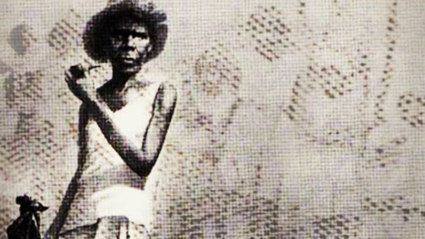
Forced Legacy—The Story of Alyngdabu
courtesy the artists
Forced Legacy—The Story of Alyngdabu
A tall, thin Aboriginal woman wearing a slouch hat and holding a tobacco pipe in one hand and a cloth bag attached to a stick in the other is the striking central image in Forced Legacy—The Story of Alyngdabu. In a painting by Robert Ingpen she looks assertively at the viewer and, as the play reveals, was a formidable woman of her time. A Kungarakan woman who married Irishman Stephen McGuinness in the early 1900s, Alyngdabu raised five children in Kungarakan country, the Bynoe Harbour area of Darwin.
The play tells her story—her happy marriage to Stephen, their tin mining venture and then how the children were forcibly taken from her and placed in the Kahlin Compound for “half castes” when her husband died. It is a story of love, injustice and survival told with pride by Alyngdabu’s descendents Kathy Mills and her daughter Alli Mills with dramaturgical and directorial support from Damian A Pree.
Kathy and Alli are well known Darwin activists, artists and musicians who have been telling their stories through various mediums for many years and campaigning for a shrine of remembrance on the now empty site where Kahlin Compound once kept hundreds of Stolen Generation children. This theatre work is a collaboration with Friends of Kahlin and commemorates the centenary of the compound.
It is an important story to tell and moved some of the Brown’s Mart audience to tears. Sitting in front of a scrim used for projecting historical images of traditional Aboriginal life, of Elders and colonial Darwin, grandmother and mother tell the young Alice “Binjak” Mills her family history. In a relaxed conversational style Alice and Alli play themselves. The women talk about Alyngdabu’s life with segments re-enacted behind the scrim using a combination of actors and puppets.
The work reveals a positive historical story of Indigenous and non-indigenous connection, contrasting this with the White Australia law of the time which caused so much damage and grief.
Forced Legacy—The Story of Alyngdabu is community political theatre, uniting professional and non-professional performers and using a variety of mediums. A team of four people made approximately 15 near life-sized puppets to populate the stage. Some were occasionally manipulated individually, some in groups by one puppeteer, but many on racks were wheeled on and off stage for scenes behind the scrim representing the Alyngdabu/McGuiness clan. Traditional Indigenous puppets were made by Conor Fox and painted for ceremony by Larrakia man Robert Mills, and others depicted the racist Anglo workers, with voice-over taunts. One of the simplest and most successful moments in bringing a puppet to life occurred when Alyngdabu’s husband, Stephen (Tony Rive), carried his baby girl puppet who played with his face as he spoke.
Another medium involved internally lit boxes lowered into the performing space with images of the heads of white colonial leaders. These comic forms bobbed up and down to a voice-over, thus making potentially dry historical information about colonialisation into something more engaging. The company also fleetingly used full-face masks for a couple of characters, though the choice to make these characters soundlessly gesticulate to a voice track undermined the mask form. When creating full-face mask theatre it is important to ask yourself, why use masks?
Eleanor Gapany as Alyngdabu was an authentic presence who created a resonant moment in the Kahlin Compound as she sang a European nursery rhyme in her traditional language. She was supported on stage by strong performances from Tony Rive and Adam Steer. The latter played Stephen’s friend, Harry, who promised the dying Stephen that he would marry his daughter purely to keep her from being stolen from her mother and placed in Kahlin.
Kathy and Alli Mills have a powerful true story to tell, one that they are passionate about. This story itself justifies the production—some of the story is widely known, some of it is new to audiences. In the final speech Lynette Lewis (Kathy) tellingly says, “We don’t live in the past, the past lives in us.”
As Kathy Mills states in the program notes, “Talking about a shared national history can be good for all of us. It’s not about blame or shame, it is about truth and justice and what is the right thing to do as a nation. Once the truth is established, justice is a matter of course and other good things can happen for people and for a nation.”
Friends of Kahlin and Brown’s Mart Productions: Forced Legacy—The Story of Alyngdabu, writers Kathy Mills Alli Mills, Damien A Pree, puppet construction Conor Fox, puppet painters Robert Mills, Alison Dowell, Tony Lee, puppeteer France-Line Pierroy, lighting Chris Kluge, sound & multi-media Angus Robson, multimedia Tim Parish, Huni Bolliger, sound design Lulu Madill; Browns Mart Theatre, Darwin, 1-6 Oct
This article first appeared in RT’s online e-dition 6 November, 2013
RealTime issue #118 Dec-Jan 2013 pg. 36
© Nicola Fearn; for permission to reproduce apply to realtime@realtimearts.net
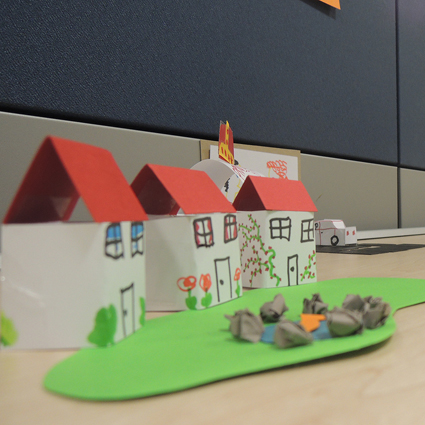
This is a Door, Pop-Up Playground
This is a Door, Pop-Up Playground
In two recent articles for RealTime Robert Reid has been preoccupied with play and now we know why (see RT117 & RT115). He is one of the core members of Pop-Up Playground presenting the This is a Door festival in Melbourne, a month-long program of participatory experiences and games. If you want to join the fun you can decide on the fate of the city with the Urban Codemakers (see the realtime tv interview with Troy Innocent about the ISEA instalment Zydnei); find and fight monsters in Pub Werewolf; make unicorns with the Nylon Zoo; or discover haiku bombs made by guerilla poets. On the final weekend, Theatreworks in St Kilda will be transformed into a massive “playroom” for back-to-back adventures. Just to be clear here, we’re not talking computer games—this is real world fun.
This is a Door, Pop-Up Playground, Theatreworks and various venues, St Kilda and Melbourne City; http://popupplayground.com.au/this-is-a-door-2013/
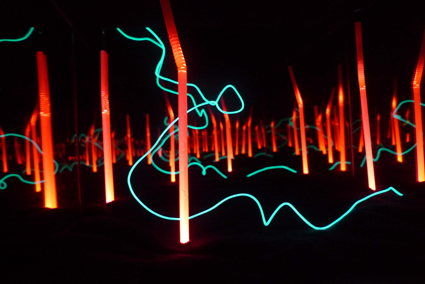
Belinda Middlebrook’s Wood Bird, part of Wagnerlicht
courtesy the artists
Belinda Middlebrook’s Wood Bird, part of Wagnerlicht
Wagnerlicht, Arts Centre
Celebrating the bicentenary of Richard Wagner’s birth, Wagnerlicht is a multimedia installation inspired by his most famous opera Der Ring des Nibelungen (The Ring Cycle). Conceptualised by Michael Day this installation of light, sound and sculpture is realised with input from design and sound students from the University of Technology Sydney and the University of Applied Sciences in Ansbach, Germany. The interactive installation (especially for those who couldn’t afford or missed out on tickets for the Opera Australia production soon to premiere in Melbourne) allows audiences to re-intrepret the Ring Cycle and engage with the epic in new, intimate ways.
Wagnerlicht, Arts Centre Melbourne; 15 Nov-14 Dec; http://wagnerlicht.com
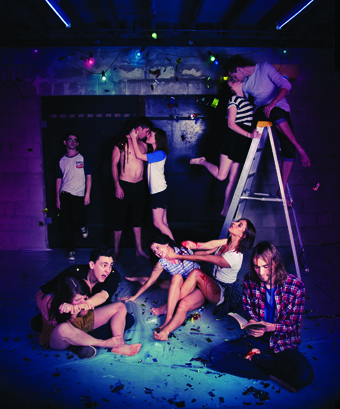
The Breadbeard Collective, R & J, La Boite Indie with QPAC
photo Al Caeiro
The Breadbeard Collective, R & J, La Boite Indie with QPAC
R&J, La Boite Indie
Shakespeare’s Romeo & Juliet, every generation has to have their crack at it. The final La Boite Indie show sees ten young people (18-25) remixing the tale, “hanging new meat on the skeleton of the story” (website). Directed by Lucas Stibbard and devised with The Breadbeard Collective it looks like it’ll be a wild party.
La Boite Indie: R & J, La Boite Roundhouse Theatre; Brisbane, 13- 30 Nov; http://www.laboite.com.au/cms/page.asp?ID=21
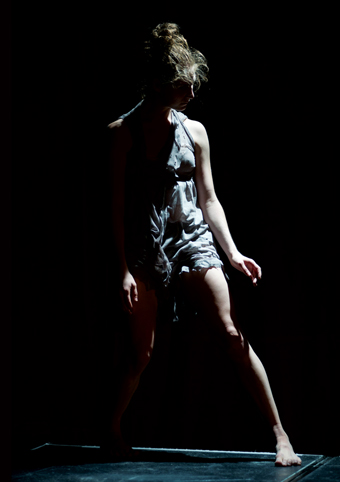
Jacqui Claus, Standing Bird 2
courtesy the artist
Jacqui Claus, Standing Bird 2
Standing Bird Two & Verge, The Blue Room
Perth’s The Blue Room is presenting a micro-season of dance featuring Sally Richardson’s Standing Bird 2 and Patrice Smith’s Verge. Standing Bird Two, performed by Jacqui Claus, continues to explore the struggle of transformation seen in the first installment of Standing Bird at Fringeworld 2012 (see Maggie Philips review RT108.) For this piece the performance leaves the theatre to be sited around the Blue Room venue. Verge, performed by Claus with Laura Boynes and Bernadette Lewis, plays with ideas of tension and release, “unease and the quiet discomfort before someone loses control” (website).
Standing Bird Two, director, concept Sally Richardson, movement director Danielle Micich, 12-29 Nov; Verge, choreographer Patrice Smith; 13-30 Nov; The Blue Room; http://blueroom.org.au/
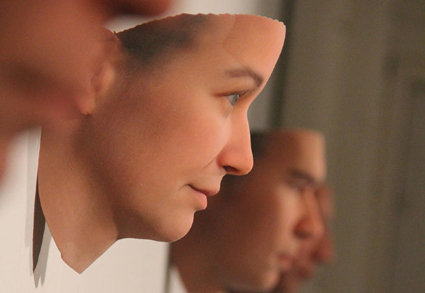
Heather Dewey-Hagborg, Stranger Visions 2012, Trace Recordings
courtesy the artist
Heather Dewey-Hagborg, Stranger Visions 2012, Trace Recordings
Trace Recordings, UTS Gallery
Curated by Holly Williams and Chris Gaul, Trace Recording features 11 artists’ responses to the increasing pervasiveness of surveillance in the everyday. Heather Dewey-Hagborg (US) uses DNA sampled from discarded cigarette butts and chewing gum to generate 3D printed portraits. Recently featured in ISEA2013, Italian artist Paulo Cirio’s Street Ghosts haunt the streets—featured in life size posters of people taken from Streetview, pasted-up in situ. Adam Harvey (US) plays with the idea of urban camouflage via “dazzle” techniques to trick facial recognition software. Denis Beaubois (Australia) is vengeful, turning the surveillance technology back on itself using mirrors to create a closed loop. There is also a program of workshops and talks.
Trace Recordings, artists Denis Beaubois, James Bridle, Mahwish Chishty, Paolo Cirio, Heather Dewey-Hagborg, Benjamin Gaulon, Adam Harvey, Trevor Paglen, Shinseungback Kimyonghun and Matt Richardson; UTS Gallery; until 29 November; http://www.art.uts.edu.au/gallery/current/index.html; http://www.tracerecordings.net/
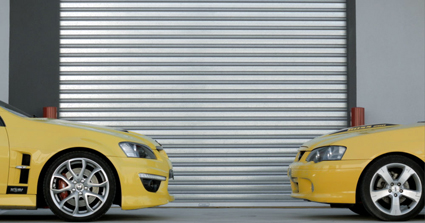
Brendan Lee, The Great Divide: RevHeads
courtesy the artist
Brendan Lee, The Great Divide: RevHeads
Brendan Lee, The Great Divide: RevHeads
At The Front Gallery in the Melbourne Docklands, Brendan Lee takes on the great Aussie car battle between Ford and Holden. In the first of what will be a series of videos, Lee “questions the identification with an evolving Australian archetype and how this is both transformed and perpetuated through popular competitive representations and iconic brands” (website). Burn rubber to get there.
Brendan Lee, The Great Divide: RevHeads, The Front, Docklands, open 9 Nov, http://www.brendanlee.com/site.php
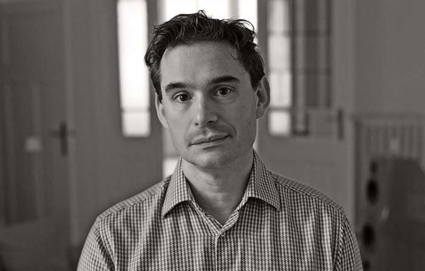
Markus Popp (aka Oval)
courtesy the artist
Markus Popp (aka Oval)
Markus Popp, National Film and Sound Archive
Father of glitch, Markus Popp (aka Oval) is currently in Australia courtesy of the Goethe Institut. He’ll be performing a free concert at the National Film and Sound Archive, Canberra this weekend supported by Hinterlandt and local boys Spartak.
Markus Popp, NFSA Theatrette, Canberra, ACT, 9 Nov; http://www.nfsa.gov.au/calendar/event/4954-markus-popp/
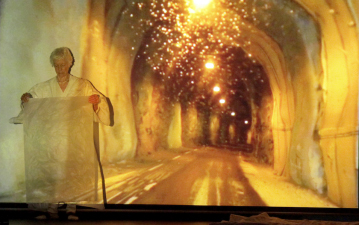
Joan Jonas, Reanimation, dOCUMENTA 13
photo by Maria Ruhling
Joan Jonas, Reanimation, dOCUMENTA 13
Performa, New York
For those lucky enough to be in the Big Apple, Performa has kicked off with a month of amazing performance and live art. There is an insane number of events but possible highlights include Jérôme Bel with Theater Hora Disabled Theater; Seminal Polish collective Akademia Ruchu’s participatory performance for Time’s Square; fictional art star Eleanora Antinova; Cifford Owens’ five-day durational performance; and Joan Jonas’ multimedia installation, Reanimation. There’s a strong sense of historicity running through the program with Malcolm Le Grice and Guy Sherwin recreating some of their seminal expanded cinema and video works; Fluxus founder Benjamin Patterson presenting a retrospective of his actions as compositions; and the Martha Graham Company revisiting two works from Graham’s Surrealist period.
Performa, various venues New York City, 1-24 Nov; http://13.performa-arts.org/
Still in the loop
Carnival of the Bold, Changemakers Festival
national 1-10 Nov
http://changemakersfestival.org/
Carnival of the Bold, New Theatre, Newtown, 9 Nov
http://changemakersfestival.org/event/carnival-of-the-bold/
My Avant-Garde Is Bigger Than Yours, Kings ARI
1-23 Nov 2013
http://www.kingsartistrun.com.au/
Crash Course, James Berlyn
PICA, 14-30 Nov
http://www.pica.org.au/view/Crash+Course/1745/
[CTRL][P] Objects on Demand, Object Gallery
15 Oct 2013 – 25 Jan 2014
http://www.object.com.au/exhibitions-events/entry/ctrl_p_objects_on_demand/; http://ctrlp.com.au/
Lorraine Heller-Nicholas, Love Story, Videobrasil
Southern Panoramas, 6 Nov-2 Feb
http://site.videobrasil.org.br/festival/arquivo/festival/programa/1589140
Daniele Puppi 432 Hertz, Cinema Rianimato e Dintorni, AEAF
1 Nov-7 Dec
http://www.aeaf.org.au/exhibitions/danielepuppi.html
Simple Forces, Joyce Hinterding
BreenSpace
25 Oct-23 Nov
http://www.breenspace.com/
Reinventing the Wheel: the Readymade Century
MUMA
3 Oct-14 Dec
http://www.monash.edu.au/muma/exhibitions/upcoming/readymade.html
The Double World, tranSTURM
Newington Armory, Sydney Olympic Park
19 Oct-10 Nov
http://www.sydneyolympicpark.com.au/whats_on/arts_and_culture_events/exhibition_the_double_world_spr13
http://cargocollective.com/transturm/the-double-world
Bogong ELECTRIC
Bogong Village, North East Victoria
1 Nov-1 Dec
http://bogongsound.com.au/
RealTime issue #117 Oct-Nov 2013 pg. web
© RealTime ; for permission to reproduce apply to realtime@realtimearts.net
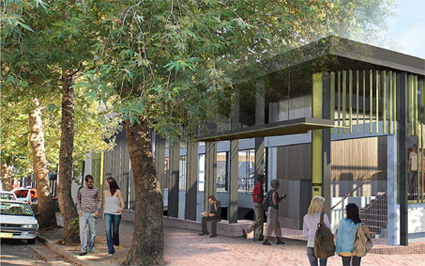
Heffron Hall, image courtesy Lahz Nimmo Architects
Public Art, Heffron Hall, City of Sydney
Many Sydney artists would be familiar with Heffron Hall since it’s been the home of Brand X—formerly Queen St Rehearsal enterprises—for the last few years. It’s oon to be revamped by the City of Sydney which is seeking proposals from artists for commissions for the new lobby.
Tenders due 6 Dec; http://www.cityartsydney.com.au/cityart/news/?p=1871
Westspace
Due to committed fund raising Westspace’s galleries in Melbourne will be rent free in 2014. If you’re quick about it you can still get in an online application for available exhibition spots in the second half of 2014.
Due 8 Nov; http://westspace.org.au/applications/how-to-apply
Exposure Summer Intensive, Tasdance
Launceston-based Tasdanceis offering a two-week summer intensive with Kialea-Nadine Williams for emerging dancers (13-17 Jan & 20-24 Jan). The program will include technique classes as well as the creative development of solo and group choreography with an informal showing at the conclusion. Participants may elect to do one or two weeks of the program.
Applications currently open; http://tasdance.com.au/exposure/; for more info email richard@tasdance.com.au
CJZ/Rock Surfers New Writing Commission
Rock Surfers Theatre, current company in residence at Bondi Pavilion, Sydney, have teamed up with media production company Cordell Jigsaw Zapruder (CJZ) to offer a $12,500 writing commission for a new theatre work. Playwrights who have had a work produced or published since 1997 (when the Rock Surfers were founded) are eligible to submit a pitch. The new work will be performed as part of their 2014 season.
Deadline 2 Dec; http://rocksurfers.org/newwords/
Still in the loop
CCP Salon 2013
Deadline 8 Nov; http://www.ccp.org.au/salon_2013.php
AEAF—emerging + experimental curators
Applications due 8 Nov
www.eaf.org
Renew Sydney: Leichhardt
Proposals due 8 Nov
http://www.renewaustralia.org/2013/10/renew-australia-comes-to-sydney-with-renew-leichhardt/
First Draft Directors 2014-2015
Deadline 8 Nov
http://firstdraftgallery.com/get_involved/firstdraftwantsyou
Courthouse Arts Visual Arts Program
EOIs due 15 Nov; http://courthouse.org.au/on-now/searching-for-a-young-curator-for-2014/
Editor, Un Magazine
Applications due 25 November 2013; http://unprojects.org.au/magazine/contribute/
Waterwheel Symposium Call for Participation
Proposals for Symposium due 22 Nov; proposals for Voice of the Future Youth Day, 31 Dec; http://water-wheel.net/
Selected Australia Council Grant Deadlines
(for full list go to http://www.australiacouncil.gov.au/grants
Music: Presentation and Promotion – 18 November 2013
http://www.australiacouncil.gov.au/grants/2013/music-presentation-and-promotion-18-november
Music: New Work – Writing and Recording – 18 November 2013
http://www.australiacouncil.gov.au/grants/2013/music-new-work-writing-and-recording-18-november
Aboriginal and Torres Strait Islander: Skills and Arts Development –
19 November 2013
http://www.australiacouncil.gov.au/grants/2013/aboriginal-and-torres-strait-islander-arts-skills-and-arts-development-19-november
Aboriginal and Torres Strait Islander: Presentation and Promotion-
19 November 2013
http://www.australiacouncil.gov.au/grants/2013/aboriginal-and-torres-strait-islander-arts-presentation-and-promotion-1-april
Aboriginal and Torres Strait Islander: The Dreaming Award –
19 November 2013
http://www.australiacouncil.gov.au/grants/2013/dreaming-award
Aboriginal and Torres Strait Islander: Fellowships –
19 November 2013
http://www.australiacouncil.gov.au/grants/2013/aboriginal-and-torres-strait-islander-arts-fellowships
Aboriginal and Torres Strait Islander: The Red Ochre Award –
19 November 2013
http://www.australiacouncil.gov.au/grants/2013/red-ochre-award
Aboriginal and Torres Strait Islander: New Work –
19 November 2013
http://www.australiacouncil.gov.au/grants/2013/aboriginal-and-torres-strait-islander-arts-new-work-19-november
Visual Arts Travel Fund – 25 November 2013
http://www.australiacouncil.gov.au/grants/2013/Visual-Arts-Travel-Fund
Contemporary Music Touring Program – 25 November 2013
http://www.australiacouncil.gov.au/grants/2013/contemporary-music-touring-program-25-november
RealTime issue #117 Oct-Nov 2013 pg. web
© RealTime ; for permission to reproduce apply to realtime@realtimearts.net
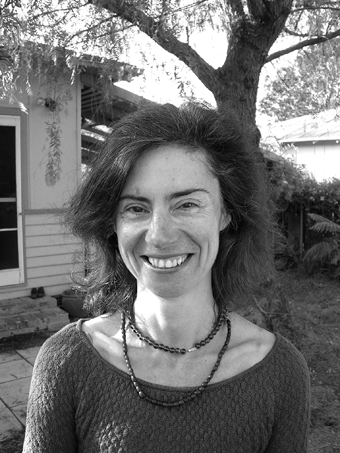
Zsuzsanna Soboslay
photo Tim Moore
Zsuzsanna Soboslay
Bio
I am a performer, writer and artist who has been engaged in creative collaborations across the arts for over 20 years. I teach and research in the tertiary, pre-school and community (including mixed ability) arts sectors, and write and create performances on the themes of environment, ecology, and the experience of refugees. I specialise in collaborative work across disciplines and have held residencies at Bundanon, ACT Early Childhood schools, the National Film and Sound Archive, Canberra Dance Theatre and in September I participated in the Kultour Gathering in Brisbane. Recent public performances include: National Gallery of Australia (a dance-biography of Jane Avril), CSIRO DANscienCE Week, Floating Land in the Noosa Biosphere.
Two current projects, Welcome/Unwelcome and Anthems and Angels are process-oriented performance/installations combining archival materials with real-time acoustic and electronic interactions, transforming fragments of sound, movement, and oral histories that constitute the memories of people in transition (from one country to another, into parenting, illness or ageing). Collaborators include Timothy Constable (Synergy Percussion), Kimmo Vennonen (sound), Franki Sparke (animations) and film-maker Michael K Chin (Tokyo Love-In).
www.bodyecology.com.au/; http://www.youtube.com/watch?v=1JOd6vmOR0U.
Exposé
I think art is a process of listening to something that is there, trying to become known. Essentially I think a critique is part of the same continuum—engaged in a process of deep listening to an experience that needs telling, seeing or performing.
Writing uncovers things I sense but around which I may not yet have a framework. The best performance works ignite sensations that reconfigure, or re-ignite, who or where I am in the world, and I find it almost a relief to write in order to understand what I have just witnessed unfold.
Works that fulfill themselves can be a delicate pleasure to discuss: works that are on the way can be more arduous, but equally demanding of full-blooded honesty.
Sometimes I feel my role is to hear the big voice of the small animal, particularly if it’s still struggling to make itself heard. I don’t’ always feel respected for that. I’ve tried to give up reviewing, but always the sense of honouring something that needs to be witnessed wins the day and I come back to it, again and again.
The best responses I’ve had to my reviews [whether on art, dance, theatre or music] have been ‘it’s just like I’m there alongside you’. With that kind of feedback, I feel I’ve fulfilled my role.
Selected articles
Opera: individual passion, collective tragedy
Zsuzsanna Soboslay: Sandra France, Helen Nourse, From a Black Sky
Lives surviving disarray
Zsuzsanna Soboslay: Urban Theatre Projects, Catalogue of DreamsRealTime issue #117 Oct-Nov 2013 p31
Sharing country
Zsuzsanna Soboslay: QL2’s Quantum Leap, Hit the Floor Together
RealTime issue #117 Oct-Nov 2013 p22
Asleep but awake and dancing
Zsuzsanna Sobolsay: QL2 Dance Theatre, Noplace
RealTime issue #110 Aug-Sept 2012 web
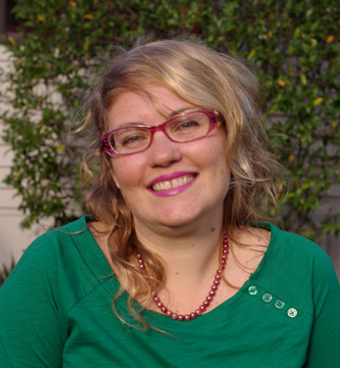
Kathryn Kelly
Bio
I only ever wanted to be a dramaturg when I grew up. I trained at the University of Queensland, where I did an Honours thesis on Australian female playwrights of the 1940s before heading over to Toronto to work as a freelance dramaturg.
Over the last decade or two I’ve run an international young playwrights festival (Interplay), a small publishing house (Playlab) and done my stints in arts policy for Arts Queensland. I’ve worked for all of the script development agencies in the country, had credits for shows with every professional company in Queensland and most of the independent ones. My dramaturgical practice includes new writing, contemporary performance, dance, circus and cabaret.
I am gladly freelancing again after the birth of my first child, Elsie, doing a PhD on how to teach dramaturgy while teaching dramaturgy around town at various universities, TAFE and, of course, reviewing for RealTime.
Exposé
My dramaturgical hero has always been the theatre critic Kenneth Tynan. Many love him for defining the eternal cultural hipster look: black turtleneck plus bottle-top glasses. I worship him because through sheer wit and intellectual capacity he wrested dramaturgy from the Germans and brought it into English theatre.
Alas, as a cuddly blonde I’ve never been able to pull off the black, but I have always wanted to review. Not in the snarky journalistic tradition that is the excuse for most of what fills up newspaper columns in Australia, but in the wholehearted and generous dramaturgical tradition of Tynan, who always sought to privilege new work and experimentation by finding a way to write about performance that opened it up even for the most conservative or disengaged of his readers. When we talk about ‘angry young men’ or ‘Brechtian gestus’ we are still swimming in Tynan’s sea.
In Australia, the professional performance sector is marginal, surviving through a perilous combination of public subsidy and individual artists’ passion. We practice, in our tribal groups, often trapped by the geographic boundaries of our city-states. We rarely have the time or money to look up.
RealTime is our way of making a national community of performance. As a long-term RT reader that is always why I have religiously picked up my copy, to find out what was happening elsewhere, to see who was making what with whom and whether it was any good?
And this is probably the thing that I treasure most about RT: I can rely on it to provide me with a balanced and articulate account of the national performance scene. This is no small feat. As Alison Croggon noted in the journal Kill Your Darlings on closing her very much missed blog, theatre notes, RT was the only useful source of theatre criticism when she started writing about performance. RT gives you the taste, the moment, the feeling of the show, and it has been so delicious to engage in performance writing in terms of legacy and context. Vive la RT!
Selected articles
Expecting the unexpected
Kathryn Kelly: La Boite Indie Season; Judith Wright Centre, Fresh Ground
RealTime issue #116 Aug-Sept 2013 p39
Celebrating the body: plasticity & mutation
Kathryn Kelly: exist-ence 5, festival of live art, performance art and action art
RealTime issue #116 Aug-Sept 2013 p40
Cultural resurgence on the Gold Coast
Kathryn Kelly, Gold Coast
RealTime issue #115 June-July 2013 p24
15 minutes of fame & death after supper
Kathryn Kelly
RealTime issue #114 April-May 2013 p44
Six artists, each in a room in the Grong Grong Motor Inn in the Riverina for a week in August, created works you can sample in a video about the project.
Video produced, edited and shot by Darrin Baker
You can also see more detail about works by
Scott Howie
Sarah McEwan
Darrin Baker
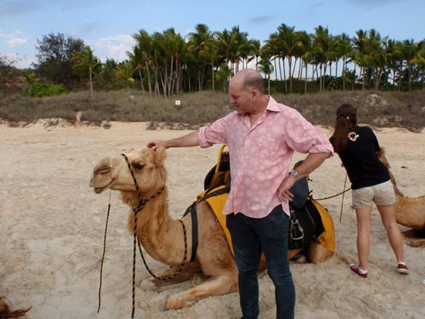
Stephen Carleton
courtesy the writer
Stephen Carleton
Bio
I began writing (and reviewing) for the theatre during student days at La Trobe University, Melbourne and was part of a queer political theatre collective called Gudrun’s Stockings that did work at La Mama, Midsumma and elsewhere. I formed Knock-em-Down Theatre in Darwin in 1997 with Gail Evans (we have since been joined by Mary Anne Butler) and have been writing professionally for the stage in Queensland, the NT and indeed nationally ever since. Career highlights include winning the Patrick White Playwrights’ Award in 2005 for my play Constance Drinkwater and the Final Days of Somerset and the New York New Dramatists Fellowship in 2006. These days I am based in Brisbane where I am currently head of Drama at UQ and teach across our broad historical program. Areas of research in my writing for the stage, my critical reviewing and my scholarly work include cultural geography, Australian theatre studies, Gothic theatre studies and postcolonial theatre.
Exposé
I’m describing myself first and foremost as a cultural geographer these days. This is a result, perhaps, of growing up in regional Australia (Far North Queensland and Darwin), where there was absolutely no literature, theatre, visual art, film or TV on the school curriculum that depicted the part of the country that I grew up in. Ray Lawler’s cane fields and Nicolas Roeg’s screen outback were the closest I ever got to a recognisable Australia during my early education. I resolved at a relatively early age—as a teenager, I reckon—to be part of the solution and to dedicate myself to ‘mapping’ my North Australia through critical and creative praxis.
It’s a genuine passion and lifelong commitment for me to see North Australian creative and cultural content build and take its place in the national conversation, whether my role in that process be as playwright, theatre critic, academic researcher or dramaturg of other writers’ practice. I am deeply interested in writers and performance makers who interrogate the geographical and political context in which they are generating work. This connectivity with audiences, location and the polity at large seems so much more vital to me than solipsistic and esoteric self-reflection or the communication of nothing to no one. That potentially sounds like a mundane statement of the self-evident, but I guess what I’m saying is that my passion is for live performance that seeks out an audience for an intelligent, adult conversation about the world from which it has been germinated. I’m also happy for comedy, satire and wit to be part of that interrogation.
Recent articles
Mercenary or hero?
Stephen Carleton: QTC, Mother Courage and Her Children
RealTime issue #116 Aug-Sept 2013 p44
Embracing the world
Stephen Carleton: Brisbane Powerhouse, World Theatre Festival
RealTime issue #114 April-May 2013 p45
Staging the really virtual
Stephen Carleton: A Hoax, La Boite; Making The Green One Red, QUT
RealTime issue #109 June-July 2012 p30
Reviews of Stephen Carleton’s Constance Drinkwater and the Final Days of Somerset
Regenerative inversions
Douglas Leonard
RealTime issue #75 Oct-Nov 2006 p8
NT’s festive season
Suzanne Spunner, 2007 Darwin Festival
RealTime issue #81 Oct-Nov 2007 p6
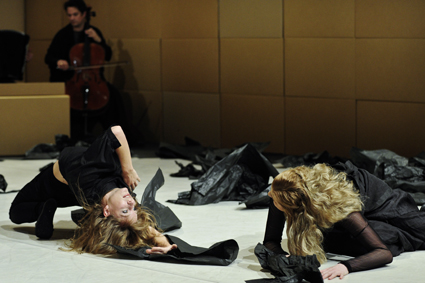
Abandon, Opera Queensland & Dancenorth
photo Bottlebrush Studios
Abandon, Opera Queensland & Dancenorth
The very title, Abandon, suggests the necessity to forsake any expectation of a cohesive narrative in Opera Queensland and Dancenorth’s recent collaboration in Townsville. The sensual elements of music, song, movement, lighting, costume and set conspired to take the viewer somewhere ancient and otherworldly; to ply them with a sequence of potent, if inexplicable, experiences; to risk whatever response might be incurred by such an open offering. Few were unmoved. My companion was in tears.
Abandon, though it courts an internal, emotional storm in its absence of narrative structure, has a finely honed aesthetic nonetheless. Dancenorth artistic director Raewyn Hill’s trademark richness-by-understatement was further enhanced by the deceptive plainness of the box-walled set, papered floor and restrained lighting—all orderly at the outset. The exquisite Baroque symmetry of the score, comprising arias by George Frideric Händel, provided an ordered aural underpinning to the movement, even as it lifted and dropped the audience’s collective heart rate. Fleeting references to mythical scenes during Abandon were distilled from the characters of the operas Tolomeo, Alcina, Orlando and Hercules and the cantata Acis, Galatea e Polifemo.
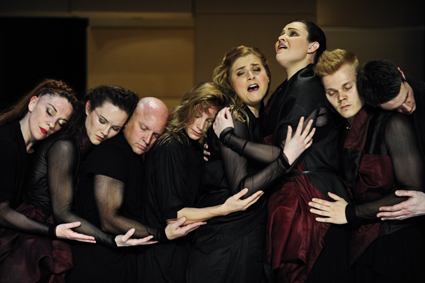
Abandon, Opera Queensland & Dancenorth
photo Bottlebrush Studios
Abandon, Opera Queensland & Dancenorth
All of the cast, including the two musicians (classical accordion, cello) wore black and wine-coloured goth-clerical garments by Alistair Trung. Like other elements of this production, the apparent austerity later gave way to some unexpectedly lush transformations. The integration of dancers and singers in the first wall to wall dance movements, disturbing the paper floor and adding a layer of rushing sound, was testament to Hill’s choreographic range, in that the four (previously non-dancing) singers were initially indistinguishable from the five dancers.
The musicians also moved around the set, becoming involved in the action at various points, most notably when accordionist James Crabb faced off, stamping counter rhythms while continuously playing, against Bradley Chatfield’s belligerent pugilist. Chatfield’s angry, feisty boxer, trying to corrall the rest of the cast, provided a comic contrast to Alice Hinde’s earlier heartrending solo; France Herve’s remarkable partnering with her own cascade of hair, as if it were another dancer; Erynne Mulholland’s fearful and imperious ten foot tall harpy; and Andrew Searle forcing the female cast into gaps which appeared in the box walls, as though playing a human Tetrus game.
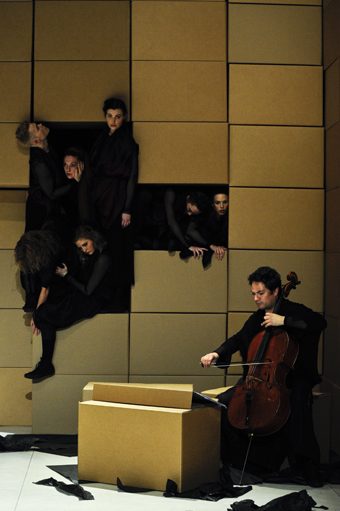
Abandon, Opera Queensland & Dancenorth
photo Bottlebrush Studios
Abandon, Opera Queensland & Dancenorth
The creators’ own description of Abandon notes that, “Unlike most baroque operas which travel from chaos to order, our trajectory seems to travel in the opposite direction.” Indeed, the emotional extremes were reflected in the gradual disintegration of the physical set, as high apertures and low drains opened up in the walls; the paper was flung, piled in corners, used for burial and dispersed again; and costumes were undone, let out, ballooned, removed and reassumed.
The lighting supported the changing sense of internal and external space perfectly, sometimes replicating the dramatic chiaroscuro of a Flemish painting in rare moments of relative physical and musical repose.
A journey sometimes defies explication, cannot always be recounted sequentially or logically, especially when much of it involves ephemeral sensations rapidly displacing one another, and intense connections made and lost. As if to emphasise this, in the final moments the walls are dismantled and rebuilt downstage to separate cast from audience, and we are abandoned to make of it what we will.
Abandon will be performed at the Brisbane Powerhouse, 21-23 February, 2014
Opera Queensland & Dancenorth, Abandon, co creators James Crabb, Raewyn Hill, Lindy Hume, music director James Crab, design Bruce McKinven, lighting Bosco Shaw, costumes Alistair Trung, School of Arts Theatre, Townsville, 24 July-1 Aug
RealTime issue #117 Oct-Nov 2013 pg. web
© Bernadette Ashley; for permission to reproduce apply to realtime@realtimearts.net
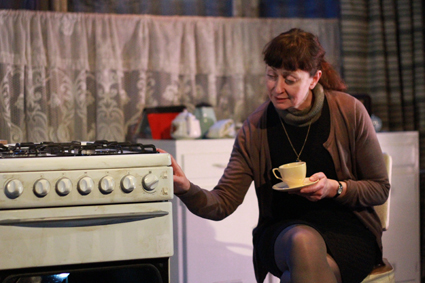
Caroline Lee, A Kind of Fabulous Hatred
photo Daisy Noyes
Caroline Lee, A Kind of Fabulous Hatred
In staging Barry Dickins’ fantastical script about Sylvia Plath’s suicide, director Laurence Strangio, contracts the expansive 45 Downstairs warehouse space into an intimate pocket; one situated before a foreboding barred window. Imaginatively transposed to London, England, February 11, 1963, the audience is further seduced by an attention to detail that often characterises Strangio’s directorial efforts.
Mattea Davies’ design is a microcosm of Sylvia Plath’s mental duress: punitive order set amongst emotional chaos, and accentuated by a Shakespearean storm that, apparently, was the worst ever recorded at that time in England. Thankfully, centre-stage is not consistently occupied by a self-gratifying human presence; instead there is a gas oven inside which a luminous pilot light reminds the audience that this appliance is both heater and exterminator. Plath was arguably of Jewish descent and, as in history, her grasp on life is as tenuous as the arbitrary decision that underpinned the Holocaust. Sylvia Plath will die tonight: this will be the celebrated poet’s last night on earth.
But before Plath dies she targets with vituperative animosity those, and those things, that she believes have contributed to, if not caused, her incandescent unhappiness. Here, Dickins’ florid script enters remarkable territory. But not before Caroline Lee as Sylvia Plath hurls bolts of disdain at writing and poetry, poets and writers, the banality of motherhood, publishers, miserable London winters, her miserable self and, by extension, British poet laureate, academic and adulterous husband, Ted Hughes. Dickins’ phantasmagoria of Plath’s demise proffers a Jungian framework for understanding her predicament. Alone in her London flat while Hughes is apparently out porking one of his literature students, Plath’s absent husband becomes the dominant subject of a diatribe against her inability to reconcile a very personal hatred of her own masculine persona. Hughes is simply the transparent figure in the mirror, behind which lurks Sylvia Plath’s divided and irreconcilable self.
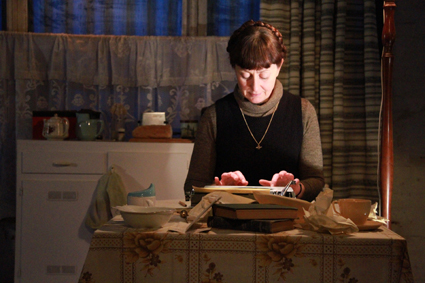
Caroline Lee, A Kind of Fabulous Hatred
photo Daisy Noyes
Caroline Lee, A Kind of Fabulous Hatred
Quite possibly, self-loathing kills more people than Jack the Dancer. Dickins understand this, and by concentrating Plath’s hatred for others upon herself, his decision to write an embellished, interior monologue, irrespective of the difficulties associated with performing such, is, in retrospect, both insightful and accurate. Form should reflect content.
But a difficult night in the theatre is one not easily justified. Sometimes, though, an audience should be prepared to sacrifice cosy entertainment for the demands of understanding the pathology of one of the 20th century’s more controversial poets and a prominent literary figure. Dickins, too, has made sacrifices. A Kind of Fabulous Hatred is a serious work from an Australian writer who is sometimes perceived as a nostalgic humourist. I don’t necessarily agree with this view. There is, I believe, more to Dickins’ writing than meets the ‘I.’ The usual Dickins’ idiosyncrasies are few here. A Kind of Fabulous Hatred is a provocative play that grapples with, and illuminates, clinical depression; a mental health condition that, for reasons prejudicial and economic, remains a lingering taboo in the 21st century.
A Kind of Fabulous Hatred, writer Barry Dickins, director Laurence Strangio, performer Caroline Lee, design Mattea Davies, lighting Bronwyn Pringle, sound Anita Hustas, 45 Downstairs, Melbourne, 12-22 Sept; http://www.fortyfivedownstairs.com/
RealTime issue #117 Oct-Nov 2013 pg. web
© Tony Reck; for permission to reproduce apply to realtime@realtimearts.net
![1) 7bit Hero; 2) Sha Sarwari, Asylum Seeker; Vidhi Shah and Jeniffer Heng, Flow[er]; 2high Festival](https://www.realtime.org.au/wp-content/uploads/art/70/7091_2high.gif)
1) 7bit Hero; 2) Sha Sarwari, Asylum Seeker; Vidhi Shah and Jeniffer Heng, Flow[er]; 2high Festival
courtesy the artists
1) 7bit Hero; 2) Sha Sarwari, Asylum Seeker; Vidhi Shah and Jeniffer Heng, Flow[er]; 2high Festival
2high Festival, Brisbane Powerhouse
Curated by young and emerging producers under the watchful eye of Backbone Arts the 2high Festival is a one-day explosion of music, visual arts and performance that will take over the Brisbane Powerhouse complex. Highlights look to be the part pop concert, part video game experience of 7bit Hero (http://7bithero.com/) where the audience can use their phones as joysticks to participate in the game that plays behind the live band. Afghani refugee Sha Sarwari will exhibit his three-metre boat made entirely from newspapers and Vidhi Shah and Jeniffer Heng have created a flower from recycled electrical materials which blossoms in your presence. There are also back-to-back dance and theatre performances from emerging makers such as Matt O’Neill, Robert Millet, Dead Owl Factory, Courtney Scheu & Mariana Paraizo.
Backbone Arts: 2high Festival, Brisbane Powerhouse, 2 Nov, http://2highfestival.com.au/
Carnival of the Bold, Changemakers Festival
The Changemakers Festival is an umbrella structure (run by Social Innovation Xchange) linking a plethora of activities around Australia seeking social change and the building of better communities. One of these events, Carnival of the Bold at the New Theatre, Newtown, brings together “artists and other leaders who drive important issues of our time—to create deeper engagement around social causes” (website). The event will feature talks and performances by political satirist Simon Hunt aka Pauline Pantsdown, Indigenous artist and activist Adam Hill aka Blak Douglas, social change photographer Mikey Leung and children’s book author Melanie Lee in an evening hosted by that cultural chameleon Paul Capsis.
Changemakers Festival, national 1-10 Nov; http://changemakersfestival.org/; Carnival of the Bold, New Theatre, Newtown, 9 Nov; http://changemakersfestival.org/event/carnival-of-the-bold/
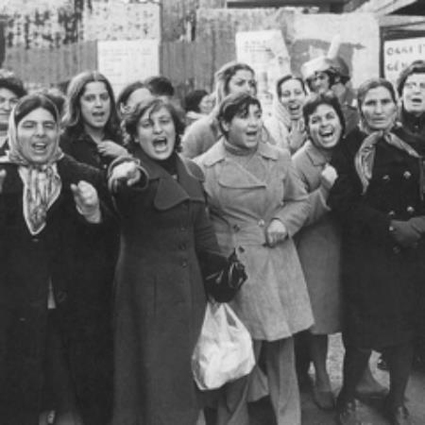
My Avant-Garde Is Bigger Than Yours, Kings ARI
courtesy the gallery
My Avant-Garde Is Bigger Than Yours, Kings ARI
My Avant-Garde Is Bigger Than Yours, Kings ARI
At the now decade-old Kings ARI, My Avant-Garde Is Bigger Than Yours, curated by Nik Papas, investigates humour, sarcasm, irony and parody using as a starting point Sigmund Freud’s Jokes and their Relation to the Unconscious (1905). Delivering a barrel of art laughs will be Boe-Lin Bastian, Damiano Bertoli, Jessie Bullivant, Cheryl Conway, DAMP, Sue Dodd, Marco Fusinato, Tamsin Green, Raafat Ishak, Danius Kesminas, Yvette King, Lucas Maddock and Madé Spencer-Castle.
My Avant-Garde Is Bigger Than Yours, Kings ARI, 1-23 Nov 2013; http://www.kingsartistrun.com.au/
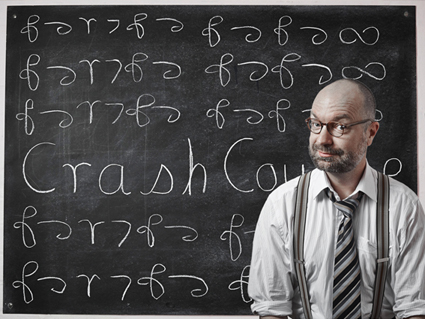
James Berlyn, Crash Course
Crash Course, James Berlyn
Following the success of last week’s Proximity Festival which he co-founded, James Berlyn is about to present his own intimate, participatory theatre piece (see the forthcoming review in RT118). Based on his experience as an English teacher and utilising his own fictional language, Winfein, Berlyn’s Crash Course takes 24 audience members on a performative language learning expedition.
Crash Course, creator/performer James Berlyn, director Nikki Heywood, producer Performing Lines WA, PICA, 14-30 Nov; http://www.pica.org.au/view/Crash+Course/1745/
![Asiga, [CTRL][P] Objects on Demand](https://www.realtime.org.au/wp-content/uploads/art/70/7096_loop_object.jpg)
Asiga, [CTRL][P] Objects on Demand
courtesy of the Artist (COTA)
Asiga, [CTRL][P] Objects on Demand
[CTRL][P] Objects on Demand, Object Gallery
Once a near-future speculation, 3D printing is rapidly become part of our now. While we don’t yet all have our own personal 3D fabricator, it probably won’t be long. While you’re waiting for them to appear in Officeworks, you can pop into Object Gallery which, with the help of Courtesy the Artist (COTA), has been transformed into a 3D printing hub. Designers-in-residence Cinnamon Lee, Angus Deveson, Mitchell Bailey and Cesar Cueva will be creating objects, manufactured on demand, to be exhibited and sold in a pop-up shop. There will also be workshops where professional designers and the general public can try out the technology.
[CTRL][P] Objects on Demand, Object Gallery 15 Oct 2013 – 25 Jan 2014; http://www.object.com.au/exhibitions-events/entry/ctrl_p_objects_on_demand/; http://ctrlp.com.au/
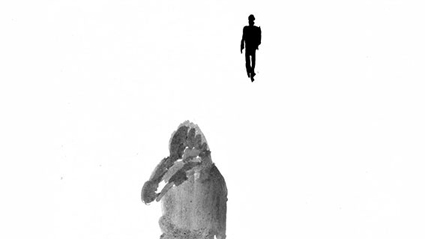
Lorraine Heller-Nicholas, Love Story
Lorraine Heller-Nicholas, Love Story, Videobrasil
Melbourne-based animator Lorraine Heller-Nicholas is one of two Australian artists invited to exhibit as part of Videobrasil’s Southern Panoramas program (the other is Paris-based Bridget Walker). Heller-Nicholas’ 13-minute animation using ink drawing, with sound by Alice Hui-Sheng Chang, explores the cycle of love and heartbreak with a poignancy that comes from simplicity and repetition. You can view it and more of the artist’s work here.
Southern Panoramas, 6 Nov-2 Feb; http://site.videobrasil.org.br/festival/arquivo/festival/programa/1589140
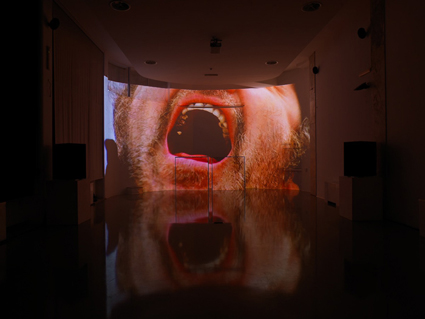
Daniele Puppi, CINEMA RIANIMATO N.3, 2012, audio-visual installation, images from The Shout–a film by Jerzy Skolimowski
courtesy the artist and Magazzino Gallery, Rome
Daniele Puppi, CINEMA RIANIMATO N.3, 2012, audio-visual installation, images from The Shout–a film by Jerzy Skolimowski
Daniele Puppi 432 Hertz, Cinema Rianimato e Dintorni, AEAF
Rome-based artist Daniele Puppi is currently in residence at Adelaide’s AEAF presenting his first major solo show in Australia. His large-scale audiovisual installations “envelop the viewer with their physicality and stage mundane, everyday actions as profound” (website). Information is hard to find on this elusive artist so we suggest attending his artist talk, Nov 1.
Daniele Puppi 432 Hertz, AEAF, 1 Nov-7 Dec; http://www.aeaf.org.au/exhibitions/danielepuppi.html
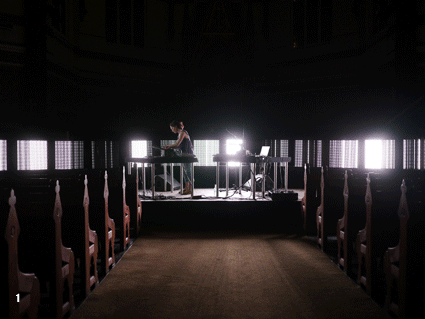
1) Voice, Maja Solveig Kjelstrup Ratkje, photo HC Gilje; 2) Yannis Kyriakides, The Buffer Zone, photo Peter Kiers; 3) Michaela Davies, Compositions for Involuntary Strings, courtesy the artist; Sonica 2013
Sonica, Glasgow
For those in the UK, the second installment of Sonica looks very impressive. Produced by Cryptic, the festival presents a weekend of “sonic art for the visually minded” (press release) including the UK premier of the audio-visual duet by Maja Solveig Kjelstrup Ratkje and light designer HC Gilje (Norway) and a multimedia opera by Yannis Kyriakides, The Buffer Zone, using field recordings from Cyprus of UN soldiers, nature and military technology combined with piano and cello. French artists Robin Meir and Ali Momeni will harness the mating behaviour of live mosquitoes in their interactive installation Truce: Strategies for Post-Apocalyptic Computation. Sonica also features an artist-in-residence and the curators seem to like Australians. Last year it was Robin Fox and this year it’s Michaela Davies who will be presenting her Compositions for Involuntary Orchestra. See our recent In Profile article for more.
Cryptic: Sonica, curators Cathie Boyd, Graham McKenzie and Patrick Dickie; 31 Oct-3 Nov; http://www.sonic-a.co.uk/
Still in the loop
Simple Forces, Joyce Hinterding
BreenSpace
25 Oct-23 Nov
http://www.breenspace.com/
Reinventing the Wheel: the Readymade Century
MUMA
3 Oct-14 Dec
http://www.monash.edu.au/muma/exhibitions/upcoming/readymade.html
The Double World, tranSTURM
Newington Armory, Sydney Olympic Park
19 Oct-10 Nov
http://www.sydneyolympicpark.com.au/whats_on/arts_and_culture_events/exhibition_the_double_world_spr13
http://cargocollective.com/transturm/the-double-world
Bogong ELECTRIC
Bogong Village, North East Victoria
1 Nov-1 Dec
http://bogongsound.com.au/
RealTime issue #117 Oct-Nov 2013 pg. web
© RealTime ; for permission to reproduce apply to realtime@realtimearts.net
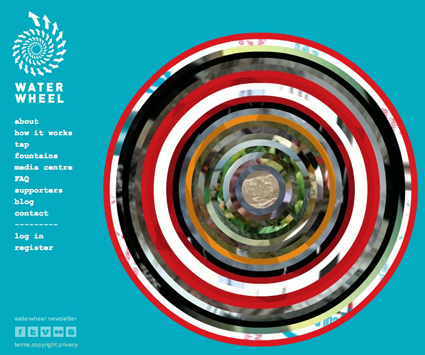
Waterwheel
Waterwheel Symposium Call for Participation
Waterwheel is an online platform for interdisciplinary discussions, performance and interaction around the subject of water (see our interview with founder Suzon Fuks). Waterwheel is currently calling for proposals from artists, scientists and thinkers to present artworks, performances and papers at the next symposium in March 2014 focusing on the theme “Water Views—Caring and Daring.” Proposals are also invited from young people (under 18 years) to take part in their Voice of the Future Youth Day.
Proposals for Symposium due 22 Nov; proposals for Voice of the Future Youth Day, 31 Dec; http://water-wheel.net/
Editor, Un Magazine
Un Projects, producer of the very neat and informative Melbourne-based art magazine, is seeking an editor for their two issues in 2014. Editions are published June & Nov and there is a fee of $3000 per edition.
Applications due 25 November 2013; http://unprojects.org.au/magazine/contribute/
Courthouse Arts Visual Arts Program
Courthouse Arts in Geelong is seeking expressions of interest from individuals or artist collectives aged 12-26 who are interested in curating the venue’s 2014 visual arts program.
EOIs due 15 Nov; http://courthouse.org.au/on-now/searching-for-a-young-curator-for-2014/
CCP Salon 2013
Now in its 21st year the CCP Salon (presented by Leica and Ilford ) is Austalia’s largest open-entry, photo-media exhibition and competition. There’s $20,000 in prize money up for grabs across 23 categories and the entry deadline has been extended.
Deadline 8 Nov; http://www.ccp.org.au/salon_2013.php
Still in the loop
AEAF—emerging + experimental curators
Applications due 8 Nov
www.eaf.org
Renew Sydney: Leichhardt
Proposals due 8 Nov
http://www.renewaustralia.org/2013/10/renew-australia-comes-to-sydney-with-renew-leichhardt/
First Draft Directors 2014-2015
Deadline 8 Nov
http://firstdraftgallery.com/get_involved/firstdraftwantsyou
Selected Australia Council Grant Deadlines
(for full list go to http://www.australiacouncil.gov.au/grants
Music: Presentation and Promotion – 18 November 2013
http://www.australiacouncil.gov.au/grants/2013/music-presentation-and-promotion-18-november
Music: New Work – Writing and Recording – 18 November 2013
http://www.australiacouncil.gov.au/grants/2013/music-new-work-writing-and-recording-18-november
Aboriginal and Torres Strait Islander: Skills and Arts Development –
19 November 2013
http://www.australiacouncil.gov.au/grants/2013/aboriginal-and-torres-strait-islander-arts-skills-and-arts-development-19-november
Aboriginal and Torres Strait Islander: Presentation and Promotion-
19 November 2013
http://www.australiacouncil.gov.au/grants/2013/aboriginal-and-torres-strait-islander-arts-presentation-and-promotion-1-april
Aboriginal and Torres Strait Islander: The Dreaming Award –
19 November 2013
http://www.australiacouncil.gov.au/grants/2013/dreaming-award
Aboriginal and Torres Strait Islander: Fellowships –
19 November 2013
http://www.australiacouncil.gov.au/grants/2013/aboriginal-and-torres-strait-islander-arts-fellowships
Aboriginal and Torres Strait Islander: The Red Ochre Award –
19 November 2013
http://www.australiacouncil.gov.au/grants/2013/red-ochre-award
Aboriginal and Torres Strait Islander: New Work –
19 November 2013
http://www.australiacouncil.gov.au/grants/2013/aboriginal-and-torres-strait-islander-arts-new-work-19-november
Visual Arts Travel Fund – 25 November 2013
http://www.australiacouncil.gov.au/grants/2013/Visual-Arts-Travel-Fund
Contemporary Music Touring Program – 25 November 2013
http://www.australiacouncil.gov.au/grants/2013/contemporary-music-touring-program-25-november
RealTime issue #117 Oct-Nov 2013 pg. web
© RealTime ; for permission to reproduce apply to realtime@realtimearts.net
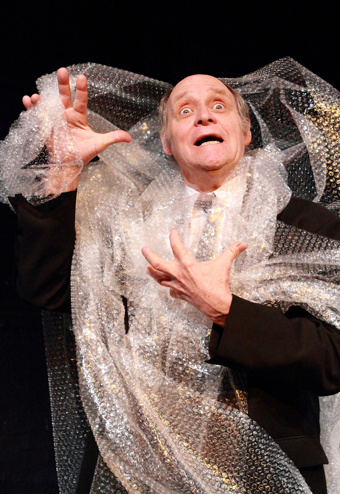
Jim Daly, John Gabriel Borkman
If the road to perdition is paved with treacherous ice then a pathway into director, Peter King's scathing interpretation of Henrik Ibsen's John Gabriel Borkman sometimes glitters with gold.
As if electrified, male performer Cory Corbett as Borkman’s maniacal wife Gunhild rips away a sheet from 'her' body and the play begins. Upstairs, pacing back and forth for the last decade or so, resides the disgraced title character of this play, John Gabriel Borkman: estranged husband of Gunhild, former lover of her twin sister Ella, hated father of his son Erhart and, above all, a man guilty of embezzlement who has not only destroyed his family's reputation but after spending time in jail, has quietly gone mad in response to a self-imposed exile from what he, Borkman, perceives as a cruel and heartless world. Ibsen's script immediately ensnares its audience in a penultimate endgame. It remains to be seen just who will survive this winter's night, one comprising loneliness and deception, alienation and hatred, insanity and mortifying despair.
King's direction utilises expressionist acting techniques rarely seen in Australian theatre. Jim Daly as Borkman and Russell Walsh as his emotionally deformed acolyte, Vilhelm Fodal, extract from King's direction much humour (some cartoon inspired) and a wistful evocation of the emotional wilderness that characterises most, if not all, the characters in this play. As Borkman is persuaded by his sister-in-law and former lover, Ella, to descend the stairwell of his self-imposed cell and challenge his psychotic wife Gunhild for custody of Erhart, the audience becomes witness to a remarkable display of physical endurance, technical concentration and ensemble acting.
During a four act performance without interval, extending across 100 minutes, the actors form themselves into grotesque physical images, spit out Ibsen's caustic familial vision with cobra-like accuracy and ultimately give expression to the playwright's view of a Christian theology that rages against the dying of its own light. Outside, the universe is cold and uninviting. Borkman's eventual death is not an ascent to heaven but instead, a descent into a symbolic mire. He will die in the snow with a “metal hand” wrenching life from his breast and, perhaps for the first time, God is pronounced dead in a theological wilderness suspended above a bottomless fjord, one carved from granite and ice rather than wrought from any supercilious religious force.
Mounting this production has been director Peter King's obsession, perhaps for some time. His directorial strategies are metaphorical and often abstract. But it remains clear that King himself is precise when considering how he interprets Ibsen's confrontation with the divine, and how he wishes to express this interpretation. That said, and within a bubble-wrapped set designed by Peter Corrigan and succinctly lit by Greg Carroll, the protective walls we erect in our delusional lives are no match for the seething hatreds that drive the thanatological personality. Unrestrained, it will drive each of us into that which Thanatos most desires—an abyss void of God and organised religion, one characterised by secular annihilation and the interminable passing of time.
John Gabriel Borkman, writer Henrik Ibsen, translation Peter Archer, director Peter King, performers Jim Daly, Cory Corbett, Ezuk Doruk, Will Freeman, Russell Walsh, designer Peter Corrigan, lighting Greg Carroll, La Mama, Melbourne, 18-29 Sept
See also Jana Perkovic's account of a 12hour version of John Gabriel Borkman at Theatretreffen, Berlin, 2012
RealTime issue #117 Oct-Nov 2013 pg. web
© Tony Reck; for permission to reproduce apply to realtime@realtimearts.net
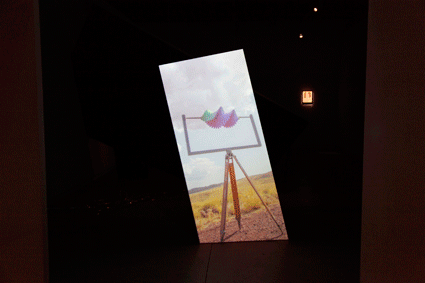
Benjamin Ducroz, cumulo, installation
photos Eugenia Lim
Benjamin Ducroz, cumulo, installation
For an ‘inaugural’ artist-led festival based around a relatively young art form, the Channels video art festival was weighty: a packed four-day program including close to 100 artists, curators and speakers; a level of curatorial and critical engagement that significantly amplified the impact of the work itself; and not least, a substantial printed catalogue that ably focused ideas, themes and relationships across the program.
Encompassing gallery-based installation, projections, online broadcast, a voluminous screening program and public talks, Channels’ central question was, say co-directors Rachel Feery, Eugenia Lim and Jessie Scott, “What is video art now?” Sounds simple, even simplistic—but one of the many impressive things about Channels was its genuine consideration of the question: its showcasing of contemporary video work with reference to the history of the form and a conscious engagement with the ubiquitous ‘now’ of mass-media video immersion.
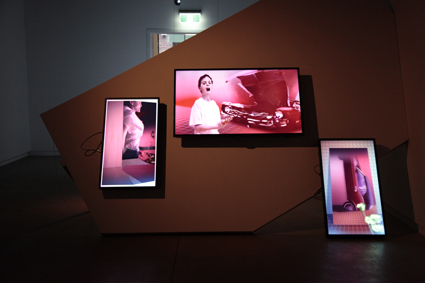
Ms&Mr, Amputee of the Neurotic Future 1988/2012, installation
photo Eugenia Lim
Ms&Mr, Amputee of the Neurotic Future 1988/2012, installation
Installed
Transformer, at Screen Space, was the exhibition for Channels, featuring works commissioned from Ms&Mr (aka Australian-Canadian duo Stephanie and Richard nova Milne) and Melbourne-based Benjamin Ducroz. In Ducroz’ cumulo, piles of roiling Pilbara storm clouds dissolve into the incremental movements of a hand-cranked, helical kinetic sculpture. Both phenomena are filmed in stop motion, in the landscape; but while the sped-up movement of the clouds is familiar thanks to its TV-doco ubiquity, the brightly coloured sculpture, stark in the middle of the desert, is surreal, seeming almost to be superimposed. Shifting between romanticism and deconstructivism, cumulo is projected onto a tall, trapezoidal screen at the gallery entrance accompanied by a soundtrack of ambient, insecty, subtle, sometimes ominous tones. The sublime vision of clouds—creamy, silver-lined or darkly grey—prefigured the misty pines and crumbling glaciers of some of the more meditative works in Channels’ Video Visions screening program. At the same time, the stepped structure and block colours of the moving model insist on time’s breakdown into increments, dancing with the origins of time-based photography. If it weren’t for Ducroz’ process work in the nearby foyer, where the sculpture is seen ‘on set’ in the desert, the quasi-scientific, twirling helix could easily be read as a 3D animation. In a sense, romantic ‘truth’ meets disbelief in cumulo.
A warping, monotonal drone is the backdrop for Ms&Mr’s three-channel work, Amputee of the Neurotic Future 1988/2012, part of their ongoing Videodromes for the Alone series. A distressed and silently howling prepubescent boy is protagonist in a fractured world of film and 3D animation, surrounded by symbolic props—a crashed and sinking car, a hospital gown apparently animated from within, a CAD-drawn checkered floor, an uncannily defocused bunch of flowers. With references to both J G Ballard and David Cronenberg, the mood is dystopian, painful and alienated, but washed out by blood-red monochrome into a kind of emotionless absence: an escape from horrifying realities that itself becomes horrifying.
Screened
The main screening program, Video Visions, provided an astonishingly broad survey of current video art from Australian and international artists over two intensive sessions on one night. Loosely themed into four sections—Sensory Drive, Media Mash-Ups, Constructed Worlds and Bodies Collide—Video Visions included dozens of short works; the choice to include an interval in each session created just the right breathing space.
There’s not enough room here to describe the breadth of works in the Video Visions program but some overall themes were evidenced, both in the overarching session titles and more subtly. The Media Mash-Ups and Bodies Collide sessions were the most tightly focused and, interestingly, the most reliant on humour, as though both the onslaught of mass culture and our visceral, physical reality can only be confronted with a grimace or an outright laugh. Sensory Drive crossed from virtuosic, psychedelic experiments with CGI ‘super-natures’ to formalistic explorations of colour, line or natural phenomena. Narrative seemed to emerge most strongly in Constructed Worlds, as though a ‘world’—even a fictitious or abstract one most requires a story. Noticeably weaving throughout the program were frequent evocations of mysticism and suggestions of what seemed like ‘earth-nostalgia:’ conflations of human/nature; eerie, hollow and ominous soundtracks; and the sense of worlds lost.
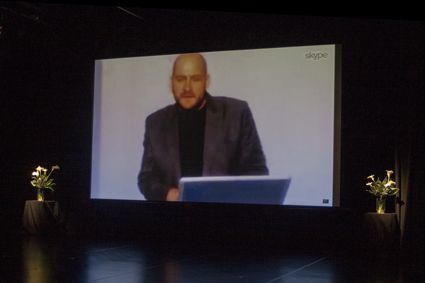
Emile Zile, Random Name Generator Memorial Roll Call, Memory Screens
photo Danielle Hakim
Emile Zile, Random Name Generator Memorial Roll Call, Memory Screens
Performed
The intersection between video and performance art, past and present, was the inspired starting point for the Memory Screens program in which artists Salote Tawale, Hannah Raisin and Emile Zile each presented newly commissioned works paying homage to selected iconic works by video and performance “elders.” As well as live performances of the three new works, excerpts were screened both from the artists’ previous output and from the chosen ‘source’ works.
Emile Zile, whose work to date humorously interrogates and replays conventions and tropes of cinema, television and the web, chose as inspiration Ant Farm’s 1975 Media Burn in which a Cadillac smashes through a pile of burning TV sets. In the most oblique response of the three artists, his new performance (via Skype), Random Name Generator Memorial Roll Call, comprised a tongue-in-cheek, funerary video roll call of randomly generated, unborn internet users, accompanied by vases of white lilies.
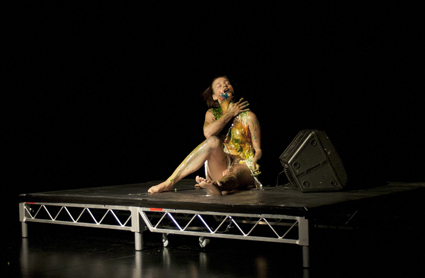
Hannah Raisin, Dear Carolee, Love Cindy, Love Hannah, Memory Screens
photo Danielle Hakim
Hannah Raisin, Dear Carolee, Love Cindy, Love Hannah, Memory Screens
Hannah Raisin, responding to Carolee Schneeman’s Interior Scroll, chose Cyndi Lauper’s “Girls Just Wanna Have Fun” as soundtrack to her absurd and confronting consumption of raw eggs injected with coloured dyes. Echoing Schneeman, whose 1975 performance consisted of extracting a long scroll from her vagina, in Dear Carolee, Love Cindy, Love Hannah, Raisin provided the music via an audio cable drawn from her vagina (presumably attached to an inserted MP3 player) and plugged into a stage monitor. The effect blurred feminist statement and monstrous-feminine, hinted at porn and vigorously challenged the gaze.
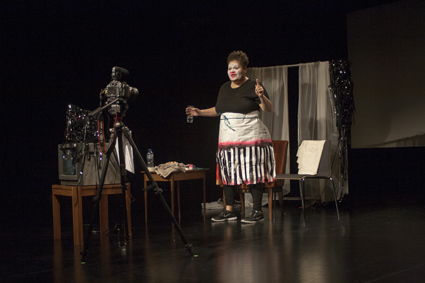
Salote Tawale, Dressing Up, Memory Screens
photo Danielle Hakim
Salote Tawale, Dressing Up, Memory Screens
Most directly referential was Salote Tawale’s response to Susan Mogul’s 1973 video, Dressing Up. As she slowly gets dressed, Mogul delivers a monologue on the clothes her mother made her wear as a child while periodically stuffing her mouth with snack food. Tawale recreated Dressing Up, delivering her own story of childhood female oppression, inextricably woven with the threads of her Pacific Islander heritage. It was a powerful end to a session that exemplified the strengths of Channels overall: its engagement across a broad thematic range, critical depth through discussion, and the commissioning of new work; and the imaginative contextualising of contemporary practice through the lens of history.
Channels: The Australian Video Art Festival, various venues, Melbourne, 18–21 Sept; http://www.channelsfestival.net.au/
This article first appeared in RT’s online e-dition 23 Oct, 2013
RealTime issue #118 Dec-Jan 2013 pg. web
© Urszula Dawkins; for permission to reproduce apply to realtime@realtimearts.net
Prick up your ears for this in the loop which offers a burst of sonic happenings across the country, plus some dance and theatre to balance the mix.
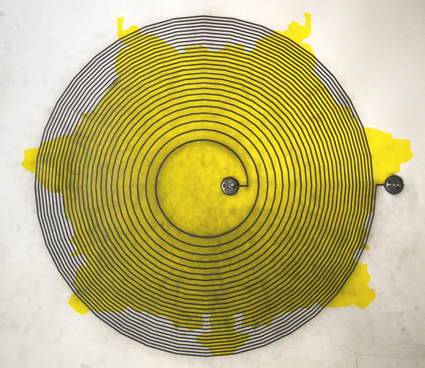
Joyce Hinterding, Fields and loops: series 4, 2010, ink and graphite on paper
courtesy the artist and BreenSpace
Joyce Hinterding, Fields and loops: series 4, 2010, ink and graphite on paper
Simple Forces, Joyce Hinterding, BreenSpace
Marrying “deep science” and elegant aesthetics, Joyce Hinterding’s upcoming solo exhibition at BreenSpace, Simple Forces, seeks to transform “matter into ideas, and ideas into matter” (website). Using forms and symbols drawn from algorithmic structures, the graphite shapes also create circuits which, when amplified, make invisible atmospheric forces audible.
Joyce Hinterding, Simple Forces, BreenSpace, 25 Oct-23 Nov; http://www.breenspace.com/
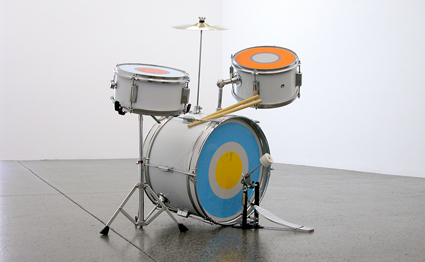
Reinventing the Wheel: The Readymade Century – Julian Dashper, ‘Untitled (The warriors)’ 1998
Reinventing the Wheel: the Readymade Century, MUMA
Now showing at MUMA, Reinventing the Wheel celebrates Marcel Duchamp’s liberating declaration that the any object, in the right context, can become art. It follows the momentum of this idea through the 20th century and into the 21st, featuring the work of over 50 artists ranging from international historic figures, including Carl Andre, Andy Warhol and Gilbert & George, to Australian contemporary artists John Nixon, Ricky Swallow, James Lynch, Agatha Gothe-Snape and others. Accompanying the exhibition, a series of music events, Found Sound, explores John Cage’s celebration of the aural readymade. The final installment (Oct 26) will feature Joyce Hinterding and Lawrence English.
Reinventing the Wheel: the Readymade Century, MUMA, 3 Oct-14 Dec; http://www.monash.edu.au/muma/exhibitions/upcoming/readymade.html
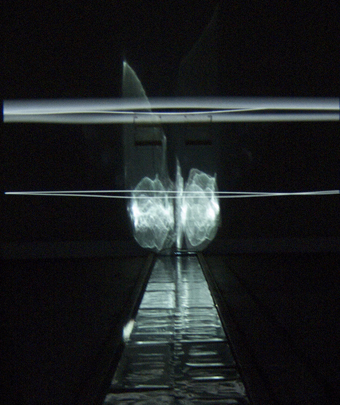
Chamber 1 (Order), Chris Bowman, Michael Day, Rachael Priddel, Colin Black, The Double World, transTURM collective
courtesy the artists
Chamber 1 (Order), Chris Bowman, Michael Day, Rachael Priddel, Colin Black, The Double World, transTURM collective
The Double World, tranSTURM, Newington Armory
Taking over one of the cavernous spaces of the Armory at Olympic Park, the UTS-supported tranSTURM collective has created a “double world” of light, sound and animation. Drawing inspiration from Rainer Maria Rilke’s poetic exploration of the Orpheus myth the installation has been created by a collective of Australian and international designers, architects and media artists under the creative directorship of Chris Bowman. The installation also features a soundtrack by Colin Black and choreography (displayed as mapped video) by Meryl Tankard.
The Double World, tranSTURM, Newington Armory, Sydney Olympic Park, 19 Oct-10 Nov; http://www.sydneyolympicpark.com.au/whats_on/arts_and_culture_events/exhibition_the_double_world_spr13; http://cargocollective.com/transturm/the-double-world
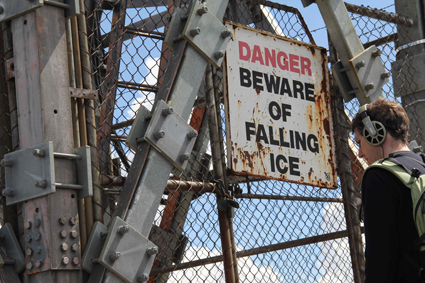
Christophe Charles, Bogong ELECTRIC
Bogong ELECTRIC
Following the success of the Bogong AIR festival in 2011 (see review), Philip Samartzis and Madelynne Cornish have been establishing a permanent home for sonic exploration in the village of Bogong in the north-eastern alps of Victoria. Now settled in the restored schoolhouse, the Bogong Centre for Sound Culture (BCSC) will soon present Bogong ELECTRIC, a month of performance and installations using the Kiewa Hydroelectric scheme as the starting point for investigations around natural and built environments. Guest artists include Michael Vorfeld (Germany) using the inherent noises of electric devices like light bulbs and switches to produce audio performances; Christophe Charles (Tokyo) creating an underwater soundscape to be listened to while on the lake; Geoff Robinson (Melbourne) transposing a sonic map from one area to another; and David Burrows (Melbourne) experimenting with stereographic imaging. The BCSC will also be offering a range of educational opportunities and registrations are now open for a masterclass with Samartzis in Feb 2014.
Bogong ELECTRIC, Bogong Village, North East Victoria; 1 Nov-1 Dec; http://bogongsound.com.au/
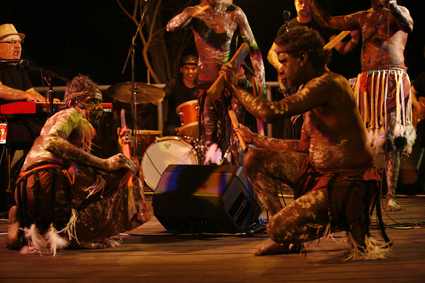
AAO & Wagilak songmen, Crossing Roper Bar
Crossing Roper Bar, AAO
RT Managing editors Keith Gallasch and Virginia Baxter were lucky enough to see an early manifestation of Crossing Roper Bar at the Darwin Festival in 2008 (see review). This unique collaboration between the Australian Art Orchestra and the Wagilak songmen from Ngukurr in East Arnhem Land has continued to evolve, now featuring Broome singer/songwriter Stephen Pigram (replacing the late Ruby Hunter). This very special concert has been touring West Australia and there are few shows left to catch in Karatha, Exmouth and Perth.
Tura New Music & Australian Art Orchestra: Crossing Roper Bar, AAOO with the Wagilak songmen and Stephen Pigram; Karratha, 25 Oct, Exmouth, 27 Oct, Perth, 29 Oct: http://crbtour13.tura.com.au
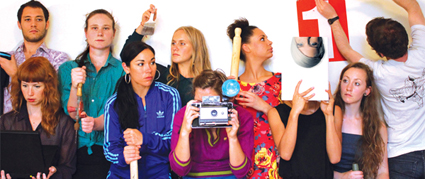
Dance Makers Collective, Carl Sciberras, Anya Mckee, Leeke Griffin, Marnie Palomares, Katina Olsen, Miranda Wheen, Sophia Ndaba, Jenni Large, Rosslyn Wythes, Matt Cornell
photo Anya Mckee & Dance Makers Collective
Dance Makers Collective, Carl Sciberras, Anya Mckee, Leeke Griffin, Marnie Palomares, Katina Olsen, Miranda Wheen, Sophia Ndaba, Jenni Large, Rosslyn Wythes, Matt Cornell
Big Dance in Small Chunks, Form Dance Projects
This premier performance for the Dance Makers Collective brings together 10 emerging dancers and choreographers to collaborate with each other as well as filmmakers, musicians, visual artists and designers (including Erth Visual and Physical Theatre) to present nine ambitious new pieces. We’re particularly curious about the performance described by Miranda Wheen (connecting Eddie Obeid with his pelvis) in her recent RT Profile.
Form Dance Projects: Big Dance in Small Chunks, Dance Makers Collective (Matt Cornell, Jenni Large, Anya Mckee, Sophia Ndaba, Melanie Palomares, Katina Olsen, Marnie Palomares, Carl Sciberras, Miranda Wheen and Rosslyn Wythes); Lennox Theatre, Riverside 23 – 26 Oct; http://form.org.au/2013/01/dance-makers-collective/
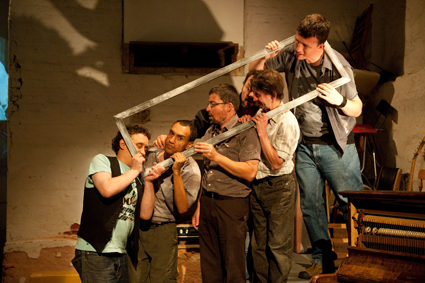
Sons & Mothers, No Strings Attached Theatre of Disability
courtesy the company
Sons & Mothers, No Strings Attached Theatre of Disability
Sons and Mothers, No Strings Attached Theatre of Disability
Following its highly successful premier season at the Adelaide Fringe in 2012 No Strings Attached’s production Sons & Mothers is currently enjoying a full season at the Space Theatre. The group-devised work presents the stories of six men with disabilities and their relationship with their mothers. A feature documentary on the process of developing the show has also just screened as part of the Adelaide Film Festival. See the review of both film and stage production in RT118.
Adelaide Festival Centre and Windmill Theatre: Sons and Mothers, No Strings Attached Theatre of Disability, writer, devisor and director Alirio Zavarce, with and for the Men’s Ensemble of No Strings Attached; Space Theatre, Adelaide Festival Centre; 17-26 Oct; http://www.nostringsattached.org.au/sons-and-mothers-2013.html
RealTime issue #117 Oct-Nov 2013 pg. web
© RealTime ; for permission to reproduce apply to realtime@realtimearts.net
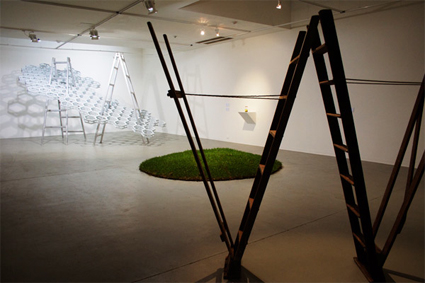
B l o o m—S p a c e, (Installation view) 2013.
Background Roy Ananda; middle ground Carla Liesch; foreground Will French; curated by Adelé Sliuzas
photo Alex Lofting
B l o o m—S p a c e, (Installation view) 2013.
Background Roy Ananda; middle ground Carla Liesch; foreground Will French; curated by Adelé Sliuzas
AEAF—emerging + experimental curators
The Adelaide-based Australian Experimental Art Foundation is calling for proposals from emerging curators to present exhibitions in the second half of 2014. (Read our review of emerging curator Adelé Sliuzas’ bloom, a highly successful exhibition as part of the 2013 series.)
Applications due 8 Nov; www.eaf.org
Renew Sydney: Leichhardt
Colluding with Leichhardt Council in Sydney’s inner west, The Renew Australia team are happy to announce the launch of the first Sydney Renew program. This will see a number of unoccupied retail properties become available for creative commercial and artistic enterprises. They are currently seeking people interested in setting up small creative retail spaces.
Proposals due 8 Nov; http://www.renewaustralia.org/2013/10/renew-australia-comes-to-sydney-with-renew-leichhardt/
107 Projects Applications for 2014
You’ve just enough time to put in an application for the 2014 gallery program at the pumping artist-run space 107 Projects in Redfern. Exhibitions can range from one week to three with just about all artforms welcome.
Applications due 25 Oct; http://www.107projects.org/
First Draft Directors 2014-2015
One of Australia’s oldest artist-run initiatives, First Draft in Sydney is looking for people passionate about the emerging arts and with skills in collaborative arts management to join the team of directors for the next two years.
Deadline 8 Nov; http://firstdraftgallery.com/get_involved/firstdraftwantsyou
Selected Australia Council Grant Deadlines
(for full list go to http://www.australiacouncil.gov.au/grants
Music: Presentation and Promotion – 18 November 2013
http://www.australiacouncil.gov.au/grants/2013/music-presentation-and-promotion-18-november
Music: New Work – Writing and Recording – 18 November 2013
http://www.australiacouncil.gov.au/grants/2013/music-new-work-writing-and-recording-18-november
Aboriginal and Torres Strait Islander: Skills and Arts Development –
19 November 2013
http://www.australiacouncil.gov.au/grants/2013/aboriginal-and-torres-strait-islander-arts-skills-and-arts-development-19-november
Aboriginal and Torres Strait Islander: Presentation and Promotion-
19 November 2013
http://www.australiacouncil.gov.au/grants/2013/aboriginal-and-torres-strait-islander-arts-presentation-and-promotion-1-april
Aboriginal and Torres Strait Islander: The Dreaming Award –
19 November 2013
http://www.australiacouncil.gov.au/grants/2013/dreaming-award
Aboriginal and Torres Strait Islander: Fellowships –
19 November 2013
http://www.australiacouncil.gov.au/grants/2013/aboriginal-and-torres-strait-islander-arts-fellowships
Aboriginal and Torres Strait Islander: The Red Ochre Award –
19 November 2013
http://www.australiacouncil.gov.au/grants/2013/red-ochre-award
Aboriginal and Torres Strait Islander: New Work –
19 November 2013
http://www.australiacouncil.gov.au/grants/2013/aboriginal-and-torres-strait-islander-arts-new-work-19-november
Visual Arts Travel Fund – 25 November 2013
http://www.australiacouncil.gov.au/grants/2013/Visual-Arts-Travel-Fund
Contemporary Music Touring Program – 25 November 2013
http://www.australiacouncil.gov.au/grants/2013/contemporary-music-touring-program-25-november
RealTime issue #117 Oct-Nov 2013 pg. web
© RealTime ; for permission to reproduce apply to realtime@realtimearts.net
Video footage: Sam James, Editing: Gail Priest
* * *
Coleambally is just over 600kms south west of Sydney in the Riverina region. It’s a very young town, founded in 1968 and currently has a population of just over 600 residents. One third of them attended A Night of Wonder, at the Coleambally SunRice Mill.
Vic McEwan from the Cad Factory in Narrandera brokered a unique partnership with the SunRice corporation to have access to their mill site in Coleambally and their workers (on company time) in order to develop an evening of site specific performance and installation. Only just re-opened after drought closure in 2007, the vast factory complex incorporates facilities managed by Australian Grain Storage. Following the path that rice processing takes, A Night of Wonder led its audience to 10 sites in the mill and storage facilities,
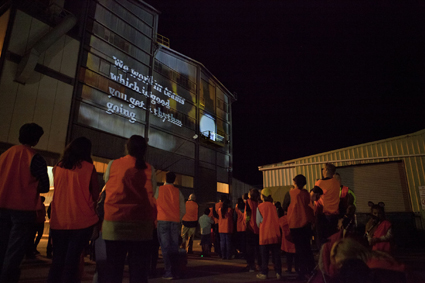
Site 9 – Opera, A Night of Wonder, Coleambally SunRice Mill, The Cad Factory
photo Mayu Kanamori
Site 9 – Opera, A Night of Wonder, Coleambally SunRice Mill, The Cad Factory
McEwan invited artists Mayu Kanamori (Sydney) and Shigeaki Iwai (Tokyo) to collaborate with each other and the Coleambally community. McEwan and Kanamori undertook a one-week residency early in the year, at the beginning of harvest time. Subsequently they were joined by Iwai for a three week residency in Spring: planting time. The Japanese artists brought with them a very different relationship to rice from our own. Theirs is an ancient connection associated with tradition and ritual, while, as McEwan suggest in the realtime tv documentary on A Night of Wonder, in Australia rice is just rice. Of course for the community of Coleambally rice has become much more than that.
The main performance in the cavernous storage barn saw several community members—a local Aboriginal elder, a farmer, a farmer’s wife, a miller, the factory manager—have a conversation with ‘rice,’ each speaking at a microphone to a circular projection of falling rice grains. For Stan Grant, the Wiradjuri elder, it’s a conflicted relationship: rice is not native to the area, but now it helps support his people. To the farmer it’s a co-dependent relationship; to a farmer’s wife it’s one of sharing her husband with the crop he loves. The final performer is Kanamori, speaking as a bird (complete with avian headdress) about how rice fits into birds lives. (Coleambally is an Aboriginal word describing a swift in flight.) As the projected image mutates into rice fields being burnt back for a new planting, a curtain of actual rice showers down, the metaphors of fire and water and earth co-mingling. McEwan, accompanying the performance with sound produced on laptop, also plays clarinet and miked-up fixtures of the building. Placed in the centre of the journey, the performance allowed the roving audience to settle and contemplate, though the ritualistic and reverent tone felt, at times, a little too ponderous.
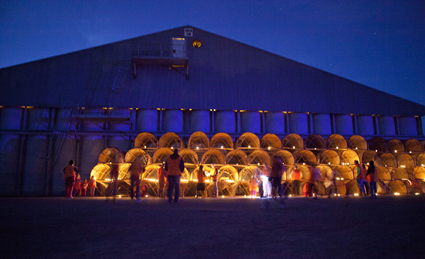
Site 3 – Ceremony for Planting, A Night of Wonder, Coleambally SunRice Mill, The Cad Factory
photo Mayu Kanamori
Site 3 – Ceremony for Planting, A Night of Wonder, Coleambally SunRice Mill, The Cad Factory
Ritual had been introduced with a lighter touch earlier on in the evening at the third site—a large stack of semi-circular airing baskets. Audience members were invited to ignite tea-light candles, place them in the baskets and make wishes for the new planting season. The resulting installation of hundreds of delicate flickering lights amid worn metal machinery was simply magical.
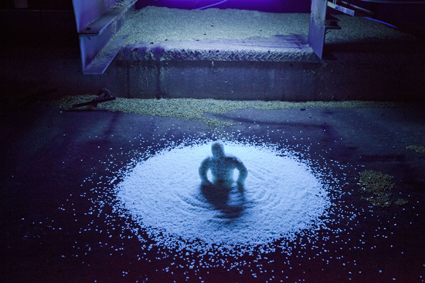
Site 5 – Of Rice & Men, A Night of Wonder, Coleambally SunRice Mill, The Cad Factory
photo Mayu Kanamori
Site 5 – Of Rice & Men, A Night of Wonder, Coleambally SunRice Mill, The Cad Factory
Shigeaki Iwai declared he was liberated by the absence of deep cultural significance in Australia around rice, his main artwork embracing instead a sense of play. In site five, an alleyway between two large warehouses, he installed a series of knee-high figures—people and animals made entirely of molded rice. These were placed in relation to old pieces of machinery illuminated with ultraviolet light. Not only did this provide a spectral glow to the figures, casting the audience’s hi-viz orange vests in terrifying contrast, but it also drew attention to the role of ultraviolet light in the rice growing process and, perhaps, the detrimental effect of too much of it given the potential for a greater hole in the ozone layer.
Mayu Kanamori got to the heart of the matter creating an installation about love. When they first arrived in Coleambally the artists held a dinner party, treating a number of community members to a 10-course rice banquet. After some sake tasting, Kanamori convinced the diners to write short poems about rice and love. These stories formed the basis of an installation featuring Kanamori’s photographs, audio recordings and small handwritten texts displayed amidst piles of golden rice husks, forming both a visual, sonic and tactile environment.
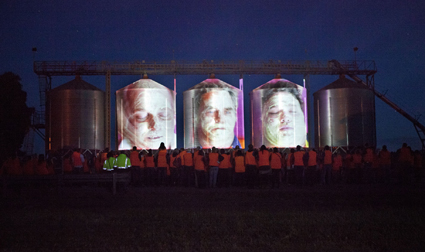
Site 4 – Rice Bran Facial, A Night of Wonder, Coleambally SunRice Mill, The Cad Factory
photo Mayu Kanamori
Site 4 – Rice Bran Facial, A Night of Wonder, Coleambally SunRice Mill, The Cad Factory
Industrial sites just beg for large-scale projections and A Night of Wonder did not disappoint. Onto three large grain storage silos a projected video showed several hardened millworkers in close-up being given facials made from rice bran, a traditional Japanese beauty therapy. Their faces loomed two storeys tall while we listened to recordings of their wives discussing how beautiful the refreshed skin felt, and how it had really made the men gentler and more relaxed. The workers themselves admitted that it was not too bad an activity, and as one wife says, she feels it has made her husband just that little bit more metrosexual.
The event culminated with a mini opera performed by a Narrandera local Fiona Caldarevic. Composed by McEwan, the lyrics were taken directly from interviews with workers in the mill about their daily routines. Caldarevic appeared as a diminutive figure on a landing protruding from the vast façade of the building onto which were projected scenes of pounding machinery (and wobbling jelly, the significance of which escaped me). Reminiscent of 70s British workers’ theatre it provided a suitably dramatic ending.
Interspersed among the art activities were several refreshment stations serving very tasty sushi rolls and hearty rice soup and everyone received a show bag of SunRice products. It was clear that the overall warm vibe at the conclusion of the evening came from much more than this generosity. A Night of Wonder managed to strike a perfect balance of engagement with its community. The ways in which the audience participated—being weighed in as if they were a rice crop, lighting candles, shuffling through rice husks—were subtle, non-confrontational, but meaningful. Perhaps more importantly, the ways in which community members were engaged were well pitched to be satisfying for them but also also fed into artistic outcomes. For a project juggling creative, community and, of course, business expectations, it really was wondrous.
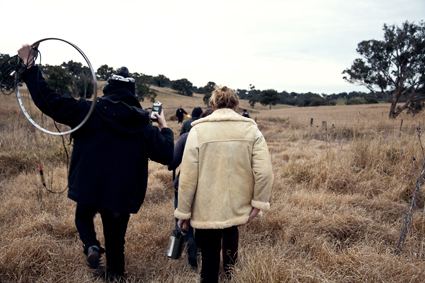
Participants in the field with their bike loop antennas during the Haines & Hinterding Fields of Frequency workshop, Wired Lab, July 2011,
photo Sofie Muceniekas, Shoot at Everyone Imaging
Participants in the field with their bike loop antennas during the Haines & Hinterding Fields of Frequency workshop, Wired Lab, July 2011,
Situated on a property 30kms from Cootamundra in New South Wales’ Eastern Riverina District, Wired Lab is a space for interdisciplinary sound and art explorations. It’s also a functioning farm and familial home of the founder Sarah Last and her partner David Burraston.
Last was a member of the Wagga Space Program Collective, producer of the unsound festivals (2000-2006). She took over the reins in 2003, curating ambitious site-specific events such as Mutable Landscapes (2004), a residency program bringing national and local artists together to work on site-based artworks, and Locomotivus (2006), a performative train journey (a format Last has continued to explore). The Wired Lab can be seen as the logical extension of these activities. Last and Burraston met during Locomotivus; the year after he made the move to the country. Originally from the UK, Burraston is an artist, scientist and composer with extensive knowledge in generative systems and what he terms “creativity and complexity.”
On-site and wired up
Last started Wired Lab in 2008 with one of the inaugural ArtLab grants from the Australia Council. To bring a curatorial focus to the early projects the lab focused on the creation of long wire instruments pioneered by West Australian artist Alan Lamb, also involving guest artists such as David Burraston, Oren Ambarchi, Robin Fox and Garry Bradbury. Last explains, “the seed funding was oriented around the wire instruments and a desire to construct some of those and work with a team of artists to investigate them. That area of work was really connecting with what I’d already been doing in terms of landscape-scale practice and working outside of institutional constructs in the open field. While a lot of the early work was aligned around wire instruments, the project itself is broader than that, exploring old and new media and interdisciplinary experimentations…Essentially I want Wired Lab to be a platform of activity for contemporary art research and practice in a regional context. I’m also interested in exploring different models of operation for artist-run collectives.”
A particular focus of the Wired Lab is on skills and development. Across the year, it offers intensive masterclasses and workshops for both local and national artists in various areas of sound creation and arts production. Often these are led by visiting international artists undertaking residencies at the lab, such as renowned field recordists Chris Watson (UK), Jez Riley-French (UK) and Douglas Quinn (US). Last explains, “In terms of the artists we work with there’s got to be a reciprocal interest—and the conversation really goes from there. For skills development it’s about providing access to the best possible teachers that we can get. That’s not to say that those skill sets aren’t in Australia but it’s important to hear and learn from people who are working and practising in an international context. From a regional perspective, it has often historically been the case that we’d get pretty second rate programs offered to us. It’s been one of my long-term commitments to prove that from a regional basis you can provide access to and generate high quality activities.”
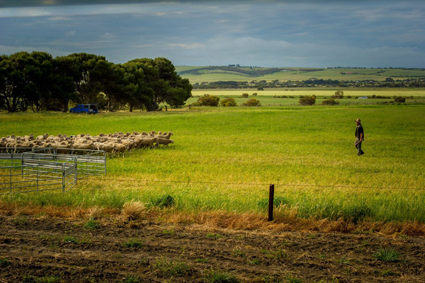
Sheep Muster, Southern Encounter, Wired Lab
photo Chris Herzfeld
Sheep Muster, Southern Encounter, Wired Lab
Off-site and on the rails
While Wired Lab offers an ongoing environment for site-specific explorations, Last is also interested in activities beyond their premises, particularly in other regional sites around the country. One of these projects was Southern Encounter, commissioned for Kumuwuki (Big Wave), the National Regional Arts Conference and Festival held in Goolwa, South Australia last year. (Southern Encounter recently won in the categories of Excellence in a Regional Area and Excellence in Experimental Music at the 2013 Art Music Awards.) Building on her earlier rail-based projects, Locomotivus (RT76) and Rolling Stock (2011, RT101), Southern Encounter involved a four-hour rail journey between Victor Harbor and Strathalbyn with six “happenings” along the way created by Tristan Louth-Robins, Luke Harrald, Matthew Timmis, Public Assembly (Lynda Roberts, Ceri Hann) with Jesse Cox and Eddie Roberts. (The project was then “storified” by Fee Plumley.)
Last and Burraston contributed two of these performances. In Sheep Muster, the train pulled up in a paddock so the audience could watch the sheep being herded, the sounds of which were captured via microphones around the paddock, mixed live and broadcast throughout the train. In the second performance, Piano Drag, Last and Burraston secured a piano to the back of the train and amplified its glorious demise. “We got a hell of a lot of feedback and white noise which was great…We had a video feed going through the carriages as well so people could watch that deterioration happen. It was distressing as well as enthralling. A number of the audience weren’t particularly enamoured with the feedback coming through the speakers but you’d be pretty worried about your work if everyone liked it. You need to have that tension and polarity in the experience.” The clamour of the piano’s disintegration contrasted with a performance by the Ngarrindjeri Rritjarukar Choir singing in language. It drew attention to their physical and sociological presence in the landscape and how that landscape has changed. This was also reflected in the course the rail journey took both through pristine bush, coastal developments and cultivated agricultural land.
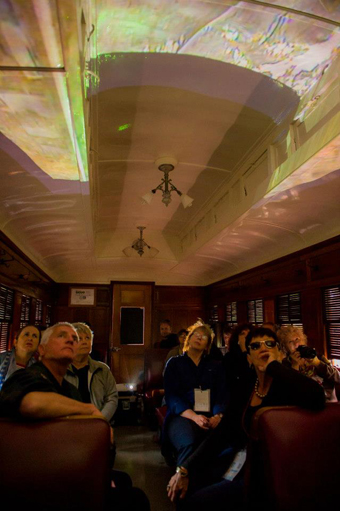
Piano Drag, Southern Encounter, Wired Lab
photo Chris Herzfeld
Piano Drag, Southern Encounter, Wired Lab
Recording country
Focusing specifically on this interrelation of Indigenous peoples and the landscape is the Box Gum Grassy Woodlands Acoustic Ecology project, currently in early development. It will be a multi-year activity focusing on the local habitat native to the region around Wired Lab. While it’s an acoustic ecology field recording project, the Lab will also work with members of the Wiradjuri community, the Indigenous peoples of the area, assisting in their language rejuvenation programs. Last explains, “The thing that’s really important to any language or cultural rejuvenation is connecting it to land. So we’re currently in the process of developing a project that will ultimately have a number of creative outcomes. One will be the training of Indigenous people in audiovisual documentation, which is important in the preserving of histories. Other outcomes will be a website that will connect the oral language and country element with other creative outcomes like a touring exhibition imagining what a pre-colonial rendition of this landscape might have sounded like.”
Future connections
Five years in and Sarah Last is pleased with the way the Wired Lab activities have expanded and the directions in which it’s heading. In particular she’s interested in exploring and experimenting with connections between disciplines: “pushing creative practice into arenas where perhaps it’s not been fully developed or recognised by people, for example, working in science, environmental science, agriculture and linguistics.” This year Wired Lab received seed funding from Innovation Australia to be a regional hub for Science Week activities: “it seemed an ideal fit in terms of what we were already doing. What I really liked about this regional science hub element is that it’s very focused on the area that you live in, making science accessible and relevant to the everyday.”
The next major event will be the Wired Open Day in which the public is invited to take in the site and experience a range of activities and performances across an afternoon and evening along with the (G)local Frequencies Project still in development. After several of these events contending with wilful spring weather and the harvest season, Last has moved this activity to Autumn (May 2014). So stay tuned to the wires early next year to find out more about it.
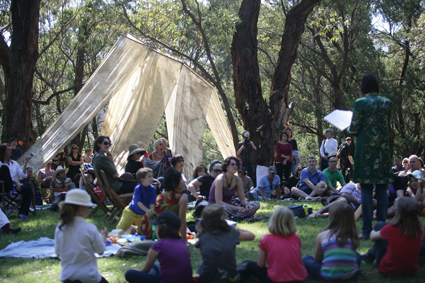
Picnic Among Friends, Victoria Spence
photo Mayu Kanamori
Picnic Among Friends, Victoria Spence
When I started to make performance, it was in the non-narrative, image-based culture of experimental practice where the emphasis was on the process of making the work as much as the performance itself.
As a maker and audience member, I most often watched the transitions between elements in the work as well as the ways performers made their entrances and exits. Watching them segue, be abrupt, juxtapose, overlap, collide or simply dovetail excited me most. It seemed to me that transitions did much to shape the meaning and affect of the work. It was the spaces, the liminal, still forming places, in between one thing and another, that held me and in which as a performer I felt most at home.
I’ve always been interested in storytelling and in intensity and the experience of authentic presence in real and performative spaces: in what produces the context and capacity for listening and speaking to others; in what has to be present for everyone to opt in, to move beyond the roles of performer and audience.
So when my practice moved beyond the frame of the arts, I was well equipped to pay attention to transitions and to other people’s stories. My Life Rites ceremonial practice honours and celebrates all the significant events of our lives with particular attention to how we complete them. And for those whose lives continue in the wake of the death of someone they love, it takes account of how we make meanings of that life in the processes and choices that we have in the experience of a dying, a death and in organising a funeral.
As a celebrant, I begin with time: initiating conversations about what happens after death, before a death has occurred. By taking more time at the deathbed it’s possible to support people in the transition from their role as carer to significant other (son, daughter, mother, lover). More time can be opened up between the death and the funeral, giving people valuable breathing space. You can expand the time taken within the civil funeral ceremony itself by offering a ‘double booking’ if you are working at a Crematorium. The usual 35-45 minute service that often feels formulaic, rushed and compressed, with the next booking lining up out the front, is the one experience most people know they don’t want.
I collaborate with families to create the context for the death and hence the role and function of the funeral ceremony. This gives the chosen elements more potency, activating them by drawing attention to the reason they are present. By allowing more breath in the experience for those who are still living to find their place and their own rhythm with spoken word, images and music, a deeply felt and meaningful experience is created and with real health outcomes.
These days I work in longer trajectories and time frames with even more moments of transition: at the time of diagnosis of a life-changing illness; at the transition between ‘active’ treatment and palliative care; to being able to have an after-death home vigil or, in the case of sudden and unexpected death, before the family calls a funeral director.
It is in these liminal spaces where another set of values can be articulated to re-frame or even create context and understanding of how to be at this time. To be able to modulate the quality of people’s experience when they are beset by shock and in a place of shared uncertainty has been for me an inherently creative process.
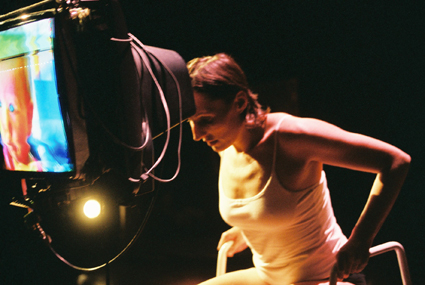
communication/failure (2005), Victoria Spence,
photo Heidrun Löhr
communication/failure (2005), Victoria Spence,
Over this last decade I re-trained initially as a civil celebrant, then as a bereavement counsellor and finally as a Death Literacy Consultant with a post-graduate qualification through a Social Work in Death, Dying and Palliative Care course at Sydney University. This move into the social sciences, into evidence-based paradigms has been interesting and necessary for me to fully understand the context in which I am now working. It has also been important for my colleagues to recognise my prior knowledge and information base that was founded in innovative, creative and humanities-based knowledge systems. On the floor in performance-making, living as an independent, freelance artist and multi-skilled collaborator, I was working among richly diverse cultures and communities.
I have clothed my practice, in part, in terms of the medical model and the funeral industry to make it recognisable to them and to foster meeting places for new collaborations and innovations. The uncertainties of the rehearsal room I now negotiate in hospital and living rooms at times of great duress, with concrete strategies, appropriate language and practices to support everyone involved. Walking into people’s lives at times of great loss and stress is profoundly improvisational—sensitising and connecting people back to the present moment in their bodies, through their breath and leading and following them in equal measure as they come to understand what meanings are resonant for them in the dying, after the death and through the funeral processes.
Exploring the relationship between beauty and the sacred within the everyday, in making new meanings and understandings of visceral, embodied experiences, such as the death of someone we love, is part of my reason for founding the Living with our Dead platform of site-specific ceremonial events. The Picnic Among Friends, now in its fourth year, invites people to bring their own idiosyncratic creativity and aesthetics to live with and remember their dead. Creating community memorials, individual assemblages made on picnic rugs, a ceremony and shared lunch in the park, surrounded by simple, tactile artworks, all foster a sense of participation and a telling of personal and shared stories. These narrative trajectories and links have a real function in the terrains of our significant life events.
The many aspects of my practice all rely on the ability to ground people in the experience they are having and to make from that the meanings they will need. I learned this in collaborative creative practice. I work always with a sense of the power of poetics, of personal and idiosyncratic aesthetics and personally authorised participatory making of meaning.
Before becoming a Life Rites Celebrant, Victoria Spence worked in various roles in contemporary performance, creating solo works and performing with Deborah Pollard, The Sydney Front, Sidetrack Performance Group, Legs on the Wall, DeQuincey/Lynch, Guillermo Gomez Pena & La Pocha Nostra and Blast Theory. Her curatorial and performance works include Performance Positive, works charting the impact of HIV and AIDS on communities (1996-97); Solstice Supper, installation performance events with Gay Bilson and Sydney chefs (1995, 1998); and Queer Cabaret events cLUB bENT, Love Child and Taboo Parlour (1996-99). An Asialink residency took her to the Darpana Academy, Ahmedabad, India and a Media Arts residency to Banff, Alberta, Canada in 2005. In 2010 she was a recipient of the Australia Council for the Arts’ Connections Residency, undertaking research in the Funeral Industry and establishing the Living with Our Dead platform. www.livingwithourdead.com
http://www.victoriaspencecelebrant.com
www.liferites.com.au.
RealTime issue #117 Oct-Nov 2013 pg. 8
© RealTime ; for permission to reproduce apply to realtime@realtimearts.net
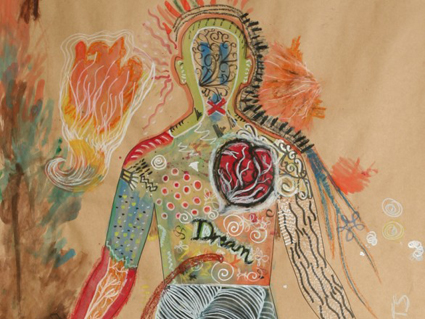
Section of experiential map contributed by participants at UTS Gallery, 2008; The Heart Library Project, George Poonkhin Khut with Caitlin Newton-Broad, David Morris-Oliveros and Greg Turner
photo Julia Charles
Section of experiential map contributed by participants at UTS Gallery, 2008; The Heart Library Project, George Poonkhin Khut with Caitlin Newton-Broad, David Morris-Oliveros and Greg Turner
Our Art, Wellness & Death feature is the first of two focusing on innovative artists—in this edition Efterpi Soropos, George Poonkhin Khut, Victoria Spence and Margaret Cameron—whose work has taken them into unexpected fields of practice to deal with illness, pain, dying and grieving. In a related interview Jo Truman reflects on how improvised song has empowered her with a sense of embodiment.
Sydney’s irreverently venerable Performance Space celebrates its 30th birthday in November with presentations from former artistic directors and performances by The opera Project, De Quincey Co, Rosalind Crisp, Brown Council and a multitude of artists spanning the organisation’s rich and often provocative history. A not-to-be-missed celebration.
Violence in art, and as art, in this edition appears in several forms: for its own sake (the action movie Death Race 3: Inferno); as re-creation, by the killers themselves, of the infamous mass murders in Indonesia in 1965 (a documentary, The Act of Killing); as a surreal take on a wave of apparently senseless murders in China (Jia Zhangke’s A Touch of Sin); or in version 1.0’s new work, The Vehicle Failed to Stop, about the murder of Iraqui citizens by armed Western contractors operating outside the law.
RealTime issue #117 Oct-Nov 2013 pg. 3
© RealTime ; for permission to reproduce apply to realtime@realtimearts.net
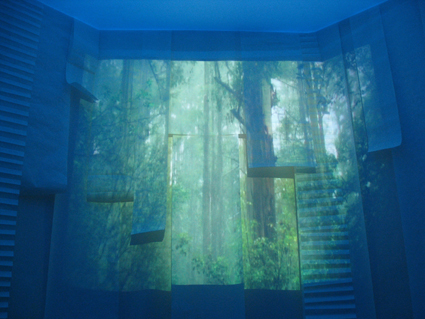
disambiguation room, Efterpi Soropos
image courtesy the artist
disambiguation room, Efterpi Soropos
Since training at NIDA in the 1980s Efterpi Soropos has created lighting designs for theatre productions around Australia, made her own installations and taught at the Western Australian Academy of Performing Arts (WAAPA). In recent years her focus has been on developing immersive artistic environments in palliative care after witnessing her mother’s distressing hospital experience when dying of cancer.
Soropos completed a Masters in Community Cultural Development, at the VCA in 2007 theorising about the alleviation of suffering in hospitals. In 2008 with an Ian Potter Cultural Trust grant she travelled to the UK and Holland for research. Out of this period came a prototype project at McCulloch House, Monash Medical Centre, titled the disambiguation room, commencing 2008 and funded by a grant from Arts Victoria, Community Partnerships.
The successful project by Soropos and her collaborators (see the artist’s website) became Human Rooms, an artistically driven commercial enterprise offering consultation, training and project development. Soropos was recently awarded a Churchill Fellowship. I spoke to her about the motivation for and the practicalities of her work and where it’s taking her next.
Where is your focus at the moment?
My focus has always come across as a bit vague, which is probably a typical way of seeing an artist’s outward persona. But I think I’ve discovered that it disguises a form of defiance and sharp analysis, which has enabled me to turn the disambiguation project into a permanent part of McCulloch House. It was always meant to be a temporary project and it’s now been re-designed and re-installed as a permanent installation. I’ve also developed a mobile version of the concept—a box that contains a selection of film images, sounds and lighting states that have been used in the original room, but now can be installed in a patient’s room.
My original intention with the project was to create a space for people to die in. And at the time, that was [seen as] just too out-there. So then I tried to find ways on a technical and practical level—how do you take that concept and put it into a space that a patient inhabits constantly, a hospital room? So I’ve been developing that concept and its commercial prospects. That artistic concept of Human Rooms can now be used by a variety of people in a number of spaces—in a home, a hospital, an aged care facility, a cancer centre, a palliative care centre.
How does the portable version work?
It’s a unit that has an immersive screen operated through wireless. I’ve developed an app so that patients, families or staff can set up the mobile version over a patient’s bed. This can be done in a shared ward where we know it’s very difficult to find peace or relax and, apart from painkillers, to reduce pain or psychologically find some way of being distracted or immersed.
What kind of images and sounds do you provide?
The basic concept of Human Rooms is built around immersion in a form of meditation with the sensory elements of image, light and sound either working in combination or as individual components. They find it engages them enough to precipitate some kind of psychological release. I’ve also used some animation based on simple, natural ideas, like cells re-forming and morphing which helps people to re-engage with, say, blood. These images can sometimes help people self-connect again if they’re feeling like they’re just a body with a disease in a hospital, or just a number and they’ve lost a sense of themselves.
What is the role of colour?
An Australia Council Inter Arts Office residency grant enabled me to work for a year with patients individually in rooms in the initial project. Sometimes women, for example, would prefer the room to be red. It made them feel like they were in a womb-like space or they were connecting with blood—maybe it’s because of our bodily function. Men might find red a colour of rage, or frustration, and they may have preferred the blue whereas women may have found blue cold. Colour is very subjective and also colour can bring up memories good and bad.
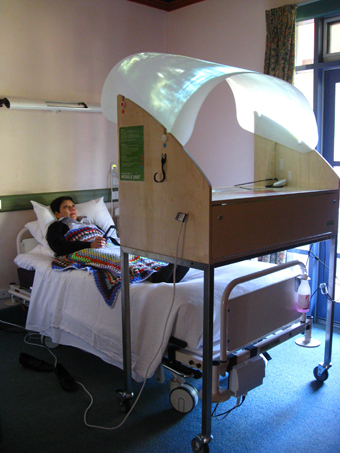
Mobile Immersion Unit, Human Rooms, Efterpi Soropos
image courtesy the artist
Mobile Immersion Unit, Human Rooms, Efterpi Soropos
So the app provides patients with choices?
Yes. When I hand these spaces over to staff and train them in how to use them, I always push the idea of creating something very soft or very subtle before bringing someone into the space. Then allow the person the opportunity to choose from the library. It’s all designed in such a way that the whole room [or the portable version] completely changes colour and the sound surrounds the listener. The rooms become…I was going to say ‘womb-like’ again but some people wouldn’t see it like that. The experience is very subjective.
Are institutions interested in buying into this?
I think it’s being viewed as another option. Medical staff are very limited in terms of what they can offer. A lot of hospitals have what they call ‘allied therapists’ these days. It’s all lumped under one category and includes everything from occupational to art therapy. Therapists can use Human Rooms for their work. I’ve trained pastoral carers, social workers and psychologists.
Have you completed this phase of your work?
I’ve probably completed it in terms of cancer care and palliative care. I’ve made these very subtle, integrated artworks. I’m now interested in developing a similar concept but at the other end of the spectrum, to create a bit of fun.
One idea is for a ‘playground’ for the elderly. In nursing homes there’s a form of multi-sensory therapy called Snoezelen, which was developed in the 70s in Holland by occupational therapists and psychologists who wanted to find a way to engage and relieve the anger and frustration experienced by people with special needs, using rooms that look like discos with the ball pits and coloured balls you see in playgrounds. They worked out that people with special needs responded to tactile and over-the-top visual stimulation. They’ve tried to move this into aged care to deal with people with dementia and Alzheimer’s. However, so that it’s safe, it’s a very one-on-one practice. I’m interested in developing a more artistic environment that engages people immersively but can be safely operated through apps and interactive panels. I also think that this would be suitable for kids with autism and Asperger’s.
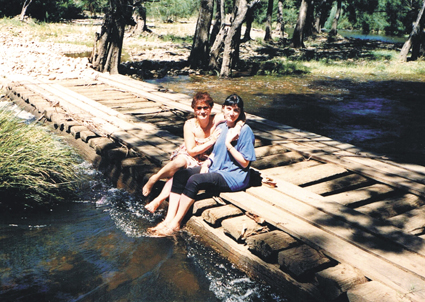
Efterpi Soropos and her late mother Evangalia Soropos, 1987
courtesy the artist
Efterpi Soropos and her late mother Evangalia Soropos, 1987
How will your Churchill Fellowship help you?
I’m going to meet a variety of artists and health practitioners who are developing what we call MSE—multi-sensory environments—in the area of dementia in particular. I’m also very interested in culturally specific material—an adult in a dementia unit may revert back to the culture they came from. I’m going to Hong Kong to meet a group of artists who make culturally specific dementia projects at St Marks Hospital. I want to focus on one culture and see how the unit addresses this area. Artist Bellini Yu and the Art in Hospital organisation in Hong Kong work with sound, shadow and memory. I’ve been developing an online relationship with her and she’s also organised a workshop that I’m going to give to a group of artists she’s working with.
Then I’m going to London, firstly to King’s College, a major teaching hospital. Their new Marjorie Warren Dementia Unit has been completely designed for sensory input. So from when you walk in through the door, the colours on the walls and the flooring, all the finishes, the lighting, everything is designed for the senses. It’s beautiful. But they don’t use film, sound and lighting interactively as I do. I’ll also meet Anke Jakob, textile/projection designer/architect and researcher into MSEs at Kingston University. An aged care facility might want its staff or carers to have an understanding of what it’s like for a person with dementia to be in a nursing home, so the unit sets up immersive rooms that provide insight into what it’s like being inside the head of that person. These virtual environments are produced in Hull by She Knows Ltd, another Churchill destination for me.
What’s the attraction of Japan?
I will go to Japan, for the first time, to see the work of some of my favourite Japanese installation artists, like Eriko Horiki whose paper and light installations look to me like extraordinary spiritual spaces. On the opposite end of the spectrum I love the work of Chiharu Shiota who makes exquisitely dark memorials to life and death, covering inanimate objects and clothing in string that looks like a form of lace or a second skin. It’s delicate and fine but also kind of forbidding.
As an expert in your field and hoping to make a living in it, do you still feel like an artist?
The idea of what an artist does has now expanded in so many different directions. Heading into something like a commercial enterprise I still feel like an artist because I’m still able to come up with new ideas and be inspired by everyday things and people’s experiences. I had an epiphany when I was working on large-scale events in the 1980s and 90s—like the Mardi Gras parties. I was struck by the fact that people would go into an over-frenetic, loud and intense space to move as energetically as possible. But then when they needed it, they’d go into a chill-out space, calming them when they were very high, agitated or drunk. I knew there was something in that for people who had no choice in the state in which they found themselves.
Efterpi Soropos, Human Rooms, Experiential Art and Design, humanrooms.com
RealTime issue #117 Oct-Nov 2013 pg. 4-5
© Keith Gallasch; for permission to reproduce apply to realtime@realtimearts.net
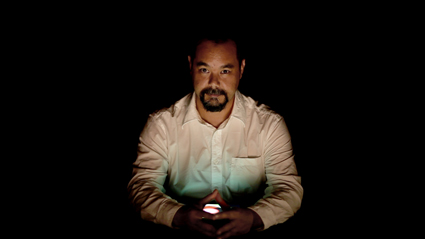
George Poonkhin Khut
photo Julia Pendrill-Charles
George Poonkhin Khut
I’ve been making body-focused artworks combining biofeedback interaction and audience participation for the past 10 years. I started working in this area, excited by the potential to create work that combined the evocative worlds of electronic art with the visceral, moment-to-moment directness of a participant’s own physiology.
I continue to be motivated by a deeply felt desire to address what many have identified as a serious disconnect in our culture between how we experience, represent, use and treat our bodies, and what we are learning about our embodiment from the disciplines of psycho-physiology, neuroscience and contemporary somaesthetic philosophy.
Inspired by fleeting glimpses into the sublime and richly embodied subjective spaces made available through meditation, Tai-chi and Feldenkrais somatic bodywork, I’ve been searching for ways to incorporate these sensibilities into seductive interactive artworks that can help make these elusive ways-of-being and knowing accessible to a wider audience that is less likely to have the patience to adopt them.
My works provide conditions and instruments for audiences to observe and experiment with how they can influence their bodies through changing breathing and stress/relaxation via real time analysis, primarily via heart rate variability, and more recently—in the ThetaLab project (see next page)—through modes of meditative focus used to modulate electronic soundscapes controlled by brainwave rhythms.
A participant’s role is to bring the work into their consciousness—as a collection of experiential reference points—making them capable of reframing subsequent experiences of self and then body-mind connection, and then in the realm of social interaction. In this way we can ‘practice’ a more holistic concept of self that acknowledges the strengths and limitations of our embodiment and circumstances.
Experimentation and research into the experiences these works produce in the participants have always been central to my work (begun as a Doctoral research project at University of Western Sydney in 2002), but since 2008 I’ve been focusing particularly on how the works can involve audiences as researchers. In doing so the work has evolved new social practices that re-frame our experience of, and attitude to, the self and its embodiment. I’m interested in art’s capacity to inspire people from a wide cross-section of society—to create shared reference points for how we can be and relate to the word around us, here and now. I’ve presented these works in art galleries, science museums and hospitals.
In 2011 I began the BrightHearts research project—a collaboration with Dr Angie Morrow, a brain-injury specialist at Kids Rehab in the Children’s Hospital at Westmead, Sydney. The aim is to research, design and evaluate the potential of my heart rate-controlled artworks for managing the pain and anxiety experienced by children undergoing painful procedures, with needles for example. With support from the James N Kirby Foundation and a residency grant from the Australian Network for Art and Technology (ANAT) I was able to research clinical practices and prototype a new tablet-based work suitable for use during clinical procedures.
A version of this work went on to receive the 2012 National New Media Art Award at the Queensland Gallery of Modern Art (GoMA). A pilot study with children at Westmead is scheduled for late 2013, to be followed by a randomised clinical trial in 2014, pending further research funding. The clinical trial will assess the efficacy of our heart rate-controlled biofeedback relaxation training ‘app’ compared with standard distraction-only tablet-based games that are increasingly used in clinics during painful or distressing procedures.
Beyond its application in pediatric clinical settings I’ve been working on a version of the work for general release, with the establishment of Sensorium Health Pty Ltd, a partnership with fellow interaction designer Jason McDermott (formerly of ARUP Urban Informatics). We’re excited about the possibility that mobile apps present for reaching new audiences with this creative relaxation training tool.
Our vision is for an interaction experience that combines electronic art, wellness coaching and social media technologies. The decision to market the work as an app for relaxation training—rather than as a creative app to be appreciated in its own right—has been taken for entirely pragmatic reasons. It’s based on a large, clearly identifiable market capable of financially supporting the development of specialised wireless sensing technologies able to provide accurate heart rate data.
The question often arises, ‘Is this art or science?’ It’s a good question in that it can help us to re-assess the range of conditions and expectations we place on both art and science: what is it that these practices need to do (or not do) for these terms to be useful? It’s essential to recognise that these works are primarily focused on mediated experiences of self—not just technology. The participant is an essential part of the compositional system, one designed to re-route neural connections, through the provision of new or unusual forms of action and sensation.
This is what drives and inspires me to continue working with interactive and participatory systems. It’s the sensual, first-person way of knowing, learning, sharing and interpreting that places this work firmly within art traditions—as we understand them in Western culture. For me these works are all deeply connected to how the arts and art-like practices have functioned across many cultures (particularly pre-scientific ones). It’s about a way of knowing and reflecting on experience—through our senses, in ways that go beyond abstract, analytical interpretations.
As a citizen and artist committed to the principles of a rational, secular society, I see art’s role as helping us to evolve shared meanings and values in relation to what we learn about the world and ourselves through scientific methods: what meaningful contributions can we offer to ‘our’ sense of what it can mean to be human in the Anthropocene age [a term from geology relating to the human impact on Earth’s ecosystems. Eds]? What are the values and ways of living and knowing that we want to bring with us into immediate and longer-term futures?
A related question, “Is it art or therapy?,” is particularly relevant for a project like the BrightHearts app. If we begin by prioritising the creation, facilitation and critique of innovations in actual, living social practice—the regulation of body-mind interactions—then a more important question is, “What is potentially lost or gained in the movement from one domain of practice to another? While it’s obviously not an either-or situation, for a work like BrightHearts the risk is that the experience of the interaction simply becomes a means to an end (lowered anxiety) and that its capacity to evoke more nuanced reflections on mediated experiences of embodiment becomes diminished with repeated use. The strong inter-subjective focus of exhibition-based works like ThetaLab and the Heart Library Project—presented in public locations as laboratory-style exhibitions where people experiment and share experiences—differentiates these works from strictly therapeutic practices. A participant’s motivation is guided by a more open-ended curiosity, in contrast to the sense of personal urgency or pain that motivates people to undertake a therapy.
This is a significant point of difference: we shouldn’t have to wait until we are unwell to justify an exploration of these connections. We need to develop practices around health and wellness that contrast with our prevailing fixation with ‘treatments.’ Conversely, the informal, more impersonal and uncommitted nature of most people’s engagement with contemporary art—and works like The Heart Library and Theta Lab—presents real barriers for the realisation of its transformative potential when compared with what can be accomplished in a more formal therapeutic context.
In this age of information overload, hyper-stimulation and proliferation of digital content, perhaps it’s not more art that is needed, but an improved capacity to pay attention in careful, deliberate and sustained ways to the situations around and within us. This is about culture more generally, not as a collection of isolated artefacts and gestures, but the ways we bring ourselves to bear on the situations we enter into.
See Urszula Dawkin’s review of ThetaLab, part of ISEA2013
You can read many reviews of George Poonkhin Khut’s work in RealTime’s Media Arts Archive.
George Poonkhin Khut graduated from the University of Tasmania Centre for Arts in 1994, holds a Doctorate of Creative Arts from the University of Western Sydney and has taught interaction and human-centred design methods at the University of Technology Sydney. Distillery: Waveforming was awarded the 2012 National New Media Art Award at the Queensland Gallery of Modern Art (GoMA). His work has been exhibited in Australia, Taiwan and the UK. georgekhut.com
RealTime issue #117 Oct-Nov 2013 pg. 6-7
© George Poonkhin Khut; for permission to reproduce apply to realtime@realtimearts.net
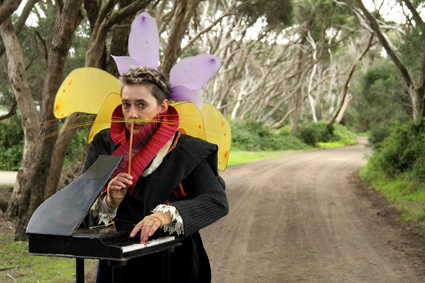
Margaret Cameron, Opera for a Small Mammal premiering at La Mama, Dec 2013
photo Daisy Noyes
Margaret Cameron, Opera for a Small Mammal premiering at La Mama, Dec 2013
A powerful and idiosyncratic writer and performer, Margaret Cameron is a key figure in Melbourne theatre. She has created riveting solo works—Things Calypso wanted to Say!, 1987; Knowledge and Melancholy, 1998; Bang! A critical fiction, 2001; The Mind’s a Marvellous Thing, 2002; and The Proscenium, 2005)—several of which toured for many years here and overseas.
Cameron has written and directed for Aphids (A Quarrelling Pair, 2004) and Chamber Made Opera (where she is resident director) as librettist and co-creator with David Young of the Minotaur Trilogy (2012). She has collaborated with American choreographer Deborah Hay, new media artist Hellen Sky (The Light Room, 2002, The Darker Edge of Night, 2008), acted as dramaturg for video artist David Rozetsky and in 2010 collaborated in Wales as writer on The Threat of Silence—a bilingual contemporary performance work with UK artist Jill Greenhalgh.
An August 1 press release from Chamber Made revealed that Cameron had been “rushed to hospital with cancer earlier this year. She [has been] undergoing a long program of precautionary chemotherapy.” Given a title as direct as Opera-therapea, RealTime approached Margaret Cameron to write about how she sees the relationship between art and therapy [Eds].
* * *
“EXTENDED, the lines of relationships intersect in the eternal You.”
Martin Buber
A new kind of opera with myself (‘the subject’), Deborah Kayser (soprano), Jane Refshauge (Alexander Technique teacher, dance movement therapist and dancer), Hellen Sky (choreographer and performer) and David Young (director), Opera-therapea will be staged in a consulting room in Fitzroy in October. Participating in different aspects of therapy, it explores the fact that Mind and Body are inseparable.
“I half wonder if my body is an opera,” says Deborah Kayser. “Through therapy we are releasing what we no longer need. We are reconnecting systems that have the potential to vibrate as one optimal body of wellness. It is our hope that those who experience this with us, may feel recognition of something they already know very deeply within them. I am expert in ignoring elemental truths and pushing them onto the back burner of my 21st century life.”
In a medical crisis, in shock and shattered by surgery, your wounded body seems no longer whole. But you know like and dislike. How grateful you are for this simplicity, for straightforward ‘likes’ and how clearly you know your ‘dislikes.’ Each is palpable to the animal in you. Communicating through the touch of breath, of sound, of skin, of silence, you are to discover that you are naturally likeable—a good animal. This comfort invites you to (re)join humanity with new understanding.
There are nurses, doctors, surgeons and specialists but there are other kinds of practitioners with a desire to share and accompany the subject with whom (in our humanity) we are one. Art comes through life and following experience, leads us toward community. “Our permeable skin is an organ between outside and inside, Self and Other and this sensational transmission operates and orchestrates thoughtfulness,” says Hellen Sky. A sick society cares not for the carer and as if the earth were a shopping mall, seeks acquisitions above all else.
How grateful you are for friends, for a knowledge sense without words, for those hands that touch, for the dimming of hard lights, the hushing of hard noise, the unhurried and natural presence of the few, who share, in the reciprocity of relation, a community of being. It is as if your soul, even in the sterile institution of hospital, were clean, humorous, fresh and bright. You are surprised and brought home—to company—like one baptised.
Austrian-born philosopher Martin Buber (1878-1965) is known for his “philosophy of dialogue,” a form of existentialism focused on ‘I and Thou’ and the ‘I and It’ relations (I and Thou, translator Walter Kaufmann, New York 1996). His philosophic works provide some leverage into ways of thinking about Opera-therapea and a cultural body in need of artful care:
“Spirit is not in the I but between I and You. It is not like the blood that circulates in you but like the air in which you breathe. Man lives in the spirit when he is able to respond to his You. He is able to do that when he enters into this relation with his whole being. It is solely by virtue of his power to relate that man is able to live in the spirit.”
Care is integral to healing. “The anthroposophic nurse begins from the premise that the spirit is always health and that an illness is not accidental, but the chance to develop the patient’s biography further” (www.aamaanthro.com/anthroposophic-medicine). Care includes spiritual, biographical and physical aspects for both the carer and the person cared for.
Jane Refshauge asks, “Can we find a universal medium and a new community of relationships that, beyond the limits of individual persons, reaches a liminal, oceanic place of transition through all the passages of life? All of one’s history and memory is encoded within one’s breath. Perhaps healing can only happen when we understand how life and death are actually the one energetic movement.”
In Opera-therapea practitioners of (an)other kind(ness) explore the felt sense of being human and how, through a midwifery of the soul, this links us to a place where life and death are connected. Complex relations of how we think, feel and act reveal holistic models and modes of co-presence that touch upon the boundaries of what we know. “Lying down on the floor in the therapy room, a light blanket resting over my body, I feel tender, vibrating tones penetrating my bones. Deep feeling comes from hot, song-filled air. I am carried by breath” (Tim Stitz, Creative Director, Chamber Made Opera, participant’s note).
Chamber Made Opera, Opera-therapea, Melbourne, 27 Oct, www.chambermadeopera.com
RealTime issue #117 Oct-Nov 2013 pg. 10
© Margaret Cameron; for permission to reproduce apply to realtime@realtimearts.net
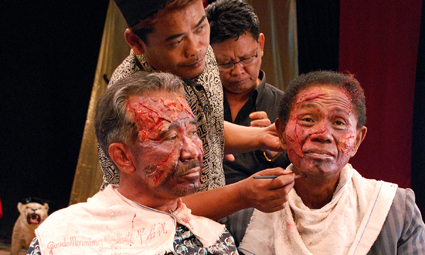
The Act of Killing
A line of dancing girls sashays from the mouth of a giant fish, the scene shot in such lurid tropical colours it appears poised on the edge of a nightmare. Welcome to the make-believe world of Indonesia’s death squads, built on the corpses of a million of their compatriots. Joshua Oppenheimer’s extraordinary new film The Act of Killing—“a documentary of the imagination”—renders this imaginary world on screen, as the killers who ushered in Indonesia’s “New Order” in 1965 enact their perspective on one of the largest massacres in history.
“I felt like I’d walked into Germany 40 years after the Holocaust only to find the Nazis still in power,” says Oppenheimer of his first encounter with one of the killers. “He immediately launched into horrific stories of murder, because killing was the basis of his career and the most important thing he had done in his life. And he told these stories in front of his granddaughter and wife. I thought in that moment, if this man’s not crazy, if this is how the killers really talk, then I knew I would have to give this situation whatever it took of my life to try and understand it.”
Oppenheimer’s commitment took him on a five-year journey that saw him interview more than 40 ageing death squad members. Their killings in 1965 were the culmination of simmering tensions between Indonesia’s Communist Party, the military and various religious groups in the first decade and a half of the young nation’s existence. Indonesia’s inaugural leader, President Sukarno, had attempted to balance these competing forces within a pluralistic political sphere, united by a commitment to Indonesia’s newly won independence and an anti-colonialist stance towards the rest of the region.
Sukarno’s balancing act came undone with the murder of six generals on 1 October 1965 in an abortive coup. Who instigated the coup remains unclear even today, but what’s not in doubt is that Suharto, one of the surviving generals, seized control of the situation and used the unrest as an excuse to launch a massive purge of communists, unionists, ethnic Chinese and anyone with leftist sympathies. When the dust settled, up to a million were dead, Sukarno had been toppled, Suharto was president, and Indonesia had unambiguously sided with the United States in the Cold War.
Oppenheimer’s interviews with various killers of the period led him to Anwar Congo, a petty criminal with a kindly face and a penchant for American gangster flicks. Anwar claims he personally tortured, bludgeoned and strangled around 1,000 people in the mid-1960s. “I lingered on Anwar because his pain was close to the surface, and offered insight into the true nature of the boasting about the killings—namely that it was defensive, it was a desperate effort to convince themselves that what they had done was right, and to intimidate the rest of society into accepting that story,” says the director.
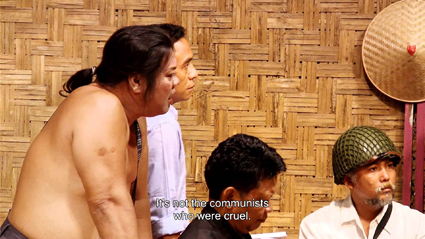
The Act of Killing
As Oppenheimer’s comment implies, The Act of Killing is as much about today’s Indonesia as the events of 40 years ago. For although we are told that Indonesia is now a democracy, Oppenheimer’s film clearly shows that the political terror, graft and gangsterism of Suharto’s “New Order” are alive and well. Throughout the film, we see interviews with present-day politicians in which they freely discuss their illegal moneymaking activities and reliance on the killers of 1965 to maintain their power. Throughout it all we constantly return to the over-lit interiors of Indonesia’s shopping malls, where the same elite figures indulge in the consumer dreams of the global capitalist system to which Suharto delivered their nation.
It was the intimate link between the terror of 1965, the contemporary political order and the lingering fears of Indonesian workers that led Oppenheimer to make The Act of Killing. “I first went there in 2001 to make a film about palm oil plantation workers,” he recalls. “The women were spraying a herbicide that was dissolving their livers. They really needed a union, but were afraid to organise because their parents and grandparents had been in a union until 1965, when they were accused of being communist sympathisers and dispatched by the army to civilian death squads.”
When his initial efforts to interview survivors of the 60s massacre were forestalled by the police and military, Oppenheimer decided to focus instead on the perpetrators. “Show me what you’ve done, in whatever way you wish” Oppenheimer told Anwar and his associates. “I’ll film the process, I’ll film your re-enactments, and we’ll combine these things to create a new form of documentary.”
Enthusiastically responding to this request, we see Anwar initially create scenes with an almost light-hearted feel, as he happily recounts the role he played in the purge. But beneath his bravado Anwar is clearly troubled, and when he tries to render the nightmares that keep him awake at night on film, The Act of Killing takes a turn that is at once laughably absurd and utterly horrific. By the time Anwar starts dissecting a teddy bear with a penknife to demonstrate what he did to the babies of communist suspects, we have descended into a very dark place indeed.
“It turned into a journey that was much bigger than genocide,” says Oppenheimer of the re-creation process. “It became a journey about how we as human beings make sense of our actions. How we understand ourselves.” He describes Anwar’s re-enactments as the killer’s attempt to “build up a kind of cinematic scar tissue,” to tame the unspeakable horror of what he did to his countrymen. And yet there is no escaping the agony Anwar inflicted, no matter what stories he uses to justify his actions.
In some of the film’s most disturbing sequences, Anwar’s fantasy world starts to unravel as he agrees to play a victim in one of his re-creations. Later, after watching the taped scenes, Anwar tells Oppenheimer that he now understands how his victims really felt. The director’s simple deconstruction of this claim—“but you were only acting, they were really dying”—leaves the killer standing naked, staring into Oppenheimer’s lens and the abyss of his own actions. For the first time, there are no stories left to hide behind.
For all the awfulness of these scenes, it’s The Act of Killing’s stripping bare of the act of history writing itself that remains the film’s most disturbing aspect. The purge of Indonesian communists has never been a secret—indeed, the manner in which these events have been framed has defined the country since 1965. The leftist political ‘other,’ Indonesia’s elites tell themselves, was a divisive force that had to be eliminated to guarantee Indonesia’s future prosperity and peaceful entry into the world economic system. It’s also this story that binds Indonesia’s elites to us in the West. For just as they have benefited from Indonesia’s prosperity, we have benefited from the submission of their workers.
Oppenheimer alludes to this point when I ask him if Herman, one of Anwar’s younger friends who acts in many of the re-created scenes, realised the extent of the slaughter upon which his society is based. The director replies, “Oh I think he realised, but he didn’t want to think about it. In the same way I realise that the shirt I’m now wearing was made in Bangladesh, and that the people who made it may now be buried under piles of rubble. Thanks to that, I can buy this shirt for six dollars. Like all of us, Herman uses fantasy and entertainment to withdraw from reality.”
After a loaded pause Oppenheimer adds, “That’s what this film is really about—how we all tell stories to escape from our most bitter and indigestible truths.”
–
The Act of Killing, director Joshua Oppenheimer, producer Signe Byrge Sørensen, Norway, Denmark, United Kingdom, 2012, distributed in Australia by Madman.
RealTime issue #117 Oct-Nov 2013 pg. 12
© Dan Edwards; for permission to reproduce apply to realtime@realtimearts.net
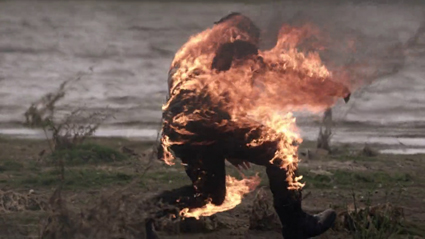
Death Race 3: Inferno
Saturation. Overload. Acceleration. Persistent 1960s concepts describing visual media as phenomenally excessive. Media sociologists and media artists for the past half-century chime in chorus how assaultive and bombastic visual media can be—debilitating for the former; liberating for the latter. Be it Jefferson Airplane’s Fillmore Ballroom lightshows or Ryoji Ikeda’s Armory Show installations, the human threshold is remarkably low for intaking sensory information. Audiences so quickly resort to registering sensorial, synaesthetic and immersive effects when presented with a few abstract flashes fired off in rapid succession.
When audio-visuality is championed for its radical potential, it has mostly been enabled by sound and/or music replicating these 60s concepts. Digital tools, processes and effects seem pre-designed to aurally simulate how visual perception grapples with abstraction, speed and density at this low threshold. While the high arts (through multi-media and audiovisual events commissioned by international arts festivals) spiral along these entropic lines, the low arts carve out a spiral equally inspired by saturation, overload and acceleration. Except the words more commonly employed are awesome, incredible, amazing.
Such are the terms audibly announced throughout Roel Reiqné’s Death Race 3: Inferno (2012, currently screening on cable TV). The central premise of Death Race 3 is how the races have now been targeted by a British media mogul for expansion. He has been buying out privatised prisons around the world to establish a global pay-for-view network for the franchising of the Death Race brand. The story centres on the first trial death race staged in Cape Town, South Africa. The action shifts equally between racing (myriad in-car and on-location camera-feeds) and the ‘behind the scenes’ operations within the broadcast studio. Additionally, the film ‘becomes’ the actual broadcast, showing what viewers see. Collectively, the franchise performs self-reflexively by increasing each film’s higher quotient of ‘sports commentary.’ This mode of oral narration signposts an audiovision unique to the generic mutation of sports and cinema.
Where Death Race 3 deviates from other models of ‘media overload’ is in how it audiovisually narrates this phenomenon, as opposed to thinking that it’s creating the phenomenon. Death Race is a fictionalisation of a live event, perversely extemporising and fragmenting the real-time dynamics of multi-camera/monitor spectacles so as to create a meta-fractured sensation of how such spectacles are produced. In a para-nouveau roman fashion, shots shift gratuitously from real-time to ultra-slomo, then into detonations of rapid fire cross-camera edits. The sensation is one of simultaneously being too slow and too fast, giving us a most prosaic interpretation of Deleuze and Guattari’s notions of cinematic time and motion. But it’s not simply the editing and camerawork conjoined which evidences this meta-fracturing: the fusion of voices, sound effects and score marks a shift from the 60s scopic-centric notions of saturation/overload/acceleration toward a coruscating and corrupting mode of audiovision. Let’s consider these soundtrack components individually.
First, dialogue. The bulk of dialogue in Death Race 3 is neither character-motivated nor character-directed: it’s responsive and self-uttered. Characters scream “awesome!”, “incredible!” and “amazing!” in fast edits framing their response to no one in particular. It’s a form of linguistic grunting, like the guttural growls and groans of televised wrestling. Even the stand-offs between racing drivers, the evil media mogul and his South African show producer become symbolic ‘power struggles’ dramatised like wrestling post-bout interviews. Most importantly, the edits are radiophonic, cut according to the vocal delivery. Unlike actual live commentary in televised spectacles, there is no fumbling, stuttering or inanely scripted homily. Here, the voice is a spurting machine-gun of banal yet explosive quips.
Next, sound. You’d have to be deaf to not acknowledge the role of sound effects in Death Race 3. A wonderful moment occurs during the opening Paramount Pictures logo with its chrome 3-D whooshing, wreath of gilded stars and Valhalla-like mountain crest. Over the last decade, this logo (similar to that of Warner Bros, 20th Century Fox and Universal) has been sono-musically re-designed like a cryptic overture to its film. Death Race 3 has a barrage of car noises (engine revving, hood slamming, chassis shuddering) skilfully timed to the logo’s movement. Semiotically, it declares the film is shaped by these sounds, sensations and events. Thus we enter a soundscape entirely located by the ear’s proximity to the noise orchestrated by a car engine. Monstrously customised engines. A bunch of them. A dizzying fatigue hovers at the perceptual threshold of the film, turning it into a numbing rumble of raging machines. It breaks the golden rule of sound design: ensure your listening audience is not ‘aurally fatigued’ by saturation, overload and acceleration. Perversely, Death Race 3 manifests an appropriately sonic equivalent of the effect so lacking in media arts’ attempts to ‘brutalise’ its listening audience.
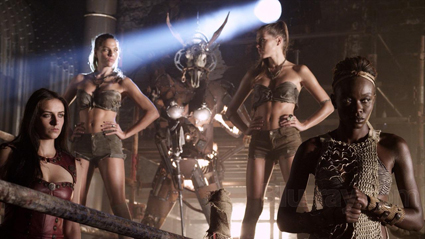
Death Race 3: Inferno
And finally, music. Death Race 3 has a score and song mix which is sublimely artless in its neurotic impulse to narrate dramatic change while flattening the very drama it seeks. Many of the songs are from Celldweller, a Detroit-based late 90s Industrial musician who progressively moved into electronic dance music—but like so many acts globally with similar CVs ends up producing purposely ‘hi-octane’ revved up music with noise affectations that has a detached ‘scorezak’ sense of narrating something without saying anything. It’s the kind of generic speed-fixated stock library music currently churned out by a billion bedroom composers providing fodder for fast-edited quasi-reality cable TV shows. Drum sample libraries, spritzy effects plug-ins, ornately pre-designed soft-synths and a real guitar put through ‘awesome’ FX boxes. It’s an amazing return to the original principles of “stimulus progression” which governed supply by the Muzak Corporation 60 years ago.
But for the last few decades, everything from rock and pop concerts to Olympics broadcasts to presidential elections to Broadway musicals to reality TV shows to viewer-voting talent shows have deployed an arsenal of broadcasting/recording devices intent on mirroring and replicating their own forms of media-encoding. The 60s notion of a NASA-style wall of monitors has become a banal de rigueur trope to insinuate that there is something momentous and monumental in the recording/broadcasting of the event that necessitates said arsenal. This constitutes the contemporary climate which self-serves media sociologists/artists who presume they are ‘reflecting society’ when they articulate/replicate this mode of self-actualising mediarisation. Death Race 3 bypasses this by rebooting Marshall McLuhan’s adage: it drives into the present while looking at itself in the rear-vision mirror. And like any good race, it goes nowhere really fast.
–
Death Race 3, BluRay/DVD, Director: Roel Reiné
RealTime issue #117 Oct-Nov 2013 pg. 13
© Philip Brophy; for permission to reproduce apply to realtime@realtimearts.net
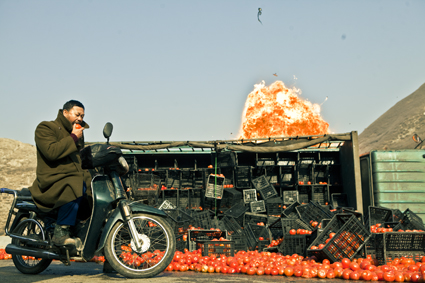
Jiang Wu, A Touch of Sin
© Xstream Pictures (Beijing)
Jiang Wu, A Touch of Sin
A Touch of Sin is absurd. Utterly absurd. Almost as absurd as the real-life Chinese events that inspired it. Adolescent prostitutes parade in titillating military uniforms, a middle-aged man shoots rich people to stop feeling bored and Communist cadres sell themselves state assets and buy Learjets with the proceeds. Underlying it all is a darkly surreal sensibility Buñuel would have been proud of. This episodic view of contemporary China from one of the nation’s most acclaimed auteurs may, at times, be grimly amusing, but it sure isn’t pretty.
“Over the past two years there has been an increasing number of violent incidents reported in China,” director Jia Zhangke explained during a recent visit to Australia to unveil his film at the Melbourne International Film Festival. “People are living under more and more pressure, but there are no proper channels through which they can solve their problems, so some people resort to violence.”
As he prepared a wuxia pian, or sword-fighting epic, set in ancient China, Jia watched the response to many of these violent contemporary events play out on Weibo (the Chinese equivalent of Twitter). Reflecting on the ancient and modern worlds, Jia began to see some resemblance between the online calls for a more just and humane society and the righteous characters of the wuxia films made by directors like King Hu (A Touch of Zen, Dragon Gate Inn) in the 1960s and 70s. It was this train of thought, he says, that led to A Touch of Sin, which subtly references King Hu’s work in several of its stories.
Whatever the film’s thematic links with ancient tales of swordsmen and women, A Touch of Sin unfolds in a country that has been utterly transformed by its headlong rush into modernity. Comparing these images with Jia’s earliest works of the late 1990s, the streets look richer and the people much better dressed. The half-finished highways we saw in films like Unknown Pleasures (2002) are now complete, facilitating movement across the country’s vast expanses as characters follow the flow of transnational money and all the pleasures and corruptions it has to offer. Everything looks so much newer than it did 20 years ago, yet the sheen is all surface deep, masking a culture that gets darker with each passing film.
“In the 15 years from my debut, Xiao Wu (1997), to A Touch of Sin, Chinese society has changed a lot,” agrees Jia. “On the one hand the country is full of limitations. The class system, for example, is very fixed. The child of a factory worker originally from the countryside is very likely to grow up to also be an internal migrant worker. On the other hand, superficially the country seems very free and full of vitality. For example, you can enjoy all kinds of sexual services in a place like Dongguan, as you see in the film. So society has lost its balance. The people with power and money have all the freedom, and even the law cannot bind them.”
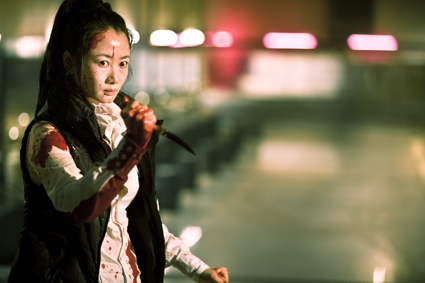
Zhao Tao, A Touch of Sin
© Xstream Pictures (Beijing)
Zhao Tao, A Touch of Sin
It’s this sense of lawlessness and a society out of control that makes A Touch of Sin such a harrowing experience. Jia has always been concerned with those lost in the slipstream of China’s breakneck speed development, but earlier characters like the pickpocket of his debut, Xiao Wu, were passive types, rendered torpid by the scale of the changes around them. In this sense, A Touch of Sin is a major change of direction. These men and women don’t just stare in incomprehension—they shoot, stab, steal and rob with abandon. Yet Jia’s new protagonists show no more understanding of the world around them than his earlier, more lovable losers like Xiao Wu. It’s as if having made the leap to action, Jia’s characters are determined to see every last urge to its conclusion, no matter how cruel or inane.
“I wanted to use cinema to talk about these violent events,” says Jia of his motivation for the uncharacteristic brutality. “Only when we understand and face violence can we avoid these things happening in daily life.”
For all its confrontational content, however, A Touch of Sin could do more to explore the roots of the discontent we see on screen. While we are made to viscerally feel the consequences of such an unbalanced society, several of the stories lack any serious attempt to explain the wider forces that have created these situations. Possibly this is the result of the central difficulty faced by every director working in China today. “In general there is a lot of space for the media to report on violent incidents,” Jia states. “So I felt that cinema should have the same kind of space. But the film system in China is very ‘special.’ I think the film should pass the censors, but on the other hand I don’t know how those people in the censorship bodies think.”
A Touch of Sin is slated for release in mainland China this November, but it remains to be seen if it experiences any last minute problems. It will also be fascinating to watch the local response. Several random attacks this year have made the film appear disturbingly prescient; the horrific story in August of a six-year-old boy having his eyes gouged out, allegedly by his aunt, makes even Jia’s explosive violence look comparatively tame.
Given the scale of the societal problems facing China, it is perhaps unsurprising A Touch of Sin offers no answers to the malaise it depicts. Like the experience of China itself, the film simultaneously conveys contradictory feelings of sensory overload, frantic activity, and the overwhelming sense of inertia that comes when events seem so out of control. In the end, Jia’s film simply leaves us reeling and, in the final few moments, gazing back into the lens to ask why.
A Touch of Sin; writer, director Jia Zhangke, producer Shozo Ichiyama, People’s Republic of China, 2013; 2013 Melbourne International Film Festival, 25 July-11 Aug
RealTime issue #117 Oct-Nov 2013 pg. 14
© Daniel Edwards; for permission to reproduce apply to realtime@realtimearts.net
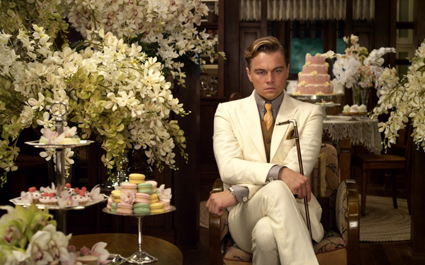
Leonardo DiCaprio, The Great Gatsby
It had been playing for weeks and I couldn’t put it off any longer. But with the wisdom of hindsight, seeing Baz Luhrmann’s The Great Gatsby was not a good idea. Many would say I should have known better. The critics had been scathing. Anthony Lane of The New Yorker suggested it was less a film than a music video made with “endless resources and a stunning absence of taste.” The respected fashion writer, Colin McDowell, condemned it: “as vacuous as the pages of most fashion magazines.”
But ever hopeful that Luhrmann and production designer Catherine Martin would repeat the visually thrilling experience of Romeo + Juliet (1996), I was willing to take my chances. Maybe my sanguine companion (a literary type) was anticipating an intelligent and nuanced adaptation of F Scott Fitzgerald’s delicate story of hope, loss and the fading American Dream. But not me. I was expecting spectacle—glitz and bling as someone else put it. I went for the costumes. I went for the fashion. The film has an excess of both. So why the disappointment?
Let’s start with the costumes. After an afternoon spent at the popular Hollywood Costume exhibition at ACMI, I didn’t need to be reminded that costume design involves the creativity and hard work of many talented individuals. In the complex process of getting a script to the screen, nothing is left to chance; everything matters. In this, The Great Gatsby is no exception, and if ACMI were to put all of the film’s spectacular costumes on show I have no doubt that they too would draw murmurs of admiration from the visiting crowds.
But if you’d read all the curator’s notes and watched all the interviews with the designers, actors and directors, you would know that the ACMI exhibition has one take-home message: the most important function of costume design is not to provide spectacle, but to transform the actor into a character we can believe in. In other words, what we are supposed to see up on the screen is not an actor dressed in a costume, but simply someone wearing clothes. If we buy this fiction, then the film can concentrate on the narrative and we can sit back and enjoy the story.
Of course, if the actor happens to be playing Elizabeth I, Marie-Antoinette or Daisy Buchanan, a certain degree of spectacle is required. But even costumes that dazzle can serve the narrative by revealing the psychological state of a character—the exterior shell of costume, if you like, is innermost feelings turned inside-out. Think for example, of those scenes where a character tries on numerous outfits in an attempt to find one that is ‘just right’—a Goldilocks-style trope that, often as not, combines fashion spectacle with a final choice that, in costume terms, is the perfect psychological ‘fit.’ When it comes to The Great Gatsby, Fitzgerald helps out by describing what his characters are wearing; the film cherry-picks these clues and then fills in the gaps.
So we get Carey Mulligan’s Daisy, America’s version of an aristocrat, wistful and romantic in pastel confections. At Gatsby’s party, wearing a Prada-designed stole that frames her delicate features in a lilac haze of fur, she is seductively vulnerable—but also trapped prey, an image that reinforces Gatsby’s vision of her as something rare and precious. Gatsby himself is appropriately obsessive about his appearance, everything is hand-finished, everything perfect. His fondness for ‘brands’ (“My man in England sends things over”), his compulsive expenditure (that extraordinary shirt scene), and his conspicuous display of wealth all betray a character that is clearly nouveau riche.
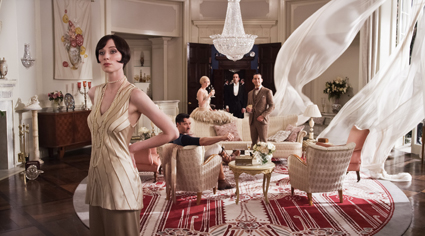
The Great Gatsby
I start to lose interest when it comes to the others. Jordan Baker—tall, athletic and “incurably dishonest”—probably makes sense as a fashion plate. Tom dressed as “the sporting hero.” Whatever. But tragic Myrtle, Tom’s low-rent mistress, dolled-up and overdrawn in reds and blacks? And Nick (conveniently played by Fitzgerald look-a-like, Tobey McGuire) in a cardigan and bow-tie? Surely there are rules against turning nuanced characters into cardboard cutouts.
The same broad brushstrokes are applied to the party scenes, those lavish spectacles that form the backdrop to much of the action. Fitzgerald coined the term “The Jazz Age” and Luhrmann’s film fills the screen with everything we have come to expect of the era, as well as adding a mass of pop culture clichés from our own. The effect is a mash-up of frenzied kineticism. “It’s not too much, is it?” asks Gatsby. Obligingly, Nick shakes his head.
But it is. I love this sort of stuff and want these scenes to work. Film is made for these moments and it’s not hard to imagine that Gatsby’s parties were designed to resemble a euphoric explosion from one of those cannon-sized bottles of Moët that keep turning up in the film. Every shimmying guest, kiss-curled dancer and spangled entertainer a gorgeous sparkling droplet, cascading across the screen in a glorious celebration of wealth, beauty and excess. Instead, the spinning dizziness is nauseating and all the intricate elements of design are lost, merging into one mass. A kaleidoscopic vomit of confetti, streamers and glitter.
Perhaps I wouldn’t have minded so much if Luhrmann had managed to make it all mean something, if he hadn’t made the mistake of confusing excess with decadence, if he hadn’t made it all look like such good, clean fun. Where are the consequences? Where are the torn dresses, the shredded hearts and the trainwrecked souls that are scattered throughout the novel? Colin McDowell is right to compare the film to a fashion magazine; youth, sex, money, image—like the glossy pages of Vogue, the film has it all. But he is right for the wrong reasons. Despite the collaboration with Prada and the commercial tie-ins with Tiffany’s, Brooks Brothers, Fogal and so on; despite costumes that could walk straight from the cineplex to the retail store, the problem with the presence of fashion in this film is not that there is too much, but that there is too little. Let me clarify.
What fashion can do, what fashion offers a film like The Great Gatsby, is an immediate entrée into a gilt-edged world. Not without reason, fashion has a reputation as obsessively preoccupied with surface and appearance; it is superficial, frivolous and fickle—all traits that play precisely into Fitzgerald’s depiction of hard, cut-glass characters, those “careless people” who casually abandon people and things. Instinctively, Luhrmann gets this. But whereas Fitzgerald knows the value of the shadow side of style to the telling of his tale, Luhrmann can’t help turning back towards the light.
Baz, it has been suggested, doesn’t ‘do’ darkness. Fashion is not so squeamish; the best fashion imagery understands that the flip side of glamour is death. In ignoring the dual nature of fashion, by keeping it one-dimensional, or at best as a cipher, Luhrmann misses the chance to corral his considerable talent for spectacle into a film that would have been worthy of Fitzgerald’s novel. If Luhrmann had got the costume, spectacle and fashion right, then perhaps he might have also got right Fitzgerald’s depiction of the Janus-faced coin of the American Dream. Where the author gives us a mirror, the filmmaker gives us… nothing.
RealTime issue #117 Oct-Nov 2013 pg. 15
© Karen de Perthuis; for permission to reproduce apply to realtime@realtimearts.net
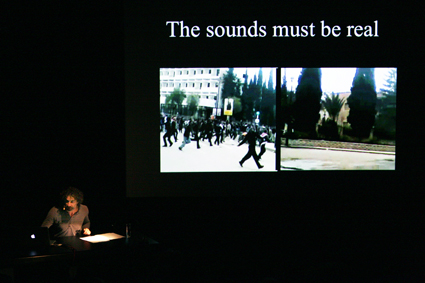
Rabih Mroué, The Pixelated Revolution
photo Judith Kaltenböck
Rabih Mroué, The Pixelated Revolution
One of the highlights of the Vienna Festwochen this year was Rabih Mroué’s The Pixelated Revolution, a highly engaging lecture/performance that focuses on how—and with what effects—mobile phones have been employed to document the Syrian revolution. The production (which was also displayed in a condensed form as an installation at Vienna’s Academy of the Arts) is a one-man show produced and performed by Mroué himself: a Lebanese artist, playwright and performer whose recent video/performance work explores themes pertaining to politics, violence and war.
The theme of the Festwochen this year was “Unrest of Form: Imagining the Political Subject.” The Pixelated Revolution reflects on the role that citizens and activists have played in capturing and distributing footage that unsettles the ‘reality’ of the conflict generated by governnment-sanctioned media sources in Syria. The lecture itself, however, is meandering and inquisitive rather than politically dogmatic in its structure. As the subtitle of the production, “A Non-Academic Lecture,” suggests, Mroué’s interest lies in stimulating thinking rather than pedagogically instructing the audience in how to read or understand the conflict at hand.
Seated at a table in front of a large screen, Mroué begins the lecture with the following statement: “The Syrian protestors are recording their own deaths.” This observation, we learn, is based on the large body of mobile phone footage that he downloaded from Facebook, samples of which (including footage of protests, soldiers, tanks and running feet) are projected behind him onscreen. When viewed together, Mroué argues that this digital archive constitutes a proclamation akin to the Dogme95 manifesto initiated by Danish filmmaker Lars von Trier which challenged filmmakers (through the imposition of a series of restrictions and constraints) to generate a realist aesthetic driven by protest.
Mimicking the “Vow of Chastity” coined by the Dogme95 group, Mroué lists a series of rules to be followed by those seeking to capture the reality of the Syrian conflict and to protect themselves and others from retribution: Shoot from behind and don’t show faces, but film faces when someone is being assaulted; don’t use tripods, don’t drop your phone and, above all, don’t credit the director.
The following section, titled “double shooting,” revolves around a disturbing piece of footage that was shot on the mobile phone of someone located on a balcony in a residential neighbourhood. Informed that guns are being fired by government forces even though there isn’t conflict taking place in the area, we view the movements of a sniper who appears, then disappears from our gaze. The phone scans the surrounding buildings in search of this blurry, ominous figure who suddenly comes into view and points his gun in the direction of the phone. The words “Eye contact” appear in red on screen, the image shifts as the phone/camera drops to the floor, and we hear a voice saying: “I’m wounded, I’m wounded, I’m wounded.’
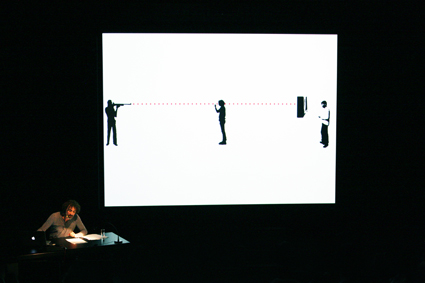
Rabih Mroué, The Pixelated Revolution
photo Judith Kaltenböck
Rabih Mroué, The Pixelated Revolution
“Optography,” Mroué informs us in a shift of direction, refers to a 19th century practice that focused on retrieving the last image viewed by someone before they died. According to the German physiologist Wilhelm Kühne, the final image could be extracted by developing the retina in a chemical solution. Mroué, however, employs a different process in an attempt to establish what may have been the last image of the mobile phone operator. He breaks down the footage and examines it frame by frame in an attempt to reveal the identity of the anonymous killer. The result is a close-up of a blurry, pixellated face circled in red but without any identifiable features: an image reminiscent of an abstract portrait of what Mroué describes as “the anonymous faces who murder for the Baath regime.”
Why, Mroué asks, doesn’t the mobile phone operator (and many others like him) sense the danger to his life and move or run? “Does the mobile phone camera desensitise him to the possibility of his own death?” And what kind of impact does this raw, shaky footage have on viewers who watch it online or as a part of the performance? Do these clips presented by Mroué work to undo the distant, anaesthetised spectatorial relationship cultivated by the polished nature of television news reports on the Syrian conflict? It is clear that, for Mroué, the significance of the footage (of protests, people and grassy landscapes captured by fallen phones) lies in the degree to which it challenges the stable, controlled image of reality generated by government-sanctioned media reports in Syria that render the “solidity of the state unquestionable.”
Rabih Mroué, The Pixellated Revolution: A Non-Academic Lecture, Mumok Kino, Museumsquartier, Vienna. 11, 12 May, Vienna Festwochen, 10 May-16 June. The work features as part of the Adelaide Film Festival at CACSA, 13 Sept-20 Oct
RealTime issue #117 Oct-Nov 2013 pg. 16
© Tara Forrest; for permission to reproduce apply to realtime@realtimearts.net
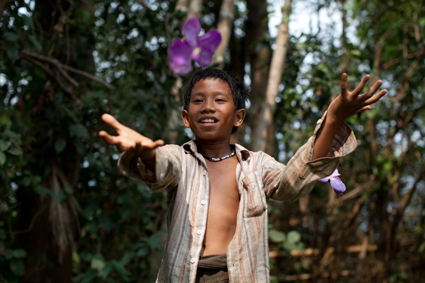
The Rocket
In 2007 director Kim Mordaunt and producer Sylvia Wilczynski released their documentary Bomb Harvest (see Dan Edwards’ review, RT80, p31). Shot in Laos, it followed Australian bomb disposal specialist Laith Stevens as he trained a local team in the business of tackling the devastating legacy of the United States’ indiscriminate, covert bombing of the country during the Vietnam War.
During the making of this documentary a sub-narrative emerged: that of the village children who make a dangerous living scavenging for bomb scrap metal to sell. These children, Mordaunt explains at a post-screening Q and A, would go on to inspire his and Wilczynski’s subsequent dramatic feature, The Rocket.
Lyrical and exquisitely observed, The Rocket is a story of cheek and determination in the face of dispossession and tragedy. Its resourceful yet accident-prone child hero, Ahlo (Sitthiphon Disamoe), forced with his family to move from their home in the mountains of Northern Laos to make way for a new dam, seeks to disprove the prevailing superstition that he is the bearer of bad luck by planning to build the largest and most explosive entry at an upcoming rocket festival. The narrative theme of the child embarking on what appears an overly ambitious quest to put things right is reassuring in its familiarity, yet Mordaunt employs it here to navigate a social and environmental situation of staggering complexity.
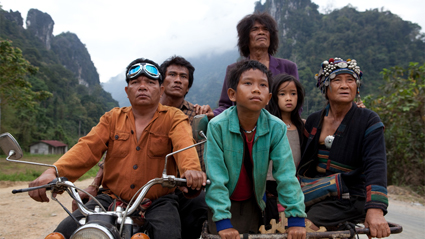
The Rocket
There are similarities between The Rocket and another Australian film released this year, Catriona McKenzie’s Satellite Boy. Both begin with eviction, charting a child’s journey through a landscape heavy with a sense of the numinous. However, while the landscape in Satellite Boy shelters the young protagonist, it is rife with danger in The Rocket—ready to maim or kill at any moment. Andrew Commis’ cinematography is instrumental in marrying the intimate playfulness of the child’s experience with the mysticism and peril of the landscape. Through vertiginous scenes—such as one where Ahlo is suspended on a rope swing above a mountainous drop, shrieking with laughter—and others which play with scale, pitting ant-like humans against majestic surroundings, Commis offers a window onto the sublime.
Commis’ vistas might stun the eye but do not dwarf the performances in this character-driven work. As they veer between joyful playfulness, stubbornness, anger and sadness, Sitthiphon Disamoe and his fellow child lead Loungnam Kaosainam (playing Ahlo’s friend Kia) convey extraordinary depth. The adult cast, most of whom have backgrounds in comedy and slapstick, were well-equipped—after an accelerated method acting course from Mordaunt—to walk the line between comedy and pathos the film required.
The world of The Rocket is one of great richness and complexity with an edge of the surreal, as embodied in the figure of Kia’s purple besuited, James Brown-impersonating alcoholic uncle (Thep Phongam). While Uncle Purple’s louche emergence strikes a humorously incongruous note, it has a darker significance. Purple is one of the CIA-backed Hmong who fought against the Lao during the country’s civil war (hence the adoption of American pop cultural references). There’s more than one reason he’s an outcast. The Rocket’s poetry is always underscored by disturbing truths.
In the breadth of its humanist vision, the film comes across as a somewhat troubled love letter to Laos from two Australian filmmakers who have lived and worked in the region (based mainly in Vietnam) and know it, perhaps, as well as any non-local can. While ‘outsiders’ telling another country’s story should always be regarded with caution, it’s surely a welcome development for Australian filmmakers to offer insight into the demanding circumstances of one of Australia’s near neighbours.
The Rocket, writer-director Kim Mordaunt, cinematography Andrew Commis, editor Nick Meyers, composer Caitlin Yeo, producer Sylvia Wilczynski; Curious Films, released 29 Aug
RealTime issue #117 Oct-Nov 2013 pg. 16
© Katerina Sakkas; for permission to reproduce apply to realtime@realtimearts.net
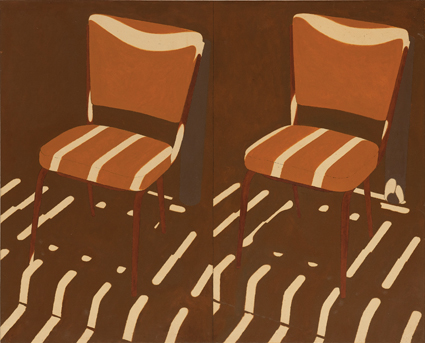
1994 same chair changed light situation, oil on canvas, Tony Woods: Archive
image courtesy the artist
1994 same chair changed light situation, oil on canvas, Tony Woods: Archive
“I rely on film and video to handle reality as my paintings become more abstract.” So says Melbourne artist Tony Woods, and as the new publication surveying his prodigious career, Tony Woods: Archive makes abundantly clear, the artist’s trajectory has indeed been a march from photorealistic figuration into increasing abstraction in paint, with a concomitant moving image practice concerned mostly with imaging “the real.” Only—perhaps typically of Woods’ mercurial style—this statement is also nimbly ambiguous.
The clue is in Woods’ use of the word “handle.” At first we may think of this in terms of its more neutral meaning, “to manage”—Woods uses the moving image, especially in later-life works, for its documentary affordances, to record daily reality. His is a warts-and-all pro-filmic aesthetic, unedited, replete with false starts, slow patches, jerky reframing: Catch as catch can. As Jake Wilson notes, in an especially lovely, perceptive essay in the book, Woods’ starting point is the home movie, and many of the films come across as simple sketches of the artist’s quotidian experience. From his second storey studio vantage point or through a hole in the back fence, Woods frames the passing parade of Fitzroy street life, human and animal, as a way of making sense of the world. This world is people, cats, bugs, flowers, sunbeams, rubbish, textures and patterns, in constant iteration. It’s not always attractive, nor is it meant to be: the alley behind the artist’s studio serves as an outdoor shooting gallery for the area’s notorious junkie population, and through Woods’ fence peephole, we witness their semi-secret abjection rites.
This wretched registry is one of many instances in which we are alerted that this is more than simple diarism at work. As we watch the films, the other meaning of Woods’ statement about using the moving image to “handle reality” begins to emerge. Co-opted into the slow-motion tragedy of street meat, or the futile spasms of a dying honeybee, we realise that this “handling” is manipulating, a sorting of the world around the artist into compositions, which, for all their apparent artlessness, are carefully constructed. This manipulation is obvious, and literal, in the suite of eye-catching films created with homemade kaleidoscopes and re-photography. However, it is just as evident in the street stories and everyday occurrences Woods captures, which disclose a much more deliberate artistic intelligence than the seemingly casual observations might at first suggest.
The chance to see these excerpts from Woods’ films, courtesy of the DVD inclusion, is one of the central joys of Tony Woods: Archive. The combination of these and the documentary, “work for the eyes to do,” provides us with a unique access to the artist’s thinking, significantly complementing the requisite biographical-interpretive essays and beautiful colour reproductions. The thoughtfully produced documentary makes the most of its high production values (great lighting, strong sound, adroit editing). It alternates interview footage of Woods with an array of other talking heads—his peers, art critics, dealers and other observers—and rich imagery of Woods’ works, spoken to by the subjects or the artist himself. Through this and the essay contributions (by Sheridan Palmer, Gary Willis, Lesley Chow, Alex Selenitsch, Phil Edwards and Jake Wilson) we learn about the artist’s early years in Tasmania (and how he still regards himself as Tasmanian, despite being seen by some as the “quintessential Melbourne painter”) and about his progression from early watercolour into acrylic techniques, his fateful New York trip at the height of Pop, return to Australia and immersion in the protean creative juices of the Yellow House. As we are inducted into the developments of the artist’s mature style, it is fascinating to learn about Woods’ parallel practices, not just in film and video but also in field recording, where the sense of the artist “handling” the world through documentation—this time sonic—surfaces again.
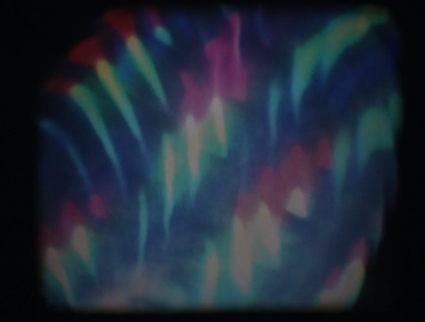
Reel Light, film, 1992, Tony Woods
Perhaps the greatest strength of the publication is the diversity of accounts and their presentation. We are drawn into this complex and talented artist’s world, given access to his creative inspiration and evolution, at a deeper level than other modes of artist biography that might sacrifice depth for gloss. Invited to muse on the aesthetic and conceptual relations between the artist’s practice across canvas, celluloid, pixels and audio tape, we start to develop insights into how the dialectic of representation and abstraction powers an artist like Tony Woods, finding varied expression across forms, materials and decades. There is here a play of opacity and porosity that rewards repeat readings and viewings. Tony Woods: Archive, with its detailed understanding of an artist whose work should be more widely known, is a rare and worthwhile addition to the annals of Australian art history.
Tony Woods: Archive, editor Andrew Gaynor, publisher artinfo.com.au, distributor Australian Scholarly Publishing (ASP)
RealTime has 1 copy of the Tony Woods: Archive to giveaway – click here for more info
RealTime issue #117 Oct-Nov 2013 pg. 17
© Danni Zuvela; for permission to reproduce apply to realtime@realtimearts.net
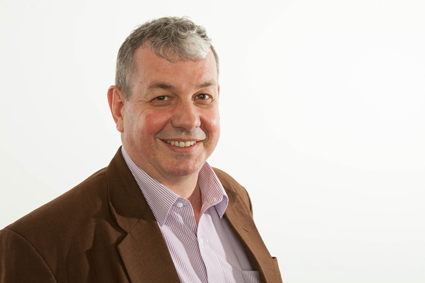
Andrew Donovan
image courtesy Australia Council
Andrew Donovan
Andrew Donovan’s benign manner goes hand in hand with his gentle enthusiasm and quiet determination to encourage adventurous Australian artists through his role as Director of the Australia Council’s Emerging and Experimental Arts section, formerly the Inter Arts Office. I met with Donovan at the Council offices to discuss the change in terminology to “experimental” and its ramifications for the Council, artists and audiences. Will it be business as usual but with more meaningful nomenclature engendering greater opportunities to support innovation?
Over the last 30 years at least, interactions between art practices and disciplines have proliferated, yielding mutations of existing forms and unexpected crossovers as well as terms aimed at explanation or containment. These include ‘cross artform,’ ‘multimedia,’ ‘interdisciplinary,’ ‘intercultural’ and ‘transdisciplinary’ as well as ‘new media arts’ and post modernism itself.
In the last decade ‘hybrid arts,’ has been widely deployed, but as exchanges between practices and disciplines flow into mainstream arts and become the norm, it is no longer useful as a descriptor for innovation—a word itself that has unfortunately become tied to Western notions of endless progress. To rephrase Paul Virilio’s dictum on technologies and accidents, for every innovation there’s a likely exploitation.
For Andrew Donovan the choice of ‘experimental’ is about communication within the Australia Council itself, with artists and the public: “There’s the arts community that knows what we do, what we fund and the sort of work we mean when we talk about hybrid or interdisciplinary practice or media arts practice. Then there’s the other side, the broader community that tends to glaze over when they hear those terms. There came a point when we felt it was important to be able to communicate much more succinctly to the Australia Council, to the governing board of the Council, to the broader community and also to politicians and people who really don’t know much about the sort of work we’re funding—to try to find a short-hand way of letting them in.
“The full name of the section is Emerging and Experimental Arts. ‘Emerging’ refers to emerging art forms and practices, not the emerging artist. The shorthand version is Experimental Arts. Since we’ve made the change I’ve certainly found in my interactions with people who really don’t know anything about what we do, they understand what ‘experiment’ is and they don’t have too much trouble putting it together with ‘arts.’ They immediately have a sense that it’s something that is pushing boundaries, trying stuff out without necessarily needing to succeed or having a predictable outcome.”
Donovan believes “the governing board and the Council have really embraced this notion and are very supportive of Australia having a strong reputation in that space. I think that’s where people see the really cutting edge of innovation happening, in the crossover between the arts and the broader culture—programs like Synapse that sit within experimental arts but also things we’ve done over the past few years that see artists working in non-arts settings, whether it’s in business or the food sector or universities or whatever. ‘Experimental arts’ is a lovely umbrella term for everything we’ve funded over 40 years in this space. So the change doesn’t say we’ll not be funding any of the stuff we’ve funded in the past.”
I wondered how we know when a work is experimental and how it can be assessed for funding. Often it’s a sensory response; the work plays with perception, sometimes disorienting us, putting us in unusual situations, as in many a Live Art work. It’s not necessarily your intelligence that identifies a work as experimental. Donovan recalls that at the Emerging and Experimental Art forum held at Carriageworks, 5-6 May this year, “there were wonderful terms people were using to talk about the work, such as ‘anti-aesthetic’ or ‘problem-finding’ rather than ‘problem-solving.’ Those sorts of concepts are quite abstract but I think when you see the elements put together in an application, the assessment panel recognises that’s the kind of thing we’re looking for.”
Given that ‘experimental’ can suggest a scientific model I wonder if loose notions like risk-taking and uncertain outcomes might be usurped by a strict expectation of definite outcomes. Donovan is adamant: “Certainly the way we’ve set up the funding criteria, it’s not like the artists are making an application to the Australian Research Council! This is the Australia Council. There was, however, a very strong response from the panel that looked at the first round of Experimental Arts grants this year to say, ‘Look, you need to be very clear about what the experiment is.’ I don’t think we’re going down the road of asking, ‘What’s your research question?’ But we are certainly saying, ‘Be very clear about what you’re investigating and what ideas you’re wanting to push through a project.’ I think in some of the applications in the first round there was an assumption that ‘Oh, well, you know what we do; we’ve always done this so just fund this application.’ There was a strong response from our assessment panels to say that people need to be very clear what they’re experimenting with and where it sits in the continuum of the historical context of their practice.”
However, an aesthetic response can be hard to quantify compared with the outcomes demanded of scientific experiment. Again, Donovan is firm, “The people we have around the table are not scientists; they’re artists. They’re looking for that aesthetic angle within a project as much as they’re looking at the experiment. We’ve left it quite deliberately open. We don’t want to prescribe what we think an experiment model is. We want people working out there to tell us why they think what they’re doing is experimental and we’ll put together a group of people to assess those ideas.” Presumably, given the technologically and scientifically advanced nature of some artworks nowadays (for example, the works of Efterpi Soropos and George Khut detailed in our Art, wellness & death feature in this edition), doubtless specialists in non-arts areas (including the increasing number who have worked with artists) might need to be called on for opinions in the future.
The importance of being able to share the knowledge that comes out of experimental art-making came up at the National Experimental Arts Forum. Some worried about ‘business in confidence;’ others said, ‘my project’s so long-term I don’t want to be putting it out piecemeal; others wanted everything open-sourced and acquittals made publicly available. Donovan declares “an interest over many years in how we might unlock a lot more of the information we get through acquittals. But the people who are pointing out the barriers are quite correct. At the moment, a lot of the information we receive is covered by the Privacy Act. We’d need to adjust our systems in some way to alert artists that, if they wanted to, part of their acquittal could be made public. We need to approach it fairly carefully to make sure that artists can see that there’s a clear benefit to them doing it.
“The Australia Council also has a great interest in how we evaluate the impact of our programs. A lot of the focus has been on the granting process. That will still happen, of course, but I think you’ll see an increasing shift in some of our resources to the evaluation of the impact of those programs and the impact of the work that artists are making. It’s certainly something we’re talking about.”
The diversity of examples of work described at the forum was quite amazing, much of it highly unusual. Donovan says, “One of the pleasing things about having ISEA in Sydney this year was the very positive response to Australian work we got from the international audience. After I did a presentation on what we’re doing through Emerging and Experimental Arts, a number of people from other countries rushed up saying, ‘I wish our funding body was doing that!’ I’m very keen to focus on communicating over the next few years a very comprehensive sense of the diversity of this work.”
Donovan is already planning for the next National Experimental Arts Forum which will probably be held in early 2015. “The first one was limited by financial restrictions but the next one we’ll tender out and it’ll be a much more open process and hopefully have a lot more delegates as well as making it a really great national discussion about experimental practice.”
I ask if this indicates long term commitment to the experimental for Andrew Donovan himself, who by 2014 will have been with the Australia Council for 20 years. “Absolutely,” is the answer. “I have always approached the experimental as a kind of slow-burn field of practice. You need to build up the credibility and the reputation for it over many years. It’s the absolute excitement and wonder of the work that keeps me engaged. You see the most amazing things and watch artists working in the most amazing ways. It just constantly surprises me.”
RealTime issue #117 Oct-Nov 2013 pg. 18
© Keith Gallasch; for permission to reproduce apply to realtime@realtimearts.net

Participants in the field with their bike loop antennas during the Haines & Hinterding Fields of Frequency workshop, Wired Lab, July 2011,
photo Sofie Muceniekas, Shoot at Everyone Imaging
Participants in the field with their bike loop antennas during the Haines & Hinterding Fields of Frequency workshop, Wired Lab, July 2011,
Situated on a property 30kms from Cootamundra in New South Wales’ Eastern Riverina District, Wired Lab is a space for interdisciplinary sound and art explorations. It’s also a functioning farm and familial home of the founder Sarah Last and her partner David Burraston.
Last was a member of the Wagga Space Program Collective, producer of the unsound festivals (2000-2006). She took over the reins in 2003, curating ambitious site-specific events such as Mutable Landscapes (2004), a residency program bringing national and local artists together to work on site-based artworks, and Locomotivus (2006), a performative train journey (a format Last has continued to explore). The Wired Lab can be seen as the logical extension of these activities. Last and Burraston met during Locomotivus; the year after he made the move to the country. Originally from the UK, Burraston is an artist, scientist and composer with extensive knowledge in generative systems and what he terms “creativity and complexity.”
On-site and wired up
Last started Wired Lab in 2008 with one of the inaugural ArtLab grants from the Australia Council. To bring a curatorial focus to the early projects the lab focused on the creation of long wire instruments pioneered by West Australian artist Alan Lamb, also involving guest artists such as David Burraston, Oren Ambarchi, Robin Fox and Garry Bradbury. Last explains, “the seed funding was oriented around the wire instruments and a desire to construct some of those and work with a team of artists to investigate them. That area of work was really connecting with what I’d already been doing in terms of landscape-scale practice and working outside of institutional constructs in the open field. While a lot of the early work was aligned around wire instruments, the project itself is broader than that, exploring old and new media and interdisciplinary experimentations…Essentially I want Wired Lab to be a platform of activity for contemporary art research and practice in a regional context. I’m also interested in exploring different models of operation for artist-run collectives.”
A particular focus of the Wired Lab is on skills and development. Across the year, it offers intensive masterclasses and workshops for both local and national artists in various areas of sound creation and arts production. Often these are led by visiting international artists undertaking residencies at the lab, such as renowned field recordists Chris Watson (UK), Jez Riley-French (UK) and Douglas Quinn (US). Last explains, “In terms of the artists we work with there’s got to be a reciprocal interest—and the conversation really goes from there. For skills development it’s about providing access to the best possible teachers that we can get. That’s not to say that those skill sets aren’t in Australia but it’s important to hear and learn from people who are working and practising in an international context. From a regional perspective, it has often historically been the case that we’d get pretty second rate programs offered to us. It’s been one of my long-term commitments to prove that from a regional basis you can provide access to and generate high quality activities.”

Sheep Muster, Southern Encounter, Wired Lab
photo Chris Herzfeld
Sheep Muster, Southern Encounter, Wired Lab
Off-site and on the rails
While Wired Lab offers an ongoing environment for site-specific explorations, Last is also interested in activities beyond their premises, particularly in other regional sites around the country. One of these projects was Southern Encounter, commissioned for Kumuwuki (Big Wave), the National Regional Arts Conference and Festival held in Goolwa, South Australia last year. (Southern Encounter recently won in the categories of Excellence in a Regional Area and Excellence in Experimental Music at the 2013 Art Music Awards.) Building on her earlier rail-based projects, Locomotivus (RT76) and Rolling Stock (2011, RT101), Southern Encounter involved a four-hour rail journey between Victor Harbor and Strathalbyn with six “happenings” along the way created by Tristan Louth-Robins, Luke Harrald, Matthew Timmis, Public Assembly (Lynda Roberts, Ceri Hann) with Jesse Cox and Eddie Roberts. (The project was then “storified” by Fee Plumley.)
Last and Burraston contributed two of these performances. In Sheep Muster, the train pulled up in a paddock so the audience could watch the sheep being herded, the sounds of which were captured via microphones around the paddock, mixed live and broadcast throughout the train. In the second performance, Piano Drag, Last and Burraston secured a piano to the back of the train and amplified its glorious demise. “We got a hell of a lot of feedback and white noise which was great…We had a video feed going through the carriages as well so people could watch that deterioration happen. It was distressing as well as enthralling. A number of the audience weren’t particularly enamoured with the feedback coming through the speakers but you’d be pretty worried about your work if everyone liked it. You need to have that tension and polarity in the experience.” The clamour of the piano’s disintegration contrasted with a performance by the Ngarrindjeri Rritjarukar Choir singing in language. It drew attention to their physical and sociological presence in the landscape and how that landscape has changed. This was also reflected in the course the rail journey took both through pristine bush, coastal developments and cultivated agricultural land.

Piano Drag, Southern Encounter, Wired Lab
photo Chris Herzfeld
Piano Drag, Southern Encounter, Wired Lab
Recording country
Focusing specifically on this interrelation of Indigenous peoples and the landscape is the Box Gum Grassy Woodlands Acoustic Ecology project, currently in early development. It will be a multi-year activity focusing on the local habitat native to the region around Wired Lab. While it’s an acoustic ecology field recording project, the Lab will also work with members of the Wiradjuri community, the Indigenous peoples of the area, assisting in their language rejuvenation programs. Last explains, “The thing that’s really important to any language or cultural rejuvenation is connecting it to land. So we’re currently in the process of developing a project that will ultimately have a number of creative outcomes. One will be the training of Indigenous people in audiovisual documentation, which is important in the preserving of histories. Other outcomes will be a website that will connect the oral language and country element with other creative outcomes like a touring exhibition imagining what a pre-colonial rendition of this landscape might have sounded like.”
Future connections
Five years in and Sarah Last is pleased with the way the Wired Lab activities have expanded and the directions in which it’s heading. In particular she’s interested in exploring and experimenting with connections between disciplines: “pushing creative practice into arenas where perhaps it’s not been fully developed or recognised by people, for example, working in science, environmental science, agriculture and linguistics.” This year Wired Lab received seed funding from Innovation Australia to be a regional hub for Science Week activities: “it seemed an ideal fit in terms of what we were already doing. What I really liked about this regional science hub element is that it’s very focused on the area that you live in, making science accessible and relevant to the everyday.”
The next major event will be the Wired Open Day in which the public is invited to take in the site and experience a range of activities and performances across an afternoon and evening along with the (G)local Frequencies Project still in development. After several of these events contending with wilful spring weather and the harvest season, Last has moved this activity to Autumn (May 2014). So stay tuned to the wires early next year to find out more about it.
Wired Lab, Cootamundra, NSW, http://wiredlab.org/
RealTime issue #117 Oct-Nov 2013 pg. 19
© Gail Priest; for permission to reproduce apply to realtime@realtimearts.net
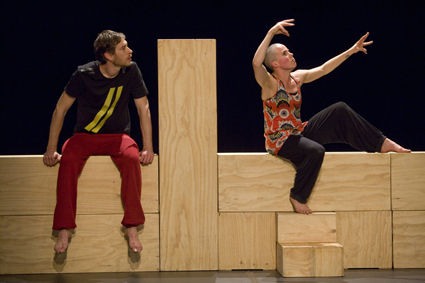
Lee Serle, Kirstie McCracken, Double Think, Force Majeure
photo Ponch Hawkes
Lee Serle, Kirstie McCracken, Double Think, Force Majeure
There are three star performers in Double Think (the major work in a double bill with the short work Gogglebox): Kirstie McCracken, Lee Serle and Ben Cobham/Bluebottle’s gorgeously golden wooden sculpture that dances as surely as the dancers do. Glowing with the grains and patterns of timber tissue, this tetrus wall will support, sway, hold and heave as it becomes frame, surface, screen, seat, bed, pedestal and presence.
Perhaps there is a fourth star: the lighting which dulls, darts, smashes and gleams its way through and across this performance, establishing atmospheres and episodes as clearly as the shape of the wall and the tone of the choreography.
The opening sequence is an assault. Sharp lights, sometimes controlled by the performers, are aimed directly at me, flashing on and off to a noisy, rhythmic grind, leaving smears and traces across my retinas, as snaps of the dismantling wall leave me grieving for its unity. The virtual traces of burnt light create shapes floating in the dense black nothingness where I know there is something; white to black, dark to light, something to nothing, full to empty, seen and unseen.
After the final snap, the light bleeds into a dully lit McCracken solo while Serle, thankfully, re-assembles the wall. This solo is full of paddled hands and lengthened arms atop turned out hips generating circular changes in direction on legs that bend and straighten, travelling and propping. A contemporary dance solo.
But the next dance makes the dance of the wall simply surprising. Blocks smoothly protrude and recede, blocking light, contorting geometrics and making shadows that swing back and forth darkly across the wooden skin. This relation of ephemerality and solidity embodies choreographer Byron Perry’s central notion of the “illusion of opposition.” Two apparently antithetical states or substances exist not in actual opposition but in the continuum of flux. While Perry’s program notes focus on the “imperfect sense” of a tall man (Serle) and a relatively short woman (McCracken) dueting, it is also found in the very substance of the timber tetrus: solid yet flexible, impenetrable and open, coherent and devolving, reflective and dense, dead and alive.
After the wall stops dancing, the tall man and the short woman emerge through gaps, like cockroaches. In a sequence where only the upper bodies are visible, lovely little rhythmic phrases disappear in the onward thrust of choreography that rushes toward crescendo. Quirky, intricate, slippery unison that slips into canon is broken by one luscious moment where she strokes the wood, the contact of two skins. At this moment the choreography hushes in a brief adoration. They scuttle back into darkness.
Later, the dancers are dimly framed by the re-arranged wall, separated but the same. They have become distant dreams in individual pools of soft light that fades them into oblivion, only to bring them back again in a slow, imperceptible sweep. Their quickly moving flesh becomes swipes of action in near-blackness, almost unreal, yet heightening their aliveness through the silky texture of skin. Created at a distance these dancers become chimeras, ghosts, cartoons, virtual realities, fading photographs and dying swans.
Force Majeure, Gogglebox and Double Think, director, choreographer Byron Perry, performers Kirstie McCracken, Lee Serle, set construction Ben Cobham/Bluebottle, lighting Benjamin Cisterne, sound composition Luke Smiles, costumes Natasha Fagg; The Reginald, Seymour Centre, Sydney, 21-24 Aug
RealTime issue #117 Oct-Nov 2013 pg. 20
© Pauline Manley; for permission to reproduce apply to realtime@realtimearts.net
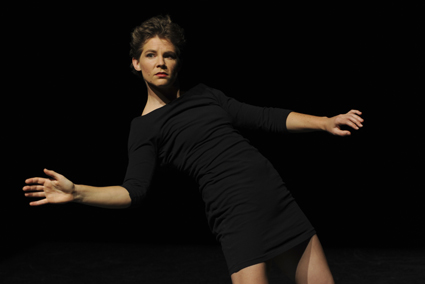
Miranda Wheen, Quest from Little Black Dress Suite
photo Heidrun Löhr
Miranda Wheen, Quest from Little Black Dress Suite
This suite of dances takes the little black dress as its unifying concept and further asks the question “what happens when you remove an iconic piece of clothing widely associated with feminine elegance and cocktail party glamour from its familiar fashion context?” (program). Running with the choreographer’s premise, I wondered how as an audience we might assess the performance on those terms?
T-dress, V-dress, vintage bandeau, slimline, full-skirted, reverse wrap, Audrey style, whatever, I know that the trick with the LBD is simply to wear it well. Here Martin del Amo is the tailor and each of the dancers adds her/his own personality to the outfit to bring off the elegant display.
In QUEST, Miranda Wheen’s boat-necked, scoop-backed, stretchy number suggests nakedness beneath. The dress slips in response to her movement and we note the changing ratio of cloth to skin. As she moves outside the light, the space she’s tentatively exploring envelops her in its own dark materials. Wheen’s dance is all weight shifts and balances as she slowly negotiates a path at first vertical, then horizontal. With the body at full stretch, the fabric moves as the dancer tests her limbs. Working in tandem with Alex Pozniak’s edgy score, her initial expression of someone driven also suggests a struggle with the elements. Only momentarily ungainly without her shoes, Wheen remains able-bodied, the garment largely compliant. Only when she returns to the place she began, equilibrium restored, do we notice the trickle of sweat running down the back of her dress.
Martin del Amo in What Good Is Sitting Alone In Your Room chooses for himself a no fuss, short, sleeveless black shirt-waist and soft lace-up boots. He’s simply dressed for action confidently expressed in the form of smoothly articulated arms, legs, hips, spins and Bob Fosse-style poses sideways and front-on. Who needs black hats and high kicks? His appearance is showy enough with no evidence of sweat to dispel the stylish impression. Gail Priest’s chiming minimalism from her album Presentiments from the Spider Garden weaves its own spell here.
In Tomorrow never comes Kristina Chan, elegant in a sleeveless A-line shift, black pumps, earrings, nails polished pink, might be exploring the same abstract territory as Miranda Wheen but within a much tighter frame. Again, arms reach outwards and balance on air. Not a hair out of place, her body appears to float, leaning close to off-balance until once more regaining its perfect poise while the sublime voice of Kiri Te Kanawa soars in unison.
In A Certain Slant of Light, Sue Healey in dramatic cowl neckline, patterned stockings, serious boots and with Arvo Part for company, feels her way through the space, breaking into sweeping moves and turns, deft spins and enclosing gestures. Like each of the dancers, Healey expresses a high level of concentration—there’s a sense that every move is being internally analysed as it’s being executed, an element of showing and simultaneously meditating on the movement.
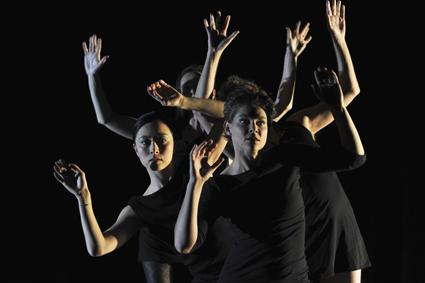
Little Black Dress Suite
photo Heidrun Löhr
Little Black Dress Suite
Finally all four dancers join in a careful pattern of slow, weaving movements in and around each other in a narrow horizontal plane to the aptly haunting song “Like An Angel Passing Through My Room.” In the end, like the iconic dress, it’s all about line and grace and these dancers, each in their own idiosyncratic way, appear to have that sewn up, carrying off the choreographer’s premise with aplomb.
FORM Dance Projects and Riverside: Little Black Dress Suite, choreographer-director Martin del Amo, performers Miranda Wheen, Kristina Chan, Sue Healey, Martin del Amo; Lennox Theatre, Riverside Theatres, Parramatta, 15-17 August, 2013
See our also our In Profile feature on Miranda Wheen
RealTime issue #117 Oct-Nov 2013 pg. 20
© Virginia Baxter; for permission to reproduce apply to realtime@realtimearts.net
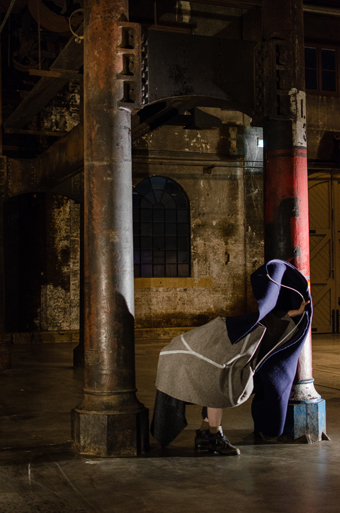
Box of Birds, De Quincey Co
photo Lucy Parakhina
Box of Birds, De Quincey Co
Across 30 years Performance Space has mutated in the hands of visionary artistic directors, each with their own agenda, but each sustaining commitment to the “obdurately ephemeral,” as an early manifesto put it, to providing a home for innovative performance and visual arts and their hybrids.
Leafing through the pages of RealTime from 1994, our first year, Performance Space’s history seems too vast to contemplate. It had already been operating since 1980 and Virginia Baxter and I had been performing there as Open City since 1987. What Performance Space offered beyond its vision was an enduring sense of community and continuity embodied in special events, conferences, workshops and parties (not least the celebrations for exiting artistic directors). In this community individuals collaborated on projects and some moved productively between performance companies associated with Performance Space or beyond, to Sidetrack Performance Group, Stalker, Marrugeku and others.
The standout shows across the years were often big works: Angharad Wynne-Jones’ unforgettable action-packed yet contemplative Sydney Harbour event Hydrofictions; Performance Space conferences with international guests, not least the one focused on food, Progressive Dinner; visiting artists Guillermo Gomez Pena and Robert Pacitti’s creations of large-scale works in collaboration with local performers; the queer-driven, sometimes hilariously shocking cLUB bENT (anus-baring dance; urine-spraying trapeze work); the Antistatic festivals pushing at the boundaries of dance; LiveWorks’ early embrace of the burgeoning Live Art scene; and Tess de Quincey’s and Joey van Ruigrok’s transformations of Carriageworks’ vast interiors. Or big in a different way—Nigel Kellaway’s This Most Wicked Body, a 240-hour durational work at the old Cleveland Street Performance Space with restaurateur Gay Bilson feeding Kellaway and one audience member a night with a fine meal.
Each year has had a host of works of small to medium scale representative of and vital to the Performance Space ethos: performances, creations and curations by many individuals—Deborah Pollard, Barbara Campbell, Derek Kreckler, Penny Thwaite, Julie Anne Long, Rakini Devi, Kate Champion, Victoria Spence, Nikki Heywood, Julianne Pierce, Denis Beaubois, Tess De Quincey, Rosalind Crisp, Alan Schacher (Gravity Research Institute), Vicki Van Hout, Jeff Stein and many more. Then there have been several generations of performance groups: All Out Ensemble, One Extra, The Sydney Front, Russell Dumas’ Dance Exchange, Entr’Acte, Open City, Frumpus, Legs on the Wall, Gravity Feed, Post Arrivalists, De Quincey Co, version 1.0, Branch Nebula, The Fondue Set, My Darling Patricia, Matt Prest & Clare Britton and Team MESS. There was also a wealth of visiting artists, including among many others, Nico Lathouris, Margaret Cameron, Jenny Kemp and Canberra’s Splinters Theatre of Spectacle. Performance Space has also been a key player in the national hybrid arts laboratories Time_Place_Space and Indigilab, which has become Indigispace, yielding productions from Aboriginal artists in 2014, at a time when PS will have its own Indigenous producer.
When I meet them, Bec Dean and Jeff Khan, current directors of Performance Space, are in a state of high excitement—great bundles of the printed program for the organisation’s 30th birthday, You’re History, to be celebrated in November, fill their admin office in Carriageworks, where the company resides as a major tenant. We slip into the bulging archive room to talk about the pair’s inheritance of Performance Space tradition and as shapers of its future.
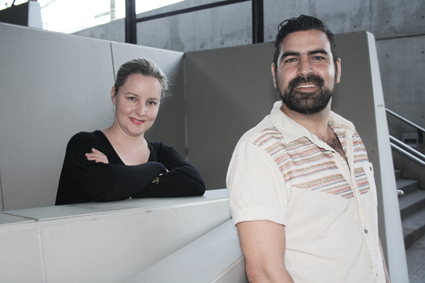
Bec Dean, Jeff Khan
photo Nic Dorward
Bec Dean, Jeff Khan
Legacy
Dean points out that both she and Khan had come from Perth, “which had a strong connection with Performance Space through Alan Vizents [initiator of Media Space in Perth] who subsequently became the director of Performance Space. I became aware of his practice through Sarah Miller who came from running Performance Space 1989-93 to be director of PICA in 1993.” Both worked at PICA, Dean as a curator and Khan at the front desk. “Through Sarah, Jeff and I had an arm’s length understanding of Performance Space.” Khan moved to Melbourne, becoming artistic director of two very successful Next Wave festivals, 2008 and 2010. He recalls, “the evidence of the national reach of Performance Space was clear. As soon as I started at Next Wave we had a big focus on site-specific and interdisciplinary work and in non-traditional venues, so Performance Space was an obvious partner in Fiona Winning’s time as director (1999-2008).” Dean became a curator at the Australian Centre for Photography in Sydney, “hung out at PS as a punter,” and was then employed by Fiona Winning as Associate Director at Performance Space and continued to work with the subsequent director Daniel Brine (2008-2011) in whose time Jeff Khan was to program performance.
Continuity & community
I ask the two how palpable is a sense of continuity with the Performance Space of the 80s and 90s. “There are artists from that time who are still associated with the space,” says Dean, “although the relationship might be different, while the field has diversified and a lot of new artists have come into the frame.” Both feel that there is a persistent sense that “the community is still strongly around us. They also point to intergenerational connections forged by Clare Grant [ex-Sydney Front] at UNSW and Sarah Miller and Chris Ryan [ex-Sydney Front; version 1.0] at the University of Wollongong from which Team MESS and Appelspiel have emerged.
Rosalind Crisp, Tess de Quincey and Nigel Kellaway, who feature prominently in the 30th birthday celebrations, have performed at Performance Space across two to three decades. From 1987 to 1994 Kellaway was with The Sydney Front and in 1997 formed The opera Project. De Quincey worked with Stuart Lynch in the 90s before moving on to solo performances and the formation of De Quincey Co. Rosalind Crisp’s early works were premiered at Performance Space where she also initiated the Antistatic dance event and later relocated to France to successfully develop her d a n s e methodology, still appearing from time to time at Performance Space ever since. These artists are exemplars (among many others) of a commitment to craft and exploration identified with Performance Space.
Performance Space seasons have led, says Dean, to a closer relationship between artists and a much larger audience than the old Performance Space had. The seasons have become intensive mini-festivals with a great sense of occasion, each with a broad thematic focus and much discussion enabled by Daniel Brine’s addition of the Club House concept to programming. Dean says that the interdisciplinarity of Performance Space and the seasons allows “conversations between performers and visual artists to happen within one frame.” “Audiences cross over too, which nuances the program,” adds Khan.
Commitment
I ask Dean and Khan what drives their directorship. Dean refers to Performance Space founder Mike Mullins’ (1980-85, see RT95, p38) focus on “new forms and new ways, and a commitment to looking outside the frames of reference that you know. We totally take this forward into the future.” Khan agrees: “It’s been Performance Space’s great strength across 30 years and it gives us a very clear vision as to what it can be in the future—that it’s a process that’s led by artists.” Under their own directorship, says Khan, “that means we’ve been focusing a lot of our programming energy on site-specific work and the dramatic increase in the number of artists wanting to work in that context. Nationally there isn’t another institution that champions that kind of work on an ongoing basis.”
As well, Dean feels that Performance Space “has continued to be socially aware and politically engaged although it might not be as forthright as it was when Mike started because he had to fight to establish Performance Space.” However, as well as mounting the highly successful SEXES program this year, in 2012 it reaffirmed its long-term commitment to queer practice by activating the Stephen Cummings Bequest as a residency-mentorship program for performance practitioners. Khan notes that as part of the birthday celebrations, choreographer and dancer Dean Walsh “will be looking back at the transformation he experienced as a performer in cLUB bENT, through queer language and drawing parallels with his current investigation which is all about marine life.”
An embodying birthday
What, I ask, are you celebrating above all? Dean says, “We want people to feel they embody Performance Space. It’s a celebration of us that is also of them.” Khan says, “We’re looking to the next 30 years so we want to emphasise that ours is a living history. People from the 80s and 90s are still our colleagues. This is not a dusty archive.”
The ambitious birthday program has an impressive line-up of talent that reaches across the space’s 30 years including The Directors’ Cuts, presentations (a night each) by the former Performance Space directors plus one for the late Alan Vizents (with Barbara Campbell, Derek Kreckler, Annette Tessoriero and Amanda Stewart presenting the late artist’s performance texts) and a screening of footage of Post Arrivalists’ infamous 1994 work Lock Up. 30 Ways with Time and Space features free performance scattered through Carriageworks and the 12 days of You’re History has performances from Paul Capsis, Apelspiel, Vicki Van Hout, Mike Parr, Jon Rose & Lucas Abela, Rakini Devi, Aunty Rhoda Dixon Grovenor & Nadeena Dixon, Lauren Brincat & Bree Van Reyk, and Matt Prest & Clare Britton.
Brown Council will present their ongoing tribute to a mythical Australian feminist performance artist “who disappeared in 1981.” Alex White and Emma Ramsay will celebrate the passing of analog television broadcasting, featuring a large cast of artists including Lara Thoms, Joel Stern, Pia van Gelder and Wrong Solo (Agatha Gothe-Snape & Brian Fuata). The opera Project’s Brief Synopsis is a creation by Nigel Kellaway, Heidrun Löhr and Katia Molino—“sumptuous music with the cool allure of France’s filmic Nouvelle Vague.” De Quincey Co’s Box of Birds, taking audiences deep into Carriageworks, will doubtless reconfigure our sense of the building. Rosalind Crisp’s danse (3)—sans spectacle, performed with European associates Celine Debyser and Max Fossati, will refuse to be categorised in its unpredictable unfolding.
There’ll be much reflection on Performance Space’s past over the 12 days of You’re History, but true to the organisation’s vision, the works are all new, sitting side by side with the memories that will be lovingly and deservedly conjured by some of the Director’s Cuts, although Nick Tsoutas (1984-86) promises not “a night of memories, but a night to remember,” Angharad Wynne-Jones (1994-97) will create A Parliament of Animals “realigning ourselves to our planet and ecosystem” and Daniel Brine will present 30 one-minute clips of artists in a toast to the next 30 years.
The ironic titling of the 30th birthday celebration as “You’re History” is therefore apt. Collectively, as artists and audiences, we constitute a living Performance Space archive; but if we only live out its past, the art it nurtures will truly be history.
Performance Space, 30th Birthday, You’re History, Carriageworks, Sydney 20 Nov-1 Dec; http://www.performancespace.com.au/
RealTime issue #117 Oct-Nov 2013 pg. 24-26
© Keith Gallasch; for permission to reproduce apply to realtime@realtimearts.net

This is Barbara Cleveland, Brown Council
photo Lucy Parakhina
This is Barbara Cleveland, Brown Council
When there’s heavy lifting to be done in the area of female empowerment, Brown Council are the go-to girls. Their work is multi-dimensional taking in everything from explorations in contemporary performance via video art to joke marathons.
As part of Performance Space’s Halls for Hire project last year, Brown Council celebrated the 90-year history of the Country Women’s Association by taking up the self-imposed challenge over four sleepless days of baking all 137 cakes from the CWA’s Jam Drops and Marble Cake recipe book. This is the dedication they now bring to bear on the task of reinstating a potentially forgotten female artist to her place in history. I caught up with the team in the midst of their four-month long international pilgrimage researching the life of the mysterious Barbara Cleveland “travelling to the cities where she lived and worked, exhuming her memory in an attempt to reinsert her into the history of performance art history.”
I came to Sydney in 1986 and missed Barbara Cleveland altogether. What sort of performance works did she create and what has attracted Brown Council to them?
Cleveland was one of the first Australian artists to integrate performance art practice and feminist thought. She was a hugely influential, mythological figure working from the mid-late 1970s up until her death in 1981. However what’s interesting is that there is no documentation of her performances in photographic or video form and almost nothing written about her. ?
Performance art, like many other conceptual practices of the 1960s and 1970s, developed within a particular socio-historic context that stressed, among other things, the ‘dematerialisation’ of the art object, so performances often weren’t documented in order to reflect this critique. ?We wondered whether this was due to the nature of the work—because performance is an ephemeral act which has historically resisted documentation or because of the lack of institutional interest in women’s work. ?So the fact that she was anti-documentation means she has been largely left out of the ‘canon’ of performance art in Australia?. She became important to us as an early example of feminist thought in Australian culture and creative practice, almost as a test case as to how that’s been remembered or not remembered.
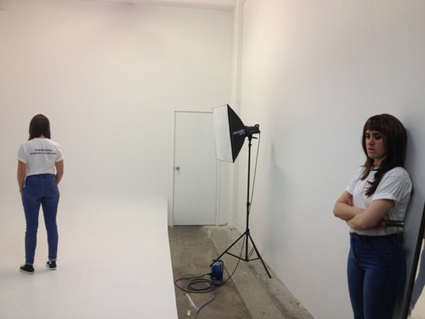
This is Barbara Cleveland, Brown Council
photo Lucy Parakhina
This is Barbara Cleveland, Brown Council
You’ll be re-performing some of Barbara’s lectures as part of the Performance Space celebrations. Are they straight lectures or do they fit more into the lecture-performance format so popular in the 1980s that unleashed the creative talents of so many academics?
Cleveland’s performance lectures and instructional performances were discovered in an archive box in mid-2011, which is how we found out about her. The performance lectures focus on how we experience and understand time, memory and history and their relationship to the experience of performance. We couldn’t tell if they’d ever been performed or if they were just text based instructional performances. This is, of course, a problem as well—without documentation the work and the artist are forgotten and left out of the history books—like Cleveland.
Barbara Cleveland’s text raises so many of the key issues surrounding performance art now and whether it can be understood after the event through subsequent documentation and whether it can be reinterpreted, re-enacted or re-performed. It was really the discovery of these lectures and performances that spurred on the entire Barbara Cleveland project and the desire to insert her work and memory back into history. As Brown Council we re-perform these performance lectures to camera as a way of documenting her work and memorialising her words and so in effect we all become Barbara Cleveland.
Though I can’t find anything about Barbara in any of the important publications on performance art at the time you say her work outside Australia was also seminal. Where has retracing her steps taken you?
Like many Australian artists, Barbara Cleveland traveled overseas in the 1970s to engage with the European and American scenes. At present we are interested in her time spent in the UK and in particular the galleries and spaces where she performed in London, such as Gallery House, Whitechapel and ICA. Her performances throughout this time were not documented so little is known about the work she undertook. Retracing Barbara’s steps has led us to London, the Forest Fringe in Edinburgh and The Junction in Cambridge where we have been developing gestures of remembrance to her. One of these has been handing out T-shirts with the statement “REMEMBERING BARBARA CLEVELAND” printed on the back. The T-shirts enable people to enact their own form of remembrance and spread the name of Barbara Cleveland.
Performance Space, You’re History: Brown Council, This is Barbara Cleveland, Bay 19, Carriageworks, Sydney, 20 Nov-1 Dec, 10am-9pm
RealTime issue #117 Oct-Nov 2013 pg. 26
© Virginia Baxter; for permission to reproduce apply to realtime@realtimearts.net
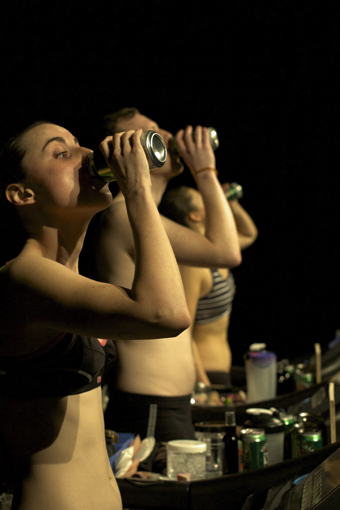
Run Girl Run, Grit Theatre
courtesy the artists
Run Girl Run, Grit Theatre
Live art has by now established itself in Australia, if not firmly, then at least recognisably. While it’s a loose mode that draws on a wide range of formal influences, one of the most compelling pieces of evidence of its growing importance lies in the way those influences and forms themselves are finding inspiration in return. Two recent works to appear in Melbourne offer testimony—both clearly acts of theatre, with scripts, dialogue, actors, yet somehow equally situated within the frame of live art. Each renders the division of style and content impossible, and in a sense neither exists outside of the performative moment itself.
The Confidence Man
Side Pony Production’s The Confidence Man is both text-based theatre and its opposite. There’s a story: a familiar crime caper in which the domestic ennui of a middle-class family is intruded upon by an only partly welcome face from the past, who is soon followed by a pair of violent, gun-toting crims hunting a lost bag of cash. There’s double-crossing and drug snorting and death dealing, all adding up to a suburban Australian thriller with some genuinely well-written moments.
But this isn’t the Confidence Man as experienced by its audience. Upon arrival, six willing members of the crowd are suited up in freakishly large puppet heads equipped with internal audio feed. The playing space is an expansive, deconstructed home and nearby park with white taped floors to indicate walls and barriers. Each actor/audience member plays out the actions of one of the drama’s characters, following instructions from their headset, which also offers the internal thoughts and spoken words of said role.
The rest of the audience, meanwhile, observes from one of the rows of seats lining three sides of the space. They, too, are equipped with headsets, but also a mixer with each character’s dialogue and thoughts set to a different channel. The actions of each role are played out simultaneously, and it is left to the viewer to decide who they wish to follow at any one point.
The result is both wickedly fun and surprisingly coherent. It quickly becomes evident that tracking the narrative as a whole is impossible, and while focusing on one exchange you’re very aware that something equally—perhaps more—intriguing is happening in another room. This fracturing of story could well have been a case of a conceit overriding itself, but as the work progresses the partial threads you follow do add up to a satisfyingly full experience. Not complete, but that’s part of the point. The Confidence Man gently but effectively highlights the work any art audience must perform in order to construct a narrative, but doesn’t shun its own role in the process either. It’s as if the piece offers its viewers a kind of building kit with instructions, and then lets them try making some theatre from it.
Director Zoe Pepper has kept a wise rein on the potential anarchy the project could have delivered, without limiting its sense of openness. The masks by designer Rebecca Baumann are key to its success: striking on a purely aesthetic level but also affording the ‘performers’ the ability to see everything around them while remaining completely anonymous to onlookers. This anonymity avoids the pitfalls of most audience participation—the masks allow these untrained actors to lose any inhibitions and the constant instructions relieve them of any responsibility for their actions. It’s rewarding to see the level of faith this work musters among its audiences, moreso given that its very title suggests someone not to be trusted.
Run Girl Run
Grit Theatre’s Run Girl Run calls for trust of another sort. As it reaches the zenith of its hour-long duration, you’re pretty sure someone’s going to break an ankle, at this performance or another. Over the past several years the company has produced a number of works that suggest great integrity and commitment to ideas and their execution, but you wonder when that might go too far.
Three performers (Tom Browne, Laura Hughes, Clare Phillips) step onto a stage in only their underwear before lacing up heavy work boots and boarding exercise treadmills. They walk at a slow pace for a time, until something halfway between a conversation and a stage command is uttered: “Shouldn’t we be having a beer?” The three produce VB cans and begin drinking. Over the next half hour the pace of their striding increases, and to the drinking are added other signifiers of stereotyped masculinity—board shorts, work singlets, talk of cars and hifi systems. All are produced casually, but there is always a sense of ‘should’ to their inclusion; a quiet reminder of the role of the social in constructions of gender.
The sequence culminates in a pounding, sweaty roar of performance that could be a sports match or military training, the screaming actors now pounding the treadmills at a run. And then, in a few moments, we reset—all three return to a walk, now undressed once more but taking on signifiers of femininity as their pace increases. This time it’s tight pink micro-dresses, fake tan and mini-champagne bottles; talk is limited to shoes, bangles, and makeup, again with no shortage of ‘shoulds.’ As they accelerate, perilously high heels are donned and by the climax of this round the three are veritably sprinting in this wildly inappropriate footwear, signs of exhaustion and even pain apparent.
Yet while there’s a fertile seam of gender exploration running through the work, to say that Run Girl Run is ‘about’ this theme would be as reductive as describing The Confidence Man as a play. Both make the act of live performance their own subject, and in Run Girl Run, especially, language is as much a texture as anything else, another skin like the clothing or accoutrements of the three characters (who both are and are not the same person as the actors presenting them).
We could almost see The Confidence Man and Run Girl Run as kinetic sculptures shaped from real bodies. While both gesture towards bleak places—crime and betrayal, or the conformity demanded by cultural expectation—it’s in the execution of each that some giddy kind of freedom makes itself known. Bold, bracing stuff from two companies walking fine lines with an assurance worth commending.
Side Pony Productions, The Confidence Man, director Zoe Pepper, writers: Zoe Pepper, Adriane Daff, composer Ash Gibson Grieg, masks Rebecca Baumann, sound Sam Price, lighting Lucy Birkinshaw, Arts House, North Melbourne Town Hall, 28 Aug-1 Sept; Grit Theatre, Run Girl Run, devisers, performers Tom Browne, Laura Hughes, Clare Phillips, Melbourne Fringe Hub, North Melbourne Town Hall, 20-27 Sept
RealTime issue #117 Oct-Nov 2013 pg. 27
© John Bailey; for permission to reproduce apply to realtime@realtimearts.net
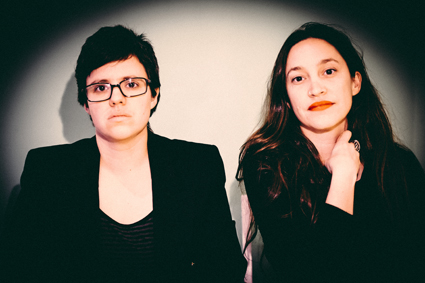
Emma Valente, Kate Davis, The Rabble
photo David Paterson
Emma Valente, Kate Davis, The Rabble
Kate Davis and Emma Valente, artistic directors of The Rabble, have been working as self-funded fringe artists, outside of mainstream funded theatre companies, for nearly 15 years. They both attended Swinburne University of Technology. They formed a company after graduating in 1999 called Self Saucing Pudding and produced about 10 shows under that name; fringe shows that not many people saw. Then Davis moved from Sydney to Melbourne and they decided to form a new company as directors with Sid Brisbane. This company was The Rabble. Valente and Davis responded collectively to my questions.
“We were all directors and we each did something else. Emma did lighting and sound design, Kate designed and Sid acted. It was founded on an idea of collaboration and on helping each other out. We had similar issues and interests. The name came from the idea that we were outside of the centre—this motley crew that didn’t quite fit in anywhere. That has remained true in a lot of ways.
“It was such a great time. We had such ambition to make work and to support each other. We have made eight works in Melbourne and Sydney. Through that time a point of view has developed. We didn’t articulate it at the start but it now seems quite clear. Our work is to do with the representation of gender and the body on stage from a female perspective. We just don’t think gender is a binary construct.”
In The Story of O (MTC, NEON 2013, review RT116) the ringmaster is played by a woman—the stage image is literally carnivalesque with merry-go-round horses and circus costuming. This complicates the power relationships in the piece. The aesthetic is decidedly queer. It occurs to me that the piece is more about carving out a space for difference to be accepted as a fact than it is about women’s liberation. I asked them how they make work.
“We let a lot of source material in during the initial stage—literary texts, academic texts, visual art, graffiti; anything we come across in our world and then we narrow down. We do a lot of preparation before we are in the room. Emma runs the room and talks with Kate about the events of rehearsal outside of the room. It is great to have that reflective process, to be able to talk to each other. A lot of directors work alone but we don’t. We don’t talk ideas much anymore but more through images. We respond to each other abstractly. I think the conversation about ideas has become implicit in how we work and that has been freeing for us. In not starting with a stated idea we don’t feel we have to prove a point or test something. Our conversation is between ourselves initially and primarily, not with the industry or audience.
“We work with a fluid ensemble. Some performers have worked with us for six years now. We choose people from instinct. It’s about getting the mix of personalities right in the room. It’s about someone being right for the process rather than for the part; because the acting can be what they want. They create the role. But they have to improvise into nothing for weeks and weeks before they may know what is going on. Not everyone likes that. You are in the dark for a long time.
“We rarely have philosophical conversations with the performers about the work. [Emma] talks in terms of rhythm and image. It is more like working on a movement piece than a theatre piece for the performers.
“Before Orlando (Malthouse, 2012, RT112) we were insulated from the industry. We were doing our own thing and no one was paying us much attention. We didn’t ever imagine that we would end up at the Malthouse or the MTC. We thought we were carving out a path for someone else. We thought someone would come up behind us and we would have paved a way for them. But it turns out we paved a way for ourselves. But that could easily have not happened. Being at the Malthouse in the Melbourne International Arts Festival in 2012 was the moment we got noticed and found an audience. That was the turning point. We had matured together while no one was noticing. The industry can give people opportunities they are not ready for. We’ve been fortunate that when we got opportunities we were ready. I feel like now we are a part of the industry but our ambition is perhaps slightly different. We really want this to be a company that tours nationally and internationally and to make a living from it.
“We are conscious of the politics and questions provoked by our work. But we come from quite a personal perspective. We know that to do The Story of O is a political act but the reason for doing it was to explore something personal. [Emma] has a problematic relationship with the book. Why is the idea of female sexual submission terrifying? That felt like a question worthy of asking. At a certain point in the process I wondered what O’s story would be at 40 and beyond. She would be put out to pasture. I realised how sad that was. I felt sad that some women want that. It was a sorting out of some crazy demons. It was not about sex but about feeling empty and what people do to try and not feel empty.”
* * *
In two new works The Rabble investigate the cultural legacies of masculinity and its ambiguities. Melbourne International Arts Festival and Theatreworks have commissioned them to create Room of Regret for the 2013 festival. The work is the company’s response to Oscar Wilde’s The Picture of Dorian Gray, “staged in a labyrinthine network of corridors, mirrored passages and disquieting viewing chambers” (press release). In May 2014 in a co-production with Belvoir, The Rabble will present Cain and Abel interpreting “the tale from Genesis and its many iterations—in Milton and Byron, Baudelaire and Baby Jane” (press release).
The Rabble, therabble.com.au. Other works by The Rabble are Special (La Mama Courthouse, 2011), The Bedroom Project (Linden Gallery, 2010), Cageling (45 Downstairs and Carriageworks, 2010), Salome (Carriageworks, 2008; RT85) and Corvus (Carriageworks, 2007).
2013 Melbourne International Arts Festival, The Rabble, Room of Regret, Theatreworks, Melbourne, 22 Oct-3 Nov; Belvoir, The Rabble, Cain and Abel, Sydney, from May 17, 2014
RealTime issue #117 Oct-Nov 2013 pg. 28
© Anne Thompson; for permission to reproduce apply to realtime@realtimearts.net
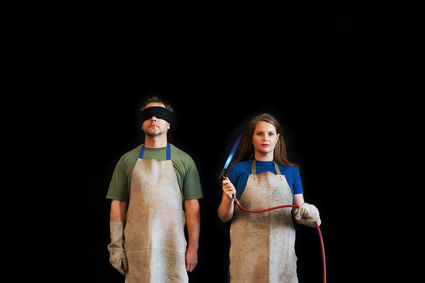
Sarah Elson and audience member, Incendia Lascivio
photo Cameron Etchells
Sarah Elson and audience member, Incendia Lascivio
One-on-one performances have become a key component of the Live Art phenomenon, greeted enthusiastically by audiences eager not to be performed to but to become part of the making of art. The inaugural Proximity Festival in 2012 at Perth’s Blue Room Theatre proved so successful that it is being mounted again this year, inhabiting the known and unknown spaces of PICA in a program curated by Sarah Rowbottam and James Berlyn with Kelli Mccluskey as provocateur.
The curators term the showings “micro-performances,” each running at about 15 minutes. There have been longer, more elaborate one-on-ones performed around the world—perhaps more demanding than short works. But remember, being alone with a stranger in a small space for even a few minutes can be daunting as the phenomenology of presence comes into sudden and sometimes extreme play.
In an email exchange with Rowbottam, RealTime wondered if the appeal of one-on-one was an antidote to the virtual nature of online encounters that so dominate our lives today? One-on-one performance offers surprise, risk and sometimes the engagement of the senses beyond seeing and hearing outside the safe parameters of conventional theatre spaces.
Rowbottam writes, “There is definitely a growing desire for performances that are experiential and activate a live exchange between an artist and audience in the moment. It could be seen as an antidote to our current obsession with negotiating our personal lives electronically…but I feel it can be stripped back to basic human nature—a desire for a sense of intrigue.” She thinks the appeal is to be found in “the play between fiction and reality, honesty and artifice—the risk of being alone in a space with another human being and the unpredictability of what might happen…If you are open and willing, the experience can be quite potent.”
Another virtue of one-on-ones is their sheer diversity, says Rowbottam: “One moment you could be experimenting with plants in a mobile field laboratory with Cat Jones and the next you could be in PICA’s administration office having a consultation with Loren Kronemyer about what you would like to do with your remains.”
A fascinating pre-production dimension to Proximity Festival is the seemingly labour-intensive approach to preparing the artists for their performances. Rowbottam explains that “a key focus is artist development as well as the development and presentation of new work. We curate a cross-section of emerging to established artists from a diverse range of disciplines so there is a great opportunity for artists to learn from each other and experiment with new modes of practice in the creation of intimate participatory exchanges. Performing 96 times to 96 audience members is an exciting, but challenging provocation. Artists need to remain open to a plethora of audience reactions and be prepared to shift and change within the performance parameters they have set. The element of spontaneity keeps things fresh and no performance is ever the same.”
A two-week laboratory prior to the performance season also gives artists the time “to critically explore their work in a supported environment as well as develop their own practice.” Rowbottam writes, “Artist labs are rare in WA, and are so important in creating a sense of collegiality within the artistic community.”
Mindful of tales of one-on-one performances going wrong, does Proximity have a set of protocols for both performers and audiences? Rowbottam responds, “I think there is an inherent fear that as an audience member you will be made to do something you don’t want to do. Although Proximity Festival works are participatory and experiential, they are always by invitation. We warn audience members about potential situations that could be confronting—complete darkness, physical touch, nudity, handling open flames, using fake weaponry etc. It’s a tricky balance between being up-front and not giving everything away.”
Audiences are certainly in for some unusual experiences and subjects rarely approached in the theatre: “In Janet Pettigrew’s work Prior Arrangement audiences can experience a living exploration of their body’s final hours, and in Janet Carter’s Meditation on breath, they are invited to sit face-to-face with the artist and undertake a guided meditation. There needs to be an element of mutual trust and willingness from both audience and performer to partake in the encounter, otherwise it can become muddy.”
Proximity artists are given a set of curatorial guidelines which require having protocols in place for possible audience. Rowbottam is emphatic: “If someone feels at risk or distressed they can stop the performance at any time—this goes for both artist and audience. One of our Symposium panel sessions is centred on what the boundaries of intimacy between audience and performer are, how intimacy is created and how we know when we’ve gone too far. It should make for an interesting discussion.” The Symposium also asks, “how do you program one-on-ones and where is their place in the touring circuit?”
There are also degrees of site-specificity to the 2013 Proximity Festival: “The entire PICA space is dedicated to the program of 12 works, enabling us to explore the entire building as one giant labyrinth. There are numerous hidden or unused spaces in the building which the public don’t usually have entry to or even know exist. Accessing these as performance sites is a real privilege. Holding the event in between PICA exhibitions has “enabled artists to work in-situ, which is a huge benefit for artists like Moya Thomas and Humphrey Bower who are making site-specific and site-responsive works.”
The variety in Proximity’s programming is evident in a brief sampling of the works. Cat Jones and Melissa Hunt’s bizzarely titled The Plantarum: Empathic Limb Clinic is described as “a conversation between the human mind and flora…A sensory experience for those not afraid to experiment with plants. Humphrey Bower’s Asterion is “a blindfolded experience in one of PICA’s most hidden spaces…For those who aren’t afraid of being in complete darkness.” Rachel Arianne Ogle’s Where You End & I Begin, “an intimate dance performance,” asks you to “join the artist in a game of perception, perspective and shifting dynamics. For those who don’t mind being watched or watching another.” In the “instructional performance” Incendia Lascivio by Sarah Elson, you’re invited to “harness the elemental power of fire to rework micro-sculptures of iconic West Australian flora” and in Leon Hendroff and performer Emma Craig’s String Duet, “sit face to face with a puppeteer and bring to life the marionette between you.”
Whether you select from the three programs on offer or bravely undertake a marathon of all 12 performances in the Proximity Festival, you are bound to have encounters that will doubtless tell you something about yourself as well as your relationship with art.
Proximity Festival, co-curator James Berlyn, co-curator, producer Sarah Rowbottam, artists Elise Reitze, Cat Jones, Humphrey Bower, Loren Kronemyer, Rachel Arianne Ogle, Ian Sinclair, Janet Pettigrew, Leon Hendroff, Emma Craig, Sarah Elson, Moya Thomas, Janet Carter, Daniel Nevin; PICA, Perth 23 Oct-2 Nov; http://proximityfestival.com
RealTime issue #117 Oct-Nov 2013 pg. 29
© Keith Gallasch; for permission to reproduce apply to realtime@realtimearts.net
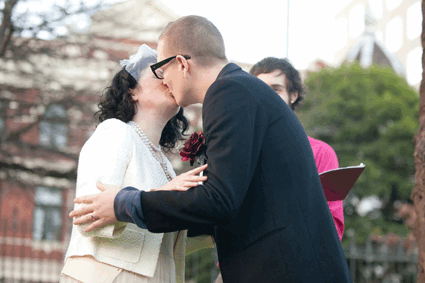
Tahni & Tom, Shotgun Wedding, NO SHOW, Next Wave Festival 2012
Photo Sarah Walker
Tahni & Tom, Shotgun Wedding, NO SHOW, Next Wave Festival 2012
In “The theatre of rehearsing for life” (RT115) playwright Robert Reid reported on a visit to the UK where he researched ‘New Games’ theatre in which audiences become active agents “within constructed narrative environments,” practising “‘ways of being’ in ‘not for real spaces.’” Here he looks at the work of two Melbourne companies who, to varying degrees, directly engage with their audience [Eds].
“I was giddy. It’s the only word for it. I held a manic grin on my face all afternoon. All of these people had come out to celebrate us! There was so much joy in the air, I was wearing a beautiful dress, my nails were freshly painted navy blue to match Naomi’s dress, my make-up was done. I was married! This was my wedding day!” Jane Howard, review, My Shotgun Wedding.
Critic Jane Howard is describing her experience of Melbourne-based company No Show’s work Shotgun Wedding, presented as part of the 2012 Next Wave Festival. Jane reviewed the work in the Real Time E-dition June 26, and, a year later, revisited her experience on her No Plain Jane blog. “I refer to that day, still, as ‘my wedding,’ or ‘the day I got married.’ I go back to Melbourne and am introduced to people who look vaguely familiar: ‘I was at your wedding!’ they tell me.”
Shotgun Wedding can be seen as one of an increasing number of performance works that interrogate, transgress and/or repurpose the relationship between the performer and the observer. Internationally this kind of participatory performance experience is represented by companies and collectives such as Punchdrunk, Coney and Slingshot and locally can be seen in the growth of Live Art and New Games.
With Shotgun Wedding, co-directors Bridget Balodis and Mark Pritchard build a fictional narrative environment out of a familiar social ritual, the wedding, asking their audience to ‘play as if’ the ritual is real. Balodis explains, “A lot of what we worked on with Shotgun Wedding was this idea of ‘You know what to do.’ You know the rules. There’s a lot of assumed knowledge there…When I ask you to come up and read a piece of text you know exactly the kind of tone to give it.”
The ceremony begins with drinks in the church forecourt during which a bride and groom are chosen and taken away for preparation while the rest of us are grouped into guests of the bride or groom. The event moves to a nearby garden where a truncated marriage ceremony is enacted, calling on more participants from the audience to carry out various ceremonial roles (I gave the Bible reading at Jane’s wedding). Once the wedding itself is completed the event moves to the church hall where the audience are presented with everything required to make an instant wedding reception (tables, chairs, drinks, decorations etc) and asked first to set everything up and then, finally, to enjoy the celebration.
No Show creates a narrative space out of which a range of possible stories can emerge. Participants become a playful, but temporary, community and the stories we enact together are shaped by the fictional frame we have agreed to adopt and the relationship structures we pretend to share. Archetypes of character arise and both familiar and surprising narratives emerge out of this space as decisions are made during play. Pritchard explains, “It’s actually about the task…We do tasks that invoke a certain something. With the wedding, we distilled it down to what we felt were some essential tasks or functions or things that happen in weddings across the world.”
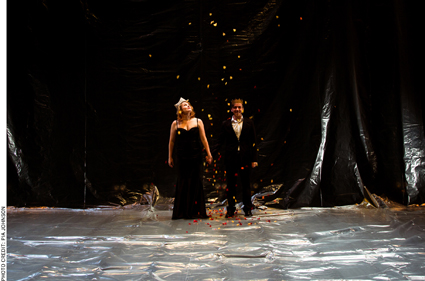
The Hayloft Project, By Their Own Hands, Neon
photo Pia Johnson
The Hayloft Project, By Their Own Hands, Neon
More recently, as part of the MTC’s Neon Festival, The Hayloft Project’s Anne Louise Sarks and Benedict Hardie presented By Their Own Hands, a complex deconstruction of the Oedipus cycle in three acts (see RT116). In the first of these acts Sarks and Hardie invite the audience to join them on stage for a playful storytelling experience which Hardie describes as “a live act of shared imagination.”
Of the three acts, Act One is the only one to take an explicitly playful approach. Sarks and Hardie play the role of storytellers and select individuals from the audience to take the place of key characters in the narrative. In contrast to Shotgun Wedding, this work keeps a much closer hold of the narrative and extends much less agency to its audience (though crucially not to the point of none), instead leading an ‘endowed’ audience (some more endowed than others) through the predetermined narrative.
Hardie explains, “the idea for Act One came from a place of mutual scepticism about ‘audience interaction.’ One of the guiding principles of the framing was to try to make it as non-threatening and non-obligational as possible. People would not be required to do anything. It wasn’t until we started playing with test audiences that we realised how much we would have to deal with those audience members who genuinely wanted to play. The initial focus was on using real people, and all the reality that they bring, as a vessel for communal meaning. It was a step beyond saying ‘Imagine a man’; rather we were saying ‘Here is a man.’”
Once endowed by the storytellers the playing audience members add colour to the characterisations, by their in-the-moment decisions and reactions, which subtly shape the unfolding narrative. Tonight’s Jocasta might slap Oedipus in the face where last night’s might only have stood passively by. Through these individual variations the whole audience’s perception of the narrative is altered.
In Shotgun Wedding each audience member is given relatively free agency within a familiar structure and so makes their own story. By contrast, By Their Own Hands gives its audience strictly limited agency and leads them through an unfamiliar narrative with prompts as to how to react. In both instances participants are given clear instruction on how to contribute meaningfully to the performance event and so are enabled to make offers that guide and shape the narrative.
The inclusion of participants in the progressing performance builds a personal connection, a memory with the power to evoke deeply felt, emotional responses long after. Although experiences of both works are fundamentally manufactured, the feelings provoked and the memories created are genuine and have the emotional impact and lasting recall of the real.
Shotgun Wedding and the first act of By Their Own Hands represent contemporary developments in Australian performing arts practice that reflect an increased interest in the role of the audience as active participant in the shared ritual of performance.
For very different recent examples of audience participation see John Bailey’s review of Side Pony Production’s The Confidence Man in this edition, the preview of Perth’s Proximity Festival and our review of Team MESS’ Bingo Unit (RT116 online).
RealTime issue #117 Oct-Nov 2013 pg.
© Robert Reid; for permission to reproduce apply to realtime@realtimearts.net
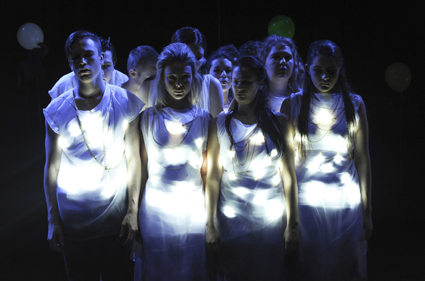
AIM Dramatic Arts, Physical Stages, Lock & Key, 2013
photo Heidrun Löhr
AIM Dramatic Arts, Physical Stages, Lock & Key, 2013
Just across Pitt Street from the RealTime office can be heard sounds of harmony and conflict issuing from the Pilgrim Building (home to the Pilgrim Theatre), where drama students are in training at the Dramatic Arts school. It’s a nice change from screams, curses, car horns and abuse, if sometimes alarming when collective passions are riotously released.
Theatre director Peta Downes, who has performed with Brisbane’s Zen Zen Zo and trained with Anne Bogart, is the new Head of Dramatic Arts (formerly AADA) at the Australian Institute of Music (AIM). She has a vision for greatly enhancing her students’ creativity. “We aim to equip our students with the ability to write a first draft, go to a dramaturg or develop an idea on the floor and get a writer in, as well as being able to work out the finances and use crowd funding. We want them to be employed, and we have a very good track record there, but if not then to create their own work.”
Consequently, Downes sees collaboration as central to actor training. In the concentrated three-years-in-two degree course, teamwork extends to direct engagement with lighting and set design and hands-on backstage experience, with first year students “working on second year productions and learning how to be part of a team.” As well as addressing acting fundamentals, creativity and collaboration, first years engage in scene work and, in the Physical Stages unit, with a physical theatre director.
In the second year “students perform a classic text, construct one of their own in the New Short Works program and work on a ‘given’ text which they produce as well as act in. They will have done Contextual Studies looking at mythology, archetypes and storytelling and will draw on this with the works they’re creating.” A professional director, “probing the world the students are creating,” also works with a student director and dramaturg in each case. Dramaturgy students adapt and correlate material and score physical theatre scripts.
Interestingly none of the current new short works, which have to be imagined, pitched, worked on the floor and scripted with the guidance of director and dramaturg Margaret Davis, is conventional. They are a reworking of the Trials of Azdac in Brecht’s The Caucasian Chalk Circle, and Akio, aimed at a younger audience: “a response to the work of Suzuki Tadashi that also engages with anime as well as with traditional Japanese culture in the form of Kabuki and Noh.” A third short work “responds to Virginia Woolf’s A Room of One’s Own and Orlando as an exploration of the writer’s mind before she decided to end her life.” Downes is emphatic, “Devising is integral to the course.”
Downes describes the two-year Bachelor of Performance course as “vocational, striking a balance between practice and theory and with a practical outcome at the end of each of the six semesters and we seriously address audience development, finances and marketing.”
Many Dramatic Arts graduates have found employment as actors, says Downes, while others have created their own opportunities. She singles out a recent example, Danielle Maas, who with Joseph Kernahan, devised, produced and performed a critically lauded verbatim theatre work, Say Hello First, at Sydney’s Old Fitzroy in July, evidence that the diversity of Dramatic Arts’ approach and its emphasis on building a sense of independence bears fruit.
AIM, Dramatic Arts, http://www.aim.edu.au
RealTime issue #117 Oct-Nov 2013 pg. 31
© Keith Gallasch; for permission to reproduce apply to realtime@realtimearts.net
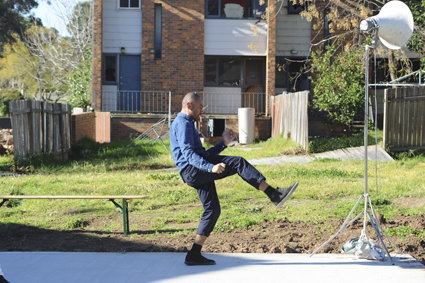
Brian Fuata, Privilege (House), Temporary Democracies
photo Heidrun Löhr
Brian Fuata, Privilege (House), Temporary Democracies
Can a neighbourhood sausage sizzle qualify as art? What about a table tennis competition in a local clubhouse? When it comes to socially engaged community art projects, it can often be near impossible to demarcate the boundary between ‘art’ and ‘life’. This is certainly true of the works that make up Temporary Democracies, a series of site-specific art and performance installations located in the South Western Sydney suburb of Airds.
Currently home to thousands of individuals and families who rely on public housing, 70% of Airds will be redeveloped over the next 15 to 20 years with a large proportion of its population to be relocated elsewhere. Demolition is already underway, leaving vacant a number of houses and empty blocks of land. For Temporary Democracies, an initiative of Campbelltown Arts Centre supported by the NSW Land and Housing Corporation, curator Paul Gazzola has invited 13 artists to develop projects over the next two years that engage with the urban conditions of the area and reflect on the changes affecting this community. The first instalment this year saw a handful of Australian artists consulting and interacting with local residents as they developed works onsite over five days in August, using vacant homes and empty land as inspiration for their installations.
The scene I encounter on a bright Saturday afternoon initially feels more like a friendly neighbourhood street party than a contemporary art project. A small crowd is milling around a food trailer, chatting casually, hotdogs in hand. This is artist Robert Guth’s Mobile Cooking Hearth, a van that has been constructed by Guth together with members of the Airds/Bradbury Men’s Shed group using the remains of kitchens from demolished houses.
Cooking as art has been done before—most famously by Rirkrit Tiravanija who offered gallery visitors homemade curry and pad thai meals at his New York shows during the 1990s. But Guth has taken the extra step of moving out of a gallery setting and placing his work directly onto the street by creating a mobile cooking facility that will remain a permanent part of the Airds community. If sharing food is the ultimate communal act, Guth’s project shifts the meaning of art from aesthetic to social. It may appear decidedly lo-tech and anti-aesthetic, but as the afternoon wears on and my new friends and I pass around the tray of freshly baked lemon cookies that the artist has produced from the trailer’s oven, I experience firsthand the potential of this project to foster human relationships.
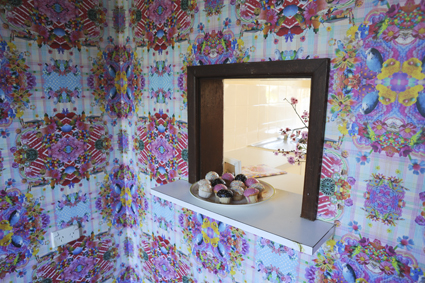
Tanya Schultz, Dreamers who seek treasure, Temporary Democracies
photo Heidrun Löhr
Tanya Schultz, Dreamers who seek treasure, Temporary Democracies
Across the street, Elizabeth Woods has transformed the interior of a newly vacated house into a table tennis drop-in centre which she has called The Academy—What’s Your Game? It’s decorated with trophies and memorabilia, including photographic portraits of smiling Airds residents, and Woods is on hand to keep score for children playing enthusiastically. Meanwhile, the property next door has had its walls covered floor to ceiling by Tanya Schultz’s Dreamers who seek treasure, a multicolour wallpaper collage created using photographs of items that have been donated, lent and constructed by residents. Schultz tells me she set up an art and craft table in the Airds village shopping centre and that her wallpaper features images of the objects made by children who stopped by, as well as photographs of neighbourhood pets including Phil’s budgie and Pumpkin the dog who lives next door. It is unashamedly kitsch and playful, and the burst of colour it brings is eerily juxtaposed with the stillness of the empty house that we know will soon be torn down.
Brian Fuata’s Privilege (House) is the most artistically ambitious project of the bunch. The artist sits outside on a rectangular concrete slab that has been laid on a vacant block of land. His program notes state that he aims to “sonically reconstruct a recently demolished house.” His voice is projected from four speakers that face out towards the benches on which we are invited to sit around him. At one point he recites strings of seemingly random letters, before reading definitions of words that appear to be related to themes of place and location. His lone presence and echoing voice create a compelling visual and sonic image that feels somewhat like a poetic rendering of a Rachel Whiteread work: whereas the UK artist’s concrete casts make physically present the interiors of negative spaces we do not usually see, Fuata evokes a now-absent physical structure through abstract and ephemeral sounds.
Complementing these installations is Rebecca Conroy’s artist blog which can be accessed at www.temporarydemocracies.com. As more material is added online in the months ahead, it looks to be a useful resource in framing the onsite events within a wider social, political and artistic context. By creating collaborative art with a community in transition, the legacy of Temporary Democracies may well persist far into the future.
–
Read “Live art from demolition,” an interview with Paul Gazzola and CAC director Michael Dagostino about Temporary Democracies in RT116.
Campbelltown Arts Centre, Temporary Democracies, curator Paul Gazzola, Heathfield Place, Airds, 13-17 Aug; www.temporarydemocracies.com
RealTime issue #117 Oct-Nov 2013 pg. 32
© Ilana Cohn; for permission to reproduce apply to realtime@realtimearts.net
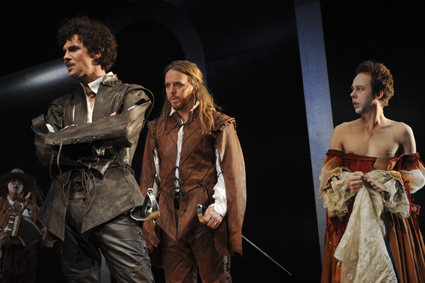
Rosencrantz and Guildenstern are Dead, STC
photo Heidrun Löhr
Rosencrantz and Guildenstern are Dead, STC
The slipperiness of identity, whether a matter of clinging to or searching for it is a commonplace in fiction and theatre, let alone in real life where it keeps many a being from a sense of wholeness. Three productions in Sydney have addressed this: the STC’s Rosencrantz and Guildenstern are Dead in which the duo’s quest for being in a world that refuses to properly identify them is dressed with a scarily surreal aura; Back to Back Theatre’s Super Discount which puts to the test a ‘disabled’ man’s identification with a super hero and its ramifications for his friends; and Moogahlin Performing Arts’ This Fella My Memory, in which three women struggle to re-achieve their sense of connection with family and country.
STC, Rosencrantz and Guildenstern are Dead
With Escher-like perceptual playfulness, Gabriela Tylesova’s design (with enabling lighting by Nick Schlieper) for the STC’s production of Tom Stoppard’s Rosencrantz and Guildenstern are Dead (1967) could have come straight out of a Polish theatre production of the 60s. Stark cloister arches on the sides of the stage angle in without meeting, yielding an ominous upstage void. The spaces immediately behind the arches at first appear to have depth but are later blackly forbidding, constituting a symbolic barrier for the play’s trapped protagonists, already confused and ineffectual victims of pure, or let’s say theatrical, contingency. If that weren’t enough, a large inverted, abstracted tree hangs above the pair, like a cipher from Beckett’s Waiting for Godot rendered by a Polish modernist.
Of course, the play is a riff on Waiting for Godot in which, instead of a landscape empty save for a tree, we have the world of Shakespeare’s Hamlet experienced as if from the sidelines by two of its doomed minor characters. The air of calculated Mittel European surrealism in the design is amplified by the pair’s naïve and increasingly desperate philosophising as well as in the costumes and grotesque demeanour of the hyperbolic figures they encounter—the actors on their cart like a circus crew from a Bergman film and Gertrude (an unrecognisable Heather Mitchell) an explosively exasperated wordless take on Elizabeth I.
Although perpetually panicked, Rosencrantz and Guildenstern themselves appear relatively normal: a couple of tolerably well-dressed gentlemen. Toby Schmitz’s intellectually posturing Guildenstern prances about, underlining thought bubbles with idiosyncratic gestures. Tim Minchin’s Rosencrantz, less alert than Guildenstern, but capable of his own flashes of illogical brilliance, hesitates and darts, stays close to the ground as the pair fill the waiting with ridiculous but sometimes alarmingly meaningful speculation. This tightly teamed, flawless duo is superb, as is Ewen Leslie’s ebullient leader of the actors.
An aura of pathos forms as the play ends, two likeable innocents, despite all their naïve attempts at understanding their condition, surrender to the ultimate blackness threatened throughout by the stage design of the provisional world they inhabit and the inadequacies of language—“words, they’re all we have to go on.”

Mark Deans, Simon Laherty and Brian Tilley, Super Discount, Back to Back Theatre
photo Jeff Busby
Mark Deans, Simon Laherty and Brian Tilley, Super Discount, Back to Back Theatre
Back to Back Theatre, Super Discount
Like Stoppard’s Rosencrantz and Guildenstern are Dead, Back to Back Theatre’s Super Discount (for Sydney Theatre Company and Malthouse) is another gripping account of existential angst within a theatrical framework. This time a group of performers with intellectual disabilities in a rehearsal room decide to perform a work about the superheroes beloved by one of their number, Mark Deans. However, believing that he’s not capable of playing a super hero, they instead audition each other and a cocky ‘able’ actor (David Woods), squabble (some very funny, quick-witted exchanges between Brian Tilley and the others), tear into patronising audiences and slip into superhero costumes. But then they falter as the inauthenticity of the process dawns on the director, Simon Laherty. He suspects Mark should be playing the superhero. The outcome is funny, spectacular (lighting Andrew Livingston) and telling—that sometimes simple solutions are best.
The ambiguities constellating around persons with disabilities being represented as superheroes, save it seems for top-ranking sports people, are many. Back to Back avoids any easy affirmation of the underrated capacities of the ‘disabled.’ Instead they face the complexities—degrees of ability, prejudices among the ‘disabled’ themselves and the theatrical demands of casting—that have made the creation of a work, initially as a tribute to Mark, so troublesome.
Another complicating factor is the presence of the ‘able’ actor, disgruntled because disadvantaged in not having a disability—he’s never praised by audiences. Not surprisingly, he is cast by his fellows as the bad superhero. His angst is best displayed by Woods in dialogue, less well when it becomes a monologue leaving the other performers inert and the momentum of an otherwise brisk production stilled.
The audition routines, debates, role playing (Laherty in a wig as a super hero’s girlfriend), super hero dancing (Woods and Tilley choreographed by Antony Hamilton), Scott Price’s obstreperous interventions, nice touches like Sarah Mainwaring’s battle to mount a microphone on a stand, witty scripting and a strong focus on trust—will the group do the right thing by Mark?—all add up, delivering a satisfyingly complex and richly entertaining experience.
Moogahlin Performing Arts, This Fella My Memory
A large cloth screen, timber walkways and an open space to the front of the stage facilitate the presentation of various encounters and locations, urban and rural, and a very active spirit world in This Fella My Memory. The writing, the plot and characterisations are straightforward, but the actors deliver nuanced performances that suggest more complex personalities. Vast projections of night skies, rippling water and glittering traffic flows in a distant city amplify a sense of people in narrow circumstances looking for bigger lives.
Dolly (Lily Shearer)—a middle-aged Indigenous alcoholic who is hit by a car and loses her place in a hostel for homeless women—fears she is dying and yearns to visit her country. A grumpy cousin, Toots (Elaine Crombie), begrudgingly agrees to take her, but has to be coerced to also deal with Colleen (Linden Wilkinson), a white woman friend in the hostel who doubtless gave Dolly the grog that got her into trouble. While tension on the road between Colleen and an unforgiving Toots (who meanwhile indulges in a fantasy of returning to a singing career she ruined) doesn’t let up, Dolly begins to improve, if haunted by the ghosts of two girls from her country’s past.
From here on the plot grows more complicated as the unwelcome trio encounter Toots and Dolly’s relatives, enabling the play to take in issues of juvenile crime, rape and murder (hence the presence of the two ghost girls), return to ceremony and a young middle class woman’s discovery that she is Aboriginal. As well, Colleen reveals her past and its Indigenous connection and Toots finally acknowledges that she has no singing contract. It’s almost too much, veering into soap opera territory as crises mount and are too easily resolved, but director Frederick Copperwaite’s careful pacing and the intensity of the playing compensate somewhat for misgivings. Certainly the collectively composed writing, which oscillates between sharply observed and pedestrian, could be improved should the play have another life.
As “the first Aboriginal theatre production created, developed and produced by an Aboriginal company in Redfern in almost 40 years” (press release), This Fella My Memory is a welcome indication of the potential of Moogahlin Performing Arts to bring new perspectives on Australian life to the stage, in this case with a focus on the challenges for disadvantaged middle-aged women to recover their sense of agency and identity.
Sydney Theatre Company, Rosencrantz and Guildenstern are Dead, writer Tom Stoppard, director Simon Phillips, Sydney Theatre, 28 Aug-14 Sept; STC, Malthouse, Back to Back Theatre, Super Discount, director, devisor with the performers Bruce Gladwin, Wharf 1, 20 Sept-19 Oct; Moogahlin Performing Arts, This Fella My Memory, director Frederick Copperwaite, created & devised by Moogahlin Performing Arts & Linden Wilkinson, Carriageworks, Sydney, 4-7 Sept
RealTime issue #117 Oct-Nov 2013 pg. 34
© Keith Gallasch; for permission to reproduce apply to realtime@realtimearts.net
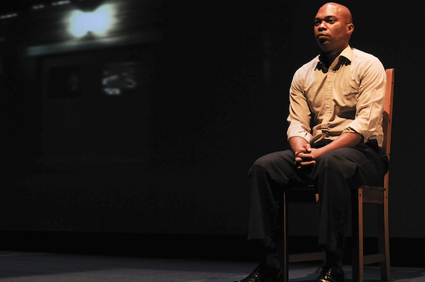
Irving Gregory, The Disappearances Project
photo Heidrun Löhr
Irving Gregory, The Disappearances Project
After several years of ‘emergence,’ version 1.0 erupted into prominence at Performance Space in 2001 with The second Last Supper featuring a mix of the not-so ‘old guard’ from the contemporary performance community and the new, along with nightly consumption throughout the season of an enormous volume of red wine in an outrageously surreal, promiscuously wide-ranging taboo-busting epic.
Moving resolutely on to tackle political issues still largely unaddressed by Australian theatre, version 1.0 has rarely lost that sense of fun, even when tackling the darkest of subjects. Material taken from public and parliamentary records about the Children Overboard saga (CMI, A Certain Maritime Incident, 2004), Government media manipulation about the Iraq War (The Wages of Spin, 2005), Australian Wheat Board corruption in Iraq (Deeply Offensive and Utterly Untrue, 2007) and local government corruption (The Table of Knowledge, 2011-12) has been ironically reframed, physically, vocally, spatially and technologically, without resorting to satire or mimicry.
These works are still enormously relevant. Version 1.0 has also tackled masculine violence, the suffering of people whose relatives have disappeared—in The Disappearances Project—and “place, tourism and atrocity” in Kym Vercoe’s seven kilometres north-east (which has become a film, Jasmila Zbanic’s For Those Who Can Tell No Tales, featured in the 2013 Toronto Film Festival), and a history of the maltreatment of the people of Palm Island, Beautiful One Day, produced as a collaboration with Ilbijerri Theatre. For Canberra 100 the company recently created the much praised The Major Minor Party, about the ACT-based Australian Sex Party and its impact on Australian political culture.
Hot on the heels of The Major Minor Party comes The Vehicle Failed to Stop. In 2007, a 49-year-old taxi-driver Marou Awanis and her friend Jeneva Jalal were shot by private security contractors working for the Australian-owned company Unity Resources Group, “an integrated risk mitigation solutions provider for clients in complex, challenging and fragile environments, globally headquartered in Dubai.” Apparently the car got too close to a security vehicle albeit in a safe part of Baghdad. Coming after similar deaths, the killings resulted in widespread protest. The Iraqi Government attempted to ban the American security firm Blackwater from the country. A legal team working on behalf of the women’s families filed a suit in Washington. However, the American Government claimed to bear no responsibility for overseeing outsourced security operations, therefore the families have had to sue URG. RT spoke with Irving Gregory, a current member of version 1.0, about himself as a performer and the issues focused on in The Vehicle Failed to Stop.
Tell us a little bit about your background as a performer.
Basically I came out of New York University’s Experimental Theatre Wing in the Tisch School of the Arts undergraduate drama program. Very lucky there to have worked with people like Anne Bogart among other people in the mid-80s before she came up with her Viewpoints concept. I worked the downtown dance and performance scene in New York in the 80s. Then I travelled to Germany, worked in the free scene in Munich and other cities. Travelled around there. Came back to the States in the 90s, tried to do movies for a while and got back into theatre in the late 90s when I joined the Collective Unconscious in New York.
While at the Collective Unconscious—which we ran as a collective and put shows on there to pay the rent basically—we developed a performance called Charlie Victor Romeo which won two Drama Desk Awards, travelled all over the US, was co-produced in Japan, came here to the Perth International Arts Festival, was filmed by the Air Force for training, picked up by the medical community…It had a long and storied history and was made into a film last year, which premiered at Sundance Film Festival this year.
The text is the transcripts of six actual airline emergencies—black box transcripts which we dramatised, live onstage with an award-winning sound design. In 2004 Time magazine named it as one of the best plays of the year. I’m in the film and also credited as one of the screenwriters as I’m one of the creators of the play.
What drew you to Australia?
Well, I got married. I met my wife in Perth when I was here in 2002. We stayed in touch and got married in 2008. I then talked to people at version 1.0. They got back to me in 2011 for The Disappearances Project. That’s when I joined the company.
What’s the attraction of working with version 1.0?
Well it’s always the people and the work. From Charlie Victor Romeo, I had an interest in this type of theatre—theatre documentary style and/or verbatim style. I’d done elements of that kind of work since the late 80s actually. I did a piece with [performer, dancer, painter] Fred Holland, basically as a sound operator. He had an interview in the piece, which was about the fight career of Jack Johnson, the great boxer, and the interview with him was about when he had to surrender the title—because the Feds were going to prosecute him under the Mann Act [a law against ‘white slavery’ but used to criminalise consensual sexual behaviour between blacks and whites. EDs]. I worked with this piece to re-integrate it a bit more and discovered the power of an interview—real words—and how that can work dramatically. I worked subsequently in Germany with an interview-based piece called Packing and Shipping. Learning version 1.0 did that kind of work I became interested in them. The Disappearances Project was the first work I did with the company and The Major Minor Party, which we premiered in June, is the second.
The Vehicle Failed to Stop, is predicated on a terrible incident in Iraq, when two women were killed by security contractors.
The initial development at the Sydney Theatre Company in 2012 was by David Williams, Kym Vercoe and Jane Phegan. I worked on the development of the idea in March of this year. In working with verbatim and/or interview and/or transcriptional sources there’s a lot of editing that has to be done, a lot of focus on what is important and what needs to be conveyed. What we brought out in this latest development was not only the fact that extra-judicial killing had occurred in an environment where a lot of this kind of thing had taken place through the use of contractors, but a focus on the whole nature of privatisation. And this extended to the entire administration of Iraq during and after the invasion. Paul Bremer [Administrator of the Coalition Provisional Authority of Iraq after the 2003 invasion], through one of his notorious orders, basically opened up the country to exploitation by any and all private industry because that was a part of the strategy.
Based on the neo-liberal assumption that this would solve everything.
Exactly, but then you have it taken to the extreme, being imposed upon an entire country at one time. It’s about the broadest sort of utilisation of that economic theory possible. You invade a country, you knock out the government, you fire everyone and you just say, ‘well, it’s open season for any and all entrepreneurial ideas to come in here internationally with no accountability to anyone.’ What are the consequences of this? One we found directly related to the incident with the two women is that you have a lot of security people on the roads operating beyond anyone’s law with the only consequence of their actions that they may be fired and sent out of the country. There’s no jurisdiction.
What kind of verbatim material are you using?
Documents derived from books and articles about Erik Prince, the head of Blackwater Security Consulting, and about the case itself as it was attempted to be adjudicated in the US and abroad. Then there are the pronouncements of and articles about the Bremer administration and also transcribed documentary footage about other elements of the privatisation and the experience of private contractors in Iraq. Another thing is that these companies—Halliburton, Kellogg Brown & Root, Blackwater, which reaped billions of dollars in profits, out of this wide-open, almost Wild West, boomtown environment—were not necessarily protective of their employees. They just send them to a country that has been supposedly ‘secured’ and what happens is people who aren’t security contractors, but truck drivers, are killed. Because the companies want to maximise profits, because they have a bottom line to meet, these men find themselves being shot at in gasoline trucks. What is that?
One of the companies involved is the ex-military Australian-owned URG.
Yes, they were the contractors involved in the incident with the two women being killed. In Afghanistan right now there are more contractors than troops. People may not know that. Of course, when the troops leave next year there’ll be opportunities for private contractors to continue security and other sorts of missions there. So this is a new element of international relations—how governments deal with international crisis points. Because when you don’t have to use your national army, when you can use private companies, then you’re not really accountable to anyone.
It goes nicely in tandem with the roboticisation of war in the form of drones and so on.
Well, it’s the 21st century we’re looking at. This is the way things are going, the way that war is now being prosecuted, or small wars—that’s all we have any more, isn’t it?—a changing environment in modern conflict, an environment without accountability or responsibility.
Carriageworks, version 1.0, The Vehicle Failed to Stop, Carriageworks, Sydney, 15-26 Oct
RealTime issue #117 Oct-Nov 2013 pg. 35
© Keith Gallasch; for permission to reproduce apply to realtime@realtimearts.net
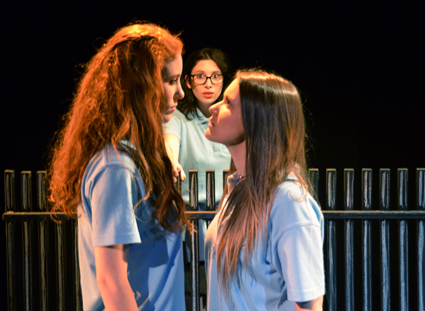
(lr) Danielle Baynes, Nicole Dimitriadis, Kate Englefield, Tough Beauty
photo Claudia Chidiac
(lr) Danielle Baynes, Nicole Dimitriadis, Kate Englefield, Tough Beauty
Projected onto a versatile, mobile stage flat, Karina Gonzalez greets us with with a sophomoric sneer. She is the alluring husky voiced TK, lyrically and graphically inviting us to relive or even abet a violent event in which she leads her gang into baiting and subsequently knifing an unsuspecting, unnamed victim.
Aided by a supporting cast of witnesses who provide verbal testimony in fragmented drip-feed, the work strives to highlight the authoritative claim to authenticity of video documentation, begging the question: if there was no one to film it, did it really happen?
Written by Finegan Kruckmeyer and directed by Claudia Chidiac, the development of Tough Beauty is the first in-house work facilitated by Casula Powerhouse Arts Centre, itself a concrete paean to arrested brutalist vision in the heart of the Moorebank Parklands. It aptly points to the inspiration for the work’s concoction: a rash of YouTube videos actually depicting suburban teenage girls beating each other up, the art of hazing and contemporary schoolyard politics refracted through the self-promotional lingua of social media.
The first onstage characters we meet, Rana (Danielle Baynes) and Nat (Nicole Dimitriadis), dive straight into reviewing their place in the schoolyard pecking order in dialogue that is deft and light-hearted. The stability of this alliance seems to be threatened by the hovering Mika (Rebecca Hitch), the resident bully whose ties to TK are suggested. Rana’s meditation on the dormant bloodlust that rules the schoolyard forces us to share Kruckmeyer’s self-confessed awe at what he has heard over months of research.
However, it is when New Girl emerges that the pot is stirred for real. By far the most intriguing character onstage, Kate Englefield capably embodies her with a pronounced skulk, alluding to a troubled past cited as the reason for the transfer. When we see her cornered at the toilet block backdrop, the New Girl’s mask of survival endures a verbal assault, confidently delivered by Mika in slam-meter and supported by Shauntelle Benjamin’s silent and agile sidekick. The stage combat that accompanies this is swift and fluid but nothing prepares us for the New Girl’s Hulk-like explosion heard from behind the toilet door.
Drawing on conversations with students, educators, researchers and artists, Chidiac and Kruckmeyer, assisted by a tense and haunting soundtrack (Gail Priest), stitch together a portrait of narcissism that also defers to a technological hall of mirrors populated by psychopathic impulses.
Tough Beauty sits well as a conjectural response to last year’s The Tender Age (version 1.0, ATYP) and Lachlan Philpott’s Truck Stop (Q Theatre), the creative team drawing from a rich thematic and solid research methodology. While the work is effectively founded on the theatrical adage that the hidden can be more powerful than the seen, it nonetheless leaves room for development, namely greater clarity about the New Girl whose story drives the work.
Casula Powerhouse, whose home is threatened by development of a transport hub, deserves to live on as is, continuing to seed stories that need to be told.
Casula Powerhouse Arts Centre Productions, Tough Beauty, writer Finegan Kruckemeyer, director Claudia Chidiac, video design Elias Nohra, design Arthur Koutoulas, costumes Ruby Langton-Batty, Powerhouse Arts Centre, Casula, NSW, 15-17 Aug
RealTime issue #117 Oct-Nov 2013 pg. 38
© Teik-Kim Pok; for permission to reproduce apply to realtime@realtimearts.net
This year’s Junction Festival was an invitation to listen: carefully, intimately, deeply and playfully. Whether via the beats and breath of the city’s artists in the walking experience of Enroute or the iPod-directed audio-virtual reality in the physical theatre performance Blindscape, deep listening in this festival was rewarded with unexpected shared intimacies of place, body and mind.
Even the listening (and grooving) at the raucous Junc Room, a big top tent at the heart of this much anticipated winter’s-end event, invited a shambolic kind of intimacy among the multi generations and tribes who call Northern Tasmania home. Now in its fourth year, Junction wears its contemporary arts/community ‘glocal’ cred very well indeed.
And so it was a little disheartening that one of the headline international acts in ‘the art of sonic culture’ for this festival wasn’t all it might have been. Dogs and Boats and Airplanes Children’s Choir was a world premiere collaborative artwork performed by a children’s choir of 100 voices. Conceived by Toronto conceptual artist, Bill Burns (see interview RT116) with artistic partner and cultural researcher Krys Verrall (under the name Big Pond Small Fish), the central intent—to capture a “radical banality” where ordinary things tell extraordinary stories through sound—had much going for it, especially given the delicious potential for rupture and irony in the cultural and literal frame of Launceston’s majestic proscenium arch Princess Theatre. Dogs and Boats was billed as provocative, edgy, ‘is this art?’ kind of stuff. And what better collaborators to imagine playing at such edges than 8 to 12 year olds who know all about dogs, boats and airplanes—if not in reality then in rich fantasy lives.
To devise such a large-scale multi-participant, multi-layered work with over one hundred children in just six weeks was logistically a feat in itself. And for that, Burns and Verrall with the students of four Launceston schools, choral director Amanda Hodder and choreographer Emma Porteous are to be applauded. The participants engaged in drawing and writing their own stories as a precursor to creating the libretto in that time. Themes of absence and loss co-mingled with adventuresome snapshot narratives of dogs and clotheslines and happy fishing trips. In performance, small clusters of students conveyed these snapshots in spoken word with the rest of the choir—traditionally positioned in a bank on stage—dedicating their choral voices to reverberating these stories in sonic play.
But in a country renowned for producing internationally leading works for and by young people, Dogs and Boats served to remind us of the crucial value of time in generating genuine artistic collaboration with young people. For while we were presented with insights into children’s lives in Dogs and Boats there was little sense of a collective energy having developed among the performers on stage. While the sounds of dogs barking and mechanical engine whining communicated well enough as a quirky and abstracted focus for a choir, the novelty soon wore off when we realized there was very little way in for us as audience to share in the listening. Except near the end, when we were invited to throw paper airplanes toward the stage.
The choir and audience erupted and for a split second the frames of performance were distorted in interesting ways. Was this the edgy bit promised? This production is the result of a curious and brave artistic turn for Burns whose internationally renowned gallery work has focused on animals and civil life. Burns’ recent studio-recorded sound art on the same theme of dogs/boats/planes in Toronto was a sharp pairing of kid voices and their curated soundscapes that conveyed some exquisite conceptual play between profound and not-so-profound domesticity. So perhaps the performative meeting of sonic and visual cultures in this piece—Burns’ next step with his artistic work—was not quite as brave or committed enough? Like the “scream when you see the villain” style of children’s theatre of old, my young companions and I couldn’t help but feel the paper airplanes thing was a little too token in a project that held such promise. Then again, isn’t that exactly what festivals are about? The space in which to take risks? We’re glad Burns chose to do so here.
Junction Arts Festival 2013, Bill Burns and Big Pond Small Fish, Dogs and Boats and Airplanes Children’s Choir, The Princess Theatre, Launceston, 6 Sept
RealTime issue #117 Oct-Nov 2013 pg. 38
© Mary Ann Hunter; for permission to reproduce apply to realtime@realtimearts.net
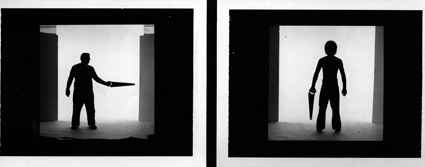
Andrew Livingston, Ben Cobham, courtesy Bluebottle
Melbourne’s Bluebottle is a company that has wrought lighting wonders for artists and civic and commercial enterprises for whom it has transformed theatre and other spaces (museums, galleries, parks, a zoo, 2013 New Year’s Eve celebrations in Melbourne) as well as creating portable buildings for artistic purposes.
The latter include ANAM Quartetthaus, for string quartets in the 2011 Melbourne Festival, and the Hub for the 2013 festival (part of a three-year contract), a pop-up venue housing much of the live music program, DJs and bars, with room for 300-500 people. In Sydney recently, their work was seen in Byron Perry’s Double Think and Back to Back’s Super Discount.
There’s a characteristic luminescence to Bluebottle’s lighting—colours rendered curiously intense or oddly foreign, colour planes that float, boundaries that become indiscernable and darkness that evokes the abyss. Above all, Bluebottle’s lighting often creates much of the overall design for a work, generating spaces. In Helen Herbertson and Ben Cobham’s Sunstruck (2008) the audience is seated in a circle around which tracks a huge light enveloping the performance area.
I’ve seen a lot of Bluebottle’s work over the years, but first came Ben Cobham at Antistatic Dance Festival in 1999, squatting on the floor with a slide projector between the audience and dancer Helen Herbertson on the old Performance Space stage. As Cobham ‘simply’ manipulated objects in front of the projector the three-dimensionality of Herbertson’s world was flattened, her presence made ghostly and intermittently glimpsed. Out of this work, Strike 1, came Delirium, the beginning of a long collaboration with Herbertson, (see the realtimedance entry on the choreographer at realtimearts.net), with their works acknowledged as co-creations.
Just over a decade later I saw Jenny Kemp’s wonderful Madeleine (RT99); this time much of the power of Bluebottle’s design was felt on the horizontal plane, as if the characters were suspended in the mythical space of its mentally distressed heroine’s making. In talking about that design, Cobham reminds me that Herbertson has been a collaborator and performer in Kemp’s work prior to Madeleine: “from a design sense Jenny’s work has often been quite complex, with trains and gardens and a sort of surreal realism. To a degree with Madeleine, Herbertson and I worked with Jenny to simplify the form, to let the writing come out more.”
Bluebottle’s recent work has included Tim Darbyshire’s perceptually challenging More or Less Concrete at Dance Massive earlier this year (RT114), with hauntingly low lighting by Ben Shaw who, although having left the company to pursue his own career, is working on Paul Kelly’s Conversations with Ghosts for Bluebottle. Blackout magic was central to Tamara Saulwick’s Pin Drop (RT111; 2010) and extreme diffusion of light helped make Back to Back’s Food Court (RT92) one of the most disturbing shows I’ve seen in recent years. Livingston says, “You forget when you’ve seen it a few times but I was pretty unnerved by it at the first script read.”
Sharing the light
Bluebottle has also had a long association with dance, including one of my favourites, Lucy Guerin’s Structure and Sadness (2006; RT76). I wonder how important a sense of collaboration is for the pair as opposed to simply providing a service. Livingston recalls how much they liked working on Structure and Sadness: “We were discussing it the other day. We haven’t got to do as many of those long-form collaborations lately. Ultimately, collaboration is everything really.” Cobham adds, “It’s probably our best asset and our biggest problem. Over time our practice has become very specific, like all things this works for some and not others.” Livingston adds, “But it’s reflective of how we work here as well. Bluebottle is actually a big, collaborative group—not a collective as such but it is certainly a very collaboratively based process.”
I ask how Livingston and Cobham came to work together and why their work moved beyond theatre. Cobham recalls, “Andy and I met at St Martin’s Youth Arts Centre. I’d finished university; Andy had finished high school. The day I started he was the first person to walk in the door. We did Jack and the Beanstalk together. That was our first gig. Andy was the beanstalk operator and I did follow-spot. So over time we started doing lighting designs together, which people thought was a bit weird but we felt we were getting better results as a pair so we just carried on, doing shows at Anthill, Danceworks and St Martins Youth Arts Centre.”
The pair’s entry into commercial work came when Cobham’s brother Geoff (the renowned Adelaide-based lighting designer) “started getting some museum work and we supported him with the installation. Architectural firms would come to see our shows and they’d say, we’d love you to come and work on a project with us. So five or six years after we met, we started to get offers: Melbourne Museum was one in 1999 followed by the South Australian Museum. It was all very organic.”
I note that Bluebottle lays claim to “innovation in light and form” on its website. I wonder how much research and risk is involved in their work. Cobham responds, “I think we’ve sort of weirdly learned organically. When we were younger we were around a lot of people who were big risk takers—people like Helen Herbertson and Simon Barley, people who really worked very much outside the box and we really loved that. We were always there for them going: ‘Yeah, come on, let’s do that!’ I think that probably helped set the tone for us.” Livingston agrees, “It didn’t seem unusual to take a risk. Where we were working, it was expected that some things would work and others wouldn’t. You’d have a go.”
The distinctiveness of Bluebottle’s lighting suggests great technical proficiency, leaving me wondering how they achieve their peculiar brand of magic. Surprisingly, Livingston declares, “neither of us is very super-technical. There are certainly a lot of people around who are much more au fait with high-end computer technologies. The idea is always the place to start and then work backwards on how to realise that rather than finding the technology and then forcing it into an idea. The research is driven by wanting to get the idea out into the world or onto the stage. We keep asking questions until we work out how to make an idea real.”
Cobham makes a significant point about communication in their work: “One of the big things we’ve discovered is you think you’re doing lighting, set design or working in theatre, but at the end of the day, a lot of it is actually about communication. To some degree just trying to make a lot of different people understand a common thing. It’s funny—we all think we know what the colour red is but we don’t really know that we see it the same way. A lot of what we do is about testing and demonstrating, which invites everybody to look and understand as they see it.”
Lab Bluebottle
I’ve always assumed that Bluebottle must have had a laboratory space in which to trial their innovative lighting ideas before moving into the theatre. “We do now,” says Andy, “Just in the past 12 months. Our building here in North Melbourne is a kind of warehouse/office. We just realised we didn’t really have a space, so we made one. For the first time we have a proper dark space we can black out, where we can do technical development. This was made possible with assistance from a Sidney Myer Creative Fellowship that Ben was awarded.”
Significantly, Bluebottle is making this space available to artists when it’s not in use. Ben explains, “We want to encourage other people to experiment technically. We lease it for not very much if they’ve got a good, honest cause. We don’t let people use it for rehearsals unless they’ve got something technical they’re trying to sort out. We allow them to use any equipment we have here—they’re odds and sods but they’re unusual odds and sods. The idea is that hopefully they inspire us and we give them a little bit of our time if they want it and, if they don’t, we just stay out of their way. Secretly we hope that the concept of the lab is something that perhaps some of the bigger companies will take on and set up their own labs in their own buildings.”
I’m curious that given their art is realised by and large in collaboration, whether Livingston and Cobham have ambitions to create their own stand-alone works? Cobham says, “There are a few little things that Andrew and I are cooking up. When we do get to talk it’s usually in the driveway late at night. We are talking about it which means it is going to happen eventually.” Whatever the venture, Cobham and Livingston will doubtless continue to exercise their wizardry collaboratively with adventurous artists and amaze us all.
See www.bb3.net.au for numerous images of Bluebottle’s work.
RealTime issue #117 Oct-Nov 2013 pg. 39
© Keith Gallasch; for permission to reproduce apply to realtime@realtimearts.net
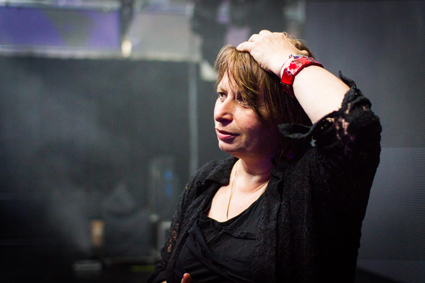
Jo Truman
photo Alia Grinvalds
Jo Truman
Jo Truman’s remarkable voice exceeds three octaves, from dark mezzo to high soprano, improvising flights of song, birdcalls and didjeridu cries, resonant with microtonal complexities and haunting overtones. The artist’s express focus is on “the voice and its ultimate potentials,” realised over some 30 years in live performance and an extensive catalogue of radio appearances and radiophonic works.
Most recently Truman (voice, piano, looping) appeared at the 2013 Mona Foma music festival in Hobart in two dramatically mercurial improvisations with Len Marks on guitar, Daniel Grinvalds on electronics and sampling, and joined by 12-year-old Alia Grinvalds on violin in the second performance. In 2012, Truman produced and performed a radio work, Bridge to Otherness, about Sydney’s Blue Mountains, where she lives, for WDR3 Koln, Germany and has been commissioned to provide libretto and electronics for a 30-minute chamber opera to be created in collaboration with Icelandic composer Hildigunnur Rúnarsdóttir for performance in 2014. The opera, for one voice, oboe, string quartet, clarinet and electronic media, is supported by a grant from the Icelandic State Broadcasting Corporation, Rikisutvarpid.
Despite a recent illness the artist is currently undertaking a Master of Fine Arts degree at CoFA (she completed a Master of Music in Composition at the Sydney Conservatorium of Music in 2008), exhibits her drawings from time to time and sings jazz at a Blue Mountains pub as well as writing and composing. I met Truman at the RealTime office to discuss the motivations for and connections between her practices.
Where motivates you to sing?
I was always prone to mimicry when I was young. I thought the crows were boys in the district yelling out to us, so I’d yell back in ‘crow language’ [LAUGHS], and would mimic my squeaky rubber toys. I think I was encouraged by my family’s amusement: it was a tense family and my mimicry broke the ice so I learned my mimetic talent had a certain power. I used to imitate opera singers too. My father was a pretty good musician who although he was a businessman had songs published in the 40s. He had an amazing ear for picking up anything on the piano and he had unusual tastes for the time—I heard Schoenberg’s Pierrot Lunaire when I was nine, and Poulenc.
It was all play for me, although I had classical piano training to a fairly high level from the age of three. In my teens I heard Meredith Monk and that was very liberating, but I was more an appreciator rather than a practitioner. Then things went wrong in my family in my teens; there was the tragedy of my closest sister dying—she committed suicide. I left school, catapulted out into the world at the age of 16. I was driven to be a visual artist—I did an arts certificate and then started on a diploma of fine arts. At the Alexander Mackie College of Fine Arts [now the National Art School] I would go from drawing into the Cell Block Theatre to sing. I was still traumatised by my sister’s death.
What kind of singing and to what end?
I think what was happening was that I was something of a disembodied young person and I felt empowered and embodied by singing. I could hear the voice coming back and defining me in space. I met Jon Rose and got involved with the Relative Band and Jim Denley. In the Cell Block Theatre by myself I had started connecting improvising with singing with fantasy and flying and to see how far I could stretch the voice. I wasn’t singing songs; my body was a physical score and I could draw feelings and landscape out of it, unimpeded by words and it was transformative. It was like making a line, with a pencil, a gesture, a choreographic sound.
How did the singing grow in complexity and technique?
I fell in love with Cathy Berberian’s singing. She had a classical background that I could relate to, but what she was doing was removed from the classical institution—it was very experimental for the time. That freed me. And from an early age I got fixated on breath moving through different nasal cavities, exploring a kind of atonality. Then there was birdsong. [Truman unselfconsciously breaks into a beautiful high-pitched, fluttering bird cry.] The notes are not semi-tonal, they’re more quarter tonal. While in the Cell Block I started exploring bird sounds and integrating them with bel canto and some jazz styles.
I know now it’s a bit taboo for a woman but I also studied the didjeridu, traditionally the yedaki, in my early 20s. I spent an amazing year, 1983, in the Northern Territory and was taught by master players and makers George Djungawanga and David Blanasi. George taught me how to make my own didjeridu. There’s microtonality in didjeridu playing, so I also started mimicking as well as playing it, producing the overtones vocally because it’s a similar principle, using the tongue.
How did your performing career commence?
I did some concerts with Jim Denley, a very positive musician with strong convictions. I performed with Jon Rose and Henry Kaiser at The Basement and in the Cell Block Series with the Relative Band. Then in 1985, with a grant from the Australia Council’s Music Board I continued my study in England with improvisers such as Phil Minton, studied jazz and counterpoint in Holland, and worked with an amazing French-Vietnamese ethnomusicologist and performer Tran Quang Hai who taught harmonics in overtone singing. Mongolian performers generally refer to it as “throat singing.” I was in Europe for eight years, returned to Australia in 1992, received a live-in stipend from the Akademis Schloss Solitude in Stuttgart for 15 months and then came back here in 1994 to complete my arts degree.
You performed extensively in Europe with a like-minded community of artists.
I thought they’d be a family. [LAUGHS] They weren’t really, but there were great experiences. I threw myself in the deep end and performed in Lithuania with Tony Buck and a lot of improvisers. There was a sense of family. One of the highlights was Songs from a Prison Diary by Phil Minton and Veryan Weston commissioned for the Le Mans Jazz Festival and Strasbourg’s Musica Festival composed around the beautiful poems of Ho Chi Minh. I was the opening improviser on that. I was thinking back to the Cell Block and the dream of flying and escaping—a lot of his poetry works with those images.
In 1991 I composed and recorded Sdreamings, a 30-minute radio play inspired by my time in the Northern Territory. It was produced by Klaus Schoning in the WDR3 studios, then appeared on a Staalplaat CD and in 1999 as a privately produced CD. It was about coming to grips with my own sense of loss and that associated with the apartheid between Australian cities and the land—not denying it, but embracing and transforming it vocally and with birdsong, improvising over recordings.
What drew you to composing for radio and to radiophonic works with a documentary dimension?
There’s less work in that area now, but extended listening is important. I thought radio could open more sonic dimensions for the voice and instruments, and narrative. I was interested in the changing nature of the perception of time as things have sped up. I wanted to create three imaginary Australian soundscapes: pre-colonial, colonial and contemporary. How are we impacted by changing sonic environments? I got a commission to produce Cell Songs with The Listening Room’s Andrew McClennan as executive producer. For part of it I went to the Northern Territory to talk with [the late Kakadu man and writer] Bill Neidjie, whom I met with twice and was honoured to interview. We could do well to heed Bill’s message about what we stand to lose in Australia. WDR3 translated it for broadcast in Germany.
Let’s jump to your recent radio work.
The Bridge to Otherness was a commission from WDR3. It’s about the Blue Mountains, where I live, asking what is wilderness, how do we relate to otherness—people different from ourselves, and nature—and trying to find an empathic answer, a sense of connectedness because I feel that rampant colonialism is still very active and we’re destroying everything at the rate of knots. So, having lived in the mountains for six years, I was looking at the so-called celebrations for the Blaxland, Lawson and Wentworth crossing of the mountains in 1813 and what that meant.
Many people who have felt disenfranchised by the mainstream, or have had particularly difficult lives, come to the mountains to find niches and a sense of community. The bird sound of the area interests me and the strangeness of a suburban corridor which runs up and over an escarpment surrounded by wilderness, and the intense contrasts this creates—the “schizophonia” of it all.
Where did you produce it—a home studio?
Home studio? [LAUGHS] I just use my computer. Thomas Knox, who worked on the Bridge to Otherness, will work with me at his studio on recording my voice and the electronic part of the Icelandic collaboration. I hope to go to Iceland next year.
As well as performing, composing, recording and producing, you continue to draw and study.
Drawing comes and goes. I’m doing a Master of Fine Arts at CoFA. I’ll create an Installation looking at the corridor through the mountains.
I know it’s flavour of the month, but I’m very interested in synaesthesia in my work. I believe I am a synaesthete. I could never make a hard and fast distinction between the experience of the little space before the realisation of a sound or making a mark or a composition forming itself. There’s a place in which all these perceptions come together. I think we’re living in an over-categorised state generally in our culture; this is why I think I branched off into all these different areas because they didn’t feel different. The way I was experiencing them or visualising a piece, I could see that piece coming to me in a shape or a form.
As for live performance, it’s not always comfortable. I’m naturally introverted. Mona Foma was pretty confronting; the first gig was in a huge wharf space. One of my colleagues was saying, “Fill up the space, Jo.” Anyway, it was on radio too—good enough to broadcast I suppose.” [LAUGHS]
RealTime issue #117 Oct-Nov 2013 pg. 40
© Keith Gallasch; for permission to reproduce apply to realtime@realtimearts.net
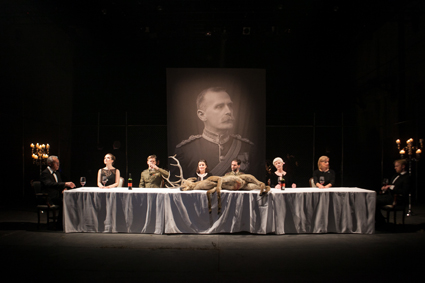
Owen Wingrave, Sydney Chamber Opera
photo Louis Dillon-Savage
Owen Wingrave, Sydney Chamber Opera
Sydney Chamber Opera have successfully resuscitated Benjamin Britten’s TV opera Owen Wingrave (1971) by transposing it to the stage for an Australian audience.
For an opera with a radical message, the original (endure it if you can on YouTube) was sluggish and conservatively realised. Conductor Jack Symond’s pacing of David Matthew’s 2007 adroit chamber orchestration is brisk, intensely dramatic and lyrical where needs be, and all the performances are strong—including a schoolboy choir and a male movement ensemble whose numbers increase our sense of the scale of the issues the opera debates.
Director Imara Savage deftly exploits Karen Woods’ spacious wire-fenced stage, literally an army barracks—replete with a troop of vigorously exercising soldiers (movement director Johanna Puglisi)—and symbolically a psychological prison for the conscientious objector son of a high caste military family. Baritone Morgan Pearse conveys Owen’s moral steadfastness with power and subtlety as he withstands his family’s rejection but finally and fatally weakens in the onslaught from his fiancé Kate—mezzo-soprano Emily Edmonds in a finely articulated, passionate performance.
Staging and direction avoid plain realism—the singing is often direct to the audience, solos are sometimes spotlit, a dead stag (a visual borrow from Benedict Andrew’s AO production of Figaro?) lies across a banquet table, a lamenting boys choir clings to the fence, peering at a fraught adult world, and the flown-in portrait of Owen’s forbear is dauntingly huge and mistily framed. Above all there is a sense of man up against a tyrannically choreographed world, right down to the steady passage across the stage of the ghost of the bloodied child whose death long ago triggered Owen’s rejection of violence.
Britten’s music is more accessible than expected while Myfanwy Piper’s spare libretto is tautly dramatic, although its Edwardian diction rubs awkwardly against the semi-contemporary grain of the production. That aside, Sydney Chamber Opera’s Owen Wingrave was an engrossing and enlightening experience. Director Imara Savage corralled large forces while securing nuanced performances from individual singers, Jack Symonds, as ever, conducted incisively and responsively and the company once again excelled at bringing contemporary chamber opera to a welcoming audience.
Another Sydney-based opera company is Harbour City Opera, whose production of Puccini’s Suor Angelica was engagingly sung if too often one-dimensionally acted (easy to do in this work above others). The uncluttered staging heightened and extended the Paddington Uniting Church altar space out into the audience (seated on three sides) creating an intimate ambience for powerful singing from Sarah Walker (Suor Angelica), Eva Kong (Suor Genevieve) and Sarah Sweeting (The Monitor) in particular. Although the piano score (finely played by Sharolyn Kimmorley) could not do justice to Puccini’s long-lined orchestral plangency, the enveloping flow of the choral performance was memorable. A theatrical highlight came in the form of a statue of the Virgin, high above us, slowly turning her back on Suor Angelica for attempting suicide. The ending that followed was however as sweetly and fancifully redemptive as you’d expect. Next to Owen Wingrave, Suor Angelica is morally slight, and compared with Sydney Chamber Opera’s bold choices and approach, Harbour City Opera is clearly cautious. However, the opportunities it gave its all-female cast were many and deserved.
Sydney Chamber Opera, Owen Wingrave, composer Benjamin Britten, director Imara Savage, conductor Jack Symonds, Carriageworks, Sydney, 3, 5, 7, 9, 10 Aug; Harbour City Opera, Suor Angelica, composer Giacomo Puccini, director Andy Morton, musical director Sharolyn Kimmorley, design Adrienn Lord, Paddington Uniting Church, Sydney, 25, 26 Sept
RealTime issue #117 Oct-Nov 2013 pg. 41
© Keith Gallasch; for permission to reproduce apply to realtime@realtimearts.net
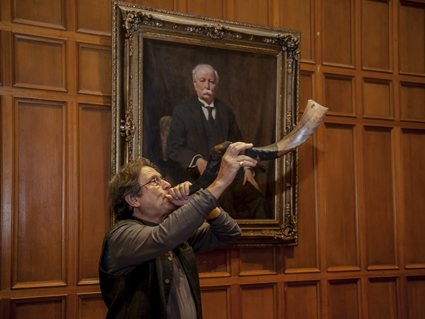
Alvin Curran
photo Marjorie Rose Butler
Alvin Curran
Alvin Curran’s music flits about like an overactive, laterally-thinking mind, jumping from one idea to another, taking the listener on a journey of dramatic musical contrasts. Born in the USA in 1937, and composer-in-residence with Soundstream Collective and the Elder Conservatorium, University of Adelaide, in August, Curran’s work spans half a century of musical evolution.
His Oh Man Oh Mankind Oh Yeah (2009) for choir and ensemble combines conventional and graphic notation with improvisation. Curran appears concerned with the sound of speech—vocalisation as music—and the nature of human communication. The score commences by instructing the singers to emit “deep low grunts,” then to “press tongue lightly on roof of mouth, exhale in long breaths producing airy whistling sound while moving mouth lips pursed!,” and then to bombilate (make buzzing sounds) ad lib and so on. The choir then splits into subgroups as if in conversation and the text includes monosyllabic words from John Cage’s 1989 Norton Lectures. In an uplifting climax, Curran plays the Hebrew shofar, or ram’s horn, a traditional instrument used in Jewish rites, its earthy, primal voice acting like a call to prayer.
In a separate concert, Curran performed his Fake Book (undated) for piano and midi keyboard, beginning by prodding at an upright piano, autobiographically recalling childhood lessons, before sitting at a grand piano and the midi. Fake Book is a humorous but insightful melange of fragments of his own and others’ music and sampled sounds, collected over decades and performed apparently at random, a virtuosic improvisation built from excerpts rather than phrases. The work unfolds as a series of piano episodes jarringly punctuated by recorded voices and sampled and synthesised sounds, evoking a mental picture of the modern sound world—alternately organised and chaotic. Strikingly musical and compelling, Fake Book is a sharply observed account of contemporary music and the composer’s own evolution within it, and it’s a lesson to composers on the musical legacy of the generation of Curran’s youth.
Preceding his Fake Book performance, a chamber ensemble ably led by pianist Marianna Grynchuk gave us Curran’s Rose of Beans II (1997), which opens with a mechanical toy emitting a childish ditty, following which a powerful piano drone develops, overlayed with gestural motifs and melodic lines from the other instruments. The work seems a programmatic summation of compositional development, investigating musical ideas and languages. The title, which sounds like ‘rows of beans,’ plays with the relationship between the sound of words and their meaning. The ensemble performs well but they must play from his score — the difference when Curran performs Fake Book is startling, for he plays intuitively, effortlessly characterising his musical memory.
In a third concert, Gabriella Smart gave a five-hour performance of selections from Curran’s Inner Cities (1991–present), a monumental and still-growing solo piano cycle, in the grand, neo-gothic Bonython Hall as part of Soundstream’s music and architecture project Great Music in Great Spaces. I attended only a preview of Inner Cities at Smart’s studio but found it to be an extraordinary exploration of compositional form and style, which, in extended performance, should amply demonstrate music’s mystical potential. Listening for five hours would be a mesmerising experience. Curran’s invitation to such inner contemplation recalls John Cage’s keyboard cycle In a Landscape and, in his accompanying stream-of-consciousness program note that identifies significant moments throughout his life, he acknowledges Cage’s ideas. In rendering his own lifetime as composition, Alvin Curran shows how composition is inevitably an extension and exploration of personal experience.
Alvin Curran, Oh Man Oh Mankind Oh Yeah, conductor Jesse Budel, Bonython Hall, University of Adelaide, 23 Aug; Alvin Curran and Soundstream Collective, Madeley Performance Space, University of Adelaide, 23 Aug; Alvin Curran, Inner Cities, piano Gabriella Smart, Bonython Hall, 24 Aug
RealTime issue #117 Oct-Nov 2013 pg. web
© Chris Reid; for permission to reproduce apply to realtime@realtimearts.net
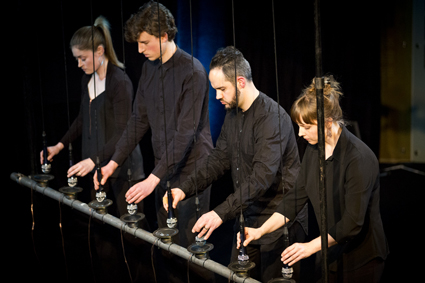
Transducer, Speak Perecussion, THNMF2013
photo Brad Serls
Transducer, Speak Perecussion, THNMF2013
While the title Totally Huge New Music Festival at first sounds like hyperbole, it is in fact classic Australian understatement. The title doesn’t indicate the festival’s ambitious vision for contemporary music in Australia and the exceptional quality of the local and international acts on offer. If that were not enough, this year the festival incorporated the first ever International Computer Music Conference south of the equator.
The result was a staggering range of performances combined with thoughtful reflections on the conference theme “International Developments in ElectroAcoustics” (IDEA) in the heart of the Perth Cultural Centre. The conference’s keynote speakers Agostino di Scipio, Alvin Curran, David Toop, Warren Burt and Haco provided valuable perspectives on their works performed throughout the festival, nuancing the conference theme into reflections on our troubled relationship with music technology.
Alvin Curran
In Way Out Back, commissioned for the festival by Perth’s Decibel Ensemble, Curran draws a map of postwar American art music. Decibel were expert guides through the intertwining paths of minimalist rhythmic phasing, composed heterophony, aleatorism, popular music, timbral collage and live signal processing. After this stylistic pastiche the ensemble explodes into screaming and instrumental noise only to have their protest played back to them, filtered, over the loudspeakers. The piece ends with a funeral chorale, raising the question of whether Curran is signalling the end of art music, the music of his own generation, or could the chorale be saying, “so you don’t want screaming? Fine, have another chorale.” Either way, the piece reflected the existential angst of Curran’s keynote address that narrated, in the finest beat prose, the glorious and disastrous legacy of his generation.
Festival-goers were treated to a taste of this emancipatory legacy when Curran performed Maritime Rites and BEAMS at B-Shed in Fremantle. Though he had to make do with a keyboard reduction of the marching bands and flotillas of foghorns previously used to perform this piece, the cacophony of Maritime Rites filled Fremantle with a bustling and sometimes overpowering sense of abandon. A greater feeling of collective creation was felt in BEAMS, which engaged 50 student musicians from WAAPA and UWA in a series of mass improvisations.
With such commitment in BEAMS and Maritime Rites, why such irony in Way Out Back? As Curran explained in his keynote, every invention of his generation has been commercialised, thus depleting them of any radical potential they may have had. The spirit of ‘happenings’ like Maritime Rites and BEAMS may now be found in flashmob commercials. The hard work of the avant-garde in radiophonic workshops has led to a surplus of bland, overproduced popular music and an immutable (and un-mutable) Western Art Music canon that drowns out the work of living composers. The festival found Curran in a bind that haunts many composers today: too ironic and you might as well not compose at all; too sincere and you remain blind to the social realities of your art.
Agostino di Scipio
Italian composer and installation artist Di Scipio privileges small-scale progress over revolutionary spectacle and dire prognoses. For Di Scipio there is a genuine question to be asked about how we might compose with the dynamic relationships between computers, performers and their acoustic environments. Texture/Residue, performed by Decibel at the THNMF, explores the paradigm Di Scipio calls “Audible Ecosystemics” where sound from the performer or from the performance space itself alters the way a computer modifies live or synthesised sound. The process becomes recursive as the computer’s output is diffused back into the space or modifies what the performer plays. The process is both an instantiation and a criticism of technological determinism, encouraging a practical knowledge of the agencies of the different components of a hybrid performance.
Warren Burt
Standing in stark contrast to the usual Macbook-Pro-and-sound-card electroacoustic setup, Warren Burt’s rigs of old notebooks and first generation tablets can leave one perplexed. But if the possibilities of these machines appear almost saturated to Curran and self-generating to Di Scipio, then they are sources of inspiration to Burt. In Without Glue, Burt tests the improvisatory skills of pianist Stuart Little and saxophonist Sean Little by sending them harmonic and gestural directions via laptops on their music stands. The resulting smooth jazz is fairly conventional, except for the filters, reverberation and glitches introduced by Burt. Improvising on the instrumentalists’ improvisations, Burt demonstrated a different sort of virtuosity, accentuating the saxophone’s changing register with ‘squelching’ delay effects and ornamenting their mellow tones with bursts of sound like science-fiction laser beams.
Haco
An unusual musical use of the ubiquitous Macbook Pro forms the basis of Haco’s keynote performance Stereobugscope. Haco listens to the complex and changing magnetic field of her laptop with a pair of small guitar pickups. The crackling, humming interference varies from task to task, beginning with an explosion of oscillations of different frequencies when the laptop is turned on. The intended effect is a new appreciation of—possibly even sentimental attachment to—the technology around us. In this way Haco reverses her usual creative process, which is to take everyday objects and make them strange to us again.
David Toop
UK-based sound artist, composer and author David Toop poetically explores the relationships between the micro- and macro-levels of his compositions with help from his mentor John Latham’s concept of Flat Time. Flat Time is immediately attractive to the musician because the “roller-blind” metaphor Latham uses to illustrate the concept resembles a musical score, with the left hand side of the blind representing short events (such as light traversing the field of an electron), the right representing the entire time span of the universe and the roller serving as the unfolding present. Toop’s composition FLAT TIME/ Sounding, performed by himself and Decibel, requires the players to interpret descriptions of events, like (though not precisely) “a flake of rust falling into a flooded room,” “a difficult book shut suddenly” or “involuntary humming.” Decibel realised Toop’s composition with poetry and imagination, deftly sculpting each image with clarinet key taps, bowed cymbals and vibraphone, finger-clicking, plucked piano strings and single nylon-string guitar notes.
Michael Kieran Harvey
Tura New Music’s commitment to ambitious programming gave rise to two new large-scale works that deserve to enter into regular performance throughout Australia and the world. Resonating with Toop’s literary style more than the technological theme of the conference, Elliott Gyger’s hour-long INFERNO for solo piano (after Dante) is composed in, as pianist Michael Kieran Harvey puts it, an “unfashionably uncompromising” language. While such music can also express positive affects (including the sparse beauty of INFERNO’s final movement “Stars”), Gyger shows how the techniques of Messiaen, Carter, Ligeti, Birtwistle and other post-war avant-garde composers are particularly well suited to depicting the nine circles of Hell with their tortured bodies and rivers of water, boiling blood and ice.
Transducer by Robin Fox and Eugene Ughetti explores the line between percussionist and microphonist, between the competing agencies of the performer and the instrument. At the beginning of Transducer Ughetti walks onstage and picks up a speaker tied to a cardioid microphone, a device certain to release a squeal of ear-splitting feedback as the sound received from the microphone is played back to the microphone through the speaker. Swinging the device around his head, Ughetti lengthens the cables until the microphone-speaker describes a circle almost as wide as the stage. Four microphones at the corners of the stage are diffused through eight speakers, placing the audience in the centre of a roaring, spinning, pealing vortex.
The piece progresses through the steady addition, transformation and subtraction of sound sources, giving the performance the air of a geometrical demonstration. The rest of Speak Percussion enter and hold up speaker cones to the circle described by Ughetti, modifying a rhythm of feedback by fanning around the perimeter. The ensemble’s geometrical choreography throughout the performance is dictated by the physics of oscillation in sound, electricity and the swinging of the pendulum.
Instruments and electronics
As well as the standalone THNMF concerts and the ICMC keynotes, nightly concerts provided forums for exploring the articulation of electronics with live instruments. While many of the compositions honed a dominant style of “series of extended techniques + digital signal processing + spatial diffusion,” some unexpected effects were produced using alternative speaker systems and non-processing-based electronics. Dan Van Hassel’s Fzzl for solo snare and electronics begins with Louise Devenish playing a simple rhythm on the drum. As the groove continues, the reverberation of the snare seems to expand. One loud strike of the drum releases an impossibly long peal from the snare, at which point the ruse is up: there is a transducer on the bottom of the drum feeding vibrations into the drum skin. From this point on the piece becomes a fast-paced duet between the percussionist striking the top of the drum and the transducer controlled by Van Hassel.
By couching the ICMC within a broader festival, Tura New Music opened the issue of “international developments in electroacoustics” up to a broader range of musical stimuli. Beyond the computer music staples of patches, algorithms and hardware, the conference engaged with art music, popular music and noise. Conversely, having the conference at the heart of the festival allowed for greater reflection upon the works and the festival as a whole. This depth and diversity was represented in the square outside the West Australian Museum after the instrument and electronics concerts. Amid the clubbers on their way to James Street, conference delegates discussed dinner plans in pink lanyards, musicians slung cases over their shoulders, bearded computer music veterans bought ice cream from vans, sound designers with incredible eyewear sipped wine at the PICA bar and noise fans drank from BYOs beneath a giant screen beaming squawking, humming audiovisual works.
RealTime issue #117 Oct-Nov 2013 pg. 42-43
© Matthew Lorenzon; for permission to reproduce apply to realtime@realtimearts.net
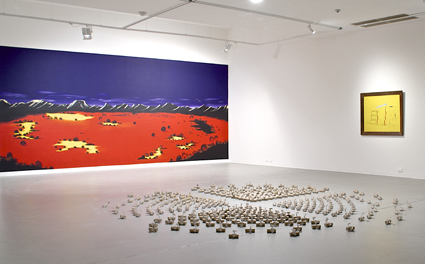
Blender, installation view of artworks by Allen Sparrow, Dagny Strand and Lorry Humphreys, Australian Experimental Art Foundation, 2013
photo Alex Lofting
Blender, installation view of artworks by Allen Sparrow, Dagny Strand and Lorry Humphreys, Australian Experimental Art Foundation, 2013
Since Harald Szeemann reinvented the role of the curator in the 1970s, thematic exhibitions, in which each artwork forms an element in a coherent whole, have become well established. The creative partnership of artists and curators is frequently a primary strategy for developing new art and igniting its appreciation.
In Flinders University Art Museum’s magnificently crafted Crystal Palace exhibition, curator Lisa Harms traces exhibitionary practice back to London’s Great Exhibition of 1851. Harms invited seven high-profile artists including a poet to make works responding to items in the collections of Flinders University’s Art Museum, the University Library, the South Australian Museum and the Museum of Economic Botany, the final form of the exhibition developing collaboratively from this initial concept. She erected a large room inside the FUAM gallery, exhibiting the works within and around this room and in niches in its walls, creating a walk-in cabinet of curiosities, recalling the Victorian approach to collecting and displaying exotic specimens. With around 100 exhibits in total, including Joseph Nash’s 1852 illustrations recording the Great Exhibition, Harms’s Crystal Palace evokes the Great Exhibition’s sensibility and legacy of collecting.
The participating artists responded to selected museum items by making new work or enacting performances. Siamak Fallah, whose delightful illustrations adorn a wall, is himself an exhibit, working at a computer in an office within the installation, furnished with antiques from the Flinders collection to which he responds. Domenico De Clario, reflecting on an Albert Namatjira landscape, performs live and in video playing a spinet, an early form of piano that might have been used by 19th century collectors and colonists, and including a visual record of his recent camping-trip occupation of the university’s grounds. Lee Salomone, a long-time collector and exhibitor of domestic objects, shows works made from these, including saucepan lids mounted with bronze castings of fallen leaves, in response to the Museum of Economic Botany’s collection. Morgan Allender’s oversize still-life painting responds in a painterly manner to botanical illustrations, and Julie Henderson’s complex array of objects, including automated mechanical devices, is inspired by the consideration of the relationship between people, space and functional objects.
Contrasting with Crystal Palace is the AEAF’s Blender exhibition, for which AEAF director Christine Morrow assembled work by six artists from regional South Australia. Morrow looked for artists who could benefit from the opportunity to expand their work and experiment. She sees the AEAF’s role as catalysing experimental and developmental art throughout SA and the Northern Territory, stating, “Blender shapes and informs the dialogue between centres and peripheries in contemporary practice” (catalogue). Port Pirie Indigenous artist Allen Sparrow’s depiction of the Flinders Ranges in red, yellow and black (under a deep blue sky) rather than in natural landscape colours is a work of emblematic power that reappropriates the space through the use of the mural form instead of portable canvas or board. Penola artist Dagny Strand’s work, occupying half the floor, comprises hundreds of toilet roll tubes each cut to form the silhouette of a tree, referencing South-East SA’s forestry industry. Pamela Kouwenhoven makes articulate use of discarded materials in her tableau of car-battery cases mounted on the wall and, standing on the floor, a forest of charred paper rolls retrieved from a paper mill following a fire.
In a parallel AEAF exhibit, James Dodd and NT artist Franck Gohier collaborated in making The Hole in the Wall Gang, an animated video of an imagined dialogue in which Gohier relates a characteristically NT anecdote.
Within the annual SA Living Artists Festival, involving thousands of artists across the State, these contrasting exhibitions demonstrate the diversity of SA art and the balancing act involved in curating it. Blender is a small but significant cross-section of regional art that addresses to city audiences these artists’ particular concerns. In Crystal Palace, however, the art object becomes subsidiary to its re-contextualisation, pushing the curatorial role to its logical conclusion. The artists demonstrate how we might interact with and recreate our own histories and cultures, but Crystal Palace acts as a single work comprising multiple elements — the artworks, the specimens, the texts and the exhibition space itself. The necessity for viewers to approach each work both in isolation and in its curatorial context is especially evident in Crystal Palace.
Crystal Palace also interrogates the Great Exhibition as a symbol of transnational capitalism, modernity and colonisation and the effect of “hot-housing” industrial development and cultural cross-fertilisation. Harms says, “Crystal Palace sets out to encourage post-colonial readings of these ongoing, resonant reflections — both beautiful and troubling — against a contemporary climate of increasingly heated and conflicting attitudes towards protection, preservation and exploitation” (catalogue). The works from the museums have gathered significance and meaning since they were made and, through juxtaposition, we’re prompted to reinterpret them and weigh their historical value.
The cultural enquiry that inevitably underpins curating propagates cultural re-evaluation and development. Flinders Collections Manager Nic Brown says in her catalogue essay, “By inviting contemporary artists and curators to respond to its collections, Flinders University Art Museum takes the opportunity to be reinterpreted itself.” We thus reconsider museology generally. Morrow’s Blender establishes a temporary museum of SA regional culture, testing our idea of regional art and the perception of the artist as regional while, importantly, amplifying each artist’s voice. By inviting artists to respond to our subjective, cumulative pictures of history, these curators extend the culture of artistic creation that parallels and informs our ongoing self-historicisation.
Blender, curator Christine Morrow; The Hole in the Wall Gang, curator André Lloyd Lawrence, Australian Experimental Art Foundation, 26 July-17 Aug; Crystal Palace, curator Lisa Harms, Flinders University Art Museum, 27 July-29 Sept
Chris Reid is an administrative staff member of Flinders University but is not connected with the Flinders University Art Museum.
RealTime issue #117 Oct-Nov 2013 pg. 46
© Chris Reid; for permission to reproduce apply to realtime@realtimearts.net
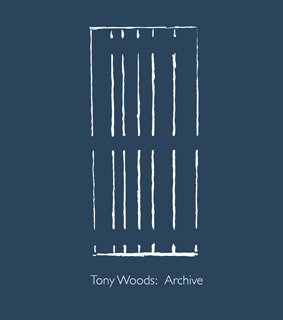
Book & DVD: Tony Woods: Archive
This large format book features excellent reproductions of this leading Melbourne artist’s works along with a DVD of his films and a documentary about the artist and their making. In her review of the book, Danni Zuvela writes:
“We are drawn into this complex and talented artist’s world, given access to his creative inspiration and evolution at a deeper level than other modes of artist biography that might sacrifice depth for gloss. Invited to muse on the aesthetic and conceptual relations between the artist’s practice across canvas, celluloid, pixels and audio tape, we start to develop insights into how the dialectic of representation and abstraction powers an artist like Tony Woods, finding varied expression across forms, materials and decades… Tony Woods: Archive, with its detailed understanding of an artist whose work should be more widely known, is a rare and worthwhile addition to the annals of Australian art history.”
1 copy of Tony Woods: Archive, courtesy of publisher www.artinfo.com.au and distributor Australian Scholarly Publishing ASP.
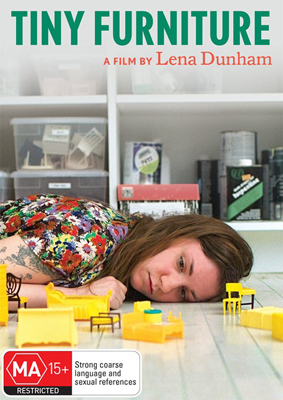
DVD: Lena Dunham, Tiny Furniture
We first heard of Lena Dunham’s film Tiny Furniture a couple of years ago from one of those succinct reviews at the front of The New Yorker. Now the film is finally available in Australia, no doubt due to the fact that since 2010 when she made the film, Dunham has created the wickedly funny and brutally frank hit TV series Girls.
In Tiny Furniture you not only see the emergence of the 20-something preoccupations and anxieties that govern Girls, you’ll also meet Dunham’s mother—the artist/photographer Laurie Simmons—and sister who play themselves. If you’re a fan of Girls you won’t want to miss this low key but fascinating precursor.
5 copies courtesy of Transmission Films
Please note you can nominate for ONLY ONE GIVEAWAY.
Email us at giveaways@realtimearts.net with your name, postal address and phone number.
Include ‘Giveaway’ and the name of the item in the subject line.
RealTime issue #117 Oct-Nov 2013 pg. 48
© RealTime ; for permission to reproduce apply to realtime@realtimearts.net
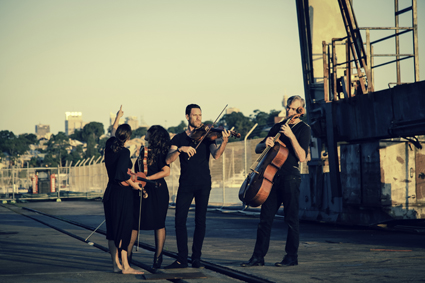
Mirabai Peart, Veronique Serret, James Eccles, Ollie Miller, The NOISE
photo Andrew Wholley
Mirabai Peart, Veronique Serret, James Eccles, Ollie Miller, The NOISE
After six years honing his viola playing skills in Berlin, James Eccles returned to Australia with an unusual ambition—to pursue a career in improvisational music-making in the contemporary classical music idiom and beyond. In the 18th and 19th century musicians and, not least, composers would be expected to publicly extemporize. In a return to tradition, Eccles is however not looking to the past so much as creating new musical possibilities for the future, realised in performances by The NOISE string quartet, which he leads, and its collaborators.
Ambition—and courage—are signalled by The NOISE’s latest venture, Composed NOISE: seven newly commissioned string quartets to be performed over two nights in Sydney’s Cellblock Theatre. These works by Australian composers— Andrew Ford, Rosalind Page, Paul Cutlan, Lyle Chan, Andrew Batt-Rawden, Alex Pozniak and Amanda Cole—“have been created through a collaborative process of workshopping and improvising, where the performers and composers function as equals. In this innovative process, performers become co-writers of the work, through their ability to improvise (or compose in real time)” (press release).
The NOISE
I met with Eccles to discuss Composed NOISE, but first asked about the musical background of the quartet’s players. The NOISE is made up of classically trained violinists Veronique Serret and Mirabai Peart, violist James Eccles and cellist Ollie Miller. Peart also has a busy career playing in the free-improvising Splinter Orchestra, jazz groups and the world music collective Tapestries of Sound. Miller, who plays classical and jazz piano as well as percussion is a member of the jazz group Amphibious. Having played with the Malaysian Philharmonic, the Tasmanian Symphony Orchestra and the ACO, Serret has also been a core member of Ensemble Offspring, was a founding member of the electronic/rock/classical band CODA and plays amplified violin for Inga Liljestrom’s band, elk. Eccles has played with Judy Bailey, DJ Spooky, Sydney Philharmonia Orchestra, Taikoz and Ensemble Offspring among others. With Miller he does an “avant garde rock thing,” performing recently at the VIVID festival in collaboration with electric guitarist Zane Banks. Soon Eccles and Miller will improvise over drones created by Julian Day as part of Day’s Infinity Room project.
The NOISE took shape, says Eccles, “after three of us were inspired by a Necks concert at the beginning of 2008. We found another violinist, started out as very much a little fun project and after several jam sessions said, let’s do a gig. There was a push factor from playing a lot of contemporary music and struggling with notes all the time, which can be great—it’s its own challenge. But we wanted to make our own music, to be creative and get a real kick out of it.”
Dealing wild cards
I ask Eccles about the kinds of improvisation involved in playing the seven quartets in Composed NOISE. He tells me that the degree of improvising varies considerably, from little to much, if in a variety of ways—sometimes where the composer has left space, or one or two players might improvise against the notated playing of the others, or when the composer might specify notes but not some other aspect of realization, like texture. However, for the quartet an important component of Composed NOISE has been the compositional-collaborative process. “I’ve had various meetings with the composers, starting last year. Lyle Chan based his piece on the blackjack card game. I liked the idea but then thought, hang on, we’re a quartet let’s have a real four-person game and immediately thought of bridge and 500.
“So we play a game of 500 before we perform the piece and that becomes the score. Lyall did a really good job finding a balance between what the cards stipulate and adding other instructions on top of that. There are 10 tricks in a hand of 500, so it’s a 10-movement piece and each trick has a specific instruction—glissando, pizzicato non-vibrato etcetera. Particular cards carry instructions: suits dictate register—hearts is the highest—and a number card will dictate certain rhythmic or grouping parameters. The face cards are complex and solo-istic, so the stronger the card, the stronger your part, while a number card will suggest a more accompanying role.”
As well as having to learn these rules, the players have to handle another quite lateral stipulation: “that the person who leads off the trick leads off the movement; but before they play they have to think of a type of weather, hence the work’s title, Smoke Weather Stone Weather. You don’t tell anyone what you’re thinking, they just react to what you’re playing. So that’s a real curve ball.
“For the purpose of the first performance we’ll video the game the day before, given all the logistics we have to get our heads around. But it won’t be rehearsed. It’ll still be spontaneous. Lyall’s piece is the most like what we do as The NOISE, reacting in the moment. We’ll probably do it many, many times.”
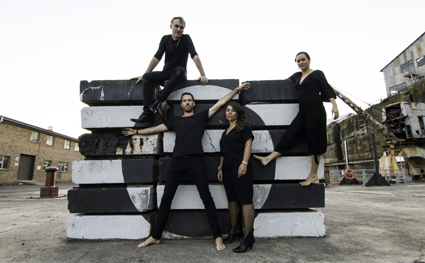
Ollie Miller, James Eccles, Veronique Serret, Mirabai Peart, The NOISE
photo Andrew Wholley
Ollie Miller, James Eccles, Veronique Serret, Mirabai Peart, The NOISE
Improvisation by degrees
Paul Cutlan’s contribution, Merge/Emerge, will also involve ample improvisation in a work “rooted in rhythm and harmony, in the tradition of Shostakovich and Britten, and with one delicious jazz moment when it comes.” The kinds of improvisation indicated in the score vary: “three of us will play the score with one player improvising, or there’ll be a bridging section with two people improvising and then we all come in and play a notated page and then one of us goes to a solo. Paul is a performer himself and really knew what we wanted to engage with and he knows the balance of how much to write and not write.”
Andrew Batt-Rawden has created “28” in which, says Eccles, the composer is “video-ed live writing the music—some of it pre-written over which he’ll overlay other elements as we play.” Alex Pozniak’s Force Fields, for amplified instruments, “ends with screaming feedback—a logical conclusion to a very intense piece. Some will love and some will hate it. It deserves to be picked up by other quartets. It’s more interpretive for us than improvisatory—Alex knows what he wants—but you have to determine how you might, say, make a stuttering effect on scratch tones.” Rosalind Page, Eccles tells me, “wrote her Master’s Thesis on Tarkvosky. Ollie’s also a big fan. I wasn’t convinced at first but now I’m a fan of The Mirror [1975], the film that’s inspired Rosalind’s piece, Zerkalo (Mirror). The film is autobiographical, about a father leaving his family, so each instrument plays a character—mother, child, father, poet—in musical dialogues. It’s hauntingly beautiful. Tarkovsky himself used soundscapes and music so strongly, referencing Bach. We’ll be improvising around some of the Pergolesi Stabat Mater.”
The other works in Composed NOISE are Amanda Cole’s Ecliptica and Andrew Ford’s String Quartet No 4, plus a bonus work by The NOISE themselves in the first concert of the two-night program. Ford’s composition was commissioned by Julian Burnside, while the other quartets were commissioned with funds from the Australia Council and those raised by The NOISE and Chronology Arts.
Ambition and freedom
Finally, I ask Eccles how ambitious he is for The NOISE. He laughs and says “Very!” But it’s no easy task given how busy the quartet members are. The goal is to work together one to two months a year, ideally on a major project like Composed NOISE but with an expanded palette that might include “a world music focus or an electric work or a studio album with overdubs.”
As for recordings, Composed NOISE will soon be available on CD and The NOISE has been recording Sydney-based composer George Lentz’s String Quartets—seven hours of it on NAXOS BluRay (apparently the only way to conveniently issue such a huge work). “It’s quite extraordinary playing beautiful chorale writing and improvising, providing source material for the mix—all tremolo, say, or all glissando. When we thought we were finished, George called to say he needed one more chorale section! It’s an installation work, but it might become a live performance,” says Eccles, apparently more excited than daunted by the work’s length.
I wonder if, after six years in Berlin, Eccles is happy working in Australia. He’s emphatically positive. “In Berlin it was mostly about learning to play the viola rather than being really creative—the good violist getting my viola chops up to work in an orchestras. I went to lots of Arditti Quartet concerts, but didn’t do much contemporary playing myself; it was mostly with orchestras doing Mozart and Beethoven. Here I’m a bit bigger fish in a smaller pond, I know the people, it’s my scene. I want to make things happen. It’s patriotic. I want to do things for Australian music. I’m inspired by nature and the sense of freedom here among my fellow collaborators.”
IMPORTANT NOTE: Due to a unforseen circumstances, the Composed NOISE concerts have had to be cancelled.
The CD Composed NOISE is now available on iTunes
For more information, www.thenoise.com.au; www.vexations840.com.
RealTime issue #116 Aug-Sept 2013 pg. web
© Keith Gallasch; for permission to reproduce apply to realtime@realtimearts.net
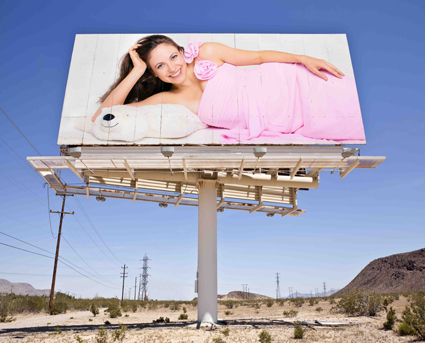
Nicola Gunn, In Spite of Myself
Melbourne Festival, quick picks from local works
The Melbourne Festival will kick off just before our next print edition hits the streets so here’s a run down of some of the local works. Particularly impressive are the number of festival co-commissions, nurturing Melbourne artists and the creation of exciting new performance experiences.
In Spite of Myself, Nicola Gunn, co-commission with Arts Centre Melbourne
Nicola Gunn and the Sans Hotel team have been in residence at the Arts Centre dreaming up an almost true life story for Gunn, presented as a faux retrospective of performance art titled Exercises in Hopelessness: Nicola Gunn (1979-present). Arts Centre Melbourne, Fairfax Studio; 9-13 October; http://www.artscentremelbourne.com.au/whats-on/event.aspx?id=3684
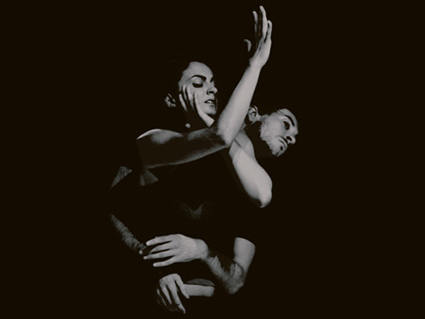
A Small Prometheus, Stephanie Lake & Robin Fox
photo Robin Fox
A Small Prometheus, Stephanie Lake & Robin Fox
A Small Prometheus, Stephanie Lake and Robin Fox, co-commission with Arts House
A dance work involving fire-driven kinetic sculptures and interactive sound. Arts House North Melbourne Town Hal 15-20 Oct; http://www.melbournefestival.com.au/program/genre/dance/a-small-prometheus.html
The Shadow King, co-commission with Malthouse
Michael Kantor and Tom E Lewis have co-created this Indigenous re-interpretation of King Lear melding “Shakespearian pathos with Aboriginal language, music and dance” (website). Malthouse, 11-27 Oct; http://www.melbournefestival.com.au/program/genre/theatre/the-shadow-king.html
M+M, co-commission with Theatre Works
Daniel Schlusser tackles Mikhail Bulgakov’s The Master and Margarita. Theatre Works, 8-16 Oct; http://www.melbournefestival.com.au/program/genre/theatre/mm.html
Room of Regret, co-commission with Theatre Works
The Rabble takes on Oscar Wilde’s The Picture of Dorian Gray filtering it through performance art, installation and audience interaction. Theatre Works, 21 Oct – Nov 3; http://www.melbournefestival.com.au/program/genre/theatre/room-of-regret.html
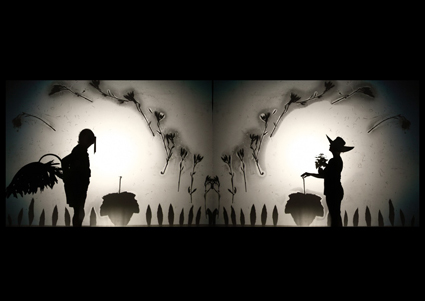
Sonic Flock, Click Clack Project
courtesy the company
Sonic Flock, Click Clack Project
Sonic Flock, Click Clack Project, presented by Footscray Community Arts Centre and the University of Melbourne
Enter a tee-pee and experience intimate music performed just for you. Over at Footscray Arts Centre there’ll also be performances by the Amplified Elephants, Rawcus and visiting Japanese sound artists. Atrium, Federation Square & Footscray Arts Centre, 12-13 Oct; http://www.melbournefestival.com.au/program/genre/music-classical/the-sonic-flock.html
The Black of the Star (Le Noir de L’Etoile), presented by Speak Percussion and SIAL Sound Studios
A percussion masterpiece by French composer Gérard Grisey featuring the pulses of neutron stars. (See review from Totally Huge 2011) Deakin Edge, Federation Square, 16-17 Oct; http://www.melbournefestival.com.au/program/genre/music-contemporary/the-black-of-the-star.html
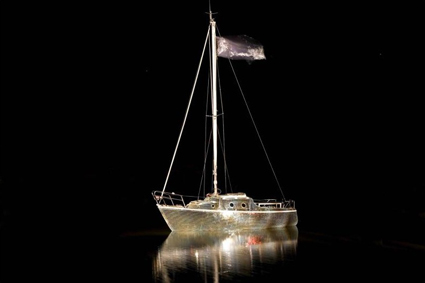
Celestial Radio 2012, Zoe Walker and Neil Bromwich, originally commissioned by Performance Space and the Museum of Contemporary Art Australia with the support of the Keir Foundation
photo Colin Gray
Celestial Radio 2012, Zoe Walker and Neil Bromwich, originally commissioned by Performance Space and the Museum of Contemporary Art Australia with the support of the Keir Foundation
Niteworks, Bundanon
This year’s Siteworks at Bundanon Trust’s Riversdale complex will be a Niteworks. The star of the evening will in fact be the stars with a presentation by scientists from the Anglo Australian Observatory. The Shoalhaven Astronomers club will also be bringing their telescopes for audience members to peer at the heavens. David Haines and Joyce Hinterding will create sounds via natural VLF transmissions and Nancy Mauro-Flude and Linda Dement will conduct a starlight séance of sorts calling up recently deceased rockers Ari Up (The Slits), Poly Styrene (X-Ray Specs) and Chrissie Amphlett (Divinyls). UK artists Zoe Walker and Neil Bromwich will sail their glittering vessel transmitting Celestial Radio sounds down the Shoalhaven and Diego Bonetto and Caterina Mocciola will take the audience on a moonwalk. There’s also the option of some rustic overnight camping.
The Bundanon Trust, Niteworks, Riversdale, 12 Oct; https://www.bundanon.com.au/siteworks
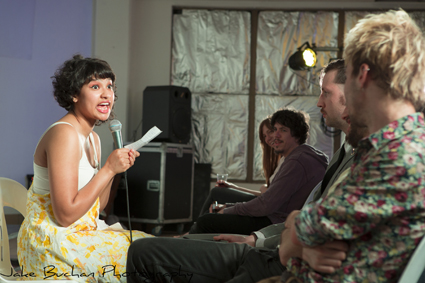
Nicole Henriksen. (For the 2013 festival Nicole will be performing a piece enticingly titled Naked Unicorn Vomit.)
courtesy Cracked Theatre Festival
Nicole Henriksen. (For the 2013 festival Nicole will be performing a piece enticingly titled Naked Unicorn Vomit.)
This Is Not Art, Newcastle
It’s the time of year to head north to Newcastle to experience the multi-headed beast that is This Is Not Art. This year the Crack Theatre Festival showcases a diverse selection of performances ranging across “circus, dance, cabaret, verbatim theatre, installation, multi media, comedy and live art” (press release). The National Young Writer’s Festival provides activities for budding scribes, including a writing workshop on the streets of Newcastle in the Paper Trail Tour, a Penguin Plays Rough presentation in the tunnels of Fort Scratchely, plus tips from celebrity chef Adam Liaw on cook book writing. The quiet achiever of TINA, the creative research symposium Critical Animals offers an impressive program of artists and thinkers including Tega Brain, Julian Day, Erica Secombe and Ben Kolaitis. There’s also the return of prodigal festival Electrofringe, presenting a day of showcases and the final festival party.
This Is Not Art, Newcastle, NSW 3-6 Oct; http://thisisnotart.org/
Festival of Toy Music, Brisbane Powerhouse
Curated by the tricksters of new music, Clocked Out, the Festival of Toy Music will feature performances by Margaret Leng Tan from the US (the queen of the toy piano we’re told), plus Australian musicians Matthew Horsley, Adam Simmonds, Clocked Out and of course there’s no show without the circuit-bent Barbies of Toy Death. There’s also a Dream Percussion installation sited in the Turbine Hall and available for everyone to unleash their inner percussionist.
Festival of Toy Music, 5 Oct, Brisbane Powerhouse; http://brisbanepowerhouse.org/events/2013/10/05/festival-of-toy-music/
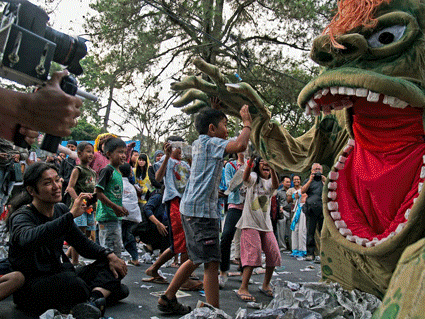
Wedhus Gembel, Snuff Puppets
Wedhus Gembel, Snuff Puppets
Wedhus Gembel is a long-time collaboration between the Snuff Puppets and a range of Indonesian artists. An outdoor performance, it’s “a parable about the cycle of life, the destructive power of nature and how innocence and beauty can be disguised in a monster” (website). Premiering in Yogyakarta and Jakarta in 2011, the wild mega-puppet antics of Wedhus Gembel will have its Australian debut at Federation Square featuring six guest artists from Indonesia.
Wedhus Gembel, Snuff Puppets, Federation Square Amphitheatre, 2-5 Oct; http://www.snuffpuppets.com/shows/Wedhus_Gembel

Not About Face, Luke George and collaborators
photo Jeff Busby
Not About Face, Luke George and collaborators
Not About Face, Luke George
In RT115 Rennie McDoougall gave us a sneak peak of Luke George’s work in development, Not About Face. “[T]he audience enters a rehearsal studio like cheap Halloween ghosts, donning bedsheets with eyeholes cut out…George, at first unidentifiable from the rest of us ‘ghosts,’ eventually emerges to claim his presence as shepherd to our flock. Once revealed he undergoes a series of transformations: channelling deceased performers, communing with a past version of himself through a television set and guiding us into summoning incantations of colour, to name a few.” George and collaborators are now ready to present the show to live a be-shrouded public at Dancehouse.
Luke George and Collaborators, Dancehouse, Melbourne, 9-13 Oct; http://www.dancehouse.com.au/performance/performancedetails.php?id=165
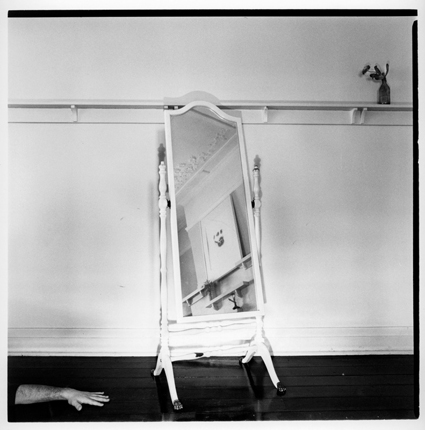
Aaron Bradbrook, Borderlands
© the artist
Aaron Bradbrook, Borderlands
Aaron Bradbrook, Perth Centre for Photography
Aaron Bradbrook is the 2012 winner of the Perth Centre for Photography’s UNCOVER Award which offers an emerging artist printing support, mentorship and a solo exhibition. Bradbrook’s exhibition Borderland focuses on the house as a site of endless playful possibilities, but also suggests a darker side as people appear only as segmented body parts. Bradbrook writes, “Like the subjects themselves, I want the viewer to feel they are being held captive in another world, a world in which they cannot leave” (press release).
Aaron Bradbrook, Borderland, Perth Centre for Photography,
26 Sept – 26 Oct, http://www.pcp.org.au

Yeondoo Jung, Documentary Nostalgia, video still, 2007
Yeondoo Jung, MAAP Space
The next exhibtion at MAAP Space in Brisbane presents South Korean artist Yeondoo Jung. Jung creates ambitious video works that explore memory truth and construction. The centerpiece of the exhibition is Documentary Nostalgia. shot in a single 84-minute take. Various scenes from the artist’s memory are literally constructed as theatre sets. More intimate in scale is Twilight Seoul created in collaboration with German artist Luka Fineisen. Using materials lying around in the studio the artists recreate by hand a scene of the hills around Seoul.
Yeondoo Jung, MAAP Space, 27 Sept-8 Nov; http://www.maap.org.au/projects/maap-space/yeondoo-jung/
in/Visible Women, Magdalena Australia
So if Tony Abbot is Minister for Women, it’s time to get a little forthright about women’s issues. Magdalena Australia, a coalition of female arts workers, is a long time advocate for women in the arts, but given the current political climate they are stepping up their activities. In particular they are responding to what they’ve identified as “an apparent lack of strong images of women in the printed program” of the current Brisbane Festival (press release). They will be presenting a Long Table discussion (a performative public talk format pioneered by Split Britches [US/UK]) around the visibility of women in performance. The discussion will be followed by a cabaret co-presented with Access Arts and Vulcana Women’s Circus.
Magdalena Australia Long Table, 27 Sept 5pm, cabaret 7pm; The Stores Studio, Brisbane Powerhouse; http://www.themagdalenaproject.org/en/content/invisible-women
Women’s issues continued… Live Art Development Agency
While we’re on the matter, the visibility of women in the arts is of course an international concern, one being addressed by a number of upcoming activities by London’s Live Art Development Agency. Through their Restock, Rethink, Reflect (RRR) series they’ll be presenting Just like a Woman, a program of talks and performances as part of the City of Women Festival in Ljubljana (Slovenia, 11-12 Oct). Back in London, Lois Weaver, inventor of the Long Table discussion format, will present a Long Table about Live Art and Feminism (16 Oct). Then the LADA partnership project Re.act, a performance archive of “feminist, gendercritical and queer performance art” (website) will return to Berlin, after a tour of Europe collecting even more material. Check out the website for workshops, performances, talks and other activities.
http://www.thisisliveart.co.uk/
Still in the loop
OzAsia, Adelaide Festival Centre
13-29 Sept
http://www.ozasiafestival.com.au/
Art and About, City of Sydney
20 Sept-20 Oct
http://www.artandabout.com.au/; http://metroscreen.org.au/whatson/
Gigi Scaria, Dust, Ian Potter Museum
18 September 2013 – 2 February 2014
http://www.art-museum.unimelb.edu.au/
Memory Collective, Toowoomba Art Gallery
Memory Collective, Toowoomba Art Gallery, 21 Sept-5 Nov; http://ww2.toowoombarc.qld.gov.au
User Generated Architecture, Tin Sheds Gallery
27 September-15 November
http://emergencity.net/user-generated-architecture/
Super Discount, Back to Back, STC, Malthouse
Sydney Theatre Company
20 Sept-19 Oct
http://www.sydneytheatre.com.au/what’s-on/productions/2013/super-discount.aspx
Nought, ADT, Samstag Museum
25 -27 Sept
http://adt.org.au/; http://w3.unisa.edu.au/samstagmuseum/
Kate Murphy, Probable Portraits
Shepparton Art Museum (SAM), 13 Sept-14 Nov
http://www.sheppartonartmuseum.com.au/
Open Frame, Room40
Brisbane Powerhouse and various venues
12-28 Sept
http://openframe.room40.org/2013
Craig Walsh, Embedded & Primavera, MCA
12 Sept-24 Nov
http://www.mca.com.au/
ikono On Air Festival
global, online
6-29 September
http://ikono.org/festival/
2013 Brisbane Festival
7-28 Sept
http://www.brisbanefestival.com.au/
arte magra: from the opaque, AEAF
5 Sept-5 Oct
http://www.aeaf.org.au/exhibitions/ArteMagra.html
The boat goes over the mountain, Happy Dagger Theatre
The Blue Room, Perth
10-28 Sept
http://blueroom.org.au/events/the-boat-goes-over-the-mountain/
Windows to the Sacred, S.H. Ervin Gallery
presented in association with Buratti Fine Art; 30 Aug-29 Sept
http://www.shervingallery.com.au/
Malthouse’s Helium
Little Ones Theatre, Salomé, 30 Aug-14 Sept
Smack! Bang, City of Shadows, Rachael Dease, 21 Sept-5 Oct
http://www.malthousetheatre.com.au/helium-2013/
In Confidence: Reorientations in Recent Art, PICA
31 Aug-13 Oct
http://www.pica.org.au
RealTime issue #116 Aug-Sept 2013 pg. web
© RealTime ; for permission to reproduce apply to realtime@realtimearts.net
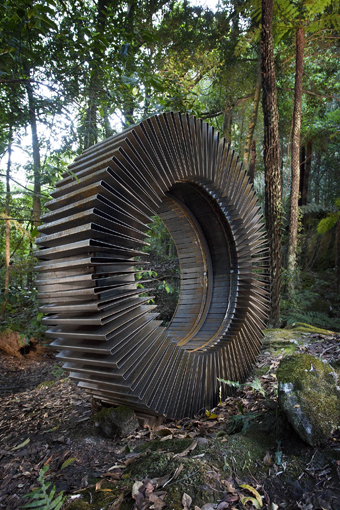
Al Phemister, Kern, Sculpture at Scenic World
photo Keith Maxwell
Al Phemister, Kern, Sculpture at Scenic World
Sculpture at Scenic World 2014
There’s still time to submit proposals for the annual Sculpture at Scenic World in the Blue Mountains which sees up to 40 works installed on the floor of the Jamieson Valley (see review of 2013 exhibition http://www.realtimearts.net/article/issue114/11099). The main acquisitive prize is $20,000 with a number of smaller awards. The 2014 exhibition (24 April-18 May) will also serve as the launch of a permanent sculpture commissioned from Ken Unsworth.
Applications due 14 Oct; http://www.scenicworld.com.au/experiences/sculpture/
Platform X: Transmedia Storyworld Writing, AWG
The Australian Writers’ Guild is seeking writers interested in interactive and multi-platform story telling to take part in Platform X: Transmedia Storyworld Writing. Eight writers from NSW and ACT will be selected for a three-day master class (30 Nov, 1 Dec, 7 Dec) run by Mike Jones, head of story development for Portal Entertainment UK and co-author of the multiplatform project Bloodline for publisher Simon & Schuster.
Applications due 17 Oct; http://awg.blacklight.com.au/images/pdfs/Platform%20X%20Entry%20Form%20and%20Guidelines.pdf
Still in the loop
raumlabor, Tin Sheds Gallery
Workshop 12-13 Oct (plus one day ATSC workshop induction if required 11 Oct); http://emergencity.net/special-workshop-with-raumlabour-berlin-book-now/
Nude models, Deborah Kelly, Sydney Biennale
Volunteers as portrait subjects, please send a picture of your face (only) to kellyproject@biennaleofsydney.com.au by Friday, 11 October 2013. For collage workshops, please send expressions of interest to frances@biennaleofsydney.com.au
Public Art major works, City of Sydney
Expressions of Interest due 31 October; http://www.cityartsydney.com.au/cityart/news/?p=1739
Revelation Film Festival 2014
Entries close 11 April 2014 http://www.revelationfilmfest.org/go/news/call-for-entries-now-open
Blacktown Arts Centre Residencies
Applications close 30 Sept
http://www.artscentre.blacktown.nsw.gov.au/performance/2014-performing-arts-residencies.cfm
Fisher’s Ghost Prize, Campbelltown Arts Centre
Entries due 4 Oct, 2013
http://www.campbelltown.nsw.gov.au/FishersGhostArtAward
House Proud 2014, Boroondara City Council
Applications close 30 Sept
http://www.boroondara.vic.gov.au/our-city/arts-culture/kewcourthouse/house-proud
version 1.0 masterclass
Masterclass 19 Oct, and bookings now open.
http://www.trybooking.com/Booking/BookingEventSummary.aspx?eid=60167
Melbourne White Night
Submissions close 1 Oct 2013
http://whitenightmelbourne.com.au/
Fast+Fresh Dance, FORM Dance
Registration closes 14 October
http://form.org.au/2013/01/fastfresh-dance-2/
FlickerFest call for entries
Deadline for Australian & International entries 11 Oct; for GreenFlicks & FlickerUp 18 Oct
http://www.flickerfest.com.au/
Next Generation Placement, ASSITEJ
Deadline for applicants 30 Sept
http://www.assitej-international.org/next-generation/
Forever Now
Applications open until June 2015
http://forevernow.me/
Selected Australia Council Grants
for full list see http://www.australiacouncil.gov.au/grants
Emerging and Experimental Arts – 4 October, 2013
http://www.australiacouncil.gov.au/grants/2013/experimental-arts-grants-4-october
RealTime issue #116 Aug-Sept 2013 pg. web
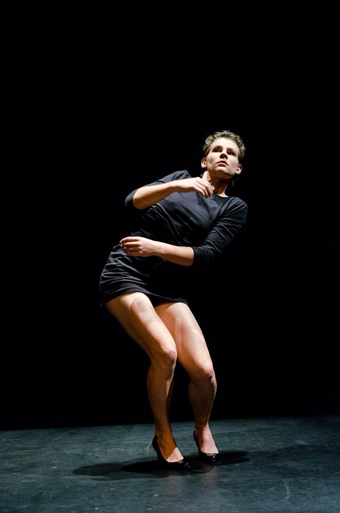
Miranda Wheen, Quest
photo Heidrun Löhr
Miranda Wheen, Quest
Miranda Wheen is one of those dancers with an ineffable quality that makes them utterly compelling, your eyes constantly drawn to them amongst other dancers on stage. Such performers shine in any work, but they positively shimmer when matched with just the right choreographer.
All in the detail
Most recently Wheen has been shimmering in the extended and complex solo Quest, choreographed specifically for her by Martin del Amo. The work was originally commissioned by Chronology Arts and Dirty Feet in 2012 and has recently been reprised by the commissioning companies for the Vitality season at the Seymour Centre. A week later it formed part of del Amo’s Little Black Dress Suite at Riverside Theatre presented by Form Dance Projects.
Quest is a slow and intense work in which Wheen is always in control of minute muscle shifts, trembles and tensions, until she explodes into a confused, but somehow still elegant flailing. Performed to an angular composition by Alex Pozniak, it is an exacting work for both performer and the audience but rewards with its obsessive accumulation of detail and rigorous shaping. Del Amo’s idiosyncratic choreography, initially so interlinked with his own performance, is developing in interesting directions in the hands (or bodies rather) of strong interpreters, of which Wheen is definitely one.
Cross-cultural relations
A distinctive aspect of Wheen’s career so far has been her involvement in inter-cultural collaboration. She travelled to Senegal in 2007 to study under renowned African choreographer Germaine Acogny (http://www.jantbi.org/spip.php?rubrique6). In an email interview Wheen says of this experience, “Dancing for two months in Senegal significantly changed the way I felt when I danced. It was a lesson in setting physical information aside for a time in order to let new things enter and be absorbed into the body. I think a successful intercultural collaboration is constantly in flux; you are at the same time an expert and a novice.”
Game On (2011) was a collaboration between choreographer Annalouise Paul and renowned classical Indian tabla player Bobby Singh. Wheen says, “I was lucky enough to work with Bobby Singh over a period of six or seven years on a number of projects. Like any good friendship, a good collaboration can transcend the sensitivities and politeness of working across multiple cultural histories.” Keith Gallasch commended the balance of this relationship in a review of the show: “Wheen met Annalouise Paul’s considerable choreographic challenge and Singh’s rhythmic demands with total fleet-footed commitment…The response to rhythmic change was never literal, neither artist simply speeding up because the other was moving or playing faster, instead producing a marked visual or sonic counterpoint.” (RT105 online).
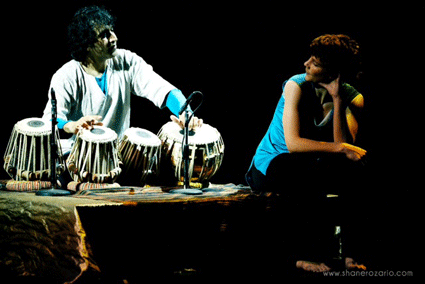
Bobby Singh, Miranda Wheen, Game On
photos Shane Rozzario
Bobby Singh, Miranda Wheen, Game On
Most recently Miranda Wheen has been in Broome working with Marrugeku on their Listening to Country Laboratory. Wheen says, “I love working in intercultural collaborations. They have taught me a deep appreciation for the infinite ways of knowing, learning and communicating culture and the necessity of careful cultivation of relationships, which inevitably take time and constant re-evaluation. The major difficulty with a lot of these projects is that they often feel like the tip of the iceberg. Working with a company like Marrugeku in Broome is inspiring because of their commitment to collaboration simply taking time. With Marrugeku, while the work remains central to the process, things like family, community, country, food and story are very much important elements to the process.”
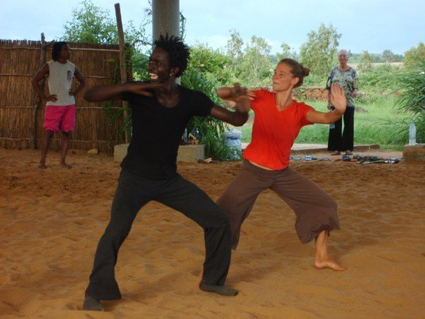
Ecole des Sables in Senegal
photo Jamo Mweu
Ecole des Sables in Senegal
Internal motivations
While Wheen definitely is still in her dancing prime, it’s almost inevitable that she is going to want to explore her own dance language sooner or later. I asked her about where she sees her practice heading. “I’m not sure whether I’m moving away from being a dancer, but I’m certainly deriving more and more pleasure from creating work for myself. As an independent dancer I am involved in quite a diverse range of projects and collaborations with many different people and processes. I think you have to be constantly prepared to work beyond your existing skills and experience, so a lot of new information is constantly flowing into my practice. I guess turning to creating my own work is about sifting through all that information and giving myself time to linger on a particular interest or idea.”
We will have an opportunity to see Wheen’s choreographic vision in October when she and nine other dancer/choreographers—the Dance Makers Collective—present Big Dance in Small Chunks through Form Dance Projects. For this Wheen will be making a work that takes as its starting points the corrupt NSW politician Eddie Obeid and the pelvis. I ask how these two ideas connect. Wheen replies, “After my time in Senegal I developed an interest in the internal lineage of movement that existed in my body when I danced, in particular movement that was driven by the pelvis. The movement that emerges when thinking about my pelvis is very internally motivated, as if the pelvis is the conscious centre of the body—what is driving the dance. Of course the importance of the pelvis is by no means a new concept to modern/contemporary dance practice…Recently I have been struck with the concept of the ‘faceless men,’ the expression used to describe scheming back-room New South Wales politicians such as Eddie Obeid. This pelvic-driven movement I’ve been working with seems to have a quality that resonates with this idea of ‘facelessness,’ that the conscious or expressive centre of the body is not the face. What if Eddie’s expression of self was not in his face but in his pelvis?” An intriguing proposition the results of which will definitely be worth checking out.
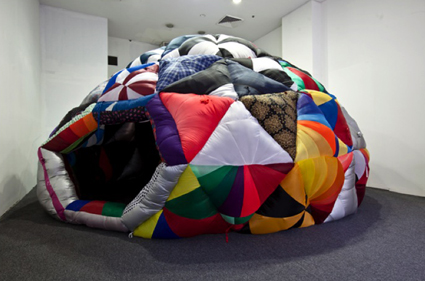
Impossible Utopia 2011, Keg de Souza
Keg de Souza describes herself as an “anarchitect,” an amalgam that comes closest to encapsulating her practice which involves architecture, environmental design and activism with a little bit of drawing, printing and bookbinding included for good measure. While her artworks take varied forms her central focus is on “spatial politics… not only the built environment, but the social space inhabited within” (Artist statement). De Souza is currently one of the 2013/2014 Early Career Creative Australia Fellows and as the projects below indicate, she’s making the most of it.
Space making
De Souza came on the scene in around 2000 when she was part of Squat Space, a collective running a gallery in one of the shopfronts of Sydney’s Broadway Squats. The inhabitants were receiving a lot of attention due to their organized and highly articulate battle to legitimise their tenancy. After they were evicted, the collective continued as a roving ARI producing a number projects including SquatFest, an underground alternative to TropFest, and Tour of Beauty, a bicycle and walking tour around Waterloo-Redfern talking with locals about the area (http://squatfest.com/history/).
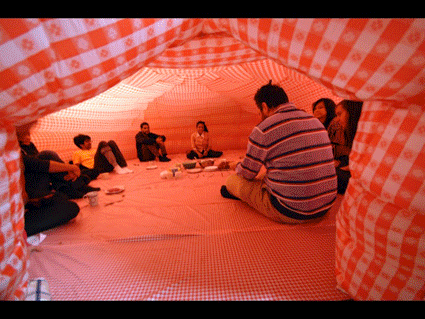
Gonflables et amuse-bouches 2012, Keg de Souza
courtesy the artist
Gonflables et amuse-bouches 2012, Keg de Souza
Inflatables & edibles
This interest in space and community building has recently manifested in the form of large inflatable structures. De Souza says, “Inflatables were just naturally a way for me to be able to make something that was easily transportable. I was also thinking about utopias and nomadic architecture and the history of inflatables. They were often used as a symbol of radical architecture. There was a big show in Paris in 1968 by the Utopie group that showcased a lot of work by artists, architects and activists who used inflatables in their practice, such as Ant Farm and Haus Rucker Co. But also I was thinking about what they can encompass [now] with their temporality.”
In 2012 de Souza undertook a residency at the Darling Foundry in Montreal where she created the work Gonflables et amuse-bouches which incorporated elements of food and mapping. She says, “In Montreal I was pretty taken aback by these radical activist kitchens that worked out of the two main Anglophone universities there—McGill and Concordia. These radical kitchens cook for the students everyday but they also cater for activist events…The inflatable was constructed out of disposable plastic tablecloths and I had a series of events inside it [and outside while it was being constructed] that explored food and the way it intersects with art, architecture, radical spaces and radical organising. I guess it was a way to encompass all these interests—[to see] how they can intersect and create this dialogue about communities.”
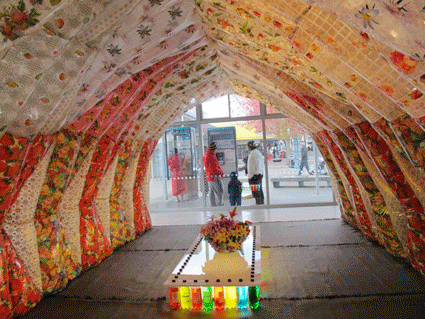
Tropical Thunder 2013, Keg de Souza
courtesy the artists
Tropical Thunder 2013, Keg de Souza
Local mapping
De Souza has continued this line of thinking in Tropical Thunder, part of the 2013 Auckland Triennial. She was based at Fresh Gallery, Otara in south Auckland, a suburb with a 70% Pasifika population: “Everything in that town centre was geared towards a Pasifika community. So out the front of supermarkets they had coconuts, green bananas and taro for sale…This continued into the $2 shop. In the $2 shop in Redfern you might see plastic flowers—sunflowers or roses—but in Otara there were frangipanis and hibiscus. Everything was tropical including material that had Pasifika patterns. But it was all made in China. I thought it was really interesting how this culture had been commodified and commercialised overseas, then all these mass-produced items from China were sold back to the culture that they were appropriated from.”
In Otara, de Souza made her inflatable out of Pasifika themed plastic tablecloths following the design of the canopy that arches over the town centre. She held sessions inside the structure with local community members and created a food-centric map of the area: “I gathered additions and comments to this map about what the locals wanted to say about food, whether it be a place to eat or a personal story, or [particular] legislations…So this created a local knowledge food map of the area.”
I asked de Souza about finding a balance between artistic and social outcomes. She is emphatic: “I’m always really clear when I do these socially driven projects that I am an artist. And I’m really clear about what I’m exploring to begin with. [But] there’s a lot of risk taking. You can’t go into a community expecting a particular outcome… [it’s only] when you meet the people—that’s what really shapes the project.”
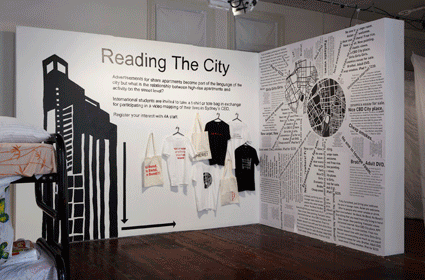
ruangrupa ArtLab and Keg de Souza, Vertical Villages, Haymarket (2013) (installation view, 4A Centre for Contemporary Asian Art, Sydney). Commissioned by 4A Centre for Contemporary Asian Art.
courtesy 4A and the artists, photo Zan Wimberley
ruangrupa ArtLab and Keg de Souza, Vertical Villages, Haymarket (2013) (installation view, 4A Centre for Contemporary Asian Art, Sydney). Commissioned by 4A Centre for Contemporary Asian Art.
Collaborative cultures
De Souza’s most recent project, Vertical Villages, facilitated by Sydney’s 4A Centre for Contemporary Asian Art, is a collaboration with Indonesian artist collective ruangrupa ArtLab. Together they have been consulting the international student population of the CBD, exploring their micro-culture of self-organisation and redesign of urban living spaces. These students often live in city apartments with multiple occupants in the one room, creating a little slice of private domestic space out of a bunk bed with a shower curtain for privacy. The exhibition, currently still running, combines an installation of these compact living spaces complete with domestic clutter of food stashes, toiletries and TV screens showing videos made by students. There’s also a large map in which students are invited to add their own comments and suggestions for exploring the city. Students have also been invited to program House Parties—Friday night activities in the gallery.
De Souza says of this collaborative process, “I guess our practices have a lot of crossover in terms of themes—cities and space. Obviously our outcomes are really different and our aesthetics, but those processes of dialogue and gathering information [are similar]. With the outcomes here we were pushing each other to do things slightly differently. I don’t look at the show and go this is definitely ruangrupa, this is me—maybe in aesthetics—but in the process all those things were really driven together.”
Part two of Vertical Villages will see Keg de Souza joining ruangrupa in Jakarta where they will work with local migrant worker communities with the outcome exhibited as part of 15th Jakarta Biennale.
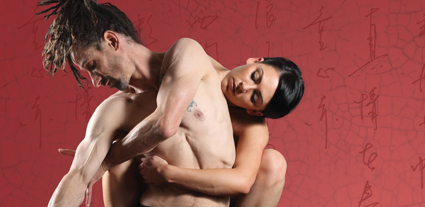
Leigh Warren Dance, Not According to Plan
OzAsia, Adelaide Festival Centre
The annual OzAsia festival is already in full swing, but there are plenty of festivities still to come. Leigh Warren Dance presents the premier of Not According to Plan, following the journey of dancer, photographer, choreographer and calligrapher Xiao Xiong Zhang “from a life of unimaginable isolation into one of a worldwide dance family” (website). There’s a mini-focus on Malaysia with Parah by Instant Café Theatre looking at the hidden political rifts in Malaysian society, and SuperEverything*, a live cinema collaboration between UK video outfit The Light Surgeons and Malaysian artists Ng Chor Guan, Hands Percussion and Rhythm in Bronze. Touching down in Adelaide on a national tour is Fight the Landlord, a collaboration between Ireland’s Pan Pan Theatre and Beijing’s Square Moon Culture performed in the round by ladies in panda suits (see review RT111). There’s also the quiet charmer Stories Then and Now directed by Annette Shun Wah and William Yang (see RT115). This weekend join the Moon Lantern festivities, and of course you wouldn’t want to miss Kamahl in concert!
Adelaide Festival Centre: OzAsia Festival, 13-29 Sept; http://www.ozasiafestival.com.au/
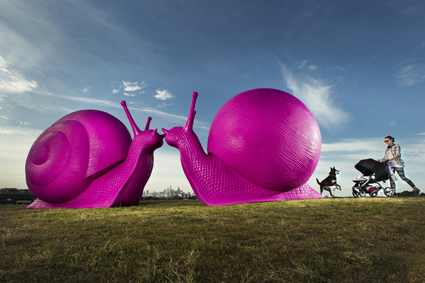
Snailovation, Cracking Art Group
Art and About, City of Sydney
Art and About is hitting Sydney with a plethora of public art adventures. Watch out for giant pink snails made entirely from recyclable materials by UK artists Cracking Art Group; or see yourself multiplied in the 324 mirrors that will populate Hyde Park in Field by New Zealand team Out of the Dark. You can take on a virtual persona and immerse yourself in the micro-world of a model railway in I Think I Can by Sam Routledge, Martyn Coutts and Performance Space. Or you can experience the thrills of Spill, a high energy dance work in several public parks around the city created by Shaun Parker. A special commission by Carbon Arts, Keith Deverell’s Building Run manifests the energy consumption data of five CBD buildings represented by five avatars running for their future. Extending the festivities to East Sydney, Metro Screen will be running a Pop-up Cinema and Bar at the Paddington Town Hall, including a whole night of shorts from a RealTime favourite, Lena “Girls” Dunham.
Art & About, various venues Sydney, 20 Sept-20 Oct; http://www.artandabout.com.au/; http://metroscreen.org.au/whatson/
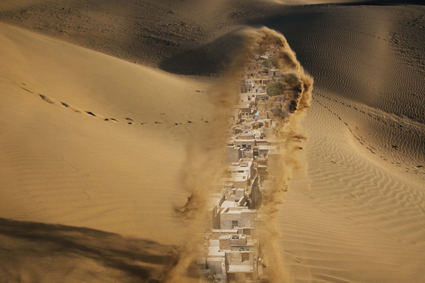
Gigi Scaria, Dust
Gigi Scaria, Dust, Ian Potter Museum
Gigi Scaria was one of the artists to appear in the first ever Indian Pavillion at the Venice Biennale in 2011. Over the last two years he’s spent time in Australia on a cultural exchange courtesy of the Macgeorge Fellowship, University of Melbourne. Dust is his first major solo exhibition here and draws on what he sees as a “strong connection between the Australian and Indian continents” (press release). Through video, large-scale photography and painting Scaria explores the salt plains of the Kutch area, presenting quite a different vision of India from those we normally see.
Gigi Scaria, Dust, Ian Potter Museum, 18 September 2013 – 2 February 2014; http://www.art-museum.unimelb.edu.au/
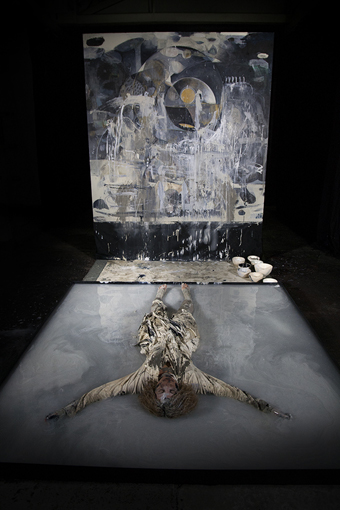
Memory Collective
photo Victoria Cooper+Doug Spowart
Memory Collective
Memory Collective, Toowoomba Art Gallery
Soon to be exhibited at the Toowoomba Art Gallery in south-east Queensland are the results of a large scale collaborative artmaking project by the Memory Collective. Painter and project initiator Damien Kamholtz first created a large format painting. He then invited 12 local artists from a range of disciplines including dance, ceramics, sculpture, textile design, music, photography and filmmaking to respond to the work over various stages. This interaction has both transformed the original painting and created a number of related artworks. (See clip for performance documentation).
Memory Collective, Toowoomba Art Gallery, 21 Sept-5 Nov; http://ww2.toowoombarc.qld.gov.au
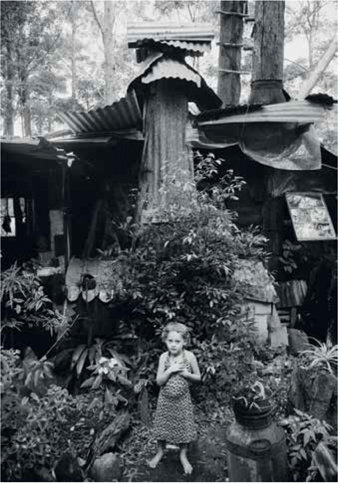
Tim Hixson, Main Arm Mullumbimby (detail), mid 1970s
User Generated Architecture, Tin Sheds Gallery
As part of the Sydney Architecture Festival, Tin Sheds Gallery will be presenting two exhibitions under the umbrella title User Generated Architecture. Not Quite Square, a joint venture with Lismore Regional Gallery, surveys the alternative owner-builder culture that developed in the Northern Rivers region in the 1970s. The partner exhibition features the architecture collective raumlabor berlin. Working at the intersection of urban planning, architecture and intervention the collective creates large-scale installations in public space exploring architecture as an “experimental laboratory” and a “participatory practice” (press release). They will also be conducting a two-day workshop (see opportunities).
Tin Sheds Gallery, Faculty of Architecture Design and Planning, University of Sydney; 27 September-15 November; http://emergencity.net/user-generated-architecture/
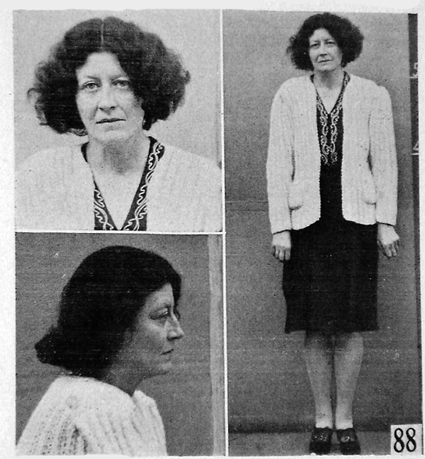
Underworld Songs, Astra
Martin Friedel’s Underworld Songs, Astra
The choral chamber society Astra’s next concert presents a new work by composer Martin Friedel, Underworld Songs. Friedel has been a Creative fellow at the State Library of Victoria where he has been rummaging through tabloid and police reports from the 1950s. He’s created a six-scene suite for choir, soloists, small instrumental ensemble and projected image that looks at “ordinary lives that have gone wrong” (press release). Performed across two atmospheric venues at the Abbotsford Convent, Underworld Songs is complemented by choral pieces by Mendelssohn and Riccardo Vaglini.
Astra Chamber Music Society, Martin Friedel’s Underworld Songs,
Abbotsford Convent, 21-22 Sept 3pm; http://www.astramusic.org.au/
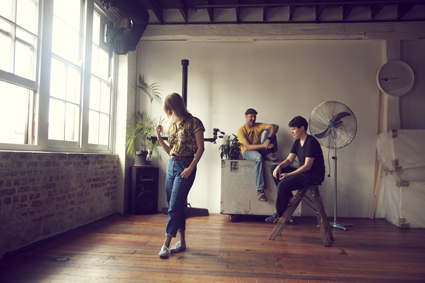
Whips & Tendrils, Triangulate
Whips and Tendril, Campbelltown Arts Centre
The next New Music Network Mini-Series concert is at Campbelltown Arts Centre and focuses on native bird sounds. Whips and Tendrils will be in 9.1 surround sound and features compositions by Triangulate—Sarah-Leith Izzard, Karin Senff and Andrew Bluff. The concert is also part of the Sydney Sacred Music Festival. (View a previous piece by this interesting trio here.)
Triangulate, Whips and Tendrils, Campbelltown Arts Centre; 21 Sept; http://www.campbelltown.nsw.gov.au/WhipsandTendrils; http://sydneysacredmusicfestival.org/events/
Still in the loop
Super Discount, Back to Back, STC, Malthouse
Sydney Theatre Company
20 Sept-19 Oct
http://www.sydneytheatre.com.au/what’s-on/productions/2013/super-discount.aspx
Flock, Weave Movement Theatre
Mechanic Institute Performing Arts Centre, Brunswick
19-22 Sept
http://www.melbournefringe.com.au/fringe-festival/show/flock/
Nought, ADT, Samstag Museum
25 -27 Sept
http://adt.org.au/; http://w3.unisa.edu.au/samstagmuseum/
Kate Murphy, Probable Portraits
Shepparton Art Museum (SAM), 13 Sept-14 Nov
http://www.sheppartonartmuseum.com.au/
Open Frame, Room40
Brisbane Powerhouse and various venues
12-28 Sept
http://openframe.room40.org/2013
Craig Walsh, Embedded & Primavera, MCA
12 Sept-24 Nov
http://www.mca.com.au/
Drawn to Experience: Performance Drawing
POP Gallery (Postgraduates and Other Projects) , Queensland College of Art, Griffith University
12-21 Sept
http://www.kellieo.com/?page_id=1213
ikono On Air Festival
global, online
6-29 September
http://ikono.org/festival/
2013 Brisbane Festival
7-28 Sept
http://www.brisbanefestival.com.au/
arte magra: from the opaque, AEAF
5 Sept-5 Oct
http://www.aeaf.org.au/exhibitions/ArteMagra.html
The boat goes over the mountain, Happy Dagger Theatre
The Blue Room, Perth
10-28 Sept
http://blueroom.org.au/events/the-boat-goes-over-the-mountain/
Windows to the Sacred, S.H. Ervin Gallery
presented in association with Buratti Fine Art; 30 Aug-29 Sept
http://www.shervingallery.com.au/
Malthouse’s Helium
Little Ones Theatre, Salomé, 30 Aug-14 Sept
Smack! Bang, City of Shadows, Rachael Dease, 21 Sept-5 Oct
http://www.malthousetheatre.com.au/helium-2013/
In Confidence: Reorientations in Recent Art, PICA
31 Aug-13 Oct
http://www.pica.org.au
RealTime issue #116 Aug-Sept 2013 pg. web
© RealTime ; for permission to reproduce apply to realtime@realtimearts.net
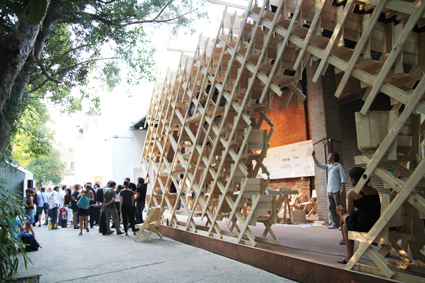
Generator workshop, raumlabor berlin
raumlabor, Tin Sheds Gallery
To complement the exhibition User Generated Architecture (see quick picks), Christof Mayer and Andreas Krauth, artists from the collective raumlabor berlin will be conducting a two-day workshop in “instant, participatory building practices in public space” (press release). The workshop is free but places are limited.
Workshop 12-13 Oct (plus one day ATSC workshop induction if required 11 Oct); http://emergencity.net/special-workshop-with-raumlabour-berlin-book-now/
Nude models, Deborah Kelly, Sydney Biennale
Artist Deborah Kelly is calling for subjects to pose for a number of life-sized nude portraits. These will then be integrated into collages in a series of public workshops starting in October with the final works exhibited during the 19th Biennale of Sydney.
Volunteers as portrait subjects, please send a picture of your face (only) to kellyproject@biennaleofsydney.com.au by Friday, 11 October 2013. For collage workshops, please send expressions of interest to frances@biennaleofsydney.com.au
Public Art major works, City of Sydney
Sydney’s CBD will be changing dramatically over the next few years with traffic rerouted, pedestrian zones created and a light rail system installed. Expressions of interests from artists are now invited for major public artworks to be sited on what is being called the George Street Spine and the smaller East-West cross streets.
Expressions of Interest due 31 October; http://www.cityartsydney.com.au/cityart/news/?p=1739
Revelation Film Festival 2014
The dates are set for next year’s Revelation Film Festival 3-13 July (see Keith Gallasch’s report on this year’s event), and submissions are now open. Categories include narrative features, documentary, short film, animation and experimental projects. There’s a pretty long lead-time so you could start something now and still be ready for the deadline.
Entries close 11 April 2014 http://www.revelationfilmfest.org/go/news/call-for-entries-now-open
Still in the loop
Blacktown Arts Centre Residencies
Applications close 30 Sept
http://www.artscentre.blacktown.nsw.gov.au/performance/2014-performing-arts-residencies.cfm
Fisher’s Ghost Prize, Campbelltown Arts Centre
Entries due 4 Oct, 2013
http://www.campbelltown.nsw.gov.au/FishersGhostArtAward
House Proud 2014, Boroondara City Council
Applications close 30 Sept
http://www.boroondara.vic.gov.au/our-city/arts-culture/kewcourthouse/house-proud
version 1.0 masterclass
Masterclass 19 Oct, and bookings now open.
http://www.trybooking.com/Booking/BookingEventSummary.aspx?eid=60167
Melbourne White Night
Submissions close 1 Oct 2013
http://whitenightmelbourne.com.au/
Fast+Fresh Dance, FORM Dance
Registration closes 14 October
http://form.org.au/2013/01/fastfresh-dance-2/
FlickerFest call for entries
Deadline for Australian & International entries 11 Oct; for GreenFlicks & FlickerUp 18 Oct
http://www.flickerfest.com.au/
Workshops & Residencies, Lucy Guerin Inc
Applications for studio residencies & workshop places due 23 Sept
http://www.lucyguerininc.com/studio-projects/Studio_Residency; http://www.lucyguerininc.com/studio-projects/Hotbed
Next Generation Placement, ASSITEJ
Deadline for applicants 30 Sept
http://www.assitej-international.org/next-generation/
Forever Now
Applications open until June 2015
http://forevernow.me/
Selected Australia Council Grants
for full list see http://www.australiacouncil.gov.au/grants
Music: Fellowships – 17 September 2013
http://www.australiacouncil.gov.au/grants/2013/music-fellowships
Music: Project Fellowships – 17 September 2013
http://www.australiacouncil.gov.au/grants/2013/music-project-fellowships
Music: Don Banks Music Award – 17 September 2013
http://www.australiacouncil.gov.au/grants/2013/don-banks-music-award
Music: Skills and Arts Development – Artist Development – 17 September 2013
http://www.australiacouncil.gov.au/grants/2013/music-skills-and-arts-development-artist-development-17-september
ArtStart – 23 September 2013
http://www.australiacouncil.gov.au/grants/2013/artstart2
Emerging and Experimental Arts – 4 October, 2013
http://www.australiacouncil.gov.au/grants/2013/experimental-arts-grants-4-october
RealTime issue #116 Aug-Sept 2013 pg. web
© RealTime ; for permission to reproduce apply to realtime@realtimearts.net
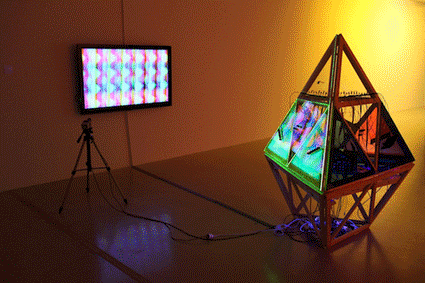
Tetra Synth, 2013, Pia van Gelder & Stephen Jones
courtesy the artists
Tetra Synth, 2013, Pia van Gelder & Stephen Jones
Pia van Gelder is the “Overlord”of the Sydney chapter of Dorkbot, a loose international network of “people doing strange things with electricity.” She is also incredibly active as a curator (co-director of the Moduluxx festival and the now-ended Serial Space), an educator and artist.
Van Gelder’s practice involves performance and installation works utilising what she describes as “media machines” which she hacks and reconfigures. She says “hacking or tinkering is a way to look for a new aesthetic…to explore or reveal the machine’s intrinsic visual or audio language, sometimes arriving at surprising results. But mostly I’m looking at how a machine can have its own form of expression [either through an] electronic aesthetic or the machine’s connection to the outside world and the people around it.” In her artist statement van Gelder talks of the pursuit of an “AV mysticism.”
Heirloom machines
Van Gelder is particularly interested in older technologies, which she refers to as heirloom machines. “This is a term Joyce Hinterding and I came up with when I was doing my masters. There are machines, like the video synthesiser for instance, that are historic and rare…a prize possession.” There’s an interestingly female flavour to the term—a small reclamation of machines from an assumed male custodianship.
Van Gelder has recently collaborated with Stephen Jones to recreate one of these machines. Based on Jones’ original 1996 designs for a video synthesiser, they have recreated the Tetrasynth. It’s a pyramidal object with one colour from the video spectrum—red/green/blue—assigned to each side. It allows users to play, manipulating the colours via generators and filters to create abstract video images. The work was commissioned by Campbelltown Art Centre for their exhibition Catching Light, part of ISEA 2013 (see realtimeTV and review).
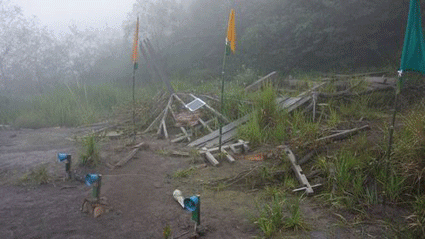
Mountain Operated Synthesiser (MOS), 2013, Mt Mehrapi, Pia van Gelder, Michael Candy, Andreas Siagian
courtesy the artists
Mountain Operated Synthesiser (MOS), 2013, Mt Mehrapi, Pia van Gelder, Michael Candy, Andreas Siagian
Collaboration
While the term ‘geek’ offers the impression of lonely souls working in isolation, only communicating virtually, the contemporary use of the term ‘hacker’ infers a shift beyond software to actual object modification and is strongly associated with the idea of real-world communities. Hacker spaces are popping up all around the world where people come to share tinkering tips, tools and resources. Before this year, Van Gelder had not participated in many collaborative art processes (curating aside), but now she’s making up for this.
As well as the Tetrasynth project, she has also recently taken part in the Instrument Builders Project in which Australian and Indonesian artists came together at iCAN in Yogyakarta (see review). Van Gelder teamed up with Brisbane-based artist Michael Candy and Indonesian artist Andreas Siagian to create the Mountain Operated Synthesiser. Inspired by a solar-powered seismic monitoring station half way up Mt Mehrapi, an active volcano 28 kilometres north of Yogyakarta, the trio have created an instrument that is played by the mountain. It comprises three flags dug into the ground, each holding three oscillators. The flags have analogue senses sewn on or built into them, capturing wind and moisture levels and soil activity. This data then activates the oscillators creating a raucous sonification of the mountain’s conditions. It doesn’t sound very pretty but it’s a wonderfully integrated concept.
Gender issues
Hacking is an area of practice notoriously dominated by males and I asked Van Gelder how this affects her practice. “The Instrument Builders Project was a very good example—there were no other female practitioners on that bill of artists. (There was, of course, Kristi [Monfries] who was one of the curators.) And it came up in discussion from time to time. You have to recognise that imbalance and talk about it, but you also can’t let it get to you, even though it can feel quite isolating…If we don’t recognise that it’s a male dominated field then it becomes even more unappealing [for women]. But if you make a point of making space, making women feel recognised and comfortable, that’s a way of moving past it, just a little bit.”
What’s next
Van Gelder has already achieved a lot this year, but there’s still more to come. She’s one of five artists who have been commissioned to make works for the Tele-Visions festival celebrating the passing of analogue TV (part of Performance Space’s 30th birthday celebrations). For Tele-Visions Van Gelder will perform a series of experiments for live television broadcast involving participation from the audience in the studio. “It’s kind of like a cross between a global groove and a science show.” If only the Curiosity Show was still around today—Pia van Gelder would make the perfect host(ess)!
COMING UP: Pia van Gelder (represented by First Draft) will exhibiting at the inaugural Sydney Contemporary, Carriageworks, Sydney; 20-22 September 2013 ; http://piavangelder.com/
RealTime issue #116 Aug-Sept 2013 pg. web
© Gail Priest; for permission to reproduce apply to realtime@realtimearts.net
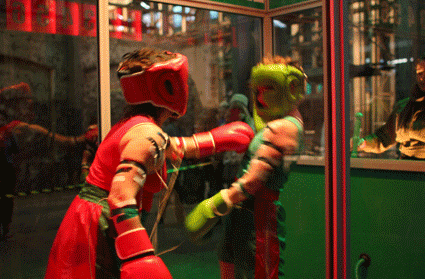
Game On, Michaela Davies
photos Claire Conroy & Geoff Ambler
Game On, Michaela Davies
Michaela Davies is not a woman to mess with. Not only is she well trained in boxing but she also has a PhD in Psychology. She has combined these skills in her latest work, Game On, which premiered at this year’s Underbelly Arts Festival.
Involuntary art & vicarious violence
Game On extends the work that Davies has been making with electric muscle stimulation (EMS), in particular her Compositions for Involuntary Strings. She composes works that are translated into midi data, then converted to EMS messages that are transmitted to the wired-up musicians who are literally shocked into playing the compositions, their involuntary muscle spasms providing wonderfully idiosyncratic extra musical sounds. (See RT113 and our ISEA blog).
For Game On, Davies uses a similar EMS technique, but ups the ante considerably. Inspired by a scene in Richard T Heffron’s film Future World (1973), she built a gaming booth in which live ‘boxers’ are controlled by audience members via oversized joysticks. The boxers’ muscles are stimulated into sequences that replicate the action of swinging, punching and blocking. The resulting match is curiously languid and hysterically wonky. Things hot up as the controlling masters of the game get increasingly more skilled and sometimes more aggressive.
GAME ON. Documentation from installation on Cockatoo Island for Underbelly Arts Festival. Sydney, Australia (2013), video by Boris Bagattini from Michaela Davies on Vimeo.
While the piece is evidently fun, it also poses questions about our pleasure in vicarious violence. The work also references the infamous Milgram experiment, in which people were given permission by a perceived authority figure to inflict lethal levels of electric current on unseen participants. In the Milgram experiment there were no actual victims (the participants’ cries were revealed to be pre-recorded), so Davies’ piece, in effect, takes this experiment a step further. Game On also removes the authority figure but replaces it with the performance context. Davies says: “the authority comes from the fact that it’s an artwork—they are doing it for art. But it’s still looking at where the responsibility lies. Maybe the players wouldn’t go up and shock someone on the street but because they’ve been given permission here, that makes it okay for them.”
Game On illustrates an interesting tension between Davies’ psychology and art practices: “There’s no way you could do something like Game On in a research environment, or as a psychological study because of ethics. Making art you have more freedom to explore ideas that you can’t explore in research because you simply wouldn’t be allowed. Or it would be so far removed from any kind of reality that it would be pointless. I’m wondering how long [this freedom] will last before artists will have to submit ethics applications to make an artwork that involves the public.” [This is already an issue for art practice as research within universities; see Kate McNeill and Barbara Bolt, “The ‘legitimate’ limits of artistic practice,” RealTime 104, Eds]
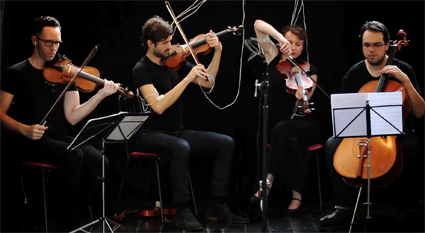
“Untitled for Cyborg String Quartet” (voluntary & involuntary players), Michaela Davies in collaboration with Kyle Sanna
Obstructionism
Game on and the Involuntary Strings project are of course about more than sadism: they reflect Davies’ overarching interest in agency and free will. Her next project involves a series of videos in which musicians play a piece which they know very well but have to battle an obstruction—for example a guitarist wears mittens while trying to play “Stairway to Heaven.” Davies says, “I am interested in the way obstruction can change performance, or change behaviour—how people cope with different obstruction. I’m also looking at this from an historical experimental music perspective—chance operations… Those artists were trying to remove people from what they’re making, to give them more freedom—through obstruction—to create something new.”
A work Davies is developing for her appearance at the Sonica Festival in Glasgow will involve a pianist performing a classic piece (yet to be decided) which Davies, in a duet of sorts, will interrupt with EMS impulses. She says, “She’ll be fighting against the involuntary EMS to try and play. I’m really interested in that struggle.” With this and the video pieces Davies is “interested how performance becomes a recital. It’s easy for musicians to not really think about what they’re playing any more. I’m looking at ways of changing that.” In the early Involuntary Strings pieces it seems musicians voluntarily relinquish control. In these later works Davies allows the musicians a semblance of control and then actively interferes with it.
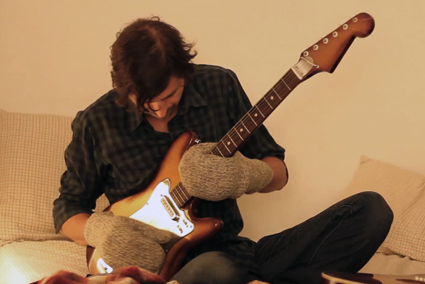
Kyle Sanna plays Stairway to Heaven, Michaela Davies
courtesy the artists
Kyle Sanna plays Stairway to Heaven, Michaela Davies
This development reflects Davies’ thinking as a psychologist: “People develop disorders and problems because of conflicts between themselves and society and what society expects. I don’t think they actually need free will or more will power to get better. It’s more about looking at the contexts these things develop in, rather than having more control over yourself. I don’t think anyone ultimately has much control over anything. We’re just rats pressing a bar for food.” I look forward to that experiment manifesting as an artwork.
COMING UP: Sonica: Compositions for Involuntary Strings, Tramway, Glasgow, 2 November; http://sonic-a.co.uk/compositions-for-involuntary-strings/; Game On, Damien Minton Ballery, opening 12 November; http://www.michaeladavies.net/
RealTime issue #116 Aug-Sept 2013 pg. web
© Gail Priest; for permission to reproduce apply to realtime@realtimearts.net



 There’s been quite an upsurge in discussion recently on the distribution and exhibition of Australian films, both in the traditional and online media and in sessions at various conferences. It’s a debate that’s been driven in part by continuing concern about the failure of many local films to reach their audiences, and in part by the potential for new and innovative methods to reach those audiences through digital distribution.
There’s been quite an upsurge in discussion recently on the distribution and exhibition of Australian films, both in the traditional and online media and in sessions at various conferences. It’s a debate that’s been driven in part by continuing concern about the failure of many local films to reach their audiences, and in part by the potential for new and innovative methods to reach those audiences through digital distribution.  Connolly’s comments are so self evident that the response of the ABC’s Head of Factual Programming, Phil Craig, was somewhat surprising. In an email, later published by Screen Hub, he told Connolly his speech was “utter bollocks” and challenged the veteran director to a head-to-head session at the next AIDC from which “only one of us walks out alive.” For Craig’s sake, I wouldn’t like to lay odds on who would emerge from such an encounter. He later backed down from this rather childish and belligerent stance, but his initial reaction is indicative of the profound resistance of some broadcast personnel to having their assumptions challenged.
Connolly’s comments are so self evident that the response of the ABC’s Head of Factual Programming, Phil Craig, was somewhat surprising. In an email, later published by Screen Hub, he told Connolly his speech was “utter bollocks” and challenged the veteran director to a head-to-head session at the next AIDC from which “only one of us walks out alive.” For Craig’s sake, I wouldn’t like to lay odds on who would emerge from such an encounter. He later backed down from this rather childish and belligerent stance, but his initial reaction is indicative of the profound resistance of some broadcast personnel to having their assumptions challenged.





















































































































![1) 7bit Hero; 2) Sha Sarwari, Asylum Seeker; Vidhi Shah and Jeniffer Heng, Flow[er]; 2high Festival](https://www.realtime.org.au/wp-content/uploads/art/70/7091_2high.gif)


![Asiga, [CTRL][P] Objects on Demand](https://www.realtime.org.au/wp-content/uploads/art/70/7096_loop_object.jpg)







































































































